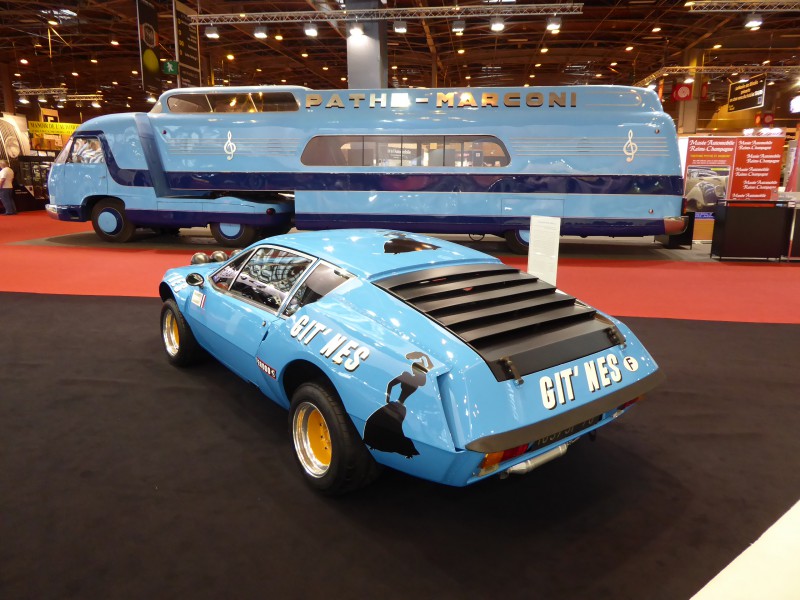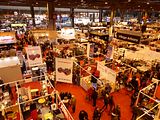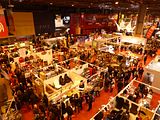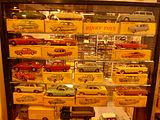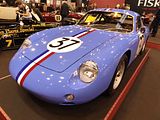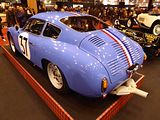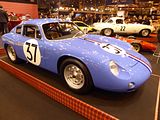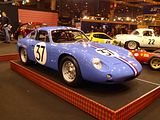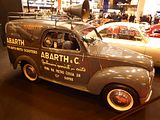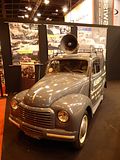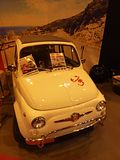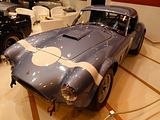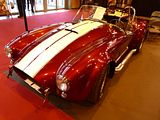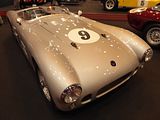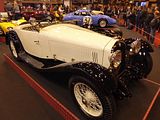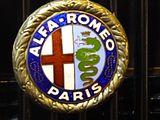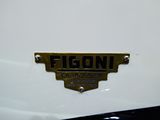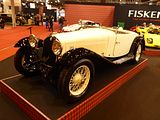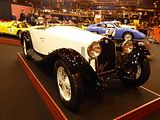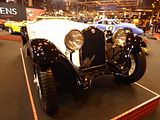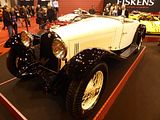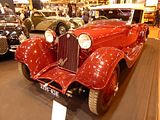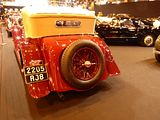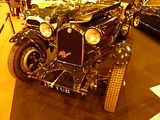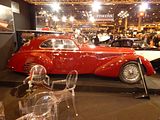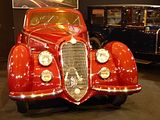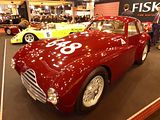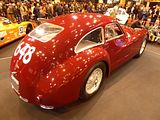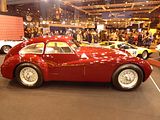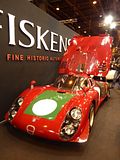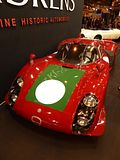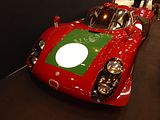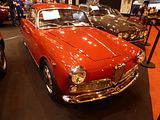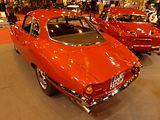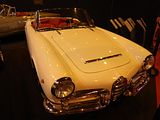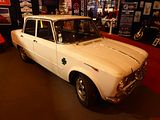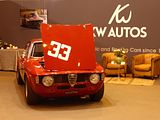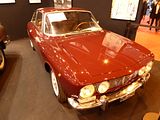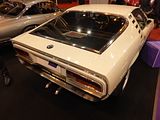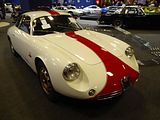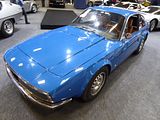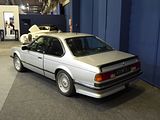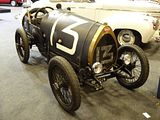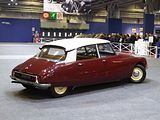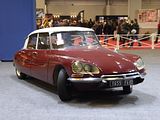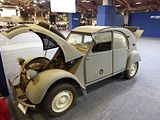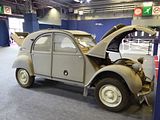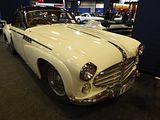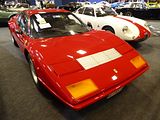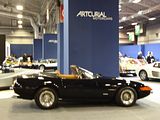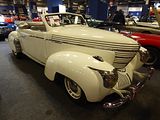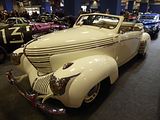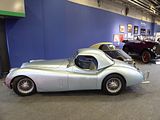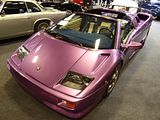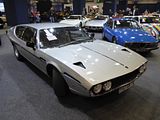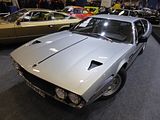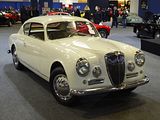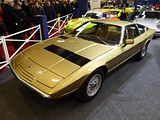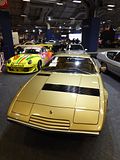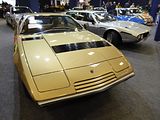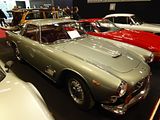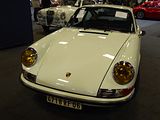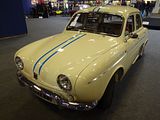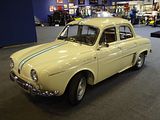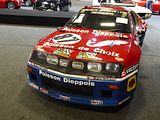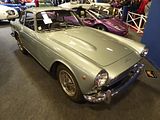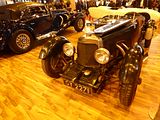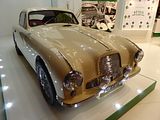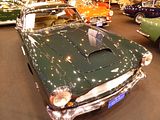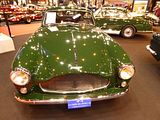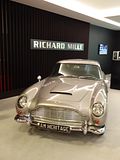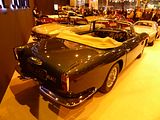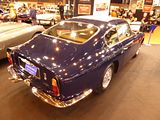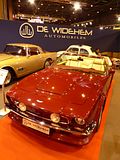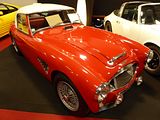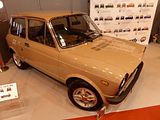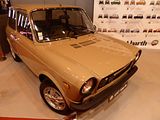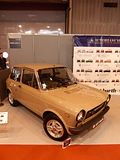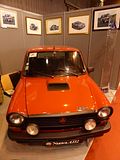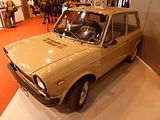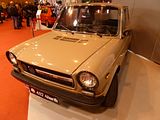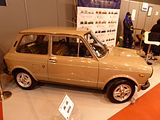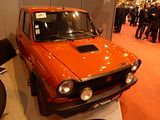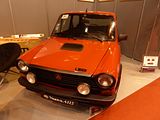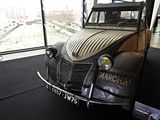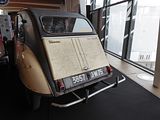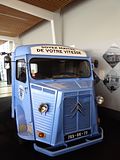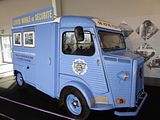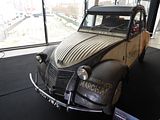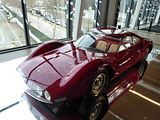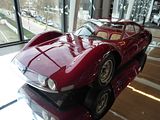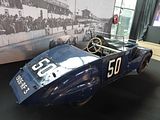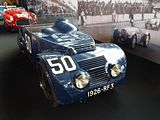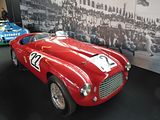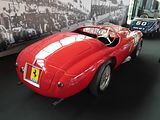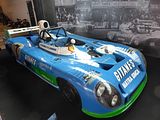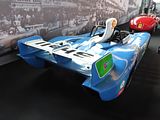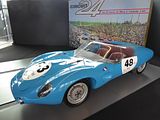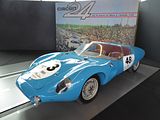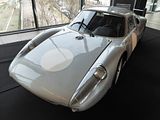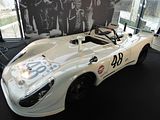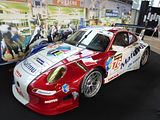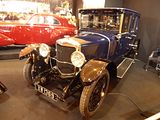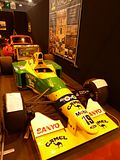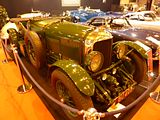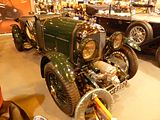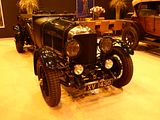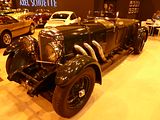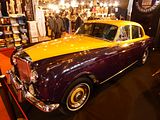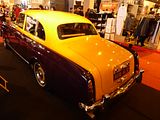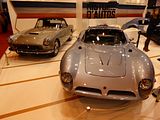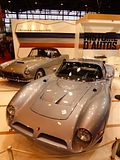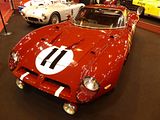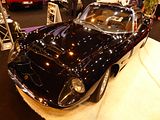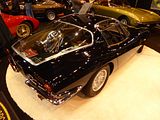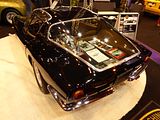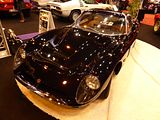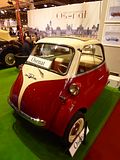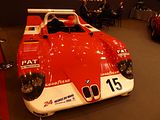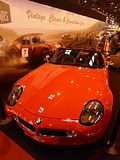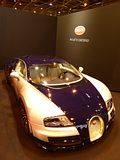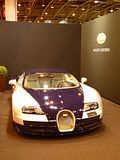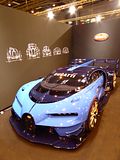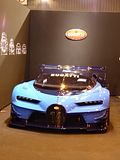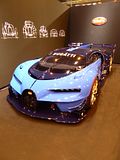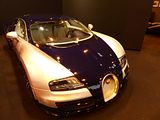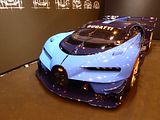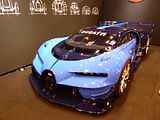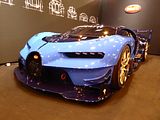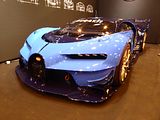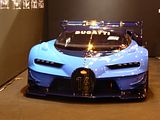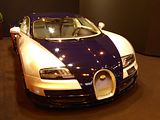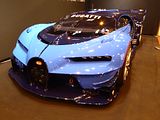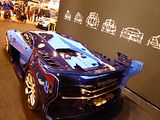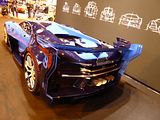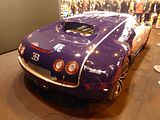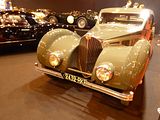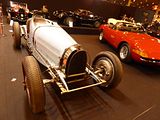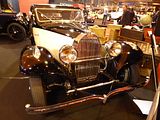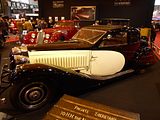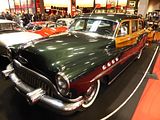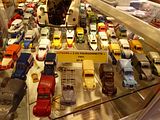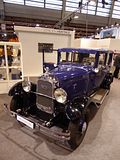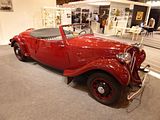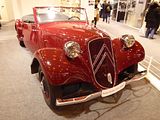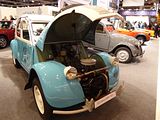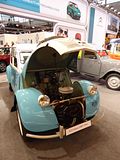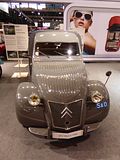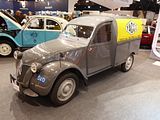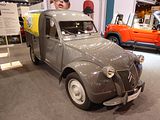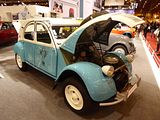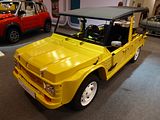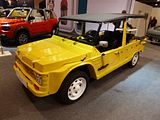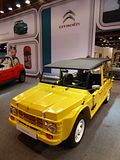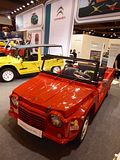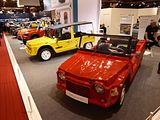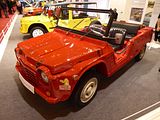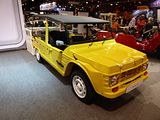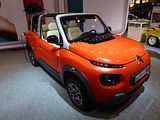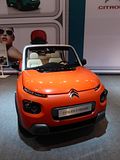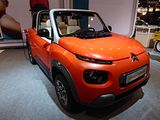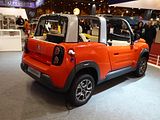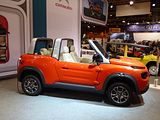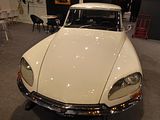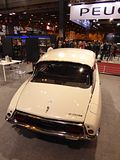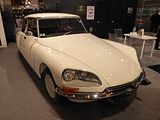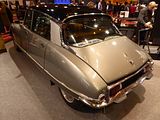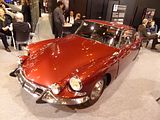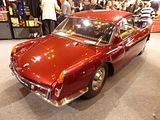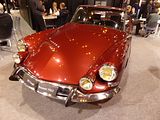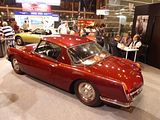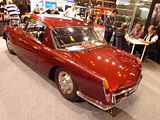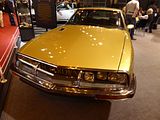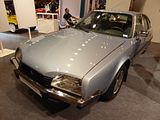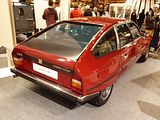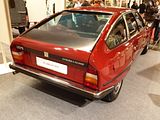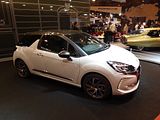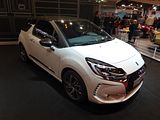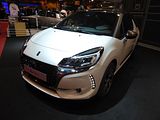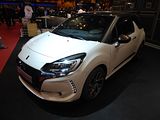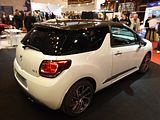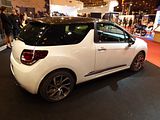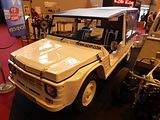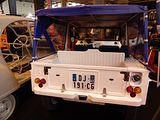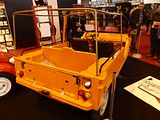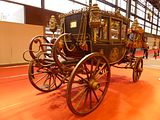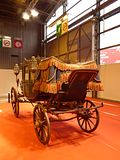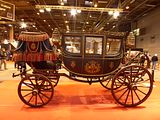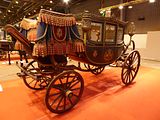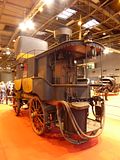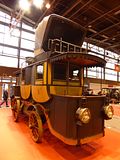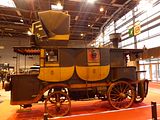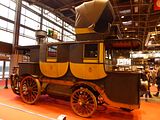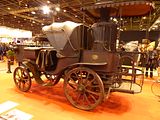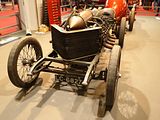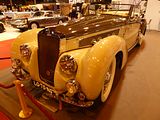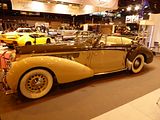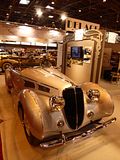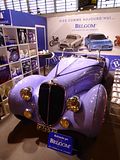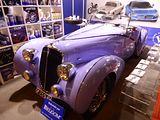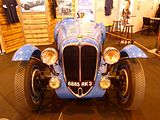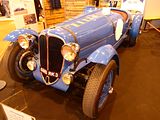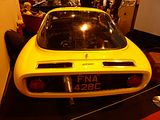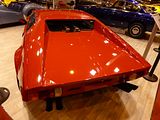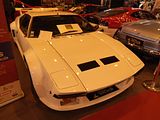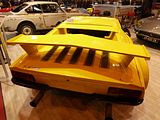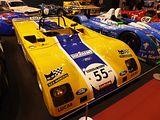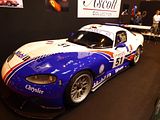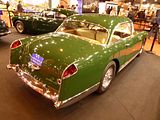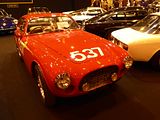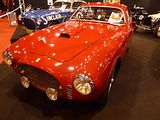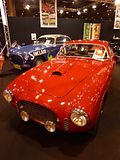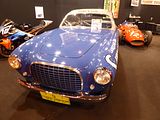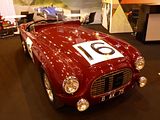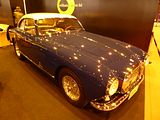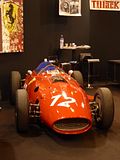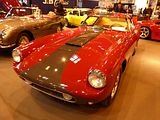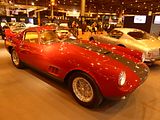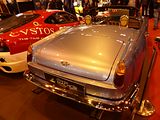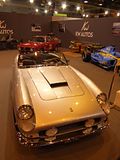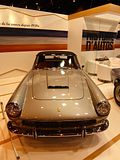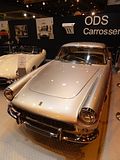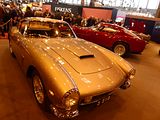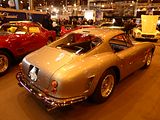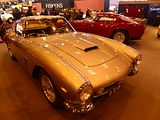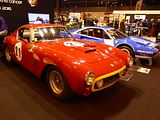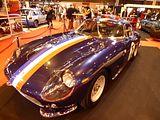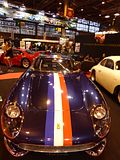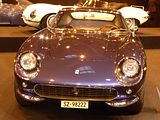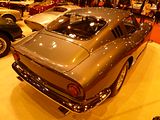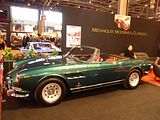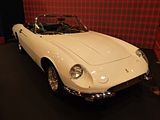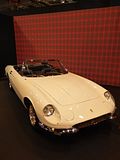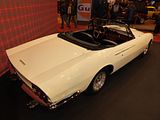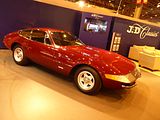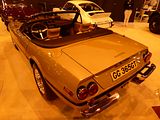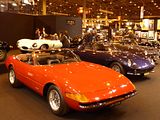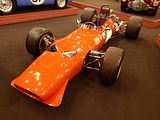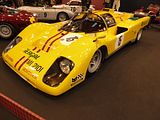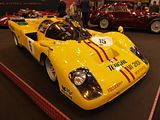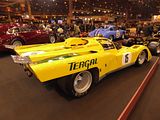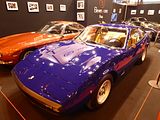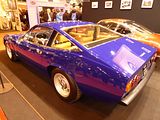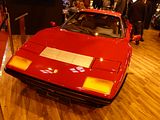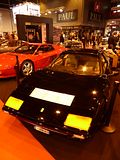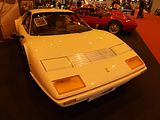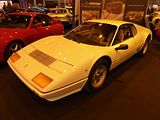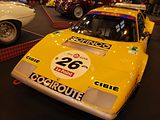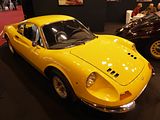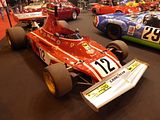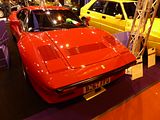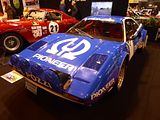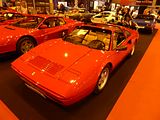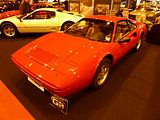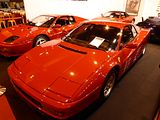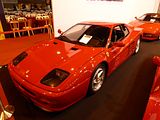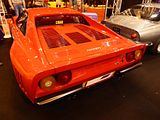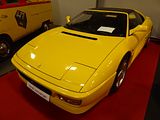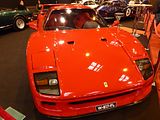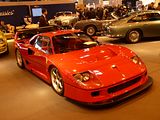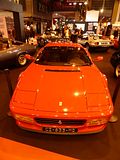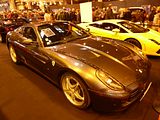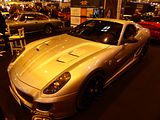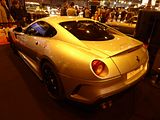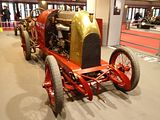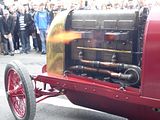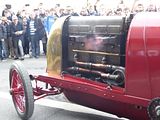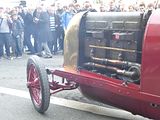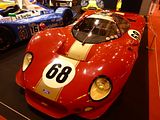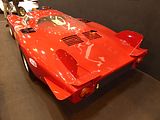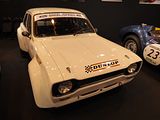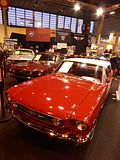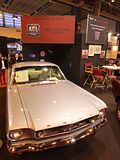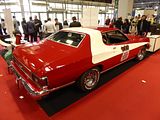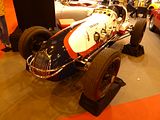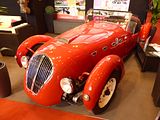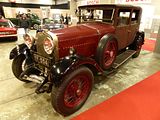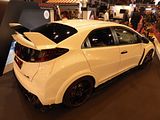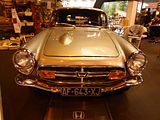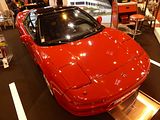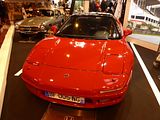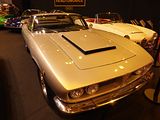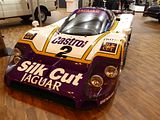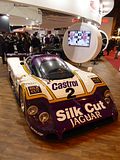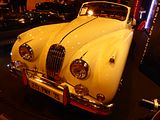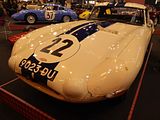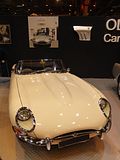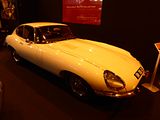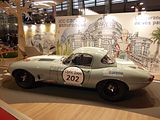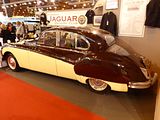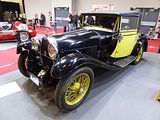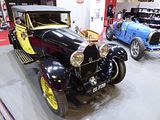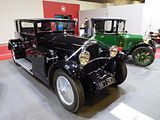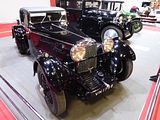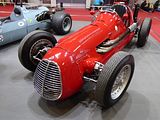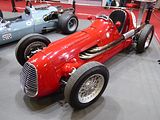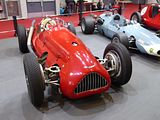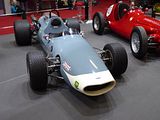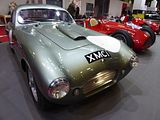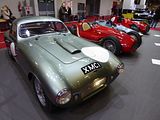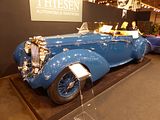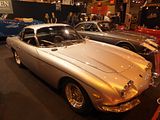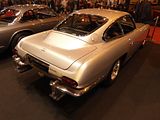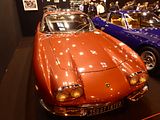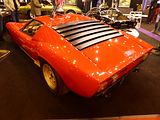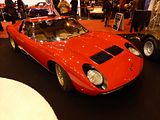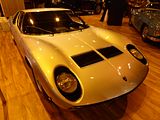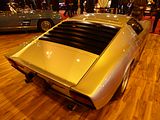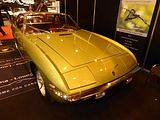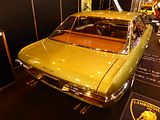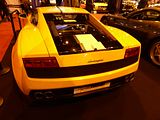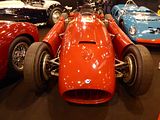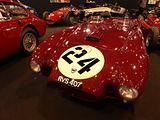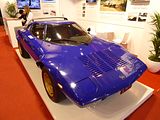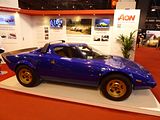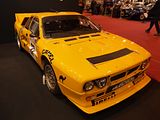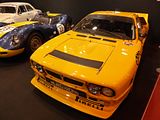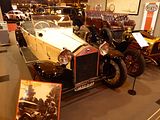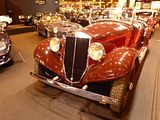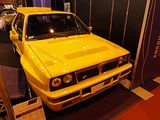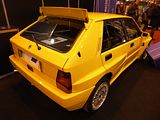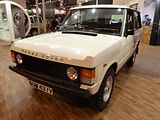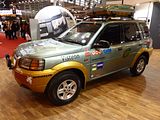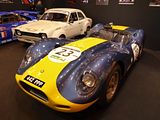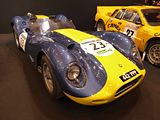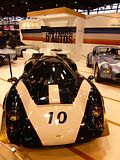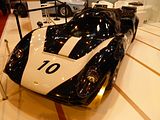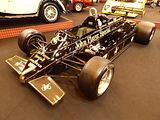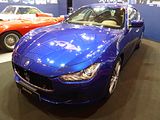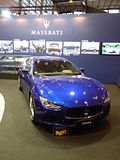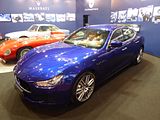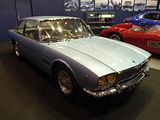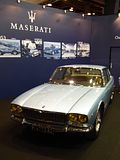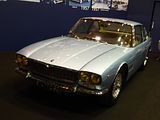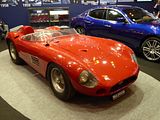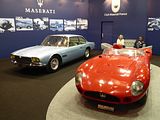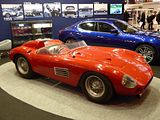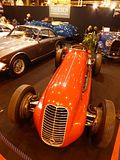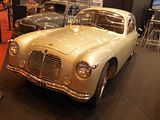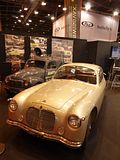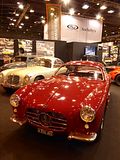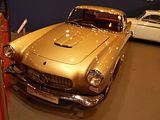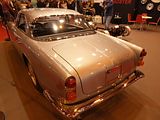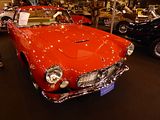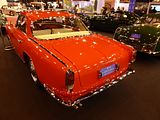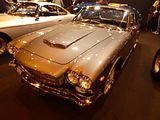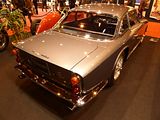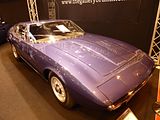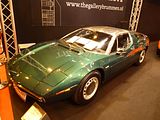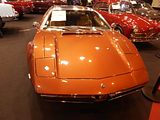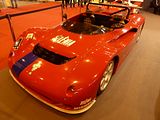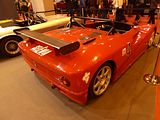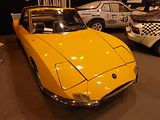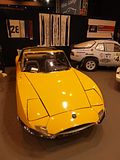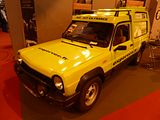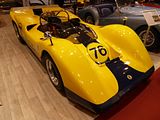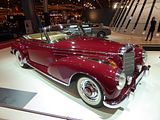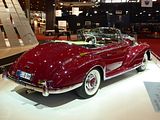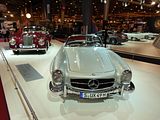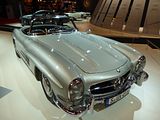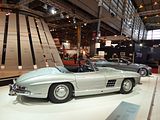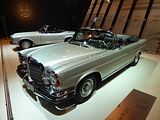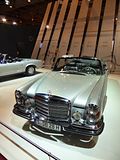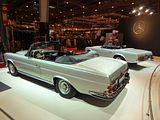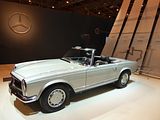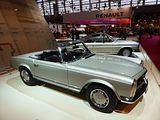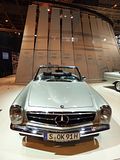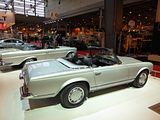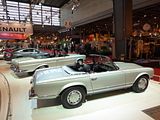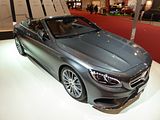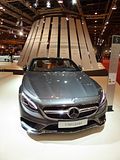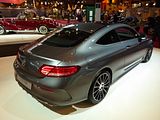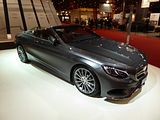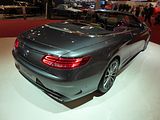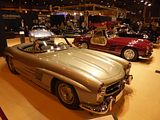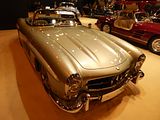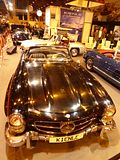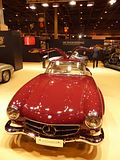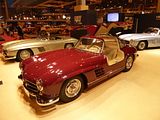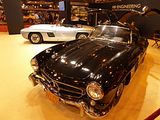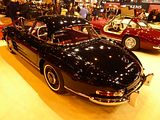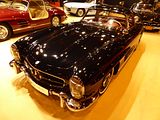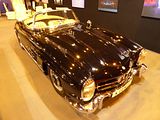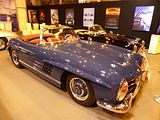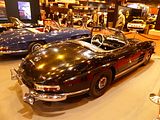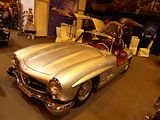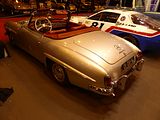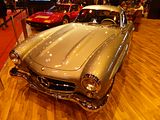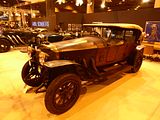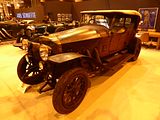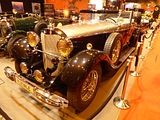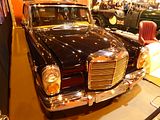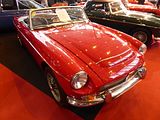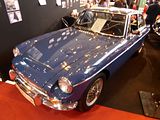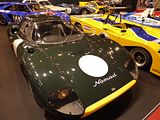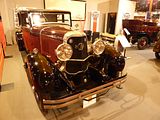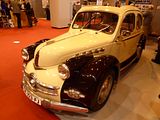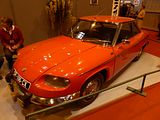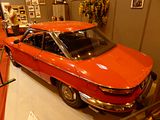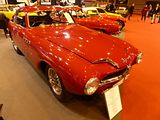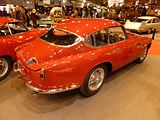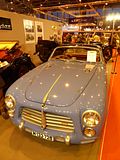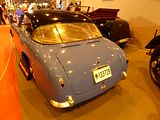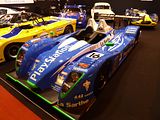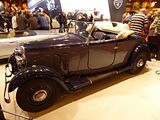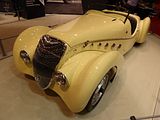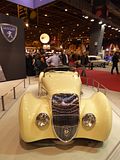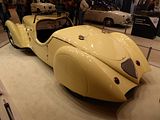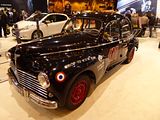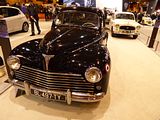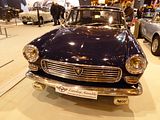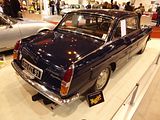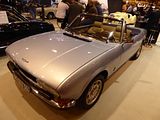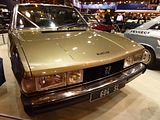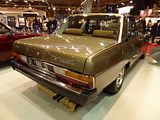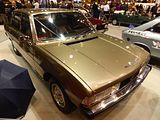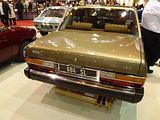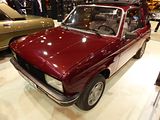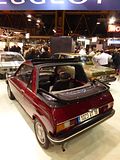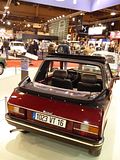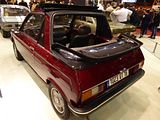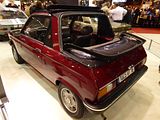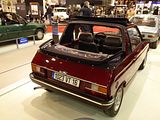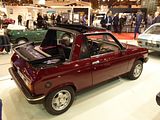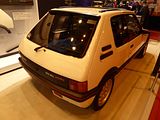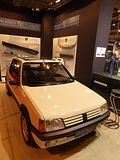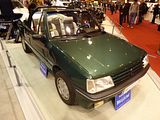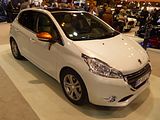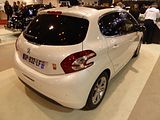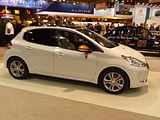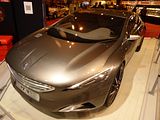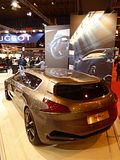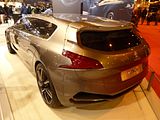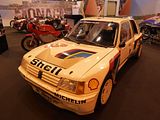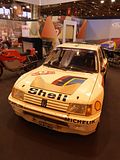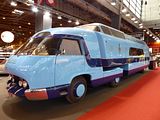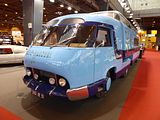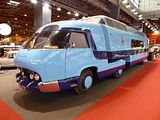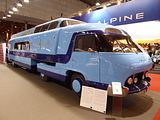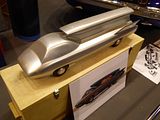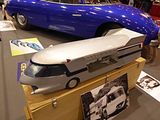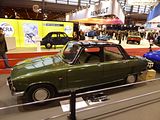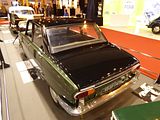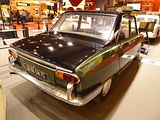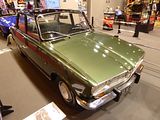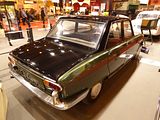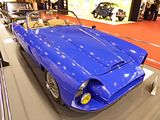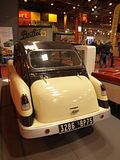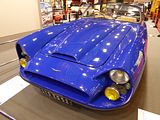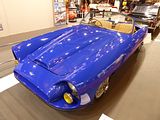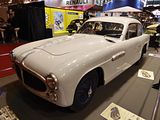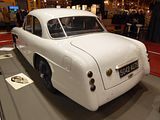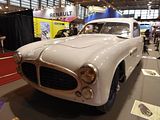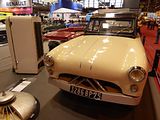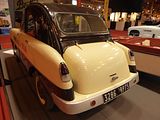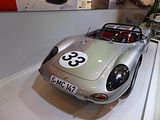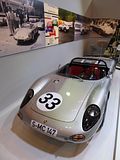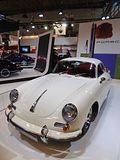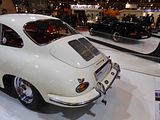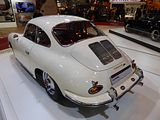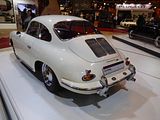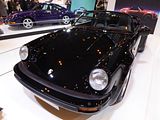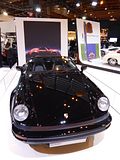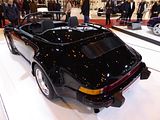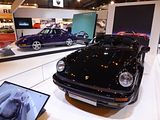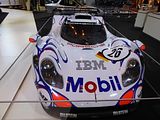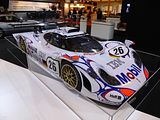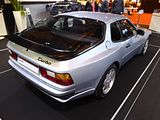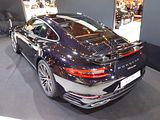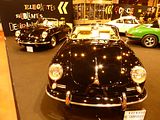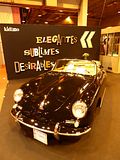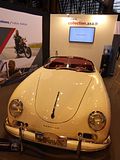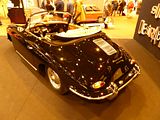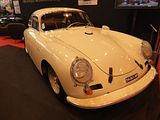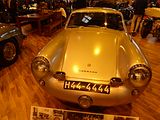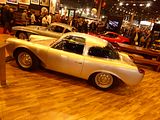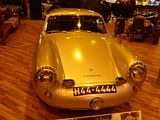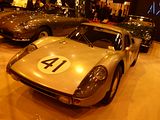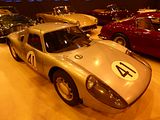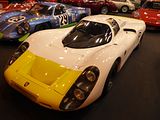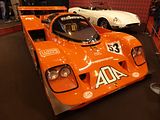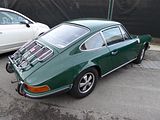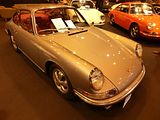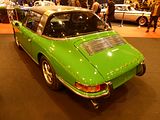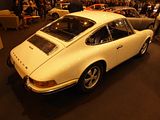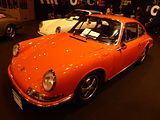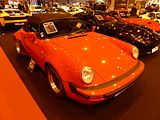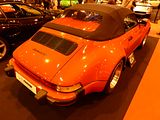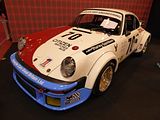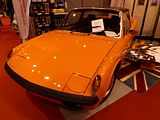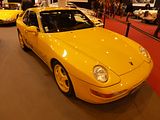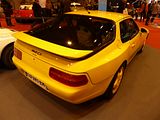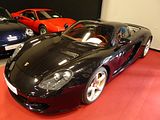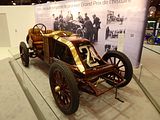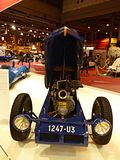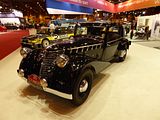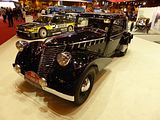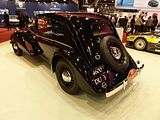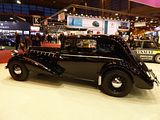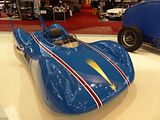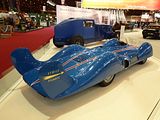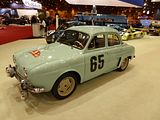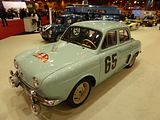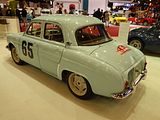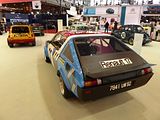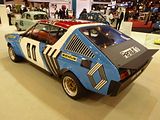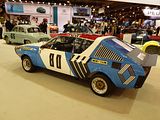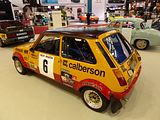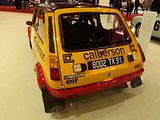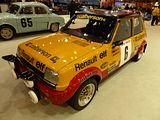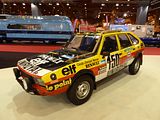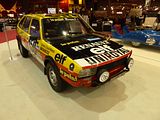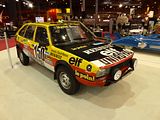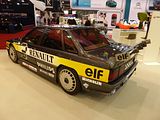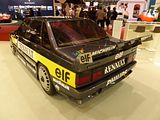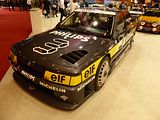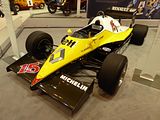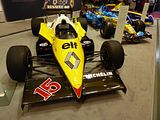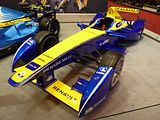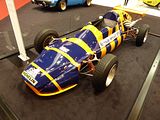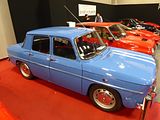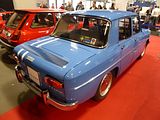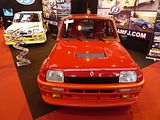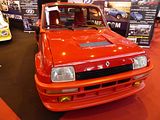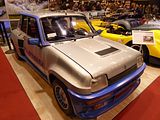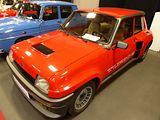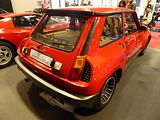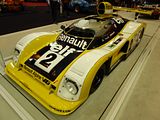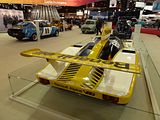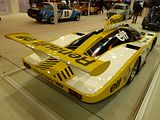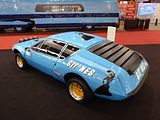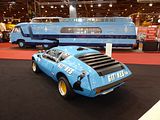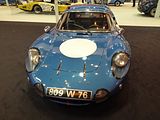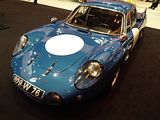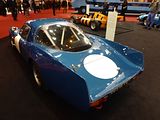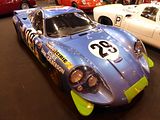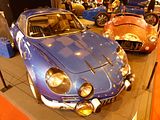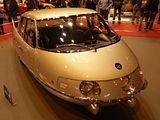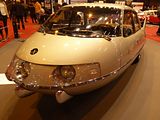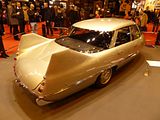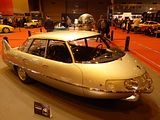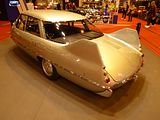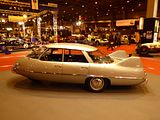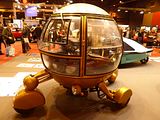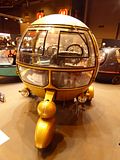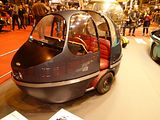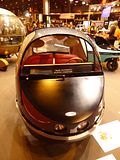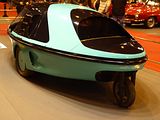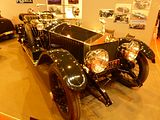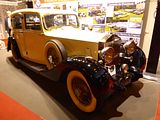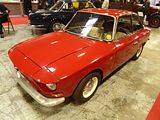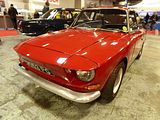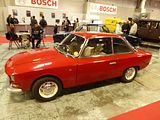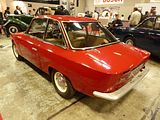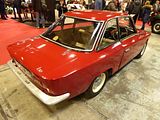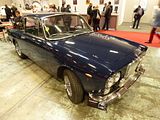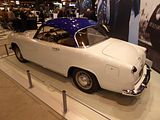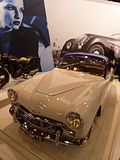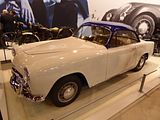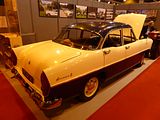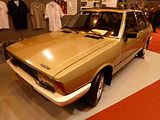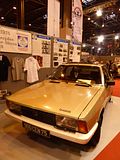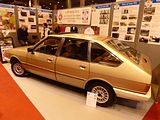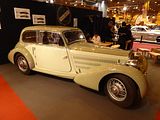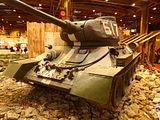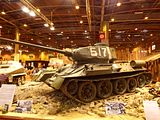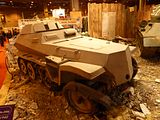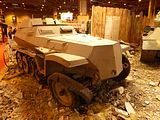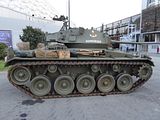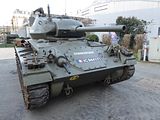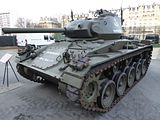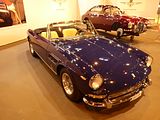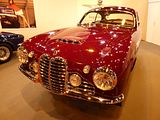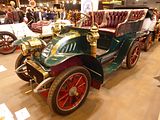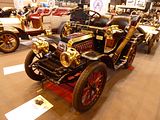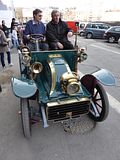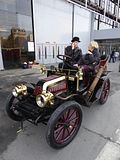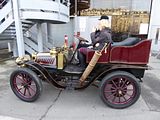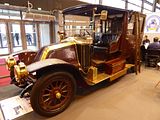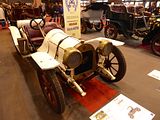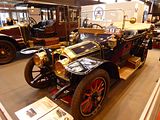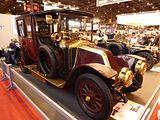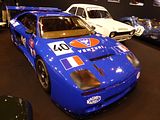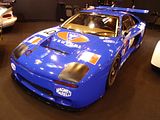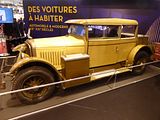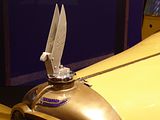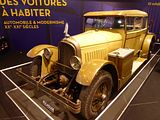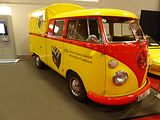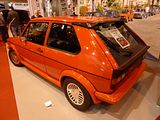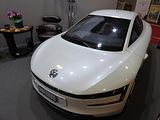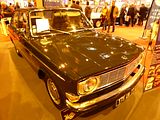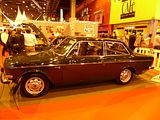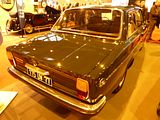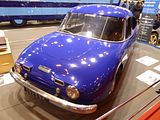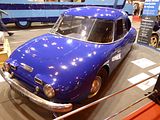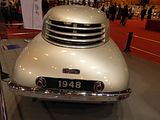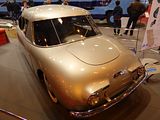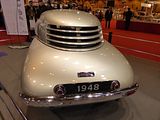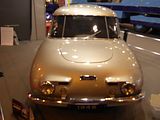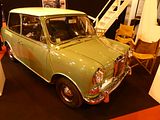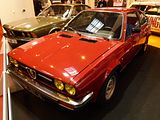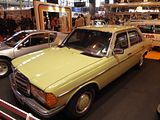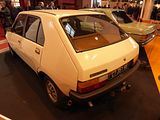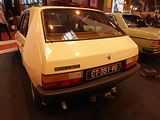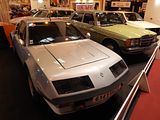To many people, Rétromobile is considered to be the calendar’s opening top-tier event, and rightly so. It’s built up quite a reputation over the years, and the 2016 edition was the 41st to be held. Where else can you find World War One tanks, automotive jumble, humble car clubs and multi-million-euro collector classics all in one place? It’s all curated with typical French abandon, but as the hundreds of dealers and high-profile collectors in attendance prove, it remains a ‘must-go’ event, with over 500 cars on show, many of them of word renown, and often make their first appearance in public for some considerable time. In recent years, the event has expanded beyond the main Hall 1, which has allowed more space for those who wish to exhibit. Among them are not just the three French manufacturers, all of whom support the event with extensive displays, but a few others as well, and there are also many of the high-end dealers from across Europe, including such well-known names as Fiskens, Thiesen, Gallery Brummen, Axel Schutte and Swiss dealer, Lukas Hüni AG. A growing number of Car Clubs have space – mostly quite a small space – in Hall 2, and there is always a vast autojumble area, as well as countless stalls selling paintings, prints and sculptures, including Unique & Limited which showed off its new print featuring a Bugatti Type 35 at the Targa Florio. Elsewhere, a large wall was adorned with a plethora of large-scale photographs by Jacques Henri Lartigue, many of which were intimate portraits of such racing heroes as Steve McQueen and Jackie Stewart. Artcurial hold a high profile auction during the show, and they have a vast area allocated for the cars that have on offer. Cheekily, you have to buy their catalogue to gain access for a close-up view, though you can see some of the cars that they are offerings from the perimeter of their area. A number of themed displays are chosen for the event each year, and these are interspersed among the other exhibits. Some of the cars are taken outside during he day, and fired up so they can drive around the exhibition halls, and this is always a popular diversion for those who want some fresh air. There’s an awful lot to see, so it really will take all day to try to take it in. And that is precisely what I did. There are a lot of photos here, but even so, there were things I missed, of course.
ABARTH
Most people think of Abarth and Italian cars, but until the acquisition by Fiat in 1971, Abarth was essentially a tuning company that worked with a number of manufacturers. One of them was Porsche and on the Fiskens stand, I came across this rather splendid Abarth-Porsche 356B GTL, dating from 1961. In keeping with FIA regulations, Porsche created a new lightweight 356 with help from Abarth. After Porsche had considered numerous Italian companies to manufacture a lightweight 356 body, they settled on Abarth. Franco Scaglione penned the first initial drawings which attempted to reduce frontal area, overall height. Included was an adjustable scoop on the rear deck lid. Made entirely of aluminium, Abarth’s body was smaller than the Reutter 356 in every dimension and reduced drag from 0.398 Cd to 0.365 Cd. This new body also contributed to considerable weight loss, coming in at 1762 lbs, very near the FIA’s minimum 1780 lbs. Delivered from Turin, the first prototypes were delivered in February of 1960. They were somewhat rough, but sporting enough to win the Targa Florio. Paul Sträle bought the second prototype and finished the Targa first in class. he would go on to repeat this feat the following year. This car is chassis number 1002 which ran at Le Mans in 1961 with racing number 37, for Frenchman Auguste Veuillet.
This Fiat 500 Van was rather splendid, and dates from the period when Abarth had just set up as a separate company, specialising in making tuning parts for Fiat models.
Rather more familiar was this 595SS
AC
There were a couple of examples of the legendary Cobra here, including one in Equipe Europe livery.
ALFA ROMEO
There were a number of examples of Alfa’s iconic 6C 1750 here. As was common place at the time, Alfa supplied the chassis and the engine, and the customer chose their preferred coachbuilder to create the body. Among those on show was an unusual one supplied by Figoni of Paris, which was first shown at the 1933 Paris Show. This is believed to be the only survivor.
Also bodied by Figoni is this 8C 2300. Chassis 2311239, and seen here on Lukas Huni’s stand, this 8C 2300 was originally sent to Carrossiers Figoni Paris in 1935. Delivered to Chateau Calvayrac for owner Count Raoul de Calvayrac the car remarkably survived the Nazi occupation of France buried under a large pile of hay. After WW2 the Count decided to have the car repainted in yellow and brown to give it a new look. In 1950 the artist Hubert Harmon feel in love with the car, and having purchased it and registered it as 933 F6 in Cannes shipped it to New York. It was then purchased by Jim Ibold of Cincinnati. Jim kept the car from 1951 until 2004 when it was purchased by Ferrari expert Patrick Ottis directly from his friend Jim Ibold. It was Patrick who returned it to the original finish of two shades of red.
The Touring body is one of the ones you see more often, and that is the coachbuilder who clothed this example of the 6th Series 6C 1750. The car dates from 1933.
Later in the decade, Alfa Romeo were still focused on racing but increasingly were making a series of road cars. This is an 8C 2900B with a Touring body. The 8C 2900 was designed to compete in sports car races in general and the Mille Miglia in particular. It used the 2.9 L version of the 8C engine and was based on the 8C 35 Grand Prix racing chassis. As such, it had an inline 8-cylinder 2.9-litre engine using two Roots type superchargers fed by two updraught Weber carburettors and fully independent suspension with Dubonnet-type trailing arm suspension with coil springs and hydraulic dampers at front and swing axles with a transverse leaf spring at the rear. The 8C 2900A was shown to the public at the 1935 London Motor Show and was advertised for sale there. The engine, with a compression ratio of 6.5:1 and a stated power output of 220 bhp at 5300 rpm, was detuned from the Grand Prix racing version. Ten 2900As were built, five in 1935 and five in 1936. Scuderia Ferrari entered three 8C 2900As in the 1936 Mille Miglia and again in the 1937 Mille Miglia. In 1936 they finished in the top three positions, with Marquis Antonio Brivio winning, Giuseppe Farina finishing second, and Carlo Pintacuda finishing third. In 1937 they finished in the top two positions, with Pintacuda winning and Farina finishing second; the third 2900A, driven by Clemente Biondetti, did not finish. The 8C 2900A also won the 1936 Spa 24 Hours with Raymond Sommer and Francesco Severi. The 8C 2900B began production in 1937. The 2900B design made some concessions to comfort and reliability. The engine was detuned further, having a compression ratio of 5.75:1 and a stated power output of 180 bhp at 5200 rpm. The 2900B chassis was available in two wheelbases: the Corto (short) at 110.2 in, which was longer than the 2900A’s 107.0 in wheelbase, and the Lungo (long) at 118.1 in. The wheels of the 2900B had 19-inch rims fitted with 17-inch hydraulic drum brakes. Thirty-two 2900Bs were built in regular production, ten in 1937, and twenty-two in 1938. Another 2900B was assembled from parts in 1941. Most of these cars were bodied by Carrozzeria Touring, although a few were bodied by Pininfarina.
This very striking 6C 2500 Competizione dates from 1948. Alfa Romeo started to make the 2500 Series of cars just before the onset of the war. The 2500 had an enlarged engine compared to the predecessor models, with this Vittorio Jano designed double overhead cam engine available with either one or three Weber carburettors. The triple carburettor version was used in the top of line SS (Super Sport) version, and it output 145 bhp, and this was coupled with a four speed gearbox. The 2443 cc engine was mounted in a steel ladder frame chassis, which was offered with three wheelbase lengths: 3,250 mm (128.0 in) on the Turismo, 3,000 mm (118.1 in) on the Sport and 2,700 mm (106.3 in) on the Super Sport. Although it was clear that World War II was coming and car development would be stopped, Alfa did continue to produce a few hundred 6C 2500s from 1940 to 1945 before resuming production postwar. The Competizione version was launched in 1946 but due to the lack of suitable materials after the war, this amazing car had to wait another couple of years before it could compete on the racetrack; it made up for the wait, and achieved striking results between 1948 and 1950. It won the Pescara Grand Prix in 1949, placed third in the 1949 and 1950 Mille Miglia, and was awarded the Targa Florio in 1950. Just three of them were built and this is one of two surviving cars, which, following four years of hugely successful racing, was mothballed and left untouched for a staggering forty years as part of Michel Dovaz’s fabled ‘Sleeping Beauties’ collection. The interior of 002 has been sympathetically restored based on period styling, with new corduroy, although the instruments are still a pleasant mismatch of period-correct gauges fitted throughout the car’s rich history. It is likely to sell for some serious money.
There was a nice examples of the Alfa Tipo 33/2 on the Fisken stand, a sports racing prototype raced by the Alfa Romeo factory-backed team between 1967 and 1977. These cars took part for Sport Cars World Championship, Nordic Challenge Cup, Interserie and CanAm series. A small number of road going cars were derived from it in 1967, called the Alfa Romeo 33 Stradale. Alfa Romeo started development of the Tipo 33 in the early 1960s, with the first car being built in 1965. It was sent to Autodelta to be completed and for additional changes to be made. It used an Alfa Romeo TZ2 straight-4 engine, but Autodelta produced its 2.0 litre V8 soon after. The 2000 cc Tipo 33 mid-engined prototype debuted on 12 March 1967 at the Belgian hillclimbing event at Fléron, with Teodoro Zeccoli winning. The first version was named as “periscope” because it had very characteristic air inlet. It was powered by a 1995 cc 90° V8 of 270 hp, with a large-diameter tube frame. The original T33 proved unreliable and uncompetitive in the 1967 World Sportscar Championship season, its best result a 5th at the Nürburgring 1000, co-driven by Zeccoli and Roberto Bussinell. In 1968, Alfa’s subsidiary, Autodelta, created an evolution model called 33/2, and one of these cars was shown. At the 24 Hours of Daytona, the Porsche 907 with 2.2 litre engines were dominating the overall race, but Alfa took the 2-litre class win, with Udo Schütz and Nino Vaccarella; after that the car was named as “Daytona”. The win was repeated at the Targa Florio, where Nanni Galli and Ignazio Giunti also took second place overall, followed by teammates Lucien Bianchi and Mario Casoni. Galli and Giunti then won the class at the Nürburgring 1000 km, where the 2.5 litre version finished for the first time, 4th place in the 3.0 litre class with Schütz and Bianchi. However, in most races, the Alfa drivers were outclassed by their Porsche rivals which used bigger engines. In 1968, the car was used mainly by privateers, winning its class in the 1000km Monza, Targa Florio and Nürburgring races. At the end of season Alfa Romeo had finished third in the 1968 International Championship for Makes. A total of 28 cars were built during 1968, allowing the 33/2 to be homologated as a Group 4 Sports Car for 1969. Alfa continued to develop the car, and with the 33TT12 Alfa Romeo won the 1975 World Championship for Makes, and with the 33SC12 the 1977 World Championship for Sports Cars, taking the first place in all eight of the championship races. This Tipo 33/2 entered the Daytona 24 hours in 1968.
Oldest of them was a fabulous Giulietta Sprint. Following the launch of the 1900 Saloon in 1951, Alfa’s next new model range would be cheaper and aimed at capturing some of the market from middle class buyers. Known as Giulietta, the 750 and later 101 Series were a series of family-sized cars made from 1954 to 1965, and Alfa Romeo’s first, successful, foray into the 1.3-litre class. The first to be introduced was the Giulietta Sprint 2+2 coupé which was premiered at the 1954 Turin Motor Show. Designed by Franco Scaglione at Bertone, it was produced at the coachbuilder’s Grugliasco plant, near Turin. A year later, at the Turin Motor Show in April 1955, the Sprint was joined by the 4-door saloon Berlina. In mid 1955, the open two-seat Giulietta Spider, featuring convertible bodywork by Pininfarina arrived. The Giulietta used unibody construction and a front-engine, rear-wheel-drive layout. Front suspension was by control arms, with coaxial coil springs and hydraulic dampers. At the rear there was a solid axle on coil springs and hydraulic dampers. The axle was located by a longitudinal link on each side, and by a wishbone-shaped arm linking the top of the aluminium differential housing to the chassis. All Giuliettas (save for the last SZ examples) had hydraulic drum brakes on all four corners. The Giulietta used an Alfa Romeo Twin Cam straight-four of 1290 cc, with an aluminium alloy engine block and cast iron inserted sleeves. Bore and stroke measured 74.0 mm and 75.0 mm. The aluminium alloy cylinder head was of a crossflow design and featured hemispherical combustion chambers. The double overhead camshafts were driven by two timing chains, and acted on two valves per cylinder, angled 80°. In 1957 a more powerful Berlina version, called Giulietta T.I. (Turismo Internazionale) was presented with minor cosmetic changes to the bonnet, the dial lights and rear lamps. Carrozzeria Colli also made the Giulietta station wagon variant called Giulietta Promiscua. Ninety-one examples of this version were built. Carrozzeria Boneschi also made a few station wagon examples called Weekendina. A new version of the Giulietta Berlina debuted at the Frankfurt Motor Show in 1959. Mechanical changes were limited to shifting the fuel pump from the cylinder head to a lower position below the distributor, and moving the previously exposed fuel filler cap from the tail to the right rear wing, under a flap. The bodywork showed a revised front end, with more rounded wings, recessed head lights, and new grilles with chrome frames and two horizontal bars. The rear also showed changes, with new larger tail lights on vestigial fins, which replaced the earlier rounded rear wings. The interior was much more organised and upholstered in new cloth material; the redesigned dashboard included a strip speedometer flanked by two round bezels, that on the T.I. housed a tachometer and oil and water temperature gauges. The T.I. also received a front side repeater mounted in a small spear, unlike the Normale which kept the earlier small round lamp with no decorations. During 1959 the type designation for all models was changed from 750 and 753 to 101. In February 1961 the 100,001st Giulietta rolled out of the Portello factory, with a celebration sponsored by Italian actress Giulietta Masina. In Autumn 1961 the Giulietta was updated a second time. Both Normale and T.I. had revised engines and new exhaust systems; output rose to 61 bhp and 73 bhp. With this new engine the car could reach a speed of almost 100mph. At the front of the car square mesh side grilles were now pieced together with the centre shield, and at the rear there were larger tail lights. Inside the T.I. had individual instead of bench seats, with storage nets on the seatbacks. June 1962 saw the introduction of the Alfa Romeo Giulia, which would eventually replace the Giulietta. As until 1964 the Giulia only had a larger 1.6-litre engine, production of the standard Berlina ended with 1963, whilst the T.I. continued for a full year more. A last T.I. was completed in 1965. The Giulietta sport models had a different fate: Sprint, Sprint Speciale and Spider were fitted with the new 1.6-litre engine, received some updates and continued to be sold under the Giulia name until they were replaced by all-new Giulia-based models during 1965. These days., the Berlina is the model you see the least often. A few of the model are used in historic racing where the car takes on the might of those with far larger engines. A total of 177,690 Giuliettas were made, the great majority in Berlina saloon, Sprint coupé or Spider roadster body styles, but there were also Sprint Speciale and Sprint Zagato coupés, and the very low volume Promiscua estate.
There was a second Coupe model in the Giulietta range. Known as the SS, or Sprint Speciale, it really does live up to the name, as it is rather special. The Sprint Speciale was first shown at the 1957 Turin Show as a prototype. Production cars were launched at the Monza circuit in June 1959. The SS boasted the lowest drag coefficient ever seen in a production car, with a cd of just 0.28, a figure which was not surpassed for 20 years. In 1963, it was updated, taking the Giulia name, when a larger 1600cc engine was put under the bonnet, giving it a top speed of 120 mph, an astonishing figure at the time. It did not come cheap, though, costing a lot more than the Giulia GT that was also first shown in 1963. 1,366 of the earlier Giulietta Sprint Speciale and 1,400 of the later Giulia Sprint Speciale were produced before production ceased in 1963. Just 25 cars were converted to right hand drive by RuddSpeed. You don’t see these cars very often, and of the ones I recall seeing in the past few years, they have all been Giulia versions, so it was a pleasant surprise to come across this Giulietta version.
Following the 1962 launch of the 105-series Giulia, which first complemented and then replaced the 101-series Giulietta, the sport variants of the Giulietta remained on sale for several more years, upgraded to the Giulia’s 1.6-litre engine and rebadged Giulia, until variants of the new models were ready. Thus the Giulietta-based Giulia Spider 1600 and Giulia Spider Veloce were produced from 1962 to 1965 and from 1963 to 1965 respectively and there was an example of such a Spider model here.
It was with the 105 Series of cars that Alfa really found the sort of sales volume that they would need to be able to survive throughout the 1960s. The first car in this range, known as the Giulia, because it was larger than the Giulietta, was the Berlina model launched in 1962. The Giulia was produced from 1962 to 1978 in a bewildering array of similar models, which even the marque enthusiast can find hard to untangle. The styling was quite straight forward, but great attention was paid to detail. The engine bay, cabin and boot were all square shaped. But the grille, the rooflines and details on the bonnet and boot made for an integrated design from bumper to bumper. Thanks to Alfa Romeo using a wind tunnel during its development, the Giulia was very aerodynamic with a drag coefficient of Cd=0.34, which was particularly low for a saloon of the era and not a bad figure even for cars of today. Couple that with the fact that Alfa Romeo was one of the first manufacturers to put a powerful engine in a light-weight car (it weighed about 1,000 kilograms) and thanks to an array of light alloy twin overhead camshaft four-cylinder engine, similar to that of the earlier Giulietta models range, the car had a lively performance which bettered that of many sports cars of the day. The Tipo 105.14 was the first model introduced in 1962. with a 1,570 cc Twin Cam engine with single down-draft carburettor generating 91 hp at 6500 rpm. The “TI” nomenclature referred to a class of Italian saloon car racing known as “Turismo Internazionale”, and had previously been applied to higher-performance versions of the 1900 and Giulietta saloons in the 1950s. However, for the Giulia saloon, the Ti was at first the only version available, and later, with the introduction of the TI Super and Super, the TI became the base version for the 1,600 cc engine class. The steering column gearchange (the only one in the Giulia range) was replaced with a floor change for 1964 (Tipo 105.08). Right hand drive cars, available from 1964, only ever had a floor change (Tipo 105.09). Brakes were by drums all around at first. Discs were introduced later, first at the front, and later all around. A brake servo was not fitted at first, but was introduced in later cars. The steering wheel featured the only horn ring ever in the Giulia range. The dashboard with a strip speedo is a notable feature, as is the steering wheel with a horn ring. The Giulia TI was phased out in 1968 and re-introduced as the austerity model 1600 S. Tipo 105.16 was a special racing model introduced in 1963. Quadrifoglio Verde stickers on the front wings were a distinguishing feature. Only 501 were made for homologation and today it is very rare and desirable. The 1,570 cc engine was fitted with two double-choke horizontal Weber 45DCOE carburettors for 110 hp at 6500 rpm. The body was lightened and a floor gearchange was fitted as standard, as were alloy wheels of very similar appearance to the standard steel ones of the TI. The TI’s instrument cluster with its strip speedometer was replaced with a three-instrument binnacle comprising speedometer, tachometer and a multi-gauge instrument (fuel, water temperature, oil temperature and pressure) – these instruments were similar to those fitted to the contemporary Giulia Sprint and Sprint Speciale coupes and Spider convertibles. The steering wheel was a three-spoke item with centre hornpush, also similar to that of the more sporting models. Braking was by discs all around, although the first cars used drums and early disc models lacked a servo which was introduced later. The police cars seen in The Italian Job were of this type. Tipo 105.06 was an austerity model made from 1964 to 1970 with a 1,290 cc single-carburettor engine for 77 hp at 6000 rpm. Four-speed gearbox with floor change fitted as standard (the 1300 was the only Giulia model not fitted with a five-speed gearbox). Though the engine was given a 105 series type number, it was basically the engine from the 101 series Giulietta Ti. This model appears not to have been exported to many markets outside Italy, if at all. Braking was by discs all around, without a servo at first, later with a servo. Tipo 105.26 was introduced in 1965. It transferred the technology from the racing TI Super to a road car, to make the most successful Giulia saloon. 1,570 cc engine with two double-choke Weber 40DCOE carburettors for a milder, but torquier tune than the TI Super – 97 hp at 5500 rpm. There was a new dashboard with two large round instruments (speedo and tacho) and clock, a sportier steering wheel with three aluminium spokes and centre horn push, similar to that of the Ti Super, later changed for one with the horn pushes in the spokes. All-around disc brakes with servo were fitted as standard from the outset. The serpent crest of the Sforza family appears in a badge on the C-pillar and is a distinguishing feature of the Super. For 1968, there was a suspension update, including revised geometry and a rear anti-roll bar. The wheels were changed in size from 5J x 15 to 5J x 14, and tyres from 155/15 to 165/14. For 1970, updates included dual-circuit brakes, centre-mounted handbrake lever to replace under-dash “umbrella handle”, larger external doorhandles, and top-hinged pedals (the latter in left hand drive models only; right hand drive continued with bottom-hinged pedals to the end of production). In 1972, Tipo 105.26 was rationalised into the Giulia 1.3 – Giulia 1.6 range. Tipo 105.39 built from 1965 to 1972. Right hand drive model replaced in 1970 by the 1300 Super. 1,290 cc engine with single down-draft carburettor for 81 hp at 6000 rpm. Unlike the re-deployed 101-series Giulietta engine of the austerity-model 1300, the 1300 ti motor was a 105 series engine, basically that of the sportier GT1300 Junior coupe with different camshaft timing (but the same camshafts) and induction system. Five-speed gearbox. Three-spoke bakelite steering wheel with plastic horn push covering the centre and spokes. Dashboard initially with strip speedo like that of the TI. For 1968, updates included a dashboard based on that of the Super, but with a simpler instrument binnacle, still featuring two large round instruments (speedo and tacho) and a separate fuel gauge, and the same suspension, wheel and tire updates applied to the Giulia Super in the same year. For 1970, updates included dual-circuit brakes, centre handbrake, larger external doorhandles and top-hinged pedals (on left hand drive cars only), again as applied to the Super for that year. Tipo 105.85 was basically a Giulia TI re-introduced in 1968 as a lower-level model to come between the 1300 and 1300 ti on one hand, and the Super on the other. It had a re-interpretation of the 1,570 cc single-carburettor engine for 94 hp at 5500 rpm and similar trim to the 1300 ti. Replaced in 1970 by the 1300 Super which offered similar performance in a lower tax bracket. The last cars from 1970 featured the top-hinged pedals, centre handbrake and dual-circuit brakes as for the Super and 1300 ti. Tipo 115.09 was introduced in 1970. It was basically a 1300 ti fitted with the engine from the GT 1300 Junior coupe that featured two double-choke horizontal carburettors; the engine actually had the GT 1300 Junior type number. This model was rationalised into the Giulia Super 1.3 – Giulia Super 1.6 range in 1972. In 1972 a rationalisation of the Giulia range saw the Super 1300 (Tipo 115.09) and the Super (Tipo 105.26) re-released as the Super 1.3 and Super 1.6. The two models featured the same equipment, interior and exterior trim, differing only in engine size (1,290 cc and 1,570 cc) and final drive ratio. The 1300 ti was dropped. A small Alfa Romeo badge on the C-pillar is a distinguishing feature, as are hubcaps with exposed wheel nuts. In December 1972 Alfa-Romeo South Africa released the 1600 Rallye. This locally developed more powerful 1600 cc version of the 1300 Super, using the 1300’s single-headlight body shell. The car was largely ready for competition and was only planned to be built in limited numbers, and was fitted with racing-style rear-view mirrors, rally lamps, fully adjustable seats, and a limited-slip differential. Claimed power was 125 hp. The Giulia Super range was re-released in 1974 as the Nuova Super range, including the Giulia Nuova Super 1300 and 1600 This and featured a new black plastic front grille and a flat boot lid without the characteristic centre spine. Otherwise the cars differed little from their Giulia Super predecessors and bore the same Tipo numbers with an S suffix. A Nuova Super fitted with a Perkins 1,760 cc diesel with 54 hp at 4000 rpm, the firm’s first attempt at diesel power. The same Perkins diesel was used also in Alfa Romeo F12 van. The diesel version was slow, 138 km/h (86 mph), and the engine somehow unsuitable for a sport sedan so it was not big seller, only around 6500 examples were made in 1976 and the car was not sold in the UK. Production of the Giulia ceased in 1977.
Representing the 105 Series Coupe range was this 1750 GTV. The first car, called the Alfa Romeo Giulia Sprint GT. was revealed at a press event held at the then newly opened Arese plant on 9 September 1963, and displayed later the same month at the Frankfurt Motor Show. In its original form the Bertone body is known as scalino (step) or “step front”, because of the leading edge of the engine compartment lid which sat 1/4 an inch above the nose of the car. The Giulia Sprint GT can be distinguished from the later models by a number of features including: Exterior badging: Alfa Romeo logo on the front grille, a chrome script reading “Giulia Sprint GT” on the boot lid, and rectangular “Disegno di Bertone” badges aft of the front wheel arches; flat, chrome grille in plain, wide rectangular mesh without additional chrome bars; single-piece chrome bumpers; no overriders. Inside the cabin the padded vinyl dashboard was characterised by a concave horizontal fascia, finished in grey anti-glare crackle-effect paint. Four round instruments were inset in the fascia in front of the driver. The steering wheel was non-dished, with three aluminium spokes, a thin bakelite rim and a centre horn button. Vinyl-covered seats with cloth centres and a fully carpeted floor were standard, while leather upholstery was an extra-cost option. After initially marketing it as a four-seater, Alfa Romeo soon changed its definition of the car to a more realistic 2+2. The Giulia Sprint GT was fitted with the 1,570 cc version of Alfa Romeo’s all-aluminium twin cam inline four, which had first debuted on the 1962 Giulia Berlina. Breathing through two twin-choke Weber 40 DCOE 4 carburettors, on the Sprint GT this engine produced 105 hp at 6,000 rpm. Like all subsequent models, the Sprint GT was equipped with an all-synchromesh 5-speed manual transmission. The braking system comprised four Dunlop disc brakes and a vacuum servo. The rear brakes featured an unusual arrangement with the slave cylinders mounted on the axle tubes, operating the calipers by a system of levers and cranks. According to Alfa Romeo the car could reach a top speed of “over 180 km/h (112 mph)”. In total 21,902 Giulia Sprint GT were produced from 1963 to 1965, when the model was superseded by the Giulia Sprint GT Veloce. Of these 2,274 were right hand drive: 1,354 cars fully finished in Arese, and 920 shipped in complete knock-down kit form for foreign assembly. For 1966, the Giulia Sprint GT was replaced by the Alfa Romeo Giulia Sprint GT Veloce, which was very similar but featuring a number of improvements: a revised engine—slightly more powerful and with more torque—better interior fittings and changes to the exterior trim. Alongside the brand new 1750 Spider Veloce which shared its updated engine the Sprint GT Veloce was introduced at the 36th Geneva Motor Show in March 1966, and then tested by the international specialist press in Gardone on the Garda Lake. Production had began in 1965 and ended in 1968. The Giulia Sprint GT Veloce can be most easily distinguished from other models by the following features: badging as per Giulia Sprint GT, with the addition of round enamel badges on the C-pillar—a green Quadrifoglio (four-leaf clover) on an ivory background—and a chrome “Veloce” script on the tail panel; black mesh grille with three horizontal chrome bars; the grille heart has 7 bars instead of 6; stainless steel bumpers, as opposed to the chromed mild steel bumpers on the Giulia Sprint GT. The bumpers are the same shape, but are made in two pieces (front) and three pieces (rear) with small covers hiding the joining rivets. Inside the main changes from the Giulia Sprint GT were imitation wood dashboard fascia instead of the previous anti-glare grey finish, front seats revised to a mild “bucket” design, and a dished three aluminium spoke steering wheel, with a black rim and horn buttons through the spokes. The Veloce’s type 00536 engine, identical to the Spider 1600 Duetto’s, featured modifications compared to the Giulia Sprint GT’s type 00502—such as larger diameter exhaust valves. As a result it produced 108 hp at 6,000 rpm, an increase of 3 hp over the previous model, and significantly more torque. According to the manufacturer top speed now exceeded 185 km/h (115 mph). Early Giulia Sprint GT Veloces featured the same Dunlop disc brake system as the Giulia Sprint GT, while later cars substituted ATE disc brakes as pioneered on the GT 1300 Junior in 1966. The ATE brakes featured an handbrake system entirely separate from the pedal brakes, using drum brakes incorporated in the rear disc castings. Though the Sprint GT Veloce’s replacement—the 1750 GT Veloce—was introduced in 1967, production continued throughout the year and thirty final cars were completed in 1968. By then total Giulia Sprint GT Veloce production amounted to 14,240 examples. 1,407 of these were right hand drive cars, and 332 right hand drive complete knock-down kits. The Alfa Romeo 1750 GT Veloce (also known as 1750 GTV) appeared in 1967 along with the 1750 Berlina sedan and 1750 Spider. The same type of engine was used to power all three versions; this rationalisation was a first for Alfa Romeo. The 1750 GTV replaced the Giulia Sprint GT Veloce and introduced many updates and modifications. Most significantly, the engine capacity was increased to 1779 cc displacement. Peak power from the engine was increased to 120 hp at 5500 rpm. The stroke was lengthened from 82 to 88.5 mm over the 1600 engine, and a reduced rev limit from 7000 rpm to 6000 rpm. Maximum torque was increased to 137 lb·ft at 3000 rpm. A higher ratio final drive was fitted (10/41 instead of 9/41) but the same gearbox ratios were retained. The result was that, on paper, the car had only slightly improved performance compared to the Giulia Sprint GT Veloce, but on the road it was much more flexible to drive and it was easier to maintain higher average speeds for fast touring. For the United States market, the 1779 cc engine was fitted with a fuel injection system made by Alfa Romeo subsidiary SPICA, to meet emission control laws that were coming into effect at the time. Fuel injection was also featured on Canadian market cars after 1971. Carburettors were retained for other markets. The chassis was also significantly modified. Tyre size went to 165/14 from 155/15 and wheel size to 5 1/2J x 14 instead of 5J x 15, giving a wider section and slightly smaller rolling diameter. The suspension geometry was also revised, and an anti-roll bar was fitted to the rear suspension. ATE disc brakes were fitted from the outset, but with bigger front discs and calipers than the ones fitted to GT 1300 Juniors and late Giulia Sprint GT Veloces. The changes resulted in significant improvements to the handling and braking, which once again made it easier for the driver to maintain high average speeds for fast touring. The 1750 GTV also departed significantly from the earlier cars externally. New nose styling eliminated the “stepped” bonnet of the Giulia Sprint GT, GTC, GTA and early GT 1300 Juniors and incorporated four headlamps. For the 1971 model year, United States market 1750 GTV’s also featured larger rear light clusters (there were no 1970 model year Alfas on the US market). Besides the chrome “1750” badge on the bootlid, there was also a round Alfa Romeo badge. Similar Quadrofoglio badges to those on the Giulia Sprint GT Veloce were fitted on C pillars, but the Quadrofoglio was coloured gold instead of green. The car also adopted the higher rear wheelarches first seen on the GT 1300 Junior. The interior was also much modified over that of earlier cars. There was a new dashboard with large speedometer and tachometer instruments in twin binnacles closer to the driver’s line of sight. The instruments were mounted at a more conventional angle, avoiding the reflections caused by the upward angled flat dash of earlier cars. Conversely, auxiliary instruments were moved to angled bezels in the centre console, further from the driver’s line of sight than before. The new seats introduced adjustable headrests which merged with the top of the seat when fully down. The window winder levers, the door release levers and the quarterlight vent knobs were also restyled. The remote release for the boot lid, located on the inside of the door opening on the B-post just under the door lock striker, was moved from the right hand side of the car to the left hand side. The location of this item was always independent of whether the car was left hand drive or right hand drive. Early (Series 1) 1750 GTV’s featured the same bumpers as the Giulia Sprint GT Veloce, with the front bumper modified to mount the indicator / sidelight units on the top of its corners, or under the bumper on US market cars. The Series 2 1750 GTV of 1970 introduced other mechanical changes, including a dual circuit braking system (split front and rear, with separate servos). The brake and clutch pedals on left hand drive cars were also of an improved pendant design, instead of the earlier floor-hinged type. On right hand drive cars the floor-hinged pedals were retained, as there was no space for the pedal box behind the carburettors. Externally, the series 2 1750 GTV is identified by new, slimmer bumpers with front and rear overriders. The combined front indicator and sidelight units were now mounted to the front panel instead of the front bumper, except again on the 1971-72 US/Canadian market cars. The interior was slightly modified, with the seats retaining the same basic outline but following a simpler design. 44,269 1750 GTVs were made before their replacement came along. That car was the 2000GTV. Introduced in 1971, together with the 2000 Berlina sedan and 2000 Spider, the 2 litre cars were replacements for the 1750 range. The engine displacement was increased to 1962 cc. Oil and radiator capacities remained unchanged. The North American market cars had fuel injection, but everyone else retained carburettors. Officially, both versions generated the same power, 130 hp at 5500 rpm. The interior trim was changed, with the most notable differences being the introduction of a separate instrument cluster, instead of the gauges installed in the dash panel in earlier cars. Externally the 2000 GTV is most easily distinguished by its grille with horizontal chrome bars, featuring protruding blocks forming the familiar Alfa heart in outline, smaller hubcaps with exposed wheel nuts, optional aluminium alloy wheels of the same size as the standard 5. 1/2J × 14 steel items, styled to the “turbina” design first seen on the alloy wheels of the Alfa Romeo Montreal, and the larger rear light clusters first fitted to United States market 1750 GTV’s were standard for all markets. From 1974 on, the 105 Series coupé models were rationalised and these external features became common to post-1974 GT 1300 Junior and GT 1600 Junior models, with only few distinguishing features marking the difference between models. 37,459 2000 GTVs were made before production ended and these days they are very sought after with prices having sky-rocketed in recent years.
The Montreal was introduced as a concept car in 1967 at Expo 67, taking its name from the city where the event was held. Originally, the concept cars were displayed without any model name, but the public took to calling it The Montreal. It was a 2+2 coupe using the 1.6-litre engine of the Alfa Romeo Giulia TI and the short wheelbase chassis of the Alfa Romeo Giulia Sprint GT, with a body designed by Marcello Gandini at Bertone. One of the two concept cars built for Expo 67 is displayed in the Alfa Romeo Historical Museum in Arese, Italy, while the other is in museum storage. Reaction to the concept was sufficiently encouraging that Alfa decided to put the car into production. The result, the Tipo 105.64, was shown at the 1970 Geneva Motor Show and was quite different from the original, using a 2593 cc 90° dry-sump lubricated V8 engine with SPICA (Società Pompe Iniezione Cassani & Affini) fuel injection that produced around 200 PS (197 hp), coupled to a five-speed ZF manual gearbox and a limited-slip differential. This engine was derived from the 2-litre V8 used in the 33 Stradale and in the Tipo 33 sports prototype racer; its redline was set at 7,000 rpm, unheard of for a V8 at that time. The chassis and running gear of the production Montreal were taken from the Giulia GTV coupé and comprised double wishbone suspension with coil springs and dampers at the front and a live axle with limited slip differential at the rear. Since the concept car was already unofficially known as The Montreal, Alfa Romeo kept the model name in production. Stylistically, the most eye catching feature was the car’s front end with four headlamps partly covered by unusual “grilles”, that retract when the lights are switched on. Another stylistic element is the NACA duct on the bonnet. The duct is actually blocked off since its purpose is not to draw air into the engine, but to optically hide the power bulge. The slats behind the doors contain the cabin vents, but apart from that only serve cosmetic purposes. Paolo Martin is credited for the prototype instrument cluster. The Montreal was more expensive to buy than the Jaguar E-Type or the Porsche 911. When launched in the UK it was priced at £5,077, rising to £5,549 in August 1972 and to £6,999 by mid-1976. Production was split between the Alfa Romeo plant in Arese and Carrozzeria Bertone’s plants in Caselle and Grugliasco outside Turin. Alfa Romeo produced the chassis and engine and mechanicals and sent the chassis to Caselle where Bertone fitted the body. After body fitment, the car was sent to Grugliasco to be degreased, partly zinc coated, manually spray painted and have the interior fitted. Finally, the car was returned to Arese to have the engine and mechanicals installed. It is worth noting that because of this production method, there is not necessarily any correspondence between chassis number, engine number and production date. The Montreal remained generally unchanged until it was discontinued in 1977. By then, production had long ceased already as Alfa were struggling to sell their remaining stock. The total number built was around 3900. None of them were sold in Montreal, Quebec since Alfa did not develop a North American version to meet the emission control requirements in the United States & Canada. The car was both complex and unreliable which meant that many cars deteriorated to a point where they were uneconomic to restore. That position has changed in the last couple of years, thankfully, with the market deciding that the car deserves better, and prices have risen to you whereas a good one would have been yours for £20,000 only a couple of years ago, you would now likely have to pay more than double that.
The 155 was very successful in touring car racing, using the Supertouring-homologated GTA and the V6 TI for the DTM. The Alfa Romeo 155 V6 TI was a FIA Class 1 touring car which was powered by a high-revving 2.5 litre 60° V6 engine, coupled to a four wheel drive system, producing 400 PS at 11500 rpm. Alfa Corse entered two 155 V6 TIs for works drivers Alessandro Nannini and Nicola Larini; the 1993 season was dominated by Larini winning 11 of 22 races, In 1994 the rivals from Mercedes seemed to have the advantage but Alfa did manage to win a further 11 races. A more consistent performance from the Germans gave them the title. In the UK in 1993, Larini in an Alfa 155 was placed second in the FIA Touring Car Challenge behind Paul Radisich in a Ford Mondeo. Between 1992 and 1994, the 155 also managed to take the Italian Superturismo Championship, the Spanish Touring Car Championship (with Adrián Campos), and the British Touring Car Championship (with Gabriele Tarquini). For the 1995 season the team got new sponsorship livery from Martini Racing. The 1996 version had a 2.5 litre 90° V6 engine based loosely on the PRV engine delivering 490 PS at 11,900 rpm, had a top speed of around 300 km/h (190 mph) and weighed 1,060 kilograms. The 155 remained competitive until it was replaced with the 156, finishing third in the DTM (then known as the International Touring Car Championship, or ITC) in 1996 with Alessandro Nannini and winning the Spanish championship again in 1997 with Fabrizio Giovanardi. All told, the Alfa 155 V6 TI achieved a total off 38 wins (plus 3 other non-championship races). The victories were obtained by seven different drivers: 17 (+1) Nicola Larini, 13 (+1) Alessandro Nannini, 2 Stefano Modena, 2 (+1) Christian Danner, 2 Michael Bartels, 1 Kris Nissen and 1 Gabriele Tarquini. In the UK, the car is best remembered for its winning ways in the Touring Car Championship (my 1995 Alfa had a sticker in the rear window reminding everyone of the fact), The 156 was to continue the high standard set by the 155, winning the European Touring Car Championship multiple times. The car seen here is not actually one of the original race cars, but a recreation in homage to this successful career.
ARTCURIAL AUCTION
A vast area is given over to the Artcurial auction, which takes place during the show. You have to buy a catalogue to get in among the exhibits, and this costs more than the entry to the Show. I chose not to, and had to content myself with looking at what you could see from around the perimeter of the reserved area. That was plenty, though of course the star attraction, the 1957 Ferrari 335 S, raced in period by such legends as Phil Hill, Wolfgang von Trips and Stirling Moss and later owned by the famed collector Pierre Bardinon, was cunningly placed right in the middle, and was difficult to photograph, even with a long zoom lens!
There were a number of Alfa Romeo models in the sale. The two I could see were both ones with relatively rare bodies, both from Zagato: a Giulietta SZ and the later Junior Zagato
This BMW M635CSi was not quite standard, with some extra lower bodywork added.
This appears to be a Bugatti Brescia Type 13, but in fact started out as a Type 23 model which was, at some point, shortened to the style you see now, and is referred to as the Keoshian car. It was offered for sale last year as well, failing to make its reserve, but this time id did find a new buyer.
Citroen DS and 2CV Sahara
Delahaye 235M
Ferrari 365 GT4 BB and Daytona Coupe and Spider
This is a 1951 Ford Comete. Launched in 1951 by Ford France (SAF), the Comet was a luxury coupe which elegant design was entrusted to “Stabilimenti Farina” and the manufacture of the body to Facel Metallon. It is worth noting that this is one of the first projects by Jean Daninos before he launched his own brand, Facel Vega. The line is smooth and fluid. With luxury a requirement, the car was powered by a V8 engine of 2158cc. This engine developed 74bhp up to 1953, allowing it to reach a top speed of 140 km/h. The production totalled 3,064 units.
Even more unusual is this 1939 Graham Paige. This car’s history is particularly interesting for at least two reasons: one is it has got very special bodywork and another is that it would have been owned by Françoise Sagan or at least by her family, the car is known as “the Sagan car”. Its story begins at the end of the Thirties. 20 chassis would have been shipped from Detroit to Paris in 1938 and 1939. They were consigned to selected coach builders, Marcel Pourtout, Saoutchik, Van Vooren and Neirinick in Brussels, but we do not how many chassis to each coach builder. In 1985, the well known restorer, André Lecocq, told the owner that Pourtout had been sent only five chassis, building four as coupes and one as a cabriolet, which would be the car we are offering. According to another source, (Automobilia magazine n° 67, March/April 2004), Pourtout would have made 12 cabriolets between April 1938 and the end of 1939. This sounds a lot, and whatever the correct number may be, it was still a very rare car. The car was powered by a supercharged straight six 3,5 litre engine, developing 115 BHP and mated to a three speed gearbox with overdrive. Thanks to the archives of the Pourtout family, we know that chassis 501 450 left the Pourtout workshop in June 1939 as a two seater cabriolet. It was sold for 25,000 francs to the Paris dealer Chapat, Avenue de la Grande Armée, the name of the first owner is difficult to decipher. Mr. Quoirez, Françoise Sagan’s father, would have bought the car for her eighteenth birthday. The car had done 60,000 kms and before giving it to Françoise he had it fully serviced. The engine and steering were reconditioned, the transmission and suspension checked. The car was repainted, perhaps this is when it was painted pale blue, the hood was recovered and new tyres were fitted. We’ve got a photograph of the novelist driving the Graham Paige, but she didn’t use it much as it wasn’t long before she’d bought her first Jaguar. The impressive Franco-American cabriolet was laid up in a garage at her father’s country house until 1970. Denis Westoff, Francoise’s son, confirms in an email to the current that he remembers seeing the car in his grandfather’s garage, painted pale blue and with dark chestnut upholstery. In 1970, the car was sold to Ms. Francine Veyssiere, who wanted to open a motor museum in the South West of France, but this came to nothing. In 1983 the present owner, a German collector, bought it still in the Gironde. The car was still pale blue with its chestnut upholstery. Later he was to restore it to its original white. This particular Graham Paige is especially impressive, with its shark nose grille and its forward sloping wings, like a predator waiting to pounce. It was one of the last attempts of its builder to appeal to the public with the theme of “Spirit of Motion”.
Jaguar XK120 and Mark 2 Saloon
Lamborghini Diablo Roadster and Espada
Lancia Aurelia GT2500 Coupe
One of the nicer cars I could see was this Maserati Khamsin. This car was conceived to take over from the Ghibli. First seen on the Bertone stand at the November 1972 Turin Auto Show, it was designed by Marcello Gandini, and was Bertone’s first work for Maserati. In March 1973 the production model was shown at the Paris Motor Show. Regular production of the vehicle finally started a year later, in 1974. The Khamsin was developed under the Citroën ownership for the clientele that demanded a front-engined grand tourer on the lines of the previous Ghibli, more conventional than the mid-engined Bora. In 1977 a mild facelift added three horizontal slots on the Khamsin’s nose to aid cooling. Inside it brought a restyled dashboard and a new padded steering wheel. One Khamsin was delivered to Luciano Benetton in 1981. Despite the many improvements over its predecessor, the Khamsin didn’t replicate its success; partly due to the concurrent fuel crisis that decreased demand for big V8 grand tourers. Production ended in 1982, with 435 vehicles made, a mere third of the Ghibli’s 1274 examples production run. 155 of which had been exported to the United States.
Maserati 3500GT
Porsche 911
Renault Dauphine Gordini 1093
Renault-Alpine A310 Group 4
There were a couple of examples of the Triumph Italia on offer.
The final car to catch my eye was certainly the wackiest. This is a 1941 Pierre Faure Type PFA Biplace électrique, version luxe. The Pierre Faure microcar was one of the many responses to the shortage of raw materials during World War II. With its backbone chassis and electric engine powered by six batteries, it could reach 40km/h and range was estimated at 50 to 70km. Around 20 were built. This car was bought new by Yves Le Bihan, an engineer of l’école Centrale and the former director of the Compagnie des Chemins de Fer du Nord. This automobile enthusiast with a fascination for propulsion systems (he had filed a patent for a combustion engine, and also for a machine that could measure the strength of a horse in horsepower!), acquired this car for economic reasons during the occupation, and it is registered 7858 FJ 3. As a mute witness of this dark period, the car still has its “Ausweis” (“Pass”) that is fixed behind the windscreen and the headlights are still equipped with shutters! After the war, the car was stored by his son, in Brittany, in a former stable, and it has not moved since then. When emptying the room where the car was stored, the family remembered the car, and it is precisely in the same place that we found it. The granddaughter of Yves Le Bihan, who was a child in the 1950s, remembers having played in this strange machine, heading out for long imaginary journeys. The car is complete (except for batteries), the front bumper has been removed and everything is in strict original condition, only the hood and left front fender have been damaged during storage. Even the oil dispenser can still be found in the engine compartment, and the key still hangs on the dashboard. The transmission chains and two replacement crown/pinions come with the car. This rare car is a touching witness to a difficult period in history, where ingenuity made up for the shortages. It sold for just over €20,000.
ASTON MARTIN
This is a Le Mans, a two or four seat sports car made by Aston Martin between 1932 and 1934. Aston Martin’s single-overhead-cam engine with a Bore/Stroke of 69.3 mm x 99 mm, had first been seen in the 1927 models, was highly efficient and now had an output of 70 bhp at 4750 rpm from 1.5 litres, an outstanding development by early 1930s standards. Twin Horizontal SU carburettors were fitted. The aluminium body was mounted on a separate steel chassis which had beam axles front and rear with semi-elliptic leaf springs. 4-Wheel drum brakes, mechanically operated at the rear, and by cable at the front were used. During 1932 the Aston Martin International Le Mans had slowly sold at £650; the 1933 Aston Martin Le Mans model retailed at £595, thereby increasing the chance of the car selling faster. Aston Martin, encouraged by the car’s reception, began to offer alternative wheelbase lengths: 102 inches/2591 mm or 120 inches/3048 mm and a choice of open two-seater or four-seater bodywork. The cars were long, low and immediately recognisable by their unique radiator style and had great character making all the appropriate mechanical noises that characterised Aston Martin. By the standards of the early 1930s, Aston Le Mans were speedy cars – compared to the pace of the MG and Singer- with a top speed in the region of 85 mph (137 km/h) and acceleration from 0–50 mph in 16 seconds. Aston Martin made the cars exclusive; between 1932 and 1933, only 130 were produced.
Oldest of the post-war Astons here was this DB2/4. This was the first new post-war design, and the first car to adopt the now legendary DB naming convention, reflecting the fact that in 1947 David Brown had bought the Aston Martin and Lagonda companies and incorporated them as Aston Martin Lagonda Ltd. Lagonda’s 2.6 litre dual overhead cam, straight-six engine, more powerful than the pushrod 1.9 litre unit in the Aston Martin 2-Litre Sports, was the main objective in Brown’s acquisition of the company. W. O. Bentley had supervised the engine’s design, which was largely by William (Willie) Watson, an engineer with the pre-war Invicta company who had collaborated on Lagonda’s pre-war V12 and also designed the short-lived post-war version. Work then started on producing a new car, which was called the DB2. This new model would utilise a version of the Lagonda engine in a shortened version of the tube-frame chassis designed by Claude Hill for the Aston Martin 2-Litre Sports, with a fastback coupé body designed by Frank Feeley. Three pre-production cars were entered for the 1949 24 Hours of Le Mans. One, which would become the development car for the production DB2, had the Lagonda straight-6, while the four-cylinder Aston Martin 2-litre unit powered the other two. After six laps the Lagonda-powered car, driven by Leslie Johnson, retired with overheating caused by failure of the water pump. One of the 2-litre cars was in 4th place and running without brakes when it crashed two hours short of the finish, fatally injuring driver Pierre Maréchal. The other finished 7th, crewed by Arthur Jones and Nick Haines. A month later, the larger-engined car, driven by Leslie Johnson and Charles Brackenbury, finished 3rd in the Spa 24-hour race, where one of the 2-litre cars was driven to 5th by Nick Haines and Lance Macklin. For 1950 all three factory team cars were equipped with the Lagonda engine. At the 1950 Le Mans race the one driven by George Abecassis and Lance Macklin finished 5th, with Brackenbury and Reg Parnell bringing another home 6th, which won Aston Martin 1st and 2nd in the 3-litre class. Across the Atlantic, Briggs Cunningham drove his DB2 to 2nd in its class at the inaugural Sebring race meeting in December 1950. The factory team cars continued racing in Europe throughout 1951, including at Le Mans, where Macklin and Eric Thompson took 3rd overall, with Abecassis and Brian Shawe-Taylor 5th. David Brown soon embarked on a series of Aston Martins designed specifically for competition use, starting with the DB3. Meanwhile, the production DB2 debuted at the New York Auto Show in April 1950 and continued in production until April 1953, by which time 411 had been made. The first 49 had a chrome-framed front grille in three separate parts, and large rectangular cooling vents in the front wings. Subsequent cars had a one-piece grille with horizontal chrome slats, and no side vents. The single-piece bonnet was hinged at the front. At the rear of the fixed-head coupé (FHC) a small top-hinged lid gave access to the spare wheel, and luggage space was behind the front seats, accessible only from inside the car. Later in 1950, a Drophead Coupé (DHC) variant was introduced. At least 102 were built. In April 1950, an engine with larger carburettors, inlet camshaft the same as the exhaust (for increased duration), and higher compression ratio pistons (8.16:1) was made available. Aston Martin’s first Vantage upgrade option offered 125 hp. Initially the higher compression ratio made the engine unsuitable for the British market, as the postwar austerity measures of the early 1950s restricted UK vehicles to 72 octane “Pool petrol”. The first DB2 Vantage, LML 50/21, was delivered to, and raced by, Briggs Cunningham in the United States. A revised version of the DB2 was launched in 1953, called the DB2/4. It was available as a 2+2 hatchback, marketed as a Saloon, as a Drophead Coupé (DHC) and as a 2-seat Fixed Head Coupe. A small number of Bertone bodied spiders were commissioned by private buyers. A further update in 1957 created the Mark III, and this was produced until the launch of the DB4 in 1958.
Follow on model to that was the DB4. Technically it was a development of the DB Mark III it replaced but with a completely new body. The DB4’s design formed the basis for later Aston Martin classics, such as the DB4 GT Zagato, the Lagonda Rapide 4-door saloon. It was eventually replaced by the Aston Martin DB5. The lightweight superleggera (tube-frame) body was designed by Carrozzeria Touring in Milan, and its Continental looks caused a sensation on its unveiling at the 1958 London Motor Show. Although the design and construction techniques were Italian, the DB4 was the first Aston to be built at the company’s Newport Pagnell works. The 3670 cc engine, designed by Tadek Marek, was a double overhead cam straight-6, with cylinder head and block of cast R.R.50 aluminium alloy, a further development of the earlier engine. The engine was prone to overheating initially, but the 240 hp produced by the twin-SU carburettor version made buyers forgive this unfortunate trait[citation needed]. Servo-assisted disc brakes were fitted all round: early 11.5 in Dunlops were replaced by Girlings. The independent front suspension used ball-jointed wishbones, coil springs and rack-and-pinion steering. The live rear axle also used coil springs and was located by a Watt’s linkage. The normal final-drive ratio for British and European use was 3.54:1: in the United States the ratio was usually 3.77. Customers wanting a car with an especially high top speed could choose a 3.31:1 ratio. A car with the British standard 3.54 final drive ratio tested by The Motor magazine in 1960 had a top speed of 139.3 mph and could accelerate from 0-60 mph in 9.3 seconds. A fuel consumption of 17.7 mpg. The test car cost £3967 including taxes. There were five “series” of DB4. The most visible changes were the addition of window frames in Series II and the adoption of a barred (rather than eggcrate) grille in Series IV. The Series III cars differed from the earlier ones in having taillights consisting of three small lamps mounted on a chrome backing plate. Earlier cars have single-piece units and the last Series V cars of September 1962 have similar taillights but recessed. The Series V also has a taller and longer body to provide more interior space, though the diameter of the wheels was reduced to keep the overall height the same. The front of the Series V usually was of the more aerodynamic style as already used on the Vantage and GT models, a style that was later carried over to the DB5 cars. A convertible was introduced in October 1961. It featured in-house styling similar to the Touring saloon, and an extremely rare factory hardtop was also available. In total, 70 DB4 convertibles were made from a total DB4 production run of 1,110 cars. 30 of these were Series IV, with the remaining 40 belonging to the Series V. 32 of the total convertibles built (11 and 21 of the different series respectively) were equipped with the more powerful Vantage engine. Top speed for the regular version is about 136 mph. Seen here was a 1961 DB4 Series III which was originally the factory demonstrator and press car.
The Aston Martin DB5 was an evolution of the DB4. The principal differences between the DB4 Series V and the DB5 are the all-aluminium engine, enlarged from 3.7 L to 4.0 L; a new robust ZF five-speed transmission (except for some of the very first DB5s); and three SU carburettors. This engine, producing 282 bhp, which propelled the car to 145 mph, available on the Vantage (high powered) version of the DB4 since March 1962, became the standard Aston Martin power unit with the launch in September 1963 of the DB5. Standard equipment on the DB5 included reclining seats, wool pile carpets, electric windows, twin fuel tanks, chrome wire wheels, oil cooler, magnesium-alloy body built to superleggera patent technique, full leather trim in the cabin and even a fire extinguisher. All models have two doors and are of a 2+2 configuration. Like the DB4, the DB5 used a live rear axle At the beginning, the original four-speed manual (with optional overdrive) was standard fitment, but it was soon dropped in favour of the ZF five-speed. A three-speed Borg-Warner DG automatic transmission was available as well. The automatic option was then changed to the Borg-Warner Model 8 shortly before the DB6 replaced the DB5. The high-performance DB5 Vantage was introduced in 1964 featuring three twin-choke 45DCOE side-draft Weber carburettors and revised camshaft profiles, delivering greater top-end performance at the expense of overall flexibility, especially as legendary Webers are renowned as ‘full-throttle’ devices. This engine produced 325 bhp at 5,500 rpm. 65 DB5 Vantage coupés were built. 123 convertible DB5s were produced (also with bodies by Touring), though they did not use the typical “Volante” name until 1965. The convertible model was offered from 1963 through to 1965. Originally only 19 of the 123 DB5 Convertibles made were left-hand drive. 12 cars were originally fitted with a factory Vantage engine, and at least one further convertible was subsequently factory fitted with a DB6 specification Vantage engine. A rare factory option (actually fitted by Works Service prior to customer delivery) was a steel removable hard top.
From October 1965 to October 1966, Aston Martin used the last 37 of the Aston Martin DB5 chassis’ to make another convertible model. These 37 cars were known as “Short Chassis” Volantes and were the first Aston Martins to hold the “Volante” name. Although calling it a “Short Chassis” is a bit of a misnomer as the “short” comes from comparing it to the subsequent DB6, which has a longer chassis. When compared to the DB5, it is not “short” but rather the same size, however these cars differ to the DB5 convertible models as they feature DB6 split front and rear bumpers and rear TR4 lights, as also used on the DB6.
Also here was the DB6, the model launched in 1965 as a replacement for the DB5. The wheelbase was now 4″ longer than before, resulting in an extensive restyle with a more raked windscreen, raised roofline and reshaped rear quarter windows. Opening front quarter lights made a reappearance, but the major change was at the rear where a Kamm tail with spoiler improved the aerodynamics, greatly enhancing stability at high speeds. “The tail lip halves the aerodynamic lift around maximum speed and brings in its train greater headroom and more luggage space”, declared Motor magazine, concluding that the DB6 was one of the finest sports cars it had tested. Famed employee, Tadek Marek, designed the six cylinder engine, which had been enlarged to 3,995cc for the preceding DB5 and remained unchanged. Power output on triple SU carburettors was 282bhp, rising to 325bhp in Vantage specification. Premiered at the 1965 London Motor Show, the DB6 Volante marked the first occasion the evocative ‘Volante’ name had been applied to a soft-top Aston Martin. After 37 Volante convertibles had been completed on the DB5 short wheelbase chassis, the model adopted the longer DB6 chassis in October 1966. A mere 140 DB6 based Volantes were manufactured, and of these only 29 were specified with the more powerful Vantage engine.
Representing the longest lived design in Aston Martin’s history was this Vantage Volante from the DBS/V8 generation. By the mid 1960s, Aston Martin’s customers had been clamouring for an eight-cylinder car, so Aston Martin designed a larger car. The engine was not ready, however, so in 1967 the company released the DBS with the straight-six Vantage engine from the DB6. Two years later, Tadek Marek’s V8 was ready, and Aston released the DBS V8. Though the body and name was shared with the six-cylinder DBS, the V8 sold for much more. The body was a modern reinterpretation of the traditional Aston Martin look, with a squared-off grille and four headlights (though some consider the styling derivative of the early Ford Mustang). Distinguishing features of the V8 model are the larger front air dam and lack of wire wheels, though some six-cylinder DBS cars also used the V8’s alloy wheels. The tail lights were taken from the Hillman Hunter. A road test report of the time noted that the car had gained 250 lb in weight with the fitting of the V8 in place of the previously used six-cylinder unit, despite the manufacturer’s assurance that the engine weighed only 30 lb more than the older straight-six. Other contributions to the weight gain included heavier ventilated brake discs, air conditioning, fatter tyres, a new and stronger ZF gearbox as well as some extra bodywork beneath the front bumper. Marek’s V8 engine displaced 5,340 cc and used Bosch fuel injection. Output was not officially released, but estimates centre around 315 hp. The DBS V8 could hit 60 mph in 5.9 seconds and had a top speed of nearly 160 mph. 402 DBS V8s were built. In April 1972, the DBS V8 became just the Aston Martin V8 as the six-cylinder DBS was dropped, leaving just this car and the six-cylinder Vantage in production. The V8 became known as the AM V8, a model retroactively referred to as the Series 2 V8 to separate it from later models. Visual differences included twin quartz headlights and a mesh grille, a front design which was to last until the end of production in 1989. AM V8 cars, produced from May 1972 through July 1973, used a similar engine to the DBS V8, albeit with Bosch fuel injection rather than the earlier carburettors. Just 288 Series 2 cars were built. Although David Brown had left the company, he had overseen development of this model. The first 34 cars still carried leftover “DBS V8” badging. The car switched back to Weber carburettors for the Series 3 in 1973, ostensibly to help the car pass new stricter emissions standards in California but most likely because Aston Martin was unable to make the Bosch fuel injection system work correctly. These cars are distinguished by a taller bonnet scoop to accommodate four twin-choke (two-barrel) Weber carbs. The car produced 310 hp and could reach 60 mph in 6.1 seconds with an automatic transmission or 5.7 with a manual. Performance suffered with emissions regulations, falling to 288 hp in 1976. The next year, a more powerful “Stage 1” engine with new camshafts and exhaust brought it up to 305 hp. Production of Series 3 cars lasted from 1973 through October 1978, but was halted for all of 1975. 967 examples were produced in this time. While earlier V8 cars have louvers cut into the little panel mounted beneath the rear windshield, the Series 3 and later cars instead have a small lip at the bottom of this panel, just ahead of the leading edge of the bootlid. The “Oscar India” specification was introduced in October 1978 at the Birmingham International Motor Show. Visually, the former scoop on the bonnet gave way to a closed “power bulge”, while a spoiler was integrated into the tail. Most Oscar India cars were equipped with a Chrysler “Torqueflite” three-speed automatic transmission, with wood trim fitted for the first time since the DB2/4 of the 1950s. Just 352 Oscar India models were built from 1978 through 1985. The power of the now de-smogged engines kept dropping on American market cars, down to a low of 245 hp in the early eighties. The convertible “Volante” was introduced in June 1978, but featured the Series 4 bonnet a few months before the coupé received the Oscar India update. The Volante Series 1 weighs 70 kg (155 lb) more than the coupé, due to the necessity of reinforcing the frame. US market cars received much larger bumpers beginning with the 1980 model year, adding weight and somewhat marring the car’s lines. Owners of US-specified cars often modify them to have the slimmer European bumpers. By 1981, the success of the Volante meant that the coupé model was only built on individual demand. The fuel-injected Series 5 cars were introduced in January 1986 at the New York International Auto Show. The compact Weber/Marelli system no longer needed the space of the previous carburettors, so the bonnet bulge was virtually eliminated. 405 Series 5 cars were built before production ceased in 1989. The Volante Series 2 received the same changes; 216 were built.
AUSTIN HEALEY
There were a couple of examples of the “Big Healey” here, one of Britain’s most popular classics. Donald Healey had been producing a range of expensive sports cars from the 1940s, cars such as the Silverstone, the Abbott and the Farnham. For the 1952 London Motor Show, he produced a new design, which was called the Healey Hundred, based on Austin A90 mechanicals, which he intended to produce in-house at his small car company in Warwick. It was one of the stars of the 1952 Show, and it so impressed Leonard Lord, the Managing Director of Austin, who was looking for a replacement to the unsuccessful A90. that Lord struck a deal with Healey on the spot, to build it in quantity. Bodies made by Jensen Motors would be given Austin mechanical components at Austin’s Longbridge factory. The car was renamed the Austin-Healey 100, in reference to the fact that the car had a top speed of 100 mph. Production got under way in 1953, with Austin-Healey 100s being finished at Austin’s Longbridge plant alongside the A90 and based on fully trimmed and painted body/chassis units produced by Jensen in West Bromwich—in an arrangement the two companies previously had explored with the Austin A40 Sports. By early 1956, production was running at 200 cars a month, 150 of which were being sold in California. Between 1953 and 1956, 14,634 Austin-Healey 100s were produced, the vast majority of them, as was the case for most cars in this post war era, going for export. The car was replaced by an updated model in 1956, called the 100-6. It had a longer wheelbase, redesigned bodywork with an oval shaped grille, a fixed windscreen and two occasional seats added (which in 1958 became an option with the introduction of the two-seat BN6 produced in parallel with the 2+2 BN4), and the engine was replaced by one based on the six-cylinder BMC C-Series engine. In 1959, the engine capacity was increased from 2.6 to 2.9 litres and the car renamed the Austin-Healey 3000. Both 2-seat and 2+2 variants were offered. It continued in this form until production ceased in late 1967. The Big Healey, as the car became known after the 1958 launch of the much smaller Austin-Healey Sprite, is a popular classic now. You come across the 3000 models more frequently than the 100s, as they accounted for more than 60% of all Big Healey production.
There was also a number of the smaller stablemate, the “Frog Eye”. Known officially as the Sprite, it was announced to the press in Monte Carlo by the British Motor Corporation on 20 May 1958, just before that year’s Monaco Grand Prix. It was intended to be a low-cost model that “a chap could keep in his bike shed”, yet be the successor to the sporting versions of the pre-war Austin Seven. The Sprite was designed by the Donald Healey Motor Company, with production being undertaken at the MG factory at Abingdon. It first went on sale at a price of £669, using a tuned version of the Austin A-Series engine and as many other components from existing cars as possible to keep costs down. It was produced for a little over 3 years before being replaced by a Mark 2 version, which was then joined by a badge-engineered MG version, the Midget, reviving a model name used by MG from the late 1920s through to the mid 1950s. Enthusiasts often refer to Sprites and the later Midgets collectively as “Spridgets.” The first Sprite quickly became affectionately known as the “frogeye” in the UK and the “bugeye” in the US, because its headlights were prominently mounted on top of the bonnet, inboard of the front wings. The car’s designers had intended that the headlights could be retracted, with the lenses facing skyward when not in use; a similar arrangement was used many years later on the Porsche 928. But cost cutting by BMC led to the flip-up mechanism being deleted, therefore the headlights were simply fixed in a permanently upright position, giving the car its most distinctive feature. The body was styled by Gerry Coker, with subsequent alterations by Les Ireland following Coker’s emigration to the US in 1957. The car’s distinctive frontal styling bore a strong resemblance to the defunct American 1951 Crosley Super Sport. The problem of providing a rigid structure to an open-topped sports car was resolved by Barry Bilbie, Healey’s chassis designer, who adapted the idea provided by the Jaguar D-type, with rear suspension forces routed through the bodyshell’s floor pan. The Sprite’s chassis design was the world’s first volume-production sports car to use unitary construction, where the sheet metal body panels (apart from the bonnet) take many of the structural stresses. The original metal gauge (thickness of steel) of the rear structure specified by Bilbie was reduced by the Austin Design Office during prototype build, however during testing at MIRA (Motor Industry Research Association) distortion and deformation of the rear structure occurred and the original specification was reinstated. The two front chassis legs projecting forward from the passenger compartment mean the shell is not a full monocoque. The front sheet-metal assembly, including the bonnet (hood) and wings, was a one-piece unit, hinged from the back, that swung up to allow access to the engine compartment. The 43 bhp, 948 cc OHV engine (coded 9CC) was derived from the Austin A35 and Morris Minor 1000 models, also BMC products, but upgraded with twin 11⁄8 inch SU carburettors which gave it 43 hp at 5200 rpm and 52 lb/ft at 3300 rpm. When tested by “The Motor” magazine in 1958. It had a top speed of 82.9 mph and could accelerate from 0-60 mph in 20.5 seconds. Fuel consumption of 43 mpg was recorded. The rack and pinion steering was derived from the Morris Minor 1000 and the front suspension from the Austin A35. The front suspension was a coil spring and wishbone arrangement, with the arm of the Armstrong lever shock absorber serving as the top suspension link. The rear axle was both located and sprung by quarter-elliptic leaf springs, again with lever-arm shock absorbers and top links. There were no exterior door handles; the driver and passenger were required to reach inside to open the door. There was also no boot lid, owing to the need to retain as much structural integrity as possible, and access to the spare wheel and luggage compartment was achieved by tilting the seat-backs forward and reaching under the rear deck, a process likened to potholing by many owners, but which resulted in a large space available to store soft baggage. The BMC Competition Department entered Austin Healey Sprites in major international races and rallies, their first major success coming when John Sprinzel and Willy Cave won their class on the 1958 Alpine Rally. Private competitors also competed with much success in Sprites. Because of its affordability and practicality, the Austin Healey Sprite was developed into a formidable competition car, assuming many variants by John Sprinzel, Speedwell and WSM. The Sebring Sprite became the most iconic of the racing breed of Austin Healey Sprites. Many owners use their Austin Healey Sprites in competition today, fifty years after its introduction. 48,987 “frogeye” Sprites were made and the car remains popular to this day.
AUTOBIANCHI
There were a couple of examples of the A112 on the Autobianchi Owners Club stand. This was a supermini, developed using a shrunken version of the contemporary Fiat 128’s platform. The mechanicals of the A112 subsequently underpinned the Fiat 127. It was introduced in November 1969, as a replacement for the Bianchina and Primula, and was built until 1986, when it made way for the more modern Autobianchi Y10 (branded in most export markets as the Lancia Y10). Over 1.2 million A112s were produced in Autobianchi’s Milan factory. The A112 was available only with a 3-door body. It was offered with the OHV engine of 903 cc from the Fiat 850 capable of attaining 42 PS. The Autobianchi represented the first appearance of this engine in a front-engine, front-wheel drive configuration which would later become familiar to a wider range of drivers in the top selling Fiat 127 and its derivatives. Claimed power increased to 47 PS in 1971, but without any mechanical changes having taken place. The A112 reached a very particular market; by 1984 female buyers represented 35% of A112 owners and about a third were in the 18-24 age range. In September 1971 the A112 E (“E” for Elegant, which also became its name after the 1973 facelift) was introduced. This featured improved seats, higher grade trimming and equipment, as well as a five-speed gearbox later in life. The mechanics were originally identical to the regular version, now referred to as the Normale, but from 1975 until 1977 the Normale’ received a less powerful engine. A performance edition “Abarth” was introduced too. In March 1973 the A112 received a makeover. The grille was new, with a larger mesh, and the bumpers were now of rubber with chrome insert (although the Normale retained the old metal bumpers with rubber strips). A new style of alloys were also available, and the seats and dashboard underwent some changes. The Abarth received a new chess pattern upholstery. In 1975 the third series arrived. The insides in the rear were recontoured, so that the car now became a five-seater (instead of four). The easiest way to spot a third series is that it received new, much larger vents on the C-pillars, as well as redesigned taillights – with integrated reversing lights on the Elegant and Abarth. The Abarth also received a new larger 1050 cc engine (“70HP”), while the Normale’s output dropped to 42 PS in July 1975. All engines were still pushrod units, derived from the old tipo 100 engine first introduced in the Fiat 600. In 1976, due to new emissions standards, the Elegant lost two horsepower, now down to 45 PS. Third series Normales still received metal bumpers, but from now on they were painted black (instead of being chromed) and no longer had a rubber strip. This was the last model to have the diamond shaped turn signals on the front fenders, with later models receiving more orthodox rectangular ones. In November 1977 the “Nuova A112” (new A112) was introduced: The most obvious difference is a slightly taller roof, with a marked edge around the sides. This improved interior habitability considerably. Autobianchi also at this time modified the upmarket version branded as the “A112 Elegant” with an engine enlarged to 965 cc, now promising 48 PS and improved torque. Later, there were also “A112 Elite” and “A112 LX” versions which received even more comfortable equipment. The 903 cc engine of the lesser A112 Normale remained unchanged. In July 1979 the car underwent another styling modification, receiving large black plastic cladding on the rear, surrounding new taillights, and new side trim and bumpers. The grille was also new, and there was black plastic wheelarches to link all of the plastic parts together. The extractor vents behind the rear side windows were also larger, of black plastic, and wrapped around the pillar. In terms of transmissions, a five-speed transmission now became available on certain models. The fifth gear was an overgear, while the ratios of the four lower speeds and the final gearing remained unchanged. The front turn signals were moved from the front of the fenders to a spot just in front of the leading edge of the doors, while a small badge denoting the trim level appeared in the turn signal’s old place. The Normale now became the Junior, and the Elite version was added, a notch above the Elegant in the lineup. There were some very light modifications to the interior. A large, rollback canvas sunroof became available on the Junior, and a rear window wiper became optional across the range. Aside from the new transmission there were no notable mechanical changes. Power outputs remained at 42, 48, and 70 PS. The Abarth also received the new five-speed gearbox, as well as new alloy wheels and foglights as standard. A lot of the plastic excesses of the fifth series were reversed for the sixth series, which was introduced in the autumn of 1982. New smoother bumpers, removal of the wheelarch trim, and a less heavy grille treatment brought back some of the original elegance of the A112, while the interior was also completely renovated. Another new version arrived, the top-of-the-line LX, which featured tinted windows, velvet seat trimming, power windows, metallic paintwork, and a digital clock amongst other creature comforts. Mechanically, the LX was identical to the Elite, with the five-speed transmission and 965 cc engine. The Elegant version was discontinued, with the Elite taking its position in the lineup. The sixth series also received new body-coloured vents on the C-pillar, and the front corner lights were incorporated into the top of the bumper. The seventh series, presented in 1984, only saw minor changes, largely remaining the same as the sixth. The taillights were again redesigned and were now joined by a reflective strip. The rear license plate was relocated to the bumper and the dashboard received modifications, more noticeable in the better equipped Elite and LX versions. The Abarth received standard front foglights, which were optional on the other versions. The Abarth also has red seatbelts. While the Junior retained small hubcaps, and the Abarth received alloys, the rest of the range now received full-face hubcaps. The front corner lights were now white, instead of orange as before. The engines remained as before, all models except the lowest-priced Junior now used five-speed transmissions. By this time, only France, Italy and Israel still used the “Autobianchi” badge; all others had switched to calling the car a Lancia. At the time of the seventh series introduction, a total of 1,115,000 A112s had been built. As the new Autobianchi Y10 was introduced in 1985, the A112 range was cut down considerably, with only the Junior remaining on sale as a low-priced alternative. It was no longer called Junior, however, now being marketed simply as the “Autobianchi A112”. Other than the name change, there were no design changes to the car. Production continued into 1986, at which point 1,254,178 Autobianchi A112s had been built. The most interesting version was the A112 Abarth, introduced in September 1971 at the same time as the Elegant. It was prepared by the motorsports division of the Fiat Group, at first with a 982 cc engine, obtained by increasing the stroke, coupled to a sportive exhaust, a twin carburettor, and a different camshaft. In 1975, displacement was increased to 1,050 cc, while power climbed from 58 HP to 70 HP at 6600 rpm, for a weight of only 700 kg (1,540 lb). The two engines were offered in parallel until production of the smaller unit ended in late 1976. The 1975 model was also the first A112 to use a 5-speed manual gearbox. These changes turned the A112 into a nervous machine, much admired by young performance enthusiasts. The car was entered in various rallying events throughout Europe and even spawned a one-make trophy: the Campionato A112 Abarth spanned eight editions, from 1977 to 1984, and adopted contemporary Group 1 rules, which meant nearly-stock cars. Some famous Italian rally drivers, including Attilio Bettega, Fabrizio Tabaton and Gianfranco Cunico, were among the winners of the championship. The increasing popularity of the A112 in historic rallies and hillclimbs led to the reintroduction of a one-make trophy, called Trofeo A112 Abarth, in 2010. Abarths have often led hard lives, having been preferred by young owners with aggressive driving styles!
AUTOMOBILE CLUB DE L’OUEST
In celebration of 110 years of the Automobile Club de l’Ouest, there was a special display of cars associated with this important organisation, to be found in the walkway that connected Hall 1 with the rest of the site. As the Club is responsible for organising the 24 Heures du Mans race and is indeed based at Le Mans, where they have a museum, many of the cars on show were former competitors at this legendary race. But there were plenty of surprises.
A stark contrast to the comparatively huge sports cars of today, the Ferrari ‘Dino’ Berlinetta Speciale Pininfarina prototype was just such a car. It was created in memory of Enzo’s son by Pinin Farina and named after him, as the Dino (for Alfredino), built on a 206 S Prototype base. This car is unique. The line of the lights and the rear quarter window are master pieces. This car was the star of the 1965 Paris Motor Show. It presaged the later Dino 246, with few thousand copies sold and that we could see on the main circuits of the world. The engine is 1.987 cc four overhead camshafts V6 producing 180 hp. The claimed top speed is 230 kph.
Among the cars that competed at Le Mans that were in this display were a number of cars, of which the oldest was this 1925 Chenard et Walcker Tank Z1 Special.
This is the oldest Ferrari that was at the event, a 1949 166MM Touring Barchetta. This is the car Luigi Chinetti and Lord Selsdom drove to win the 1949 Le Mans 24 Hours. Chinetti drove 22 hours and 48 minutes during these 24 hours since Lord Selsdom was sick. The car has a 1992 cc 140 hp twin overhead camshaft V12. The top speed was claimed at 201 kph.
This Matra-Simca MS670 was the event winner in 1973.
Other cars here included a 1959 Panhard and a Porsche 904 GTS as well as a 908.
Final display car was much more recent. The Porsche 911 RSR has been back at 1993 Le Mans 24 Hours when GTs were again authorised. Designed in 2001, the IMSA Performance Matmut team has become a reference of international GTs. In 14 years the team based in Rouen, France, has got a record of achievements with several category wins at Le Mans 24 Hours, at Petit Le Mans in Atlanta, USA. The victorious car of the LM GTE Am category at the 2013 Le Mans event was offered to the ACO by its partner Matmut in 2015. The engine is a 470 hp six cylinder.
BALLOT
This is a Ballot 2LS, dating from 1921. The Ballot brothers, Édouard and Maurice, founded their company at the Boulevard Brune in south-central Paris in 1905. Édouard Ballot was a former naval officer, which explains the “anchor” that featured in the badges on the cars. Before World War I the factory concentrated on marine and industrial engines, and from 1910 or 1911 they were also offering automobile engines. The company was re-founded as Etablissements Ballot SA in 1910. There is little sign that Edouard Ballot himself took much interest in automobiles until December 1918. That was the month in which he had a significant conversation with René Thomas, a leading racing driver who had won the 1914 Indianapolis 500 race driving a Delage. Ballot was persuaded to build four 4.8-litre cars that would carry the “Ballot” name and compete in the forthcoming Indianapolis 500 race, scheduled for 30 May 1919. Time seemed very short, but Ballot lost no time, notably recruiting the Swiss born engineer Ernest Henry who had already worked on preparing Peugeot cars for their successful participation in the 1914 Indianapolis 500 race. Ballot’s cars competed in the 1919 race, two of them finishing in 4th and 11th places. Ballot was sufficiently encouraged to return the next year, and in the 1920 Indianapolis 500 race a Ballot driven by René Thomas finished in second place: Ballots also took fifth and seventh places. A Ballot vehicle driven by René Thomas also finished second in the 1919 Targa Florio. More successes followed, on both sides of the Atlantic. Ralph DePalma, an American national champion and winner of the 1915 Indianapolis 500, finished second in the 1921 French Grand Prix and French driver Jules Goux finished third. Goux went on to win the inaugural Italian Grand Prix at Brescia, Italy in 1921, driving a Ballot. Second place was taken by the team leader Jean Chassagne on a sister car; a year before, in 1920 Chassagne made the fastest BARC lap of the year at Brooklands on a 4.9-litre Ballot, coming again second. A Ballot with a straight-eight-cylinder 4.9-litre engine competed in the 1921 French Grand Prix. As well as racing engines, the company made a range of road engines which were fitted to their own production cars. The first of Ballot’s own road cars was the 1921 2-litre Ballot 2-litre sports tourer. In 1923 the Ballot 2 LT and a sport version, Ballot 2 LTS followed. By the time of the 19th Paris Motor Show in October 1924, Ballot was established in the market place as a producer of expensive road going cars with spectacular performance. The 2-litre sports tourer again appeared on the manufacturer’s stand at the show. The car still used a four cylinder overhead camshaft 1,994 cc engine, and it sat on a 122.4 inch wheelbase. It was priced, in bare chassis form, at 33,000 francs: Ballot also listed a “Torpedo” bodied version at 46,000 francs. From 1927, eight-cylinder engines were used. In 1931 the company was taken over by Hispano-Suiza. Swift decline followed: the last model was practically a Hispano-Suiza, and only the chassis was provided by Ballot. Ballot closed down in 1932.
A second Ballot here was a 2LT Boulogne Saloon.
BENETTON
This Formula 1 car, Benetton B192-05 is the one which Michael Schumacher drove to victory at the Belgian Grand Prix in 1992.
BENTLEY
There were a couple of examples of the cars that Ettore Bugatti called “the fastest lorries in the world”. There was a 1932 8 litre model with a Vanden Plas 4 seater body and joining it was a 1928 Speed Six.
A close relative of the Rolls Royce Silver Cloud, the S Type was first revealed in April 1955. It represented a complete redesign of the standard production car, the R Type. It was a more generously sized five- or six-seater saloon with the body manufactured in pressed steel with stressed skin construction, with the doors, bonnet and boot lid made of aluminium. The external appearance was very different, although the car still had the traditional radiator grille. Compared to the outgoing R Type, the new model had a three inch longer wheelbase, was lower of build without reducing headroom and with an enlarged luggage boot, softer suspension with electrically operated control of rear dampers, lighter steering and improved braking. The engine, still a clear descendants of the one originally used in the Rolls-Royce Twenty from 1922 to 1929, had its capacity increased to 4887cc, and a four-speed automatic gearbox was standard, with the ability to select individual ratios if desired, which was enough to give the Bentley a top speed of just over 100 mph and 0 – 60 acceleration times of around 13 seconds. Standard and from 1957, long wheelbase saloons were offered and some were sent to the coachbuilders for alternative bodies to be fitted. An upgrade in 1959, creating the S2, saw the installation of a new V8 engine, and in 1962, the S3 cars gained four round headlights. 3072 S Types were made, 145 of them with coachbuilt bodies as well as 35 of the long wheelbase cars, before the model was replaced by the new T Type in 1965.
BERLIET
BIZZARRINI
Designed by the ex-Ferrari chief engineer, Giotto Bizzarrini, in 1963, the 5300 GT Strada was launched by the company in 1965. The car was powered by a 365 hp V8 Chevrolet Corvette engine. Just 133 examples were made, so they are rare. There were a couple here, one a road car and the other a lightweight racer which competed in 1966 at the 1000km of Monza, the Targa Florio and twice at le Mans.
Bizzarrini also managed a scaled-down 5300 GT project. Designed for GM-Opel, it was based on Opel 1900 platform. Bizzarrini’s proposal was more aggressive and attractive in appearance, like a small 5300 GT. The production Opel GT was designed by factory stylists and was less aggressive, but still beautiful. Bizzarrini then decided to build the car on his own. Around 17 prototypes were completed. The car is officially named as the Bizzarrini 1900 GT Europa. One of these cars has a barchetta (“little boat”) body. Some cars are powered by 1300-litre and 1600-litre four-cylinder engines sourced from General Motors, Alfa Romeo and Fiat. There is even a highly developed racing version with a SPICA fuel injection system.
BMW
Although the Iso started off very much as an Italian creation, BMW made the Isetta its own. They redesigned the powerplant around a BMW one-cylinder, four-stroke, 247 cc motorcycle engine which generated 13 hp. Although the major elements of the Italian design remained intact, BMW re-engineered much of the car, so much so that none of the parts between a BMW Isetta Moto Coupe and an Iso Isetta are interchangeable. The first BMW Isetta appeared in April 1955. While it retained the “bubble window” styling, it differed from the Italian model in that its headlamps were fixed separately to the sides of the bodywork and it carried the BMW badge below the windscreen. The car was also redesigned to take a modified version of the 250 cc four-stroke engine from the BMW R25/3 motorcycle and the front suspension was changed. The single-cylinder generated 12 hp at 5800 rpm. The crankcase and cylinder were made of cast iron, the cylinder head of aluminium. However, the head was rotated by 180° compared with the motorcycle engine. The twin-bearing crankshaft was also different in the Isetta power unit, being larger and featuring reinforced bearings. One of the reasons for this was the heavy Dynastart unit which combined the dynamo and self-starter. The fuel mixture was provided by a Bing sliding throttle side draft motorcycle carburettor. In addition to further changes of detail, the BMW engineers enlarged the sump for installation in the car and cooled the engine by means of a radial fan and shrouded ducting. The power train from the four-speed gearbox to the two rear wheels was also unusual: fixed to the gearbox output drive was something called a Hardy disc, which was a cardan joint made of rubber. On the other side of it was a cardan shaft, and finally a second Hardy disc, which in turn was located at the entrance to a chain case. A duplex chain running in an oil bath led finally to a rigid shaft, at each end of which were the two rear wheels. Thanks to this elaborate power transfer, the engine-gearbox unit was both free of tension and well soundproofed in its linkage to the rear axle. In Germany, the Isetta could even be driven with a motorcycle license. The top speed of the Isetta 250 was rated as 85 km/h (53 mph). The first BMW Isetta rolled off the line in April 1955, and in the next eight months some 10,000 were produced. In 1956, the government of the Federal Republic of Germany changed the regulations for motor vehicles. Class IV licences issued from that time onward could only be used to operate small motorcycles and could no longer be used to operate motor vehicles with a capacity of less than 250 cc. At the same time, the maximum capacity allowed for the Isetta’s tax category was 300 cc. Class IV licences issued before the change in the regulations were grandfathered and allowed to be used as before. This change in regulations encouraged BMW to revise their Isetta microcars. In February 1956 a 300cc engine was introduced.] The engineers enlarged the single cylinder to a 72 mm bore and 73 mm stroke, which gave a displacement of exactly 298 cc; at the same time, they raised the compression ratio from 6.8 to 7.0:1. As a result, the engine power output rose to 13 hp at 5200 rpm, and the torque rose to 13.6 ft⋅lb at 4600 rpm. The maximum speed remained at 85 km/h (53 mph), yet there was a marked increase in flexibility, chiefly noticeable on gradients. In October 1956, the Isetta Moto Coupe DeLuxe (sliding-window Isetta) was introduced. The bubble windows were replaced by longer, sliding side windows. The last cars were made in 1962, with production totalling 161,360.
A very different sort of BMW was this V12 LM, a racing car built for sports car racing in 1998. The car was built using a combination of WilliamsF1 engineering and construction and a BMW powerplant. The car was a predecessor to the BMW V12 LMR which debuted in 1999. In 1995 McLaren Cars entered sports car racing using their McLaren F1 GTR in grand touring series like the BPR Global GT Series as well as the 24 Hours of Le Mans. The McLaren F1s were powered by a S70 V12, leading to McLaren and BMW signing an agreement to both develop their racing teams with the assistance of BMW Motorsport. This combination was successful in winning the 1995 24 Hours of Le Mans. However, by 1997 the F1 GTRs were no longer competitive against newer breeds of specially homologated supercars from Mercedes-Benz and Porsche. Due to their declining performance, McLaren pulled out of GT racing at the end of 1997. Unwilling to give up so quickly, BMW Motorsport decided to move from grand tourers to Le Mans prototypes, open cockpit racing cars built specifically for racing and requiring no road legality regulations. During the 1997 decline of McLaren, BMW Motorsport announced a deal with WilliamsF1, at the time Formula One constructors champions, which would see Williams constructing the car’s chassis and develop its aerodynamics for the 24 Hours of Le Mans. At the same time, BMW Motorsport turned to Schnitzer Motorsport, a long time BMW racing team, to be the factory team running the car, now dubbed the V12 LM. The V12 LMs would use the same S70 V12 as the McLaren F1s, although it would be run in its 5990cc configuration. The chassis incorporated an early use of a raised foot box as well as a front diffuser for better aerodynamics and safety. Debuting at the 1998 24 Hours of Le Mans test day in May, the two V12 LM chassis set times which were not favourable, their best lap placing them 11th behind factory entries from Porsche, Toyota, Nissan, and Mercedes-Benz, all of which were running grand tourer-style cars instead of the theoretically faster Le Mans prototypes. By the time qualifying for the race came around in June, the BMWs had improved to 6th fastest in qualifying, placing behind two Porsches, two Mercedes, and a Toyota. Unfortunately, during the race both cars suffered quickly. Vibrations were detected in the drivetrains while at speed. In order to not risk catastrophic failure of the car at speed, the team quickly retired both cars from the event after they had only covered 43 laps for car #2 and 60 laps for car #1. Following the team’s dismal results at Le Mans, further testing found that the aerodynamics and cooling of the car were poorly planned, and that the car could only perform best if ambient temperatures were at ideal conditions. The team originally planned to enter the 1998 Petit Le Mans, but later declined. It was therefore decided that the two V12 LMs would be abandoned and that BMW, Williams, and Schnitzer would start anew in 1999 with the V12 LMR. The two V12 LM chassis were therefore sold off to privateers, with chassis 001/98 going to Thomas Bscher while chassis 002/98 was sold to Team Goh of Japan. With BMW moving onto the all new V12 LMR, only the two privateer teams were left to campaign the rejected V12 LM. Thomas Bscher aligned with David Price Racing forming Price+Bscher Racing to concentrate on the new American Le Mans Series as well as the 1999 24 Hours of Le Mans. In the ALMS, the car would take only two points scoring finishes, leaving it 13th in the points standings. While at Le Mans, the car would wind up taking 5th place overall, only 20 laps behind the V12 LMR which won. The car would make one final appearance at an FIA Sportscar Championship event at the Nürburgring, finishing 4th place overall. Team Goh on the other hand decided to concentrate solely on Le Mans, with the car failing to finish due to gearbox problems. The car made one final appearance at the Fuji 1000km where it took 3rd place overall, 6 laps behind a winning Nissan. For 2000, Team Goh announced a partnership with Japanese constructor Dome, in which the V12 LM would be heavily modified in order to correct its aerodynamic instabilities and cooling problems. The entire front end would be redesigned to relocate the cooling intakes, while vents were added to the side bodywork to assist in cooling. Unfortunately, the car was never campaigned and no other team chose to buy the chassis. For Price+Bscher, David Price Racing reached an agreement to campaign for Panoz Motorsports of the United States, leaving Thomas Bscher to campaign his lone V12 LM. Although losing his assistance from David Price Racing, Bscher was able to run the car at Le Mans, where the car failed to finish due to gearbox damage from an accident, and at the Nurburgring SRWC round in September. Following this, Bscher would retire the car, ending the racing career of the V12 LM.
Originally presented as a concept, the Z07, a styling exercise intended to evoke and celebrate the 1956-’59 BMW 507 and to celebrate the millennium change, the car was a sensation at the ’97 Tokyo Auto Show and its overwhelming popularity spurred BMW’s decision to produce a limited production model. Fortunately, the Z07 had been designed with production in mind. As a result, practical and regulatory considerations necessitated very few changes for the production model. Nevertheless, the windscreen of the Z8 was extended upward, and a larger front airdam was fitted. Both changes were implemented to provide aerodynamic stability and a reasonably placid cockpit environment. The four-spoke steering wheel of the concept car was replaced by a three spoke design. The hardtop was changed from a double-bubble form with a tapering faring to a single dome with a truncated convex backside. The concept’s exotic driver’s side helmet fairing was eliminated to allow easy operation of the power soft top. Despite these changes, the Z8 remained extremely faithful to the concept car. The side-mounted indicators were integrated into the side vents in a fashion that rendered them invisible until activated. The vintage simplicity of the interior was preserved by hiding the modern equipment under retracting panels. Complex compound curves were preserved through the use of an expensive MIG-welded aluminium space frame. The Z8 even retained the concept’s five-spoke wheel design, albeit without the race-style centre lug nut. The Z8’s spaceframe was produced in the Dingolfing Plant and the car hand-finished in Munich. It had an all-aluminium chassis and body and used a 4941 cc 32-valve V8, that developed 400 hp and 370 lb·ft torque. This engine, known internally as the S62, was built by the BMW Motorsport subsidiary and was shared with the E39 M5. The engine was located behind the front axle in order to provide the car with 50/50 weight distribution. The factory claimed a 0–100 km/h (0–62 mph) time of 4.7 seconds; Although it could outperform a Ferrari 360 Modena in several respects, as with most BMW products, its top speed was electronically limited to 155 mph (250 km/h). The Z8 used neon exterior lighting, the tail lights and indicators are powered by neon tubes that offer quicker activation than standard lightbulbs and expected to last for the life of the vehicle. The Z8’s head and tail lights were done by Vipin Madhani. Every Z8 was shipped with a colour-matching metal hardtop. Unlike many accessory hardtops, which are provided for practical rather than stylistic considerations, the Z8 hardtop was designed from the outset to complement the lines of the roadster. In order to promote the Z8 to collectors and reinforce media speculation about the Z8’s “instant classic” potential, BMW promised that a 50-year stockpile of spare parts would be maintained in order to support the Z8 fleet. Due to the limited volume of Z8 production, all elements of the car were constructed or finished by hand, thereby compounding the importance of ongoing manufacturer support for the type. The price point and production process allowed BMW to offer custom options to interested buyers. A significant number of Z8s with non-standard paint and interior treatments were produced over the course of the four-year production run by BMW Individual. 5,703 Z8s were built.
BUGATTI
There were two cars on the modern Bugatti stand: Veyron and a concept version of the Chiron as shown in the online Grand Tursimo game. This little stand, in one corner of the hall was a real draw, with crowds around it most of the day.
Club Bugatti France featured a Type 57 Atalante. This car was built in September 1935 with engine 232 and a factory “roll top” (called a Faux Cabriolet in factory documents). It was on display at the Salon de l’Automobile in Paris in October 1935 and was then delivered to Marestaing in December that year. It stayed in the Paris area, having a number of owners until 1962. At some point a different engine was fitted.
There was another Type 57 Atalante to be found on the Lukas Hüni stand. This one was produced in February 1937 and delivered to Garage Bayard for FF90,000, for client Robert Eonnet, the son of a wealthy Paris stockbroker, who was also a member of the French ski=team and passionate gentleman driver who raced – against his father’s wishes – a Type 51. Subsequent owners are unknown, but by 1951 the car belonged to Comte Jacques Teste de Merian Roquevaire who only had the car for 18 months. He sold it to Yves de la Motte Montgoubert and then in 1954 it was sold on to garagiste Jean Martin who in turn sold it to Jean de Dobbeleer via Proust in 1957. During this time, a supercharger was added and then the car was sold to Captain Charles Hascall, an army pathologist stationed in Japan After he took the car to the US, it was restored, and following a time when it had been painted, it became two tone green. In 1974 it was sold to neurologist Peter Williamson. After his death, it was sold at the Goodings auction at Pebble Beach. It is now for sale again.
Also on the Lukas Hüni stand was a Type 59. This car has a 260 hp engine and was first registered on 24 March 1934. It was driven by Rene Dreyfus to outfight victory at Spa in 1934, mainly because of the absence of the government sponsored German opposition from Auto Union and Mercedes. The works cars were then sold to British enthusiasts and this one was raced by Brian “Bug” Lewis in the 1935 and 1936 seasons. Subsequent owners included Jack Lemon Burton, CI Craig, Reg Parnell and Rodney Clarke. It then had two long term owners, from 1952 to 1967 with Francis Luddington and then Dieter Holterbosch from 1967 to 2002. The car has changed colour a number of times over the years, but now is back to the light blue colour it would have been when new.
A further Type 57 was this Ventoux model. It was made as a rolling chassis in October 1934, with engine 146. The body was finished by December, delivered to the local agent, Henri Matile. The first owner, in Nantes, kept it for 5 years before it was passed on to La Societe Lafayette Rotors where it stayed throughout the war. The car finally moved from Nantes when Daniel Lomenech from Finistere bought it. In time, he sold the car onto Switzerland and then it went to Max Oudgenoeg in Holland. It was offered for sale at the 2004 Retromobile, and was bought by Nazario Bacchi in Italy. Since then it has been resprayed ivory and black and is back with a Dutch dealer, Jaap Braam who had it on his stand here.
The same dealer had a Type 49 on offer. This 4 seater three position drophead coupe was built in December 1931 and to the manufacturer of Smith and Barriquand Carburettors who paid FF 44,150 for te car and a further FF1000 for the alloy wheels. They gave it a body by an unknown coachbuilder The engine was switched from another type 49 by its then owner, Robert Corniere, who had no fewer than 123 examples of the marque. The car was sold to Jean de Dobbeleer in Brussels who in turn sold it to Dr Wyant Dean in Kentucky. The car had a number of American owners before it returned to France. It is largely complete and original, though some of the leather has had to be replaced, not that you can tell as it has the same texture as the original.
This Type 44 was for sale on the Galerie Vitesse stand. The car was built on a replica frame made in Rouen and was 20cm shorter than a Molsheim frame, with a wheelbase of 292cm. Previously for sale at the TechnoClassica event in 2009, the seller was then adamant it was a genuine one which had been shortened, even though the evidence was against him. The car appeared again at Retromobile in 2010, and lo, the holes that should have been in the frame were now. The seller this time was honest about the car and focused on the interesting two door, two seater cabriolet body with a removable trunk. The engine would appear to be the original, and there is a chassis plate stating 441224. The car has been registered in France’s new national licence plate system.
BUICK
Special Estate
CITROEN
Citroen is one of three French manufacturers which take a large stand area in the middle of the main hall, filling the area with both cars from their own collection and those from a number of the model=specific Owners Clubs. There’s always lots of interest to see, and this year was no exception with an array of different cars, and lots of accompanying displays including some lovely die-cast and plastic models in a display case.
Oldest of the cars on show was this C6F Limousine from 1930. The Citroën C4 and C6 models – with 4 and 6 cylinder engines respectively – were designed to replace the Citroën Type A 10 hp and Citroën Type B model family cars. The styling of the two models was said to be heavily influenced by American counterparts of the same time period, however in France the new model was considered just that: new. The traditional grill styles of previous Citroën models were abandoned and a sleeker, flatter grill was used. There were numerous options in terms of body styles, including a particularly popular commercial line.
1934 saw the introduction of the Citroen’s revolutionary and mould-shattering front-wheel-drive semi-monocoque Citroën Traction Avant. The Traction endured a troubled and prolonged birth process, however, and was part of an ambitious investment programme which involved, also in 1934, the bankruptcy of the business, and its acquisition by Citroën’s principal creditor. The patron himself died in 1935. In this troubled situation, availability of the larger Rosalies (although re-engined with a turned-around version of the new Traction’s OHV four-cylinder engines) continued till 1938: it is only through the distorting prism of subsequent events that its reputation has been diminished when set against the technical brilliance of its successor. Produced for over 20 years, many different versions were made during that time, all with the same styling outline, but with power outputs ranging from 7 to 15CV, and different wheelbases, as well as some with Coupe and Convertible body styles. There was even one model with a large opening tailgate, the Commerciale. Seen here was a 1936 11CV Traction Cabriolet
There were a number of 2CV models, of course, with the Van here as well as the regular “saloon” models.
There were a couple of examples of the uber-cool Méhari here. Much like the way the 1959 Mini became the 1964 Mini Moke, this small Citroen was based on an existing model, in this case, the 2CV/Dyane. 144,953 Méharis were built between the car’s French launch in May 1968 and 1988 when production ceased. A méhari is a type of fast-running dromedary camel, which can be used for racing or transport. A méhariste was a French Armée d’Afrique and Army of the Levant cavalryman that used these camels. The Méhari was based on the Citroën Dyane 6, and had a body made of ABS plastic with a soft-top. It also employed the 602 cc flat twin engine shared with the 2CV6 and Citroën Ami and because the standard Méhari weighed just 535 kg (1,179 lb), performance was respectable though very far from brisk. The vehicle also had the interconnected fully independent long-travel 2CV suspension used by all of the Citroën ‘A-Series’ vehicles. The colour was integrated into the ABS plastic material in production, and as a utilitarian vehicle, the options chart was quite limited. Only the Vert Montana remained in the catalogue for all the 18 years of production. Except for Azur blue, the official names of colours all refer to desert regions. Ultraviolet rays from the Sun impact the colourfastness of ABS plastic, so unrestored cars have a faded appearance. New bodies for restorations are only supplied in white colour, and now require painting on top of a specialist primer. A four-wheel drive version of the Méhari was produced from 1980 to 1983 and had excellent off-road qualities, due to the lightness of the vehicle. Unlike the earlier four wheel drive 2CV Sahara, which had two engines, this car only had one. Only 1300 were produced and so these cars are now both rare and highly sought after. The Méhari was sold in the United States in 1969 and 1970, where the vehicle was classified as a truck. As trucks had far more lenient National Highway Traffic Safety Administration safety standards than passenger cars in the US, the Méhari did not have seat belts. The Mehari did have limited sales success. Budget Rent-A-Car bought a number of them and offered them as rentals in Hawaii. Hearst Castle, in San Simeon, California, used them as groundskeeper cars. The cars had some differences from those sold elsewhere, with an altered front panel with larger 7″ sealed-beam headlamps being the most obvious.
Joining them was the latest re-interpretation of the car, the e-Mehari that has just been launched. This has many of the attributes of the earlier car, with similar styling cues and bright colours, but it is powered solely by battery. Sales start later in the year.
The larger DS was well represented, with a D Special and a DS20, in familiar saloon form joined by a much rarer Coupe Bossaert from 1963. It is hard to imagine just how revolutionary this car must have seemed when it was unveiled at the Paris Show in 1955. 18 years in secret development as the successor to the Traction Avant, the DS 19 stole the show, and within 15 minutes of opening, 743 orders were taken. By the end of the first day, that number had risen to 12,000. Contemporary journalists said the DS pushed the envelope in the ride vs. handling compromise possible in a motor vehicle. To a France still deep in reconstruction after the devastation of World War II, and also building its identity in the post-colonial world, the DS was a symbol of French ingenuity. It also posited the nation’s relevance in the Space Age, during the global race for technology of the Cold War. Structuralist philosopher Roland Barthes, in an essay about the car, said that it looked as if it had “fallen from the sky”. An American advertisement summarised this selling point: “It takes a special person to drive a special car”. Because they were owned by the technologically aggressive tyre manufacturer Michelin, Citroën had designed their cars around the technically superior radial tyre since 1948, and the DS was no exception. The car featured a novel hydropneumatic suspension including an automatic levelling system and variable ground clearance, developed in-house by Paul Magès. This suspension allowed the DS to travel quickly on the poor road surfaces common in France. In addition, the vehicle had power steering and a semi-automatic transmission (the transmission required no clutch pedal, but gears still had to be shifted by hand though the shift lever controlled a powered hydraulic shift mechanism in place of a mechanical linkage, and a fibreglass roof which lowered the centre of gravity and so reduced weight transfer. Inboard front brakes (as well as independent suspension) reduced unsprung weight. Different front and rear track widths and tyre sizes reduced the unequal tyre loading, which is well known to promote understeer, typical of front-engined and front-wheel drive cars. As with all French cars, the DS design was affected by the tax horsepower system, which effectively mandated very small engines. Unlike the Traction Avant predecessor, there was no top-of-range model with a powerful six-cylinder engine. Citroën had planned an air-cooled flat-6 engine for the car, but did not have the funds to put the prototype engine into production. The 1955 DS19 was 65% more expensive than the car it replaced, the Citroën Traction Avant. This did impact potential sales in a country still recovering economically from World War II, so a cheaper submodel, the Citroën ID, was introduced in 1957. The ID shared the DS’s body but was less powerful and luxurious. Although it shared the engine capacity of the DS engine (at this stage 1,911 cc), the ID provided a maximum power output of only 69 hp compared to the 75 hp claimed for the DS19. Power outputs were further differentiated in 1961 when the DS19 acquired a Weber-32 twin bodied carburettor, and the increasing availability of higher octane fuel enabled the manufacturer to increase the compression ratio from 7.5:1 to 8.5:1. A new DS19 now came with a promised 83 hp of power. The ID19 was also more traditional mechanically: it had no power steering and had conventional transmission and clutch instead of the DS’s hydraulically controlled set-up. Initially the basic ID19 was sold on the French market with a price saving of more than 25% against the DS, although the differential was reduced at the end of 1961 when the manufacturer quietly withdrew the entry level ID19 “Normale” from sale. An estate version was introduced in 1958. It was known by various names in different markets: Break in France, Safari and Estate in the UK, Wagon in the US, and Citroën Australia used the terms Safari and Station-Wagon. It had a steel roof to support the standard roof rack. ‘Familiales’ had a rear seat mounted further back in the cabin, with three folding seats between the front and rear squabs. The standard Break had two side-facing seats in the main load area at the back. During the 20 year production life, improvements were made on an ongoing basis. In September 1962, the DS was restyled with a more aerodynamically efficient nose, better ventilation and other improvements. It retained the open two headlamp appearance, but was available with an optional set of driving lights mounted on the front bumpers. A more luxurious Pallas trim came in for 1965 Named after the Greek goddess Pallas, this included comfort features such as better noise insulation, a more luxurious (and optional leather) upholstery and external trim embellishments. The cars were complex, and not always totally reliable, One of the issues that emerged during long term use was addressed with a change which came in for 1967. The original hydropneumatic system used a vegetable oil liquide hydraulique végétal (LHV), similar to that used in other cars at the time, but later switched to a synthetic fluid liquide hydraulique synthétique (LHS). Both of these had the disadvantage that they are hygroscopic, as is the case with most brake fluids. Disuse allows water to enter the hydraulic components causing deterioration and expensive maintenance work. The difficulty with hygroscopic hydraulic fluid was exacerbated in the DS/ID due to the extreme rise and fall in the fluid level in the reservoir, which went from nearly full to nearly empty when the suspension extended to maximum height and the six accumulators in the system filled with fluid. With every “inhalation” of fresh moisture- (and dust-) laden air, the fluid absorbed more water. For the 1967 model year, Citroën introduced a new mineral oil-based fluid liquide hydraulique minéral (LHM). This fluid was much less harsh on the system. LHM remained in use within Citroën until the Xantia was discontinued in 2001. LHM required completely different materials for the seals. Using either fluid in the incorrect system would completely destroy the hydraulic seals very quickly. To help avoid this problem, Citroën added a bright green dye to the LHM fluid and also painted all hydraulic elements bright green. The former LHS parts were painted black. All models, including the Safari and ID, were upgraded at the same time. The hydraulic fluid changed to the technically superior LHM (Liquide Hydraulique Minéral) in all markets except the US and Canada, where the change did not take place until January 1969, due to local regulations. Rarest and most collectable of all DS variants, a convertible was offered from 1958 until 1973. The Cabriolet d’Usine (factory convertible) were built by French carrossier Henri Chapron, for the Citroën dealer network. It was an expensive car, so only 1,365 were sold. These DS convertibles used a special frame which was reinforced on the side-members and rear suspension swing arm bearing box, similar to, but not identical to the Break/Safari frame.
The Bossaert Coupe was rather special. Hector Bossaert was a Citroen Dealer in Méteren (59) in the North of France. He specialised in engine tuning kits and during the 1960s he also decided to prepare a special coupe based on the Citroen DS 19. The project body was designed by Pietro Frua in Italy. The original car was shortened by 47 cm and lowered by 7 cm and took the name of Coupé GT19. Approximately a dozen were built between 1960 and 1965 of which two are known to have survived.
The splendid SM was here as well, of course. This glamorous Sports/GT Coupe still wows people over 45 years since its debut. The Citroën SM was first shown at the 1970 Geneva Motor Show, but work on the car had started way back in 1961, with ‘Project S’, which was envisaged to be a a sports variant of the revolutionary Citroen DS. For the next few years, many running concept vehicles were developed, and these became increasingly complex and upmarket from the DS. In 1968, Citroën purchased Maserati, with the intention of harnessing Maserati’s high-performance engine technology to produce a true Gran Turismo car, which would combine Citroen’s advanced suspension with a V6 Maserati engine. The car was a sensation when revealed, with its distinctive styling, an amazingly low drag coefficient of just 0.26, and as well as the advanced features from the DS such as lights that swivelled with the steering and the advanced hydropneumatic self-levelling suspension there were numerous technical innovations such as variable assistance for the power steering, rain sensitive wipers and the option of lightweight wheels of composite alloys. It was a further six months before customers could get behind the wheel, with the SM finally going on sale in France in September of that year. The origin of the model name ‘SM’ is not clear. The ‘S’ may derive from the Project ‘S’ designation, and the ‘M’ may refers to Maserati, hence SM is often assumed to stand for ‘Sports Maserati’. Another common hypothesis is that SM stood for Série Maserati and others have suggested it is short for ‘Sa Majesté’ (Her Majesty in French), which would aligns with the explanation that the DS model was so called as a contraction of the French word ‘Déesse’ (The Goddess). Regardless of the origins of the name, it attracted lots of attention, and came third in the 1971 Car of the Year competition (behind Citroen’s own revolutionary GS model). For a couple of years, sales were reasonable, but they fell off dramatically in 1973, not just because of the Oil Crisis that struck late that year, but largely because the SM’s technical complexity came with a price tag of some terrible reliability problems, something which owners of rival cars simply did not experience. To compound the owner’s misery, they needed to find and pay for Citroen specialists who understood the hydraulics and a Maserati specialist for the engine. Both categories were kept busy. Citroen declared bankruptcy in 1974 and the company was purchased in May 1975. Thanks to changes in US legislation, sales in that market, which had hitherto been the SM’s largest had ceased, and so with global sales of under 300 SMs in 1974, having divested itself of Maserati, new owner Peugeot took the obvious decision to cease production of the SM almost immediately. During the SM’s 5 year product life, a total of 12,920 cars were produced. With the exception of a handful of conversions for the Australian market, all SMs were made in left hand drive, which is perhaps one reason why UK sales amounted to just 325 cars from that total. Although this is often labelled as one of the 4 “nightmare cars of the apocalypse” (along with the Triumph Stag and Alfa Montreal), the reality is that the surviving cars have largely been “fixed” and they are now not the fearsome ownership proposition that many still assume.
Final classic Citroen here was a CX 2400 GTi. Although it was perhaps not as radical a product as the DS, which it replaced had been, this was still something of a futuristic looking car when it was revealed in 1974. Indeed, it is considered by some enthusiasts as the last “real Citroën” before Peugeot took control of the company in 1976, and as history has now shown, is, it was to be the final successful model of the “big Citroën” era, which began in 1934, as Citroën sold nearly 1.2 million CXs during its 16 years of production. The CX’s flowing lines and sharp Kamm tail were designed by auto stylist Robert Opron, resembling its precursor the GS. Citroën had been using a Wind tunnel for many years, and the CX was designed to perform well in aerodynamic drag, with a low coefficient of drag (Cd in English; CX in French) of 0.36. Despite its fastback lines, the model was never sold as a hatchback, even though many of its rivals adopted this during the 1970s, and Citroen thus modified their own GS late in its life. Mechanically, the car was one of the most modern of its time, combining Citroën’s unique hydro-pneumatic integral self-levelling suspension, speed-adjustable DIRAVI power steering (first introduced on the Citroën SM), and a uniquely effective interior design that did away with steering column stalks, allowing the driver to reach all controls while both hands remained on the steering wheel. The CX suspension’s ability to soak up large undulations and yet damp out rough surfaces was extraordinary, with a consistent ride quality, empty, or fully laden. The suspension was attached to sub frames that were fitted to the body through flexible mountings, to improve even more the ride quality and to reduce road noise. “Car” magazine described the sensation of driving a CX as hovering over road irregularities, much like a ship traversing above the ocean floor. This suspension was used under license by Rolls-Royce on the Silver Shadow. The Mercedes-Benz 450SEL 6.9 was not built under license, but copied the Hydropneumatic suspension principles after the less effective Mercedes-Benz 600 Air suspension installation. The CX was conceived to be a rotary-engined car—with several negative consequences. The CX engine bay is small because rotary engines are compact, but the Comotor three-rotor rotary engine was not economical and the entire rotary project was scrapped the year the CX was introduced, and Citroen went bankrupt in 1974, partly due to a series of investments like Comotor that didn’t result in profitable products. Production versions of the CX were always powered by a modest inline 4 cylinder engine, transversely mounted. This saved space and allowed the CX to be 8″ shorter than the DS. At launch in 1974, the CX was rushed to market, with some teething troubles. Some very early models did not have power steering which made the car difficult and heavy to drive – the CX carries 70% of its weight over the front wheels. Initially there was a choice between three differently powered versions. The “Normale” CX car came with a 1985 cc version of the four cylinder engine from the predecessor model with a claimed maximum output of 102 PS, which was slightly more than had been available from the engine when fitted in the DS. The “Economique” version of the car (reflecting the continuing impact of the 1973 oil price shock) came with the same engine as the “Normale”, but the gear ratios were changed, along with the final drive ratio, giving rise to a 7 km/h (4 mph) reduction in top speed in return for usefully improved fuel economy. More performance came from the “CX 2200”, fitted with a 2175 cc version of the engine and a twin carburettor, resulting in a claimed maximum output of 112 PS. This was rather less than was available in the top spec DS23 EFi which featured a relatively powerful 141 PS fuel-injected 2.3-litre engine. The later 2200 improved on this, and eventually the same 2347 cc unit as used in the DS) arrived, originally only in the long wheel-base Prestige, but a regular CX 2400 arrived at the 1976 Paris Salon, to replace the CX 2200. By this time, Citroen had added a capacious Estate model to the range, called Safari, and a 2.2 litre Diesel powered model – important even in the mid 1970s in France – was also offered. Despite the challenging finances of Citroën at the time of launch, the CX was entered in numerous rally driving events, like Tour du Senegal and Paris-Dakar, winning 5 events outright. Most notable among these was in the 17,500 mile 1977 London–Sydney Marathon road race in which Paddy Hopkirk, driving a CX 2400 sponsored by Citroën’s Australian concessionaire, staged a come-from-behind sprint to obtain third place. The CX was initially a huge success in Europe, more than 132,000 being produced in 1978. It found customers beyond the loyal Citroën DS customer base and brought the technology of the advanced, but somewhat impractical, Citroën SM to the masses. Evolution of the car after this was gradual. More power came in 1977, with the CX GTi which received a modern Bosch L-Jetronic injection system, generating 128 PS, and there was a standard five speed gearbox, and in early 1978, the diesel engine was enlarged to 2.,5 litres. A five speed gearbox was available. A very mild facelift in 1979 saw the Douvrin 2 litre engines that were used in the rival Renault R20 fitted under the bonnet to create the CX Reflex and Athena. In 1981, factory rustproofing and a fully automatic transmission to replace the former semi-automatic gearbox were added. In 1984, the addition of a turbo to the 2.5 litre diesel engine made the CX Turbo-D 2.5 the fastest diesel sedan in the world, able to reach speeds up to 195 km/h (121 mph). In 1985, the GTi Turbo, with a top speed of over 220 km/h (137 mph), finally gave the CX the powerful engine that finally used the full capabilities of the chassis. A facelift later that year was an attempt to keep the car in the public eye, but its sales had peaked long ago, back in 1978, and better trim, a revised interior and new plastic bumpers were not going to help a 10 year old design in the face of stiff market competition. Just 35,000 units were produced in 1986 and 1987. There were few further changes for the rest of the CX’s life, with its successor, the XM appearing in early 1989. Production of the Estate models continued until 1991, by which time 1,170,645 CXs had been sold. There are far fewer survivors than there are of the DS family.
Completing these cars on the factory-supported stand was an example of brand new DS3, a model which is best described as a comprehensive update of the first of the DS models, as opposed to something which is brand new.
There were not many Citroen that I found elsewhere in the show, but there were further examples of the Mehari.
CLEMENT-TALBOT
Displayed on dealer Christoph Grohe’s stand was this 1908 Clément-Talbot 8/10, a double phaëton saloon model which was well regarded in its day for the quality of its construction. Clement-Talbot was part of a complex evolution of brands which had started off as a British company some years earlier, As part of a series of restructuring, there was a tie-up with the Clement-Bayard business in France, and some of the models were produced in Paris rather than Ladbroke Grove. This was the first such. a small fast chic “utility” car it sold only to country doctors and professional men. The lively 970 cc engine ran very sweetly. However, its lack of a differential burst tyres, broke spring mountings and gave drivers humiliating battles at corners. It was also fifty per cent too expensive for the “utility” class. The car was made for four years.
COMPIEGNE COLLECTION
A display of two immense machines from very earliest days of wheeled transport came from the collection housed at Compiegne. Honouring Amédée Bollée the father, and based on a design by is son. the earlier of the two dates from 1979 and is called La Mancelle. A beautifully finished Berline de Gale de la Republique Francaise, it was built by Muhlbacher and used – among other times – for a visit of Tsar Nicholas II of Russia.
Dating from a few years later, and even larger was this 7 tonne monster, called La Diligence, dating from 1885. It is steam powered and coue8, and was It could carry up to 18 people at 20 km/h. It was on the road between 1885 and 1896.
DARRACQ
Displayed on the Beaulieu Museum stand was this 1905 V8 Darracq. In 1905, the engineer and mechanic Ribeyrolles joined together a couple of 4 cylinder block on a common base and created an enormous V8 engine, which was mounted in a chassis devoid of front brakes. There were two seats but no bodywork to speak of. In 1906, this massive 25.5 litre V8 unleashed its 200 hp on Ormond Beach in Florida, at a speed of 197 km/h.
DB
A Formula Junior from 1961.
DELAGE
This very imposing car is a 1938 Delage D8/120 with Vanvooren coachwork. It was built for the Aga Khan III. The D8 was introduced late in 1929 as a replacement for the opulent Delage GLS, but in view of the range of body types (and, subsequently, of engine sizes) with which it was offered it can also be seen as a replacement for the some versions of the Delage DM. The timing of the D8’s launch, with the European economy still reeling from the aftermath of the 1929 stock market crashes appears unfortunate, but cars at this level were never intended to sell in large numbers, and by taking sales from other top end auto-makers such as, in particular, Bugatti the D8 held its own and justified its manufacturer’s aspirations for it, becoming one of the best known products of what subsequently came to be known as a golden age for low-volume expensive and luxurious cars in France. By October 1937 Delage were also listing a D8/120 model, which was essentially a D8/100 with the cylinder bore/diameter increased by 4 mm. Listed power was now 120 hp at 4,500 rpm. A long-wheelbase D8 120 was featured prominently in An American in Paris. In 1939 the larger engine from the D8/120 also found its way into the D8/100. However, with the declaration of war in 1939 and the invasion of northern France, in 1940, passenger car production came to an end, as the Delahaye plant was taken over by the German military occupation. Although the six-cylinder Delages would return in 1946, after the war, the eight-cylinder D8 did not.
DELAHAYE
There were a couple of examples of the Delahaye 135, a model also known as “Coupe des Alpes” after its success in the Alpine Rally, was first presented in 1935 and signified Delahaye’s decision to build sportier cars than before. The 3.2-litre overhead valve straight-six with four-bearing crankshaft was derived from one of Delahaye’s truck engines and was also used in the more sedate, longer wheelbase (124 in) Delahaye 138. Power was 95 hp in twin carburettor form, but 110 hp were available in a version with three downdraught Solex carbs, offering a 148 km/h (92 mph) top speed. The 138 had a single carburettor and 76 hp, and was available in a sportier 90 hp iteration. The 135 featured independent, leaf-sprung front suspension, a live rear axle, and cable operated Bendix brakes. 17-inch spoked wheels were also standard. Transmission was either a partially synchronised four-speed manual or four-speed Cotal pre-selector transmission. Competition 135s set the all-time record at the Ulster Tourist Trophy and placed second and third in the Mille Miglia in 1936, and the 1938 24 Hours of Le Mans.The list of independent body suppliers offering to clothe the 135 chassis is the list of France’s top coachbuilders of the time, including Figoni & Falaschi, Letourneur et Marchand, Guilloré, Marcel Pourtout, Frères Dubois, J Saoutchik, Franay, Antem and Henri Chapron. Production of the 3.2-litre version ended with the German occupation in 1940 and was not taken up again after the end of hostilities. A larger-displacement (3,557 cc) 135M was introduced in 1936. Largely the same as the regular 135, the new engine offered 90, 105, or 115 hp with either one, two, or three carburettors. As with the 135/138, a less sporty, longer wheelbase version was also built, called the “148”. The 148 had a 3,150 mm wheelbase, or 3,350 mm in a seven-seater version. On the two shorter wheelbases, a 134N was also available, with a 2,150 cc four-cylinder version of the 3.2-litre six from the 135. Along with a brief return of the 134, production of 148, 135M, and 135MS models was resumed after the end of the war. The 135 and 148 were then joined by the larger engined 175, 178, and 180 derivatives. The 135M continued to be available alongside the newer 235 until the demise of Delahaye in 1954. An even sportier version, the 135MS, soon followed; 120–145 hp were available, with competition versions offering over 160 hp. The 135MS was the version most commonly seen in competition, and continued to be available until 1954, when new owners Hotchkiss finally called a halt. The MS had the 2.95 m wheelbase, but competition models sat on a shortened 2.70 m chassis. The 135 was successful as racing car during the late 1930s, winning the Monte Carlo rally 1937 and 24 Hours of Le Mans in 1938. The Le Mans victory, with Chaboud and Trémoulet at the wheel, was decisive, with two more Delahayes coming in second and fourth. A regular 135 came seventh at the 1935 Le Mans, and in 1937 135MS came in second and third. Appearing again in 1939, two 135MS made it to sixth and eighth place, and again after the war the now venerable 135MS finished in 5th, 9th, and 10th. 135s finished 2nd, 3rd, 4th, 5th, 7th, 11th and 12th in the 1936 French Sports Car Grand Prix at Montlhéry. John Crouch won the 1949 Australian Grand Prix driving a 135MS. One of the cars here was a 1936 135S with a Figoni and Falaschi body.
De TOMASO
This is a Vallelunga, a mid-engined, rear wheel drive sports car produced from 1964 until 1968. The Vallelunga was based on a roadster designed by Carrozzeria Fissore and named after the Autodromo di Vallelunga first shown as a concept car at the Turin Motor Show in 1963. De Tomaso had hoped to sell the design of the concept to another company, but when there were no takers had the car produced by Ghia. The engine was a 1.5 L straight-4 Kent engine from the Ford Cortina, tuned to 104 hp at 6200 rpm. A Volkswagen Beetle transaxle, fitted with Hewland gearsets, was used. The chassis was a pressed steel backbone with a tubular subframe at the rear. Suspension was double wishbone and coil springs at all four corners with front and rear anti-roll bars and with uprights sourced from Triumph. The small car weighed 726 kg (1,600 lb) with a fibreglass body and many drilled aluminium parts. Brakes were disc all around. The chassis was not torsionally sound for engines with higher torque, a problem made worse by faulty welding in the Italian-made backbone. Drivetrain vibration was a constant problem for those cars. 50 production cars were built, along with three aluminium-bodied prototypes and five aluminium-bodied racing cars, bringing the total to 58. The Vallelunga was replaced by the Mangusta.
More familiar would be this Pantera GT5S. Designed by American Tom Tjaarda, unlike the Mangusta, which employed a steel backbone chassis, the Pantera was a steel monocoque design, the first instance of De Tomaso using this construction technique. The Pantera logo included a version of Argentina’s flag turned on its side with a T-shaped symbol that was the brand used by De Tomaso’s Argentinian cattle ranching ancestors. The car made its public debut in Modena in March 1970 and was presented at the 1970 New York Motor Show a few weeks later. Approximately a year later the first production Panteras were sold, and production was increased to three per day. The curious slat-backed seats which had attracted comment at the New York Show were replaced by more conventional body-hugging sports-car seats in the production cars: leg-room was generous but the pedals were off-set and headroom was insufficient for drivers above approximately 6 ft. Reflecting its makers’ transatlantic ambitions, the Pantera came with an abundance of standard features which appeared exotic in Europe, such as electric windows, air conditioning and even “doors that buzz when … open”. By the time the Pantera reached production, the interior was in most respects well sorted, although resting an arm on the central console could lead to inadvertently activating the poorly located cigarette lighter. The first 1971 Panteras were powered by a Ford 351 cu in (5.8 litre) V8 engine that produced a severely underrated 330 hp. Stock dynos over the years proved that power was more along the lines of about 380 hp. The high torque provided by the Ford engine reduced the need for excessive gear changing at low speeds: this made the car much less demanding to drive in urban conditions than many of the locally built competitor products. The ZF transaxle used in the Mangusta was also used for the Pantera: a passenger in an early Pantera recorded that the mechanical noises emanating from the transaxle were more intrusive than the well restrained engine noise. Power-assisted four-wheel disc brakes and rack and pinion steering were all standard equipment on the Pantera. The 1971 Pantera could accelerate to 60 mph in 5.5 seconds. In the summer of 1971, a visitor to the De Tomaso plant at Modena identified two different types of Pantera awaiting shipment, being respectively the European and American versions. From outside, the principal differences were the larger tail lamps on the cars destined for America, along with addition of corner marker lamps. The visitor was impressed by the large number of cars awaiting shipment; but in reality, spending the best part of a year under dust covers in a series of large hangars probably did nothing for the cash-flow of the business or the condition of some of the cars by the time they crossed the Atlantic. Late in 1971, Ford began importing Panteras for the American market to be sold through its Lincoln Mercury dealers. The first 75 cars were simply European imports and are known for their “push-button” door handles and hand-built Carrozzeria Vignale bodies. A total of 1,007 Panteras reached the United States that first year. These cars were poorly built, and several Panteras broke down during testing on Ford’s test track. Early crash testing at UCLA showed that safety cage engineering was not very well understood in the 1970s. Rust-proofing was minimal on these early cars, and the quality of fit and finish was poor, with large amounts of body solder being used to cover body panel flaws. Notably, Elvis Presley once fired a gun at his Pantera after it would not start. An L model (“Lusso”) was added in 1972 and a GTS version in 1974, but it was not enough and Ford ended their importation to the US in 1975, having sold around 5,500 cars. De Tomaso continued to build the car in ever-escalating forms of performance and luxury for almost two decades for sale in the rest of the world. A small number of Panteras were imported to the US by grey market importers in the 1980s, notably Panteramerica and AmeriSport. After 1974, Ford US discontinued the Cleveland 351 engine, but production continued in Australia until 1982. De Tomaso started sourcing their V8s from Australia once the American supplies dried up. These engines were tuned in Switzerland and were available with a range of outputs up to 360 PS. The chassis was completely revised in 1980, beginning with chassis number 9000. From May 1980 the lineup included the GT5, which had bonded and riveted-on fibreglass wheelarch extensions and from November 1984 the GT5S model which had blended arches and a distinctive wide-body look. The GT5 also incorporated better brakes, a more luxurious interior, much larger wheels and tires and the fibreglass body kit also included an air dam and side skirts. Production of the wide body GT5 (and similarly equipped narrow body GTS models) continued until 1985, when the GT5-S replaced the GT5. Although the factory has not made its records available, an analysis based on Vehicle Identification Numbers by the Pantera Owners Club of America (POCA) late model (9000 series) registrar has shown that fewer than 252 GT5 Panteras were likely to have been built. The GT5-S featured single piece flared steel fenders instead of the GT5’s riveted-on fibreglass flares, and a smaller steel front air dam. The ‘S’ in the GT5-S name stood for “steel”. Otherwise the GT5-S was largely identical to the GT5. The POCA 9000 series registrar’s VIN analysis indicates that fewer than 183 GT5-S Panteras were built. Concurrent GTS production continued, on a custom order and very limited basis, until the late 1980s. The car continued to use a Ford V8 engine, although in 1988, when the supply of Ford 351 Cleveland engines from Australia ran out, De Tomaso began installing Ford 351 Windsor engines in the Pantera instead. For 1990 the 351 was changed to the Ford 302 cu in (4942 cc, commonly called a “5.0”). Incorporating a Marcello Gandini facelift, suspension redesign, partial chassis redesign and the new, smaller engine, the Pantera 90 Si model was introduced in 1990. Only 38 90 Si models were sold before the Pantera was finally phased out in 1993 to make way for the radical, carbon-fibre-bodied Guarà. Some say 41 were built (with the last one not finished until 1996), of which four were targa models. The targas were converted by Pavesi directly off the production lines. In all, about 7,200 Panteras were built.
DUCKHAMS-FORD
A substantial change in the regulations dramatically reduced the number of cars capable of winning the 24 Hours of Le Mans in 1972. With little chance of acquiring a works Alfa Romeo, Ferrari or Matra prototype, gentleman racer Alain de Cadenet instead opted to commission the construction of a sports racer of his own. He obtained substantial backing from the Duckhams oil company and asked up-and-coming Formula 1 designer Gordon Murray to pen its lines. Considering that the new regulations, including the three-litre displacement limit were very close to Formula 1’s, it an inspired choice to ask Murray to create the car. Known as the Duckhams LM, it was very much a two-seater version of the Brabham created by Murray at his day job. It was built around an aluminium monocoque chassis, which used a Cosworth DFV engine as a fully stressed member. The fibreglass body fitted was thoroughly modern and had very short overhangs and slab sides. Partnering with Chris Craft, De Cadenet debuted the Duckhams at Le Mans in 1972. The pairing qualified a promising 11th and eventually crossed the line in 12th. The car was then shipped to the United States, where it was entered in the World Championship and Can-Am round at Watkins, which were held on the same weekend. In the 6 Hours, De Cadenet was joined by Martin Birrane but the two retired early with an engine issue. The problem persisted the following day as De Cadenet also retired from the Can-Am race. The unique Duckhams was not raced again until Le Mans the following year. Once again shared by Craft and De Cadenet, it now featured a longer nose and tail to help it achieve higher top speeds on the track’s famous straights. A clutch issue ended the race early. For 1974, the car was rechristened the De Cadenet LM and raced at Le Mans for a third time. Craft was joined by John Nicholson but an accident ended their charge early. Earlier that year De Cadenet had finished fifth in the car during the Silverstone Interserie round. De Cadenet replaced the ageing Duckhams in 1975 with a brand new car built for him by Lola. It was not the end of the machine’s racing career as it would go on to form the basis for the Volkswagen ‘DFVW’ silhouette racer. Fortunately, it has since been restored back to its original configuration.
DODGE
Viper GTS racer
FACEL VEGA
Founded by Jean Daninos in 1939, Forges et Ateliers de Construction d’Eure-et-Loir (FACEL) specialised in manufacturing aircraft components and metal furniture. After the war the company supplied car bodies to Panhard, Simca and Ford France before branching out into automobile manufacture in its own right with the launch of the Vega at the 1954 Paris Salon. Government legislation had effectively killed off France’s few surviving luxury car manufacturers after WW2 but that did not deter Daninos in his bold attempt to revive what had once been a great French motoring tradition. A luxurious Grande Routière, the Vega took its name from the brightest star in the Lyra constellation and featured supremely elegant coupé bodywork welded to a tubular-steel chassis. There being no suitable French-built power unit, Daninos turned to the USA for the Vega’s Chrysler’s V8 engine, while there was a choice of push-button automatic or manual transmission. Launched in 1961 and advertised as ‘Le Coupé 4-places le plus rapide du Monde’ (‘The fastest 4-seat Coupé in the World’) the Facel II in manual-transmission form could out-accelerate two-seater rivals such as the Aston Martin DB4, Ferrari 250GT and Mercedes-Benz 3000SL. Sadly, it was destined to be the last of the V8-engined models, production ceasing in 1964 after an unsuccessful venture into engine manufacture effectively bankrupted the company. Production of the preceding HK500 amounted to only 500-or-so units between 1958 and 1961 and that of the Facel II to a mere 182. Today these rare Franco-American classics are highly sought after.
FERRARI
There were more than 90 Ferrari models on show, most of them on dealer stands, so up for sale. They covered the entire history of this much-revered brand, with a mix of cars from the very earliest models to some much more recent ones. One of the earliest was this 225/250 S Vignale, chassis number 0156ET, and winner of the Mille Miglia and the 12 Hours of Pescara in 1952. It also participated, without finishing in the 24 Heures du Mans, the Carrera Panamericana and the Tour de Sicile. The following year, entered privately, it took eight place in the Targa Florio and the Tour de France.
A second, and very similar car was this one, chassis 0152EL, which finished ninth in the Mille Miglia and second in the Tour de France in 1952.
Another early Ferrari, this one on the Tallack stand, chassis 0161EL and sold new to former Italian hillclimb champion Franco Cornaccia of Scuderia Guastala in Milan, this 1951 212 Export Berlinetta by Vignale was entered in that year’s Carrera Panamericana II where Alberto Ascari and Luigi Villoresi won second place overall. Then 0161EL was sold to Santiago Ontanon, owner of Industrias 1-2-3. Driven by Paco Ibarra and Vincent Solar, this handsome little Ferrari Berlinetta finished the 1952 Carrera 7th in class and 24th overall.
Shown on the RM Auctions stand – promoting their sale in Monaco – was this 340 America Touring, chassis 0116A. This was the first of a series of Ferrari America cars. The 340 was produced between 1950 and 1952. Using the new Lampredi V12 developed for Formula One racing, the 340 America could produce over 200 PS . Only 23 copies were built: 11 by Vignale, eight by Touring, and four by Ghia. The 340 America was replaced by its larger-engined brother, the 375 America. This particular car has remained in Europe all its life. It competed at the 24 Heures du Mans in 1951 and 1952 with Louis Dreyfus, without finishing. More recently it has been shown at Villa d’Este.
Oldest of the 250 models here was a 250 Europa. This model was introduced in Paris in 1953 and looked entirely different to other 250 models such as the Export. With the long 2,800 mm (110.2 in) wheelbase and Ferrari America-style bodies, it was designed as more of a grand tourer than any previous 250. Both Pininfarina and Vignale handled the coachwork, and 21 were made.
The Ferrari 246 F1 was built for the Formula One World Championship of 1958. The regulations for 1954–1960 limited naturally aspirated engines to 2500 cc and for the 1958 season there was a change from alcohol fuels to avgas. The 246 used a 2417 cc Dino V6 engine with a 65° angle between the cylinder banks. This was the first use of a V6 engine in a Formula One car, but otherwise the 246 was a conventional front-engine design. The Ferrari 246 was good enough to win a World Championship for Mike Hawthorn and a second place in the Constructors’ Championship for Ferrari. The Ferrari 246 was not only the first V6-engined car to win a Formula One Grand Prix, the French Grand Prix at Reims in 1958, it was also the last front-engined car to win a Formula One Grand Prix. This occurred at the 1960 Italian Grand Prix at Monza, where the major British teams boycotted the race. In 1960, the Ferrari 246 designation was also used for the first mid-/rear-engined Ferrari, the 246P Formula One car (using same Dino V6 engine of 2417 cc), and then again in 1966 for Ferrari’s first three-litre era Formula One car.
The 250 GT Berlinetta, nicknamed the “Long Wheelbase Berlinetta”, was also called the “Tour de France” after competing in the 10-day Tour de France automobile race. Seventy-seven Tour de France cars were built, of which a number were sold for GT races from 1956 through 1959. Construction was handled by Carrozzeria Scaglietti based on a Pinin Farina design. The engine began at 240 PS but eventually rose to 260 PS. Pirelli Cinturato 165R400 tyres (CA67) were standard. At the 1956 Geneva Motor Show, Scaglietti displayed their own 250 GT prototype, which became known as the limited-production, Series I, “no-louvre” 250 GT Berlinetta. The first customer car was built in May 1956, with production now the responsibility of Scaglietti in Modena. Fourteen “no-louvre” and nine “14-louvre” Series I and II Berlinettas were made. There were four series of 250 GT Berlinettas. In mid-1957 the Series III cars were introduced, with three louvres and covered headlights. Eighteen were produced. The 36 Series IV cars; retained the covered headlights and had a single vent louvre. Zagato also made five “no-louvre” superlight cars to Ugo Zagato’s design. This is 1 of only 9 open-headlight examples with a single louvre ‘Sail panel’, the last incarnation of the Ferrari Tour de France. It has the original factory competition engine: Borgo Pistons for higher compression, special Tipo 130 camshafts, a six-blade cooling fan and Weber 36 DCL3 carburettors with trompette tips. It was raced extensively by 1st owner and gentleman racer Casimiro Toselli during 1959 – 1960 season.
This is a 250 GT California Spider. First shown in 1957 and designed in response to encouragement from American importer Luigi Chinetti to build a convertible specifically for the American market, the California’s Scaglietti bodywork was deliberately more angular and sporting than the cars which had gone before, though it shared the same wheelbase as the Pininfarina 250 GT and the Tour de France. It shared the engine with this latter, too, which made it a convertible for the race track as much as the road. A developed version was launched at Geneva in 1960, its wheelbase shortened to the same 2400mm as the GT SWB racer’s and powered by the latest V12 engine putting out 280 bhp at 7000 rpm. 104 were built before production ceased in 1963.
Needing series production to stabilize his company’s finances, Enzo Ferrari asked Pininfarina to design a simple and classic 250 GT coupé. After the 250 GT Boano/Ellena, Pininfarina’s Grugliasco plant expanded and now had the capacity to produce the new 250 GT Coupé Pininfarina. It was introduced at Milan in 1958, and 335 near-identical examples were built by 1960. Buyers included Prince Bertil of Sweden. The GT Coupé eschewed the fender vents for simple, clean lines and a notchback look with panoramic rear window. The oval grille was replaced by a more traditional long narrow look with protruding headlights. Telescopic shock absorbers were also fitted instead of the Houdailles on previous 250s, and disc brakes were added in 1960. The original 165R400 Pirelli Cinturato tyres (CA67) were later changed to 185VR16. The final 250 GT Coupé had a Superfast tail and was shown at the 1961 London Motor Show. In line with the high-volume coupé, Pinin Farina also designed a plainer 250 GT Cabriolet for series production. Introduced at the 1959 Paris Motor Show, the GT Spider sported a look similar to the GT Coupé of the previous year, including the removal of the side vents. 185VR15 Pirelli Cinturato tyres (CA67) were standard. On the Coupé the headlights were uncovered. About 212 were produced. In line with the high-volume coupé, Pinin Farina also designed a plainer 250 GT Cabriolet for series production. Introduced at the 1959 Paris Motor Show, the GT Spider sported a look similar to the GT Coupé of the previous year, including the removal of the side vents. 185VR15 Pirelli Cinturato tyres (CA67) were standard. On the Coupé the headlights were uncovered. About 212 were produced.
Perhaps the best known of the early Ferrari models and certainly the most valuable on the rare occasions that they come up for sale is the 250 GT SWB. You do get the chance to see them surprisingly often, as despite their value, the model is surprisingly popular in historic motor racing events as well as concours competitions. First seen in 1959, the 250 GT Berlinetta SWB used a short 2,400 mm (94.5 in) wheelbase for better handling. Of the 176 examples built, both steel and aluminium bodies were used in various road (“lusso”) and racing trims. Engine output ranged from 237 bhp to 276 bhp. Development of the 250 GT SWB Berlinetta was handled by Giotto Bizzarrini, Carlo Chiti, and young Mauro Forghieri, the same team that later produced the 250 GTO. Disc brakes were a first in a Ferrari GT, and the combination of low weight, high power, and well-sorted suspension made it a competitive offering. It was unveiled at the Paris Motor Show in October and quickly began selling and racing. The SWB Berlinetta claimed GT class of the Constructor’s Championship for Ferrari in 1961. These cars are highly prized nowadays and for good reason.
The Ferrari 275 GTB is one of those Ferrari models whose price tag generally runs into 7 figures when it is offered for sale these days. The 275 was a series of two-seat front-engined V12-powered models produced in GT, roadster, and spyder form by Ferrari between 1964 and 1968. The first Ferrari to be equipped with a transaxle, the 275 was powered by a 3286 cc Colombo 60° V12 engine that produced 280-300 hp. Pininfarina designed the GT and roadster bodies, Scaglietti the rare NART Spyder, among the most valuable of all Ferraris made. The standard 275 GTB coupe came first. It was produced by Scaglietti and was available with 3 or 6 Weber twin-choke carburettors. It was more of a pure sports car than the GT name suggested. Some cars were built with an aluminium body instead of the standard steel body. A Series Two version with a longer nose appeared in 1965. The 275 GTB/4 debuted in 1966. A much updated 275 GTB, it generated 300 bhp from a substantially reworked 3286 cc Colombo V12 engine, still with two valves per cylinder but now with a four-cam engine and six carburettors as standard. In a departure from previous Ferrari designs, the valve angle was reduced three degrees to 54° for a more-compact head. The dual camshafts also allowed the valves to be aligned perpendicular to the camshaft instead of offset as in SOHC engines. It was a dry-sump design with a huge 17 qt (16 litre) capacity. The transaxle was also redesigned. A torque tube connected the engine and transmission, rather than allowing them to float free on the body as before. This improved handling, noise, and vibration. Porsche synchronizers were also fitted for improved shifting and reliability. The 275 GTB/4 could hit 268 km/h (166.5 mph). With new bodywork, it was the first Ferrari to not be offered with wire wheels. A total of 280 were produced through to 1968 when it was replaced by the 365 GTB/4 Daytona.
Pininfarina built 200 275 GTS roadsters for the American market between 1964-1966 with entirely different bodywork (including 14 in right hand drive). The 275 GTS was replaced by the 330 GTS, leaving no 3.3 litre convertible in the range until the creation of the 275 GTB/4 NART Spider.
Looking very like the 330 GT 2_+2 which it replaced, this is the 365 GT 2+2, which was launched in 1968. Unlike the 330GT2+2 car it replaced, which had a live rear axle on leaf springs, the 365GT 2+2 had independent rear suspension rather than the live axle of the 365 California. The 365 GT 2+2 was a luxurious car with leather seats, power steering and brakes, electric windows, and optional air conditioning. It quickly became the company’s top-selling model with about 800 produced in four years, 52 of which were right hand drive. When leaving the factory the 365 GT 2+2 originally fitted Pirelli Cinturato 205VR15 tyres (CN72). The car was produced until 1971 and 800 were made.
This is a 365 California, one of just 14 made. The 365 California replaced the 500 Superfast for 1966, being presented at the 1966 Geneva Salon. . It was the first 365 model, with its 4390 cc V12 based on the 330’s 4.0 litre Colombo unit but with an 81 mm bore. The 365 California used the same chassis as the 500 Superfast but with an evolutionary cabriolet body by Pininfarina. Debuting at the Geneva Motor Show in 1966, just 14 examples were produced (including 2 in right hand drive) before production ended in 1967. Whilst the prototype was built on a 330 GT 2+2 type 571 chassis, production cars featured type 598 chassis. Chassis’ were sent to Pininfarina’s Grugliasco plant to be bodied and trimmed which were later returned to Ferrari for fitment of the mechanical components.
There were a number of examples of the 365 GTB/4, better known as the Daytona. First seen at the 1968 Paris Motor Show, the 365 GTB/4 was the last of the classic front engined V12 Ferrari models. Almost immediately the 365 GTB/4 gained its ‘Daytona’ moniker from Ferrari’s 1-2-3 result in the 1967 24-hour race of the same name. The Daytona’s engine and handling certainly didn’t undermine its racing nomenclature. The 4.4-litre, 4-cam V12 produced an astonishing 352bhp and, despite its 1,633kg bulk, the Daytona was billed as the fastest road car in the world. Not only was 174mph more than brisk, but crucially, it was faster than the Miura. The 5-speed gearbox was mounted at the rear for a more optimal weight distribution, and helped give the Daytona its predictable handling and solid road-holding. Like so many Ferraris of the period, the Daytona’s beautiful bodywork was designed by Pininfarina with the car built by Scaglietti. The delicate front was cleanly cut with both pop-up and Plexiglas headlight varieties. The rear slope was suggestively rakish and a Kamm tail provided further clues as to the performance of the car. The wheel arch flares, although elegant in proportion, are the only real overt notion that this car has significant pace, until you drive one! A number of them had their roof removed in the 1980s when people wanted the far rarer GTS Spider version, but values of the cars are such now that I would hope no-one would even contemplate such an act of sacrilege again! Along with 123 “official” open-topped GTS cars, 1284 Daytona models were produced. Among the cars shown was the very the last of 123 factory-built Spider cars.
Another race car, this is a 166/246 Dino, chassis 0010. This car started out in the form of a 166 F2, running in 1968 with Ickx, Bell and Brambilla. At the end of the season it was recovered by Chris Amon to be able to run in the Tasman Championship in Australia and New Zealand. For this, it was equipped with a V6 of 2.4 litres. Derek Bell, at the wheel of 0010, took fourth place in the Championship, supported by Amon in chassis 0008.
There were two versions of the legendary 512 cars, a 512 S and the slightly later 512 M, and there were examples of both here. 512 S is the designation for 25 sports cars built in 1969–70, with five-litre 12-cylinder (“512”) engines, related to the Ferrari P sports prototypes. The V12-powered cars were entered in the 1970 International Championship for Makes by the factory Scuderia Ferrari and private teams. Later that year, modified versions resembling their main competitor, the Porsche 917, were called Ferrari 512 M (for modificata). In the 1971 International Championship for Makes, the factory focused on the new Ferrari 312 PB and abandoned the 512 which was only entered by privateers. From 1972 onwards, the 512 (as the 917) was withdrawn from the world championship following a change in the regulations, and some 512s in private hands were entered in CanAm and Interserie races. Until 1967, Ferrari raced four-litre prototypes (see Ferrari P), but due to the high speeds it achieved in Le Mans, also by the seven-litre V8 Ford GT40, the rules were changed for 1968 limiting Group 6 prototypes to a maximum engine capacity of three litres, as in Formula One. Despite having a suitable engine, Ferrari sat out the 1968 season, to return in 1969 with the Ferrari 312 P. In that year, Porsche had taken full advantage of a loop hole with the Porsche 917, making the risky investment of building 25 examples of a five-litre car to allow homologation into the FIA’s Group 5 sports car category. Selling half of his business to Fiat, Enzo Ferrari raised the funds to match that investment. Surplus cars were intended to be sold to racing customers, which meant that several dozen high powered sports cars were available, and with each requiring two drivers in an endurance race, there was a shortage of experienced pilots. The engine of the 512 S was a completely new 60° V12 with 560 PS. Compared to Porsche’s air-cooled flat-12, it needed a maze of cooling pipes and a heavy radiator. Since the chassis was of sturded steel, reinforced with aluminium sheet, weight was 100 kg more than that of the alloy-framed 917. Notwithstanding the weight difference and higher center of gravity, the Ferrari 512 S and Porsche 917 seemed fairly evenly matched. At the beginning of 1970 the Ferrari 512s were hampered by predictable early problems, including a weak suspension and transmission issues, but the fact that Porsche already had six months of equally mixed experiences with its 917 in 1969 would be decisive for the rest of the season. Contrary to Porsche, Ferrari did not organise an intramural competition. At Porsche, JWA Gulf, KG Porsche Salzburg and later Martini Racing, all received direct factory support. Thus, at least four cars were real works cars, without putting strain on the factory itself, as personnel and funds were provided by these professional teams. And even the privateers like AAW Shell Racing and David Piper Racing received much better support than Ferrari’s clients. Ferrari did not adopt this modern scheme, but entered cars themselves in the traditional manner, as “Spa Ferrari SEFAC”. Having only a few Formula One drivers under contract in the previous years, with the sports car aces driving for Porsche, Ferrari could barely find qualified drivers for its entries. Besides the factory cars, there were the private cars of Scuderia Filipinetti, NART, Écurie Francorchamps, Scuderia Picchio Rosso, Gelo Racing Team and Escuderia Montjuich. Those private cars never received the same support from the factory. They were considered as field fillers, never as candidates for a win. At the end of the 1970 season, Ferrari had won the 12 hours of Sebring, while the Porsche 917 and 908 took the remaining nine wins of the championship season. At Le Mans, the Ferrari suffered from reliability problems, although it was considered to be equally fast to the 917. Four 512s were entered by Ferrari for that race, but the Vaccarella/Giunti car was out after seven laps, the Merzario/Regazzoni car was out after 38 laps and the Bell/Peterson car was out a lap later, and about five hours later the Ickx/Schetty car was out after 142 laps. For speed tracks such as Le Mans, Spa, Monza and the Osterrichring, an extra rear body panel designed to suit the 512 better was fitted on the car. The modified 512 M had proven to be fast at the end of the season, and Ickx/Giunti also won the Kyalami non-championship Springbok nine-hours race. As the loop hole for the five litre sports cars became obsolete after 1971, Ferrari decided to abandon factory entries of the 512 in favour of developing a new three litre prototype. In 1971, Penske entered an improved 512 M (No. 1040) in Sunoco livery which was able to challenge the 917, taking pole position several times. Just in time for the 24h of Daytona, Ferrari in January 1970 presented the required number of 25 512 S, as 17 complete cars and eight assembly kits, to the homologation authorities. Of those cars, fitted with the traditional even chassis numbers, ranging from 1002 to 1050, 19 were raced in 1970, five of them being spyders. Unlike Porsche, which has built over 50 917s in total, Ferrari could not sell off all surplus cars, and chassis No. 1046 was given to Pininfarina to be turned into a show car, the Ferrari 512 S Modulo. Of the 25 cars manufactured for the 1970 season, but not raced that year, the No. 1020 was converted at the end of the season as a 512 M and sold to NART, which entered it in competition in 1971. The No. 1024 remained unsold in 1970, was transformed into a 512 M and sold one year later to the Scuderia Brescia Corse. The No. 1036 was used as test car by the racing division of Ferrari. Later it was sold to Solar Productions for Steve McQueen’s Le Mans, also known as French Kiss with Death. The 1040, sold to Chris Cord and Steve Earle, was entered in 1971 by Penske at Daytona, Sebring, Le Mans and Watkins Glen, setting the pole positions at the American tracks. The 1046 had been disassembled for parts, used for the construction of the Pininfarina Ferrari Modulo, and likely remains under that body in Pininfarina’s museum. The 1048 was sold as a test car to Scuderia Filipinetti but not raced in 1970. The 1050 was sold to Corrado Manfredini (but only as chassis plus body), combined with parts of Nos. 1022 and 1032, transformed into a 512 M and raced in 1971. Eventually the factory team used nine cars for international endurance racing. The Scuderia Filipinetti (Switzerland, Herbert Müller) and NART raced two cars each. Écurie Francorchamps (Belgian importer of Ferrari), Escuderia Montjuich (Spain), Gelo Racing Team (Germany) and Picchio Rosso raced one car each. After the 1022, bought by the last team, was destroyed at the 24 Hours of Daytona, they would use the 1032. During the 1970 race season several other Ferraris 512 Ss were destroyed. That was the case with the 1012 spyder after its crash at practice for the ADAC 1000km Nürburgring. The 1026, having been raced as factory car No. 7 by Derek Bell and Ronnie Peterson at the 1970 Le Mans 24 hours, was destroyed during the Le Mans film, by Derek Bell. The 1032 chassis number was subject of controversy in the 1980s, and even Christie’s was involved. On the reconversion of the 1032 into a 512 M parts were used to rebuild it on the 1050 chassis. The yellow car is the ex-Montjuic 512M which competed twice in the 24 heures du Mans as well as the Tour de France in 1971 and the 1000km de Paris in 1970.
Another relative rare car, as it only had a short production life was this 365 GTC/4. Replacing the earlier 365 GT 2+2, this was Pininfarina-designed car was a 2+2 grand tourer, based on the chassis of the 365 GTB/4 Daytona, produced only from 1971 to 1972, during which time 505 examples were made. Its chassis and drivetrain, however, were carried over mostly unaltered (apart from a wheelbase stretch to provide more rear seat room) on its successor, the 1972 365 GT4 2+2.. With its wedge shape, fastback silhouette, sharp creases and hidden headlamps the GTC/4’s styling clearly reflects the 365 GTB/4 “Daytona” it was based on. Power steering, electric windows and air conditioning were standard. The cabin was upholstered in mixed leather and tartan fabric, unique to this model and unusualyl for a Ferrari, with full leather upholstery an option. The 365 GTC/4 shared the chassis and engine block as the 365 GTB/4 Daytona, riding on the same wheelbase and suspension. Many changes were made to make it a more comfortable grand tourer than its two-seat predecessor and sibling. These included softer spring rate and a hydraulic power steering. The chassis was a tubular spaceframe, mated to a steel body with aluminium doors and bonnets; as was customary in this period, the bodies were made and finished by Pininfarina in Turin, then sent to Ferrari in Modena for the assembly. The suspension system used transverse A-arms, coil springs coaxial with the shock absorbers (double at the rear), and anti-roll bars on all four corners. Wheels were cast aluminium on Rudge knock-off hubs, while Borrani wire wheels were optional; the braking system used vented discs front and rear. The engine was a Tipo F 101 AC 000 Colombo V12, displacing 4,390 cc. Engine block and cylinder heads were aluminium alloy, with cast iron pressed-in sleeves; chain-driven two overhead camshafts per bank (four in total, as noted by the “4” in the model designation) commanded two valves per cylinder. The V12 was detuned to 340 bhp from the Daytona, to provide a more tractable response suited to a GT-oriented Ferrari. In place of the Daytona’s downdraft setup, six twin-choke side-draft Weber carburettors were used, whose lower profile made possible the car’s lower and sloping bonnet line. The 5-speed all-synchronised manual transmission was bolted to the engine, another difference from the Daytona which used a transaxle. The gearbox was rigidly connected to the alloy housing of the rear differential through a torque tube. Models for export to the United States were fitted with three-point seat belts, side markers and a number of engine modifications to comply with Federal emission standards, including air injection, carbon canister for evaporative emission control and a different exhaust system. On US-specification cars power was down to 320 bhp.
Last of the 365 cars was the car known as the 365 GT4 BB, or Berlinetta Boxer for short. This required a major step for Enzo Ferrari. He felt that a mid-engined road car would be too difficult for his buyers to handle, and it took many years for his engineers to convince him to adopt the layout. This attitude began to change as the marque lost its racing dominance in the late 1950s to mid-engined competitors. The mid-engined 6- and 8-cylinder Dino racing cars were the result, and Ferrari later allowed for the production Dino road cars to use the layout as well. The company also moved its V12 engines to the rear with its P and LM racing cars, but the Daytona was launched with its engine in front. It was not until 1970 that a mid-engined 12-cylinder road car would appear.The first “Boxer” was the 365 GT4 BB shown at the 1971 Turin Motor Show. Designed to rival the Lamborghini Miura and the newly developed Lamborghini Countach, it was finally released for sale in 1973 at the Paris Motor Show. 387 were built, of which 88 were right-hand drive (of which 58 were for the UK market), making it the rarest of all Berlinetta Boxers. The Pininfarina-designed body followed the P6 show car with popup headlights. Though it shared its numerical designation with the Daytona, the Boxer was radically different. It was a mid-engined car like the Dino, and the now flat-12 engine was mounted longitudinally rather than transversely. Although referred to as a Boxer, the 180° V12 was not a true boxer engine, but rather a flat engine. It had 380 hp, slightly more than the Daytona. The 365 GT4 BB was updated as the BB 512 in 1976, resurrecting the name of the earlier Ferrari 512 racer. The name 512 referred to the car’s 5 litre, 12 cylinder engine; a deviation from Ferrari’s established practice of naming 12-cylinder road cars (as the 365 BB) after their cylinder displacement. The engine was enlarged to 4943.04 cc, with an increased compression ratio of 9.2:1. Power was slightly down to 360 hp, while a dual plate clutch handled the added torque and eased the pedal effort. Dry sump lubrication prevented oil starvation in hard cornering. The chassis remained unaltered, but wider rear tires (in place of the 365’s equally sized on all four corners) meant the rear track grew 63 mm. External differentiators included a new chin spoiler upfront, incorporated in the bumper. A NACA duct on the side provided cooling for the exhaust system. At the rear there were now twin tail lights and exhaust pipes each side, instead of triple units as on the 365 GT4 BB. 929 BB 512 models were produced. The Bosch K-Jetronic CIS fuel injected BB 512i introduced in 1981 was the last of the series. The fuel injected motor produced cleaner emissions and offered a better balance of performance and daily-driver temperament. External differentiators from the BB 512 besides badging include a change to metric sized wheels and the Michelin TRX metric tyre system, small white running lights in the nose, and red rear fog lamps outboard of the exhaust pipes in the rear valance. 1,007 BB 512i models were produced.
As well as the road going versions, there was an LM car here. It is yellow, as that is the national colour of its Belgian racing team. This car was prepared by Jacques Swaters’ Garage Francorchamps that was Belgium’s Ferrari Concessionnaire. At the time, from 1974 to 1983, the Ferrari competition department had decided to focus exclusively on Formula One Racing. The Ferrari honour in endurance racing was therefore largely entrusted to privateer teams and their drivers. The Ferrari 512 BB shown here was prepared with a series of important modifications to both its mechanical components and bodywork.
There were several examples of the 246 GT Dino. This car was created to honour Alfredo ‘Dino’ Ferrari, Enzo Ferrari’s only legitimate son, who sadly died of muscular dystrophy in 1956. Unlike any previous road-going Ferrari, the Dino utilised a V6 engine, the Tipo 156, which Alfredo himself had helped develop and strongly advocated during his working life. Following continued motor racing success and in order to homologate Ferrari’s 1966 Formula Two campaign, a new line of mid-engined production V6 coupés with Fiat running gear went on sale in 1967 in two litre 206 GT form. However, in 1969 a larger 2.4 litre Dino was introduced, named the 246 GT or GTS in the case of the Spider. Only 3,913 definitive Dinos were built before the introduction of the completely restyled V8 engined 308 in 1973. The voluptuous bodywork of the 246, which many regard as the prettiest ever to grace a road-going Ferrari, was designed by Pininfarina and built by Scaglietti. It clothed a tubular chassis which carried wishbone independent suspension at each corner. The compact four-cam, 190bhp. engine was mounted transversely above the five-speed gearbox and just ahead of the rear axle, allowing for both a comfortable cockpit and some usable boot space.
This a Ferrari 312 B3. The 312B was a Formula One racing car designed and built by Scuderia Ferrari. It was the successor to the Ferrari 312 and was used from 1970 until early 1975. The original 312B was developed into the 312B2 and 312B3. The early 1970s saw the return of success to the Scuderia; the unlucky Chris Amon left, while Jacky Ickx returned and was joined by Clay Regazzoni. Under the direction of Mauro Forghieri, Ferrari developed a new Flat-12 engine, colloquially referred to as a “boxer” (although not a real boxer engine), giving a lower center of gravity and a clear airflow beneath the rear wing. During the design’s first season, in 1970, Ickx battled with Lotus’s Jochen Rindt and won three Grands Prix, while the emotional Italian Grand Prix was won by Clay Regazzoni, following the death of Rindt in the week preceding the race. In the remaining races, Ickx could not pass Rindt’s point score for the drivers title, and Lotus won the Constructors Championship ahead of Ferrari. The 1971 started with a win by new signing Mario Andretti. Although being presented in January, the 312 B2 debuted only at the third round in Monaco, followed by the Dutch Grand Prix success for Ickx. However the B2 suffered with handling problems: the combination of the innovative rear suspension and the new Firestone tyres gave severe vibrations when driven close to the limit. Ferrari ultimately came second in the Constructors Championship, as Jackie Stewart and Tyrrell dominated the season. In 1972 Ferrari fielded a revised B2 with a more conventional rear suspension, but could not keep up with the progress of the competition, dropping to fourth at the end of the year. Ickx won the 1972 German Grand Prix at his favorite track, the Nürburgring, but this was to be his last GP win. The sports cars season was a success for Ferrari though, with the Ferrari 312PB based on the F1 car. During the season, Forghieri designed a radical new car featuring a square bodywork and full width nose on a very short wheelbase. This new 312 B3 was tested by Merzario and Ickx but never raced in a Grand Prix. The Italian press nicknamed it the spazzaneve (snowplow). For 1973, FIAT executives imposed a new technical staff and Forghieri was transferred to the experimental department; his role was taken by Sandro Colombo, a former Gilera and Innocenti engineer. The spazzaneve project was discarded and replaced by a new design, still named 312 B3. A new full monocoque chassis was built by specialist English company TC Prototypes, under John Thompson’s guidance, and the engine became a fully stressed member. In the first races, Ferrari still used the old 312 B2: the car was no longer competitive, and Ickx only managed one fourth place at the opening GP of the season. The new 312 B3 debuted at the Spanish round, but proved to be slow and unreliable achieving even worse results. In addition to the sports cars, which were beaten by the French Matra, the F1 program of the Italian team was outclassed, and they even skipped some F1 races, notably the Nürburgring. This was not acceptable to Ickx, because the Nürburgring where the German Grand Prix was being held that year was his favourite race track.As a result, he left the team halfway through the season in order to contest the 1973 German Grand Prix at the Nürburgring in a McLaren, where he took 3rd place behind the Tyrrells of Stewart and François Cevert, despite being given an older-spec Ford Cosworth V8 and the hardest compound of tyres available. During the summer Forghieri was recalled as technical director and set about revising the B3 incorporating some of the ideas used on his radical spazzaneve. For 1974 Ferrari fielded a heavily revised car, named 312 B3-74, and signed BRM drivers Niki Lauda and Clay Regazzoni and it is one of these which is seen here. The car was succeeded by the 312T which was introduced for the 1975 Formula One season.
Launched at the Paris Motor Show in 1975 as a direct replacement for the Dino 246, and designed by Pininfarina with sweeping curves and aggressive lines, the 308 GTB and later targa-topped 308 GTS have gone on to become one of the most recognised Ferraris of all time. Fitted with a 2.9 litre DOHC V8 engine fed by four Webber 40DCNF Carburettors, the power output of 255bhp was sufficient to propel the 308 from 0 to 60mph in 6.5 seconds and on to a top speed of 159 mph. Tougher emissions standards in the 1980s challenged Ferrari more than many other marques. In 1980, fuel injection was adopted for the first time on the 308 GTB and GTS models, and power dropped quite noticeably fro 240 bhp to 214bhp. Two years later, at the 1982 Paris Motor Show, Ferrari launched the 308 quattrovalvole, in GTB and GTS form. The main change from the 308 GTBi/GTSi it succeeded were the 4-valves per cylinder—hence its name, which pushed output back up to 240 hp restoring some of the performance lost to the emission control equipment. The new model could be recognised by the addition of a slim louvred panel in the front lid to aid radiator exhaust air exit, power operated mirrors carrying a small enamel Ferrari badge, a redesigned radiator grille with rectangular driving lights on each side, and rectangular (in place of round) side repeaters. The interior also received some minor updates, such as a satin black three spoke steering wheel with triangular centre; cloth seat centres became available as an option to the standard full leather. Available included metallic paint, a deep front spoiler, air conditioning, wider wheels, 16-inch Speedline wheels with Pirelli P7 tyres, and a satin black roof aerofoil (standard on Japanese market models). Apart from the 32-valve cylinder heads, the V8 engine was essentially of the same design as that used in the 308 GTSi model. The gear and final drive ratios were altered to suit the revised characteristics of the four valves per cylinder engine. One other significant benefit of the QV four valve heads was the replacement of the non-QV models sodium valves which have been known to fail at the joint between the head and the stem. Bosch K-Jetronic fuel injection and Marelli Digiplex electronic ignition were carried over from the GTBi/GTSi. The car was produced in this form until the launch of the 328 models in the autumn of 1985 which had larger 3.2 litre engines and a number of styling changes. 308 GTB models are becoming increasingly sought after, with prices rising steadily and quite steeply.
There were some race versions of the 308 GTB here, too, including a time-warp Ferrari 308 GTB Michelotto Group B and a Group IV model.
Introduced at the 1985 Frankfurt Show alongside the Mondial 3.2 series, the Ferrari 328 GTB and GTS (Type F106) were the successors to the Ferrari 308 GTB and GTS which had first been seen in October 1975. While mechanically still based on the 308 GTB and GTS respectively, small modifications were made to the body style and engine, most notably an increase in engine displacement to 3185 cc for increased power and torque output. As had been the case for a generation of the smaller Ferraris, the model name referred to the total cubic capacity of the engine, 3.2 litres, and 8 for the number of cylinders. Essentially the new model was a revised and updated version of the 308 GTS, which had survived for eight years without any radical change to the overall shape, albeit with various changes to the 3-litre engine. The 328 model presented a softening of the wedge profile of its predecessor, with a redesigned nose that had a more rounded shape, which was complemented by similar treatment to the tail valance panel. The revised nose and tail sections featured body colour bumpers integral with the valance panels, which reflected the work done concurrently to present the Mondial 3.2 models, with which they also shared a similar radiator grille and front light assembly layout. Thus all the eight-cylinder cars in the range shared fairly unified front and rear aspects, providing a homogeneous family image. The exhaust air louvres behind the retractable headlight pods on the 308 series disappeared, coupled with an increase in the size of the front lid radiator exhaust air louvre, which had been introduced on the 308 Quattrovalvole models, whilst a new style and position of exterior door catch was also provided. The interior trim also had a thorough overhaul, with new designs for the seat panel upholstery and stitching, revised door panels and pulls, together with more modern switchgear, which complemented the external updating details. Optional equipment available was air conditioning, metallic paint, Pirelli P7 tyres, a leather dashboard, leather headlining to the removable roof panel plus rear window surround, and a rear aerofoil (standard on Japanese market models). In the middle of 1988 ABS brakes were made available as an option, which necessitated a redesign of the suspension geometry to provide negative offset. This in turn meant that the road wheel design was changed to accommodate this feature. The original flat spoke “star” wheels became a convex design, in the style as fitted to the 3.2 Mondial models, whether ABS was fitted or not. The main European market 328 GTS models had a tubular chassis with a factory type reference F 106 MS 100. Disc brakes, with independent suspension via wishbones, coil springs, and hydraulic shock absorbers, were provided all round, with front and rear anti roll bars. There were various world market models, each having slight differences, with right and left hand drive available. The V8 engine was essentially of the same design as that used in the 308 Quattrovalvole model, with an increase in capacity to 3185 cc. The engine retained the Bosch K-Jetronic fuel injection system of its predecessor, but was fitted with a Marelli MED 806 A electronic ignition system, to produce a claimed power output of 270 bhp at 7000 rpm. As with the preceding 308 models the engine was mounted in unit with the all synchromesh five-speed manual transmission assembly, which was below, and to the rear of the engine’s sump. The 328 GTS continued in production for four years, until replaced by the 348 ts model in the autumn of 1989, during which time 6068 examples were produced, GTS production outnumbering the GTB (1344 produced) version almost five to one.
Object of many a poster on a young enthusiast’s bedroom wall when the car was new was the Testarossa and there were examples of the model here. A replacement for the BB512i, the final iteration of Ferrari’s first ever mid-engined road car, the Testarossa was launched at the Paris Show in October 1984. The Pininfarina-designed car was produced until 1991, with the same basic design then going through two model revisions, with the 512 TR and later F512 M which were produced from 1992 to 1996 before the model was replaced by the front-engined 550 Maranello. Almost 10,000 Testarossas, 512 TRs, and F512 Ms were produced, making it one of the most-produced Ferrari models, despite its high price and exotic design. The Testarossa followed the same concept as the BB512, but was intended to fix some of the criticisms of the earlier car, such as a cabin that got increasingly hot from the indoor plumbing that ran between the front-mounted radiator and the midships-mounted engine and a lack of luggage space. This resulted in a car that was larger, and at 1,976 millimetres (78 in) wide the Testarossa was half a foot wider than the Boxer and immediately condemned for being too wide, though these days it does not appear anything like as wide as it did when new. This resulted in an increased wheelbase that stretched about 2.5 in to 100 in which was used to accommodate luggage in a carpeted storage space under the front forward-opening lid. The increase in length created extra storage space behind the seats in the cabin. Headroom was also increased with a roofline half an inch taller than the Boxer. The design came from Pininfarina with a team of designers led by design chief Leonardo Fioravanti, the designer of many contemporary Ferraris. The design was originated by Nicosia, but the guidance of Fioravanti was equally important. Being a trained aerodynamicist, Fioravanti applied his know-how to set the aerodynamics layout of the car. This meant the large side intakes were not only a statement of style but actually functional – they drew clean air to cool the side radiators and then went upward and left the car through the ventilation holes located at the engine lid and the tail. As a result, the Testarossa did not need a rear spoiler like Lamborghini’s Countach yet produced zero lift at its rear axle. The aerodynamic drag coefficient of 0.36 was also significantly better than the Lamborghini’s 0.42. Pininfarina’s body was a departure from the curvaceous boxer—one which caused some controversy. The side strakes sometimes referred to as “cheese graters” or “egg slicers,” that spanned from the doors to the rear wings were needed for rules in several countries outlawing large openings on cars. The Testarossa had twin radiators in the back with the engine instead of a single radiator up-front. In conjunction the strakes provided cool air to the rear-mounted side radiators, thus keeping the engine from overheating. The strakes also made the Testarossa wider at the rear than in the front, thus increasing stability and handling. One last unique addition to the new design was a single high mounted rear view mirror on the driver’s side. On US based cars, the mirror was lowered to a more normal placement in 1987 and quickly joined by a passenger side rear view mirror for the driver to be able to make safe easy lane changes. Like its predecessor, the Testarossa used double wishbone front and rear suspension systems. Ferrari improved traction by adding 10-inch-wide alloy rear wheels. The Testarossa drivetrain was also an evolution of the BB 512i. Its engine used near identical displacement and compression ratio, but unlike the BB 512i had four-valve cylinder heads that were finished in red. The capacity was 4,943 cc, in a flat-12 engine mid mounted. Each cylinder had four valves, lubricated via a dry sump system, and a compression ratio of 9.20:1. These combined to provide a maximum torque of 361 lb/ft at 4500 rpm and a maximum power of 390 hp at 6300 rpm. That was enough to allow the Testarossa to accelerate from 0–60 mph in 5.2 seconds and on to 100 mph. The original Testarossa was re-engineered for 1992 and released as the 512 TR, at the Los Angeles Auto Show, effectively as a completely new car, with an improved weight distribution of 41% front: 59% rear. The F512 M was introduced at the 1994 Paris Auto Show, with the M standing for “modificata”. That car is easy to spot as it lost the pop-up headlights and gained awkward glazed in units. Seen here were examples of both the Testarossa and the F512 M.
One of my favourite Ferraris of all time is the 288GTO. Based on the established 308 GTB model, the Ferrari GTO, as it was called (the 288 label came later and is not an official title) made its debut at the 1984 Geneva Motor Show. It was conceived to compete in the new Group B Race series and a minimum of 200 cars were required for homologation. However, after the death of Henri Toivonen and his co-driver Sergio Cresto in the 1986 Tour de Corse, the FIA disestablished the class, leaving just the Group A Rally championship. As a result, the 288 GTO never raced and all 272 cars built remained purely road cars. Some of the 288 GTO’s styling features were first displayed on a 308 GTB design exercise by Pininfarina shown at the 1977 Geneva Salon. This included the deep front spoiler, fender flares, rear lip spoiler, front lid radiator cooling louvres and quadruple driving lights. with its twin turbo. The GTO had a 2855cc four valve per cylinder twin turbo V8 which produced 400 hp at 7.000 rpm from its longitudinal placement behind the driver.
With styling that had a close link to the Testarossa, the next Ferrari to be launched, in 1989, was the 348, as a replacement for the 328 GTB/GTS models. At launch, the 348 series were not that enthusiastically received by the press who found much to complain about. The 348’s styling differed from previous models with straked side air intakes and rectangular taillights resembling the Testarossa. Launched in two models, a coupe badged 348 tb (Trasversale Berlinetta) and targa roofed 348 ts (Targa), these were soon joined by a fully open car, the 348 Spider. All featured a normally aspirated 3.4-litre version of the quad-cam, four-valve-per-cylinder V8 engine. As with its predecessors, the model number was derived from this configuration, with the first two digits being the displacement and the third being the number of cylinders. The engine, which produced 300 hp was mounted longitudinally and coupled to a transverse manual gearbox, like the Mondial t with which the 348 shared many components. This was a significant change for Ferrari, with most previous small Ferraris using a transverse engine with longitudinal transmission. The “T” in the model name 348 tb and ts refers to the transverse position of the gearbox. The 348 was fitted with dual-computer engine management using twin Bosch Motronic ECUs, double-redundant anti-lock brakes, and self-diagnosing air conditioning and heating systems. Late versions (1993 and beyond) have Japanese-made starter motors and Nippondenso power generators to improve reliability, as well as the battery located within the front left fender for better weight distribution. Similar to the Testarossa but departing from the BB 512 and 308/328, the oil and coolant radiators were relocated from the nose to the sides, widening the waist of the car substantially, but making the cabin much easier to cool since hoses routing warm water no longer ran underneath the cabin as in the older front-radiator cars. This also had the side effect of making the doors very wide. The 348 was equipped with a dry-sump oil system to prevent oil starvation at high speeds and during hard cornering. The oil level can only be accurately checked on the dipstick when the motor is running due to this setup. The 348 was fitted with adjustable ride-height suspension and a removable rear sub-frame to speed up the removal of the engine for maintenance. Despite trenchant criticism of the car, especially its handling, 2,895 examples of the 348 tb and 4,230 of the 348 ts were produced.
The F40 of 1987 was the successor to the 288 GTO. It was designed to celebrate Ferrari’s 40th anniversary and was the last Ferrari automobile personally approved by Enzo Ferrari. At the time it was Ferrari’s fastest, most powerful, and most expensive car for sale. As soon as the 288 GTO was launched, Ferrari started the development of an evolution model, intended to compete against the Porsche 959 in FIA Group B. However, when the FIA brought an end to the Group B category for the 1986 season, Enzo Ferrari was left with five 288 GTO Evoluzione development cars, and no series in which to campaign them. Enzo’s desire to leave a legacy in his final supercar allowed the Evoluzione program to be further developed to produce a car exclusively for road use. In response to the quite simple, but very expensive car with relatively little out of the ordinary being called a “cynical money-making exercise” aimed at speculators, a figure from the Ferrari marketing department was quoted as saying “We wanted it to be very fast, sporting in the extreme and Spartan,” “Customers had been saying our cars were becoming too plush and comfortable.” “The F40 is for the most enthusiastic of our owners who want nothing but sheer performance. It isn’t a laboratory for the future, as the 959 is. It is not Star Wars. And it wasn’t created because Porsche built the 959. It would have happened anyway.” Power came from an enlarged, 2936 cc version of the GTO’s twin IHI turbocharged V8 developing 478 bhp. The F40 did without a catalytic converter until 1990 when US regulations made them a requirement for emissions control reasons. The flanking exhaust pipes guide exhaust gases from each bank of cylinders while the central pipe guides gases released from the wastegate of the turbochargers. Engines with catalytic converters bear F120D code. The suspension was similar to the GTO’s double wishbone setup, though many parts were upgraded and settings were changed; the unusually low ground clearance prompted Ferrari to include the ability to raise the vehicle’s ground clearance when necessary. The body was an entirely new design by Pininfarina featuring panels made of Kevlar, carbon fibre, and aluminium for strength and low weight, and intense aerodynamic testing was employed. Weight was further minimised through the use of a plastic windscreen and windows. The cars did have air conditioning, but had no sound system, door handles, glove box, leather trim, carpets, or door panels. The first 50 cars produced had sliding Lexan windows, while later cars were fitted with wind down windows. The F40 was designed with aerodynamics in mind. For speed the car relied more on its shape than its power. Frontal area was reduced, and airflow greatly smoothed, but stability rather than terminal velocity was a primary concern. So too was cooling as the forced induction engine generated a great deal of heat. In consequence, the car was somewhat like an open-wheel racing car with a body. It had a partial undertray to smooth airflow beneath the radiator, front section, and the cabin, and a second one with diffusers behind the motor, but the engine bay was not sealed. Nonetheless, the F40 had an impressively low Cd of 0.34 with lift controlled by its spoilers and wing. The factory never intended to race the F40, but the car saw competition as early as 1989 when it debuted in the Laguna Seca Raceway round of the IMSA, appearing in the GTO category, with a LM evolution model driven by Jean Alesi, finishing third to the two faster space-framed four wheel drive Audi 90 and beating a host of other factory backed spaceframe specials that dominated the races. Despite lack of factory backing, the car would soon have another successful season there under a host of guest drivers such as Jean-Pierre Jabouille, Jacques Laffite and Hurley Haywood taking a total of three second places and one third. It would later be a popular choice by privateers to compete in numerous domestic GT series. Although the original plan was to build just 400 cars, such was the demand that in the end, 1311 were built over a 4 year period.
Launched in May 1994 as an evolution of the Ferrari 348, just about everything was changed, and improved for the F355, seen here in Berlinetta formats. Design emphasis for the F355 was placed on significantly improved performance, but driveability across a wider range of speeds and in different environments such as low-speed city traffic was also addressed, as the Honda NS-X had proved that you could make a supercar that could be lived with every day. Apart from the displacement increase from 3.4 to 3.5 litres, the major difference between the V8 engine in the 348 and F355 was the introduction of a 5-valve cylinder head. This new head design allowed for better intake permeability and resulted in an engine that was considerably more powerful, producing 375 hp. The longitudinal 90° V8 engine was bored 2mm over the 348’s engine, resulting in the small increase in displacement. The F355 had a Motronic system controlling the electronic fuel injection and ignition systems, with a single spark plug per cylinder, resulting in an unusual 5 valves per cylinder configuration. This was reflected in the name, which did not follow the formula from the previous decades of engine capacity in litres followed by number of cylinders such as the 246 = 2.4 litres and 6 cylinders and the 308 of 3.0 litres and 8 cylinders. For the F355, Ferrari used engine capacity followed by the number of valves per cylinder (355 = 3.5 litres engine capacity and 5 valves per cylinder) to bring the performance advances introduced by a 5 valve per cylinder configuration into the forefront. 5. The frame was a steel monocoque with tubular steel rear sub-frame with front and rear suspensions using independent, unequal-length wishbones, coil springs over gas-filled telescopic shock absorbers with electronic control servos and anti-roll bars. The car allows selection between two damper settings, “Comfort” and “Sport”. Ferrari fitted all road-going F355 models with Pirelli tyres, 225/40ZR 18 in front and 265/40 ZR 18 in the rear. Although the F355 was equipped with power-assisted steering (intended to improve low-speed driveability relative to the outgoing 348), this could optionally be replaced with a manual steering rack setup by special order. Aerodynamic designs for the car included over 1,300 hours of wind tunnel analysis. The car incorporates a Nolder profile on the upper portion of the tail, and a fairing on the underbody that generates downforce when the car is at speed. These changes not only made the car faster but also much better to drive, restoring Ferrari to the top of the tree among its rivals. At launch, two models were available: the coupe Berlinetta and the targa topped GTS, which was identical to the Berlinetta apart from the fact that the removable “targa-style” hard top roof could be stored behind the seats. The F355 would prove to be last in the series of mid-engined Ferraris with the Flying Buttress rear window, a lineage going back to the 1965 Dino 206 GT, unveiled at the Paris Auto Show. The Spider (convertible) version came later in the year. In 1997 the Formula One style paddle gear shift electrohydraulic manual transmission was introduced with the Ferrari 355 F1 adding £6,000 to the dealer asking price. This system promised faster gearchanges and allowed the driver to keep both hands on the steering wheel, It proved to be very popular and was the beginning of the end for the manual-transmission Ferrari. Ferrari produced 4,871 road-going Berlinetta models, of which 3,829 were 6-speed and 1,042 were F1 transmissions. The Spider proved to be the second-most popular F355 model, with a total production of 3,717 units, of which 2,664 were produced with the 6-speed transmission and another 1,053 produced with the F1 transmission. A total of 2,577 GTS models were produced, with 2,048 delivered with the 6-speed transmission and another 529 with the F1 transmission. This was the last GTS targa style model produced by Ferrari. This made a total production run of 11,273 units making the F355 the most-produced Ferrari at the time, though this sales record would be surpassed by the next generation 360 and later, the F430.
This is a race version of that F430.
Firmly placed in Ferrari’s history as one of their finest big GTs, the 550 Maranello’s combination of stylish Pininfarina lines and front mounted 12-cylinder engine meant this car had the potential to become an instant classic, following in the footsteps of its forebear, the 365 GTB/4 ‘Daytona’, and if you look at the way the prices are steading to go, it’s clear that the potential is being realised. Launched in 1996, and with modern styling cues, a 5.5 litre V12 engine producing around 485bhp and a reported top speed of 199mph, the 550 Maranello was a serious motor car. A less frenetic power delivery, the six speed manual box and excellent weight distribution were all factors in the 550 becoming the perfect European Grand Tourer. Ferrari updated the car in 2002 to create the 575M.
The next V12 engined Ferrari was the 599 GTB (internal code F141) a new flagship, replacing the 575M Maranello. Styled by Pininfarina under the direction of Ferrari’s Frank Stephenson, the 599 GTB debuted at the Geneva Motor Show in February 2006. It is named for its total engine displacement (5999 cc), Gran Turismo Berlinetta nature, and the Fiorano Circuit test track used by Ferrari. The Tipo F140 C 5999 cc V12 engine produced a maximum 620 PS (612 hp), making it the most powerful series production Ferrari road car of the time. At the time of its introduction, this was one of the few engines whose output exceeded 100 hp per litre of displacement without any sort of forced-induction mechanism such as supercharging or turbocharging. Its 448 ft·lb of torque was also a record for Ferrari’s GT cars. Most of the modifications to the engine were done to allow it to fit in the Fiorano’s engine bay (the original Enzo version could be taller as it would not block forward vision due to its mid-mounted position). A traditional 6-speed manual transmission as well as Ferrari’s 6-speed called “F1 SuperFast” was offered. The Fiorano also saw the debut of Ferrari’s new traction control system, F1-Trac. The vast majority of the 599 GTB’s were equipped with the semi-automatic gearbox, with just 30 examples produced with a manual gearbox of which 20 were destined for the United States and 10 remained in Europe. The car changed little during its 6 year production, though the range did gain additional versions, with the HGTE model being the first, with a number of chassis and suspension changes aimed at making the car even sharper to drive, and then the more potent 599GTO came in 2010. With 670 bhp, this was the fastest road-going Ferrari ever made. Just 599 were made. The model was superceded by the F12 Berlinetta in 2012. GTB and GTO versions were on show here.
FIAT
Unquestionably a star of the event, the “Beast of Turin” was, at regular intervals taken outside, and fired up and the driven around the site, to the huge delight of the crowds. The S76, as the car is known, was built in 1911, is not some ill-judged lash-up with a 28 litre airship engine, as some might imagine, but a high tech masterpiece, created with no expense spared. In fact, two of these cars were made over the winter of 1910/1911. Visually similar, there were detailed differences between the two. The cars wowed everyone when they first appeared, but the novelty was short lived, as regulation changes for Grand Prix cars, limiting the size of the engines and forcing designers to concentrate on high revving units with multiple camshafts, the complete antithesis of this Fiat. Even so., it was still used for a couple more years, with the car achieving timed runs of 132.37 mph over the flying kilometre along the sea front at Ostend in the summer of 1913, although these results were not officially recognised by the French-regulated speed record authorities. A couple of years earlier, the S76 had made its debut at Brooklands. The first outing wasn’t entirely successful, with 23 year old driver Pietro Bordino only able to us half throttle because of the track’s bumpy surface, and to stay on the lower part of the banking. Undeterred, Bordino then decided to drive the car on the road up to the Saltburn Sands in North Yorkshire for the annual speed trails that were held on the beach there. The accompanying mechanic reported seeing 120 mph on the speedometer, and at the time the Land Speed Record was only 126 mph. Come the day of the trial, though, the sand was saturated by overnight rain, which limited speeds. Bordino set a new world flying mile record of 116.3 mph, which was all the more impressive when you learn that the next fastest car achieved just 81.04 mph. Bordino then set about driving the car back to London, saying he did not need lights, as the “thunder and lightning” from the exhausts would suffice. With the new Grand Prix regulations taking effect for 1912, Fiat took little persuading when approached by a car-loving Russian aristocrat, Prince Boris Soukhanov, who wanted to buy the car. He had it converted for road use, which consisted of fitting an ugly chimney-sized exhaust system and a pair of basic chain guards. He soon found it was simply too fast, though for use on the road, and decided instead to make an attempt on the flying kilometre record, and he contracted racing ace Arthur Duray to drive it for him. He had the car shipped to Brooklands, but it was concluded that the circuit was not suitable, which is when the idea of using the 7 mile straight along the Ostend seafront came in. This proved hard, as the weather conditions were generally awful in those final weeks of 1913., but in the end it was an obstreperous tramway director that really caused the problems. There was a tramway parallel with the road, and Duray was forbidden from making an attempt when the tram was making its 40 minute journey. The tramway company would not alter their timetable, and to get an official record, Duray was going to have to make two runs, in opposite directions, so although there was a run timed at 132.37 mph, it did not officially county. And that was that. In 1914, with war clouds looming, no further thoughts were given at another attempt, and Soukhanov quietly disappeared from Moscow, and was never heard of again.
As to the cars, there are still some unknowns. It is thought that car number 2 was cut up for scrap. Certainly Fiat had a policy of destroying all their obsolete racing cars to protect their designs. But car number 1 did survive. It was spirited out of Russia and the chassis was used to build a 1920s special, probably with a Continental engine from a Stutz. There are photos from 1921/22 showing the S76 rebodied in a lower style, with a U-shaped cross-member to carry the engine. After that, though, no-one really knows, but the rolling chassis, terribly battered and bent, but complete with axles, steering box, springs and pedals was found in a ravine in New South Wales, Australia in the 70s. It passed through various hands over the next 30 years, but no-one did anything with it. What it did not have, though, was an engine. Fiat did not begin building airship engines until 1915, so the unit used in the S76 was completely different, however, it turned out that a genuine one had survived, in Turin. It was at one of Fiat’s many buildings in Turin, dismantled, but largely complete apart from a magneto and most of the fiendishly complex carburettor. And so, the story of the restoration, or recreation, as there are indeed lots of new parts that had to be made, as the originals simply no longer existed, and that is where current owner Duncan Pittaway comes in. In 2003, he was on the re-run of the 1903 Paris-Madrid “Race of Death” with a load of other Edwardian car owners and he said that he really fancied restoring a large engined car. The Fiat S76 was mentioned, and one of the others present, Mark Walker who owns the 1905 Darracq sketched the outline of the car from memory. And so began a project which was only completed earlier this year, some 12 years later. It was a massive undertaking, Pittaway spent 10 years sourcing and restoring all the surviving original parts and arranging for all the missing elements to be recreated. Building the body proved to be one of the more difficult tasks, because there are some subtle curves spread over a large surface area. Once he had the original engine, it needed a replacement of the seized pistons and con-rods, but most of the other components could be rebuilt, and Pittaway was lucky to find an Italian magneto specialist who not only found but rebuilt the Fiat’s unique triple-spark ignition and made a special set of mica plugs. A new gearbox had to be created, but the most of the rest of the chassis and mechanical components of the finished product are from an original S76. When a video of the finished car was released earlier this year, with sheets of flames jetting from the exhaust stubs, it went viral, and who can be surprised. It is an amazing machine. It may look elephantine in profile, but it is surprisingly aerodynamic, and the body has a narrow cross-section of just 800mm (2 ft 7.5″) at its widest point. Clearly it has to have a tall bonnet, to accommodate that 28,354cc 4 cylinder SOHC iron-block 3 valves per cylinder engine. Its ungainly proportions did lead to it being ridiculed somewhat when new, but that was to miss the point. It is very different in execution to much of what followed. That huge engine puts out 300 bhp, at just 1000 rpm, with the unit idling at just 80/90 rpm. Get it above 500 rpm, and the whole thing starts to shake, apparently, The steering is very direct, with just one turn lock to lock. It is, in other respects, not that difficult to drive, with an easy and quick gearchange and brakes that work well, though there is limited ground clearance so care needs to be taken not hit the sump plug on speed bumps. Of course what makes it so intriguing is the fact that it spits out real flames as it goes along. An amazing machine, and an amazing story.
Rather different was the 124 Spider, seen on the Owners Club stand. This model which made its debut at the Turin Show in 1966, and continued in production until the mid 1980s, bearing the badge of its desginer, Pininfarina, in later years when it remained popular in the American market. Early cars had 1400 and 1600cc engines, and these were gradually enlarged first 1800cc and then 2 litre, with fuel injection being added for more power and emissions compliance during the 1970s. Fiat spotted the potential of the car for more than just boulevard cruising, though, so in November 1972 they announced the Fiat Abarth 124 Rally, an overtly sporting version. Its main purpose was to receive FIA homologation in the special grand touring cars (Group 4) racing class, and replace the 1.6-litre Fiat Sport Spider rally car which had been campaigned. At the time, the 124 had already won the 1972 European Rally Championship at the hands of Raffaele Pinto and Gino Macaluso. The 124 Rally was added to the Sport Spider range, which included the 1600 and 1800 models; the first 500 examples produced were earmarked for the domestic Italian market. Amongst the most notable modifications over the standard spider there were independent rear suspension, engine upgrades, lightweight body panels, and a fixed hard top. In place of the usual rear solid axle, there was a Chapman-type McPherson strut independent suspension, supplemented by a longitudinal torque arm. At the front a radius rod on each side was added to the standard double wishbones. The Abarth-tuned type 132 AC 4.000 1.8-litre, twin-cam engine was brought from the standard 118 to 128 PS DIN by replacing the standard twin-choke carburettor with double vertical twin-choke Weber 44 IDF ones, and by fitting an Abarth exhaust with a dual exit exhaust The 9.8:1 compression ratio was left unchanged. The transmission was the all-synchronised 5-speed optional on the other Sport Spider models, and brakes were discs on all four corners. Despite the 20 kg (44 lb) 4-point roll bar fitted, kerb weight was 938 kg (2,068 lb), roughly 25 kg (55 lb) less than the regular 1.8-litre Sport Spider. The bonnet, boot lid and the fixed hard top were fibreglass, painted matt black, the rear window was perspex and the doors aluminium. Front and rear bumpers were deleted and replaced by simple rubber bumperettes. A single matte black wing mirror was fitted. Matte black wheel arch extensions housed 185/70 VR 13 Pirelli CN 36 tyres on 5.5 J × 13″ 4-spoke alloy wheels. Inside, the centre console, rear occasional seats, and glovebox lid were eliminated; while new features were anodised aluminium dashboard trim, a small three-spoke leather-covered Abarth steering wheel, and Recaro corduroy-and-leather bucket seats as an extra-cost option. The car carried Fiat badging front and rear, Abarth badges and “Fiat Abarth” scripts on the front wings, and Abarth wheel centre caps. Only three paint colours were available: Corsa red, white, and light blue.
FORD
This is chassis #2 of the 1968 3 litre P68 race car. At the end of the 1967 season the FIA redrew the rules for sports car racing. Engine capacity was limited to 3 litres for the lightest, most advanced Group 6 sports prototype class, while a new 5 litre Group 4 Sports Car class was introduced for vehicles of which at least 50 examples had been built. Ford’s American headquarters organisation withdrew from sports car racing at the end of 1967, leaving those teams committed to running the aging GT40 without factory support. While some teams, such as JWA, decided to go down the Group 4 Sports Car route and began work on updating the GT40, Alan Mann Racing decided to build a brand new prototype car around Ford’s recently introduced 3.0L DFV V8 Formula One engine. Raising sponsorship from Ford, as well as Burmah-Castrol and Goodyear, AMR procured the services of leading Ford aerodynamicist Len Bailey, who had designed much of the GT40’s bodywork, to work on their new car. The car was built to Group 6 regulations, with an open two-seat bodywork design. This was perhaps rather liberally interpreted, with only a small hatch in the otherwise enveloping roof being left open to the elements. The hatch also allowed the driver to see the centrally mounted rear-view mirror. One major advantage of the open prototype regulations was that they permitted a much lower roofline than otherwise would have been possible. Bailey used this to create an extremely low, long, curvaceous, aerodynamically efficient design. With a Cd of only 0.27 and a frontal area of 14 ft² the 3.0L engine was sufficient to push the P68 to over 350 km/h, faster than contemporary Formula One cars. However, former driver Frank Gardner has criticised Bailey’s pursuit of aerodynamic efficiency at the expense of driver comfort. In order to keep the P68 on the road, Bailey incorporated a patented, vortex-generating tail scoop, intended to create downforce without adding to drag. However, although the car has since been shown to produce moderate downforce at speed, this is mostly over the front wheels. The resultant high-speed instability led to both John Surtees and Jack Brabham refusing to drive the car. Over the following months the P68 sprouted ever larger rear spoilers, and small chin spoilers, in an effort to stabilise the car. Underneath the curvaceous bodywork, the chassis was a riveted, aluminium monocoque, with steel bulkheads onto which the suspension components were mounted. The DFV engine was supported in an aluminium cradle behind the driver. Unlike the Lotus 49 for which the DFV had been designed, the engine was not used as a structural chassis member. In contrast, the suspension layout was almost a direct copy of contemporary F1 practice. Contemporary observers commented on the oversized front hub components, potentially allowing the car to be converted to four-wheel drive at some point. The radiator was mounted in the nose, although later enhancements to cooling resulted in a wider opening being incorporated from mid-season. Fuel was stored in two deformable cells, one in each sill. The first batch of cars was ready for the European season-opening BOAC 500 race, at Brands Hatch on 7 April 1968. Even this early in its career, the P68 had started to grow spoilers and air dams at its front and rear. Two cars were entered, for Bruce McLaren and Denny Hulme, and Jochen Rindt and Mike Spence. However, the two cars were relatively untested, with one actually being brand new, and teething troubles beset the weekend. Although initially slow during practice, gradual tuning and tweaking meant that by the end of qualifying McLaren had managed to put in a lap fast enough to take second place on the grid, splitting the works Porsche 907s. Unfortunately, the Rindt/Spence car had suffered an engine mount failure and failed to qualify. Spence, something of a Brands Hatch specialist, was substituted into the lead car for the race, and was at the wheel, leading the race, when a rubber joint in the transmission failed, putting the car out. Although neither car had finished, the pace and performance while running looked to be promising better for the future. This promise was never to be fulfilled. With Mike Spence’s death during practice for the 1968 Indianapolis 500, fellow Brit Chris Irwin was drafted in for the P68’s next race: the 1968 1000km Nürburgring. He was lucky to escape death when he lost control of his car at the Flugplatz during practice, although his injuries were severe enough for his career to be ended. The car was destroyed. In the race, once again the remaining P68 failed to finish due to mechanical gremlins. This was to be the pattern during all the remaining races for which the P68 was entered during 1968. One tantalising highlight occurred when Frank Gardner, who performed much of the P68’s limited developmental testing, took pole position at the 1000km Spa race. However, once again the car flattered to deceive, as it stuttered to a halt on the first lap of the race with faulty electrics. By this time the P68’s faults were all too apparent, and Alan Mann Racing decided not to travel to the Zeltweg race. Following poor results, during the winter of 1968 Len Bailey adapted the P68’s monocoque to fully exploit the open-roof regulations. A fully open spyder prototype was produced with almost completely new bodywork panels; even lower and wider, it also included a dramatic reduction in length. Mechanicals were carried over from the P68 in almost unchanged form. This new car was numbered the P69, although differences with the P68 were only skin deep. In an attempt to cure the same stability problems that afflicted the P68, the P69 had an innovative system of interconnected, hydraulically-controlled, partially automatic, adjustable aerofoil wings. However, following several accidents with similar systems during Formula One races, the wings were swiftly banned by the FIA early in the season. Without wings, AMR judged that the car would require a complete redesign to be competitive with the dominant Porsches and therefore, lacking funds, the P68/P69 project was abandoned.
It did not take long after the January 1968 launch of the Mark 1 Escort before its potential for motor sport was spotted. Not just by Ford, who slotted the 1588cc Lotus twin cam engine under the bonnet, but also by plenty of other tuning companies and racing organisations. This one is a Broadspeed car.
There was a whole stand of first generation Mustang models in among the Owner Club cars.
Another American Ford was this Torino, in Starsky and Hutch livery.
GORDINI
This is a Type 32 produced by Gordini in 1956, which featured a straight 8 engine. Amédée Gordini tuned cars and competed in motor races since the 1930s. His results prompted Simca (the French assembler of Fiat) to hire him for its motorsport program and to develop road cars. Their association continued after World War II. In 1946, Gordini introduced the first cars bearing his name, Fiat-engined single-seaters raced by him and Jose Scaron, achieving several victories. In the late 1940s, the company opened a workshop at the Boulevard Victor in Paris, entering sports car and Grand Prix races. Gordini and Simca started to diverge in 1951 because of political conflicts. Gordini competed in Formula One from 1950 to 1956 (with a brief return in 1957 with an eight cylinder engine), although it achieved a major success in Formula Two during that period. After its Formula One program ended, Gordini worked with Renault as an engine tuner, entering Renault-Gordini cars at the 24 Hours of Le Mans between 1962 and 1969. It also tuned engines for Alpine, a rival sports car manufacturer also associated with Renault.
HAL
During the winter of 1945 and into the spring of 1946, Joe Guida of Santa Clara, California built this HAL Sprint Car. The dimensions were drawn onto the floor of his garage and from there he used a single-tube chassis and suspended it in place with a suspension system that consisted of double pitman arms, drag links and cross springs. The braking used hydraulic assisted drums, steering by Norden steering, and a Pat Warren quick-change rear end. The body was formed from aluminium giving it lightweight yet rigid features. The engine used a Model B Ford Cylinder block with Harold Hosterman’s HAL double-overhead-camshaft cylinder heads. The completed unit was mated to a Ford Model T transmission and used Guida’s own bellhousing. Guida was never able to complete the car. That task would be performed many years later. Dick Lowe, a race-car collector and restorer, came across this still-unfinished racer in a garage in San Dimas, California. It was without an engine, as it had been sold prior to the Harrah museum in Reno. Together with his friend, Les Edwards (the California Racing Association car owner), the task of completing the car got underway. A replacement engine was acquired in similar trim to the original. A complete Hosterman engine was obtained that featured engine blocks cast by Tampa Marine and had the exact dimensions of the Model B Ford unit. There were five main bearings (Ford’s had three), and had 8-valve ‘Hemi’ head that used O rings instead of a head gasket. The unit displaced 219.2 cubic-inches and weighed 400 pounds. Work on the car was completed in May of 1983, a mere 40 years after the project had started. Upon completion, the car was entered in raced in the Western Racing Association league. It received a restoration in the mid-2000s and in 2007 it was brought to Carmel, California where it was offered for sale at Bonhams auction. The lot had an estimated value of $75,000 – $100,000. It failed to find an interested buyer willing to satisfy the vehicles reserve and left the auction unsold. nearly 10 years later, and it was up for sale again.
HEALEY
This is a Silverstone. When the British government doubled the purchase tax on (luxury) cars over £1000 from 33.33% to 66.66% in 1948, Healey realised he was in trouble. He decided to make a high performance car that was under £1000. The result was the Healey Silverstone, designed to be a dual purpose “race and ride” car, which featured a 104 hp 2.5-litre Riley 4 cylinder engine and four speed manual transmission. The Silverstone was made at a factory in Warwick, England. They were hand-built and only 105 were produced. The Silverstone was designed by Len Hodges. Hodges rounded the back of the car and pulled it out slightly from the sides. A slot was cut out of the rear to house a tyre. Since the tyre was protruding out of the car, it acted like a bumper. There was very little luggage space. It was a two-seater with a very light body. It weighed only 2,100 pounds. This made it suitable for motor-sports. The 1949 Silverstone(D-Type) was a little bit less wide and the cockpit was a bit uncomfortable. The 1950 Silverstone(E-Type) was a bit wider and has a more comfortable cockpit. By making the E-Type wider, the car was very successful on the track. The Silverstone has won many competitions including the 1949 Alpine Rally or Coupe des Alpes where the car was driven by Donald Healey and Ian Appleyard. Another win was in 1951 when Peter Riley and Bill Lamb won Belgium’s Liège-Rome-Liège Rally and in 1951 Edgar Wadsworth and Cyril Corbishley again won the Coupe des Alpes. Other notable placings included Peter Simpson’s 6th place overall in the 1951 Isle of Man Manx Cup Races. The Silverstone had a top speed of 110 mph and a 0-60 time of 11 seconds, which rivaled other cars. Production ended in September 1950 when it was replaced by the Nash-Healey.
HISPANO SUIZA
This is a 1927 T49 Weymann Saloon with body by HJ Mulliner. The choice of European Royalty, Indian Maharajahs, Hollywood film stars and industrial tycoons, the legendary Hispano-Suiza was superbly engineered and imitated unashamedly by some of the world’s leading car manufacturers. Although the marque was of Spanish origin, it was Hispano-Suiza’s French-built cars that established it in the front rank of luxury automobile manufacturers following the end of WWI. During the conflict, Hispano engines had powered some of the Allies’ finest fighter aircraft, and post-war the marque would adopt the stork emblem of French ‘ace’ Georges Guynemer’s Escadrille des Cicognes, whose SPAD biplanes had used Hispano’s V8 aero engine. Not surprisingly, the first post-war Hispano drew heavily on this expertise, being powered by a Marc Birkigt-designed, 6,597cc, overhead-camshaft six derived from one half of a proposed V12 aero engine. A seven-bearing design enjoying the benefit of pressure-fed lubrication, the latter was built in unit with the three-speed gearbox and featured aluminium-alloy pistons running in steel cylinder liners screwed into the light-alloy block. Maximum power was a heady 135bhp produced at just 2,400rpm, and the almost flat torque curve afforded walking-pace-to-85mph performance in top gear. A handful of prototype H6s was made at the company’s Barcelona factory – King Alfonso XIII taking delivery of an early example in April 1918 – before production proper commenced at Bois-Colombes, Paris. Sensation of the 1919 Paris Show, the H6 featured a light yet rigid four-wheel-braked chassis that matched its state-of-the-art power unit for innovation. Indeed, so good were its servo-assisted brakes that Rolls-Royce acquired the rights to build the design under licence. The H6 combined performance with flexibility, comfort with good handling, and safety with reliability in a manner which enabled Hispano-Suiza to compete successfully with Rolls-Royce, Bentley, Bugatti, Isotta Fraschini and the United States’ luxury marques. This success led to the introduction of two smaller but closely related Birkigt designs based on his H6, which were earmarked for production at Hispano’s factory in Barcelona. These were the four-cylinder 2.5-litre T48 and six-cylinder 3.8-litre T49. Chassis layout followed that of the Paris-built H6, featuring semi-elliptic springing all round and torque-tube drive, as did that of the overhead-camshaft engines, which delivered 60 and 90bhp respectively. These two ‘T’ series models were in production from 1924 until 1933. Barcelona chassis number ‘7874’ carries Weymann-type saloon coachwork. This type of body construction took its name from its inventor – Charles Terres Weymann – a Frenchman whose background in aviation led to him using a lightweight wooden framework for motor bodies, which was held together by steel plates and covered with fabric. The principal advantage of the Weymann system was its inherent flexibility, which meant that it was free of the squeaks, creaks and rattles that hitherto had affected all traditional coachbuilt bodies. It was an immediate success; as well as making bodies at its factories in France and (later) England, Weymann licensed production to numerous independent coachbuilders, the saloon body of this car being the work of H J Mulliner, one of this country’s finest. The Barker-patented dipping Marchal headlights are another particularly noteworthy feature. The car’s first owner was a Colonel Guy Geddes, who purchased it from Albemarle Motors, London in 1927. On his death in 1958 it passed via the trade to one Mike Slay, who acquired the car in 1959 and after initial use placed it in storage. Its next owner, Clive Sherriff, acquired the car after the T49 had been laid up after the Autovac failed, but although he never got around to fixing it, he employed someone to turn the engine over once a week and polish the car. It took Clive Sheriff a few months to get it running again, much of his time being consumed by a painstaking reconstruction of the complicated silencer to original pattern. As part of the re-commissioning, the chassis, engine and brakes were carefully stripped and found to be in remarkably good order. New tyres were fitted, the wheels repainted and some of the brightwork re-plated. It came to the market in 2014, when Bonhams sold it at auction.
HONDA
There were very few Japanese cars in the show, so it was nice to come across a Honda Owners Club stand, with quite a variety of cars on it. One of them was brand new, the latest Civic Type R, a sure fire classic of the future.
Already a classic, and a rare one at that is the S800 Coupe This was introduced at the 1965 Tokyo Motor Show, as a replacement for the earlier Honda S600, and to compete with the Austin-Healey Sprite, MG Midget, Triumph Spitfire and Fiat 850 Spider. Like the S600, it was available as either a coupe or roadster and continued the advanced technology of its predecessors. The 791 cc straight-4 engine produced 70 hp at 8000 rpm, thus making this Honda’s first 100 mph automobile, but still allowing for 35 mpg. In April 1967 the car was described as the fastest production 1-litre car in the world thanks to its high revving engine (up to 10,000 rpm and the manufacturer’s history of manufacturing powerful relatively low capacity motor-cycle engines. In 1967, the S800 became available in Britain. By this time the model had the more conventional drive layout than had been seen in the early cars, which gave it predictable handling and a firm ride. It was also cheaper than the Mini Cooper and Triumph Spitfire. In February 1968, the S800M (aka S800MK2) was introduced with flush mounted interior door handles, side marker lights outside, dual-circuit brakes, lean burn carburation under the bonnet and safety glass. These changes were made for the American market, but the car was never imported there officially. Production ended in May 1970 with 11,536 S800s produced. Honda did not manufacture another S roadster for nearly thirty years until the release of the S2000 for the 2000 model year.
Final Honda model on the stand was an NS-X, shown just over a quarter of a century after Honda stunned the world with a true Ferrari-beater. Its origins go back all the way to 1984, when Honda commissioned the Italian car designer Pininfarina to design the HP-X (Honda Pininfarina eXperimental), which had a mid-mounted C20A 2.0 L V6 configuration. After Honda committed to the project, management informed the engineers that the new car would have to be as fast as anything coming from Italy and Germany .The HP-X concept car evolved into a prototype called the NS-X, which stood for “New”, “Sportscar” and “eXperimental”. The NS-X prototype and eventual production model were designed by a team led by Chief Designer Ken Okuyama and Executive Chief Engineer Shigeru Uehara, who subsequently were placed in charge of the S2000 project. The original performance target for the NS-X was the Ferrari 328, and later the 348 as the design neared completion. Honda intended the NS-X to meet or exceed the performance of the Ferrari, while offering targeted reliability and a lower price point. For this reason, the 2.0L V6 of the HP-X was abandoned and replaced with a more powerful 3.0L VTEC V6 engine. The bodywork design had been specifically researched by Okuyama and Uehara after studying the 360 degree visibility inside an F-16 fighter jet cockpit. Thematically the F-16 came into play in the exterior design as well as establishing the conceptual goals of the NSX. In the F-16 and other high performance craft such as unlimited hydroplanes, single seat race cars etc. the cockpit is located far forward on the body and in front of the power plant. This “cab-forward” layout was chosen early in the NSX’s design to optimise visibility while the long tail design enhanced high speed directional stability. The NS-X was designed to showcase several Honda automotive technologies, many derived from its F1 motor-sports program. The NS-X was the first production car to feature an all-aluminium monocoque body, incorporating a revolutionary extruded aluminium alloy frame, and suspension. The use of aluminium in the body alone saved nearly 200 kg in weight over the steel equivalent, while the aluminium suspension saved an additional 20 kg; a suspension compliance pivot helped maintain wheel alignment changes at a near zero value. Other notable features included an independent, 4-channel anti-lock brake system; titanium connecting rods in the engine to permit reliable high-rpm operation; an electric power steering system; Honda’s proprietary VTEC variable valve timing system (a first in the US) and, in 1995, the first electronic throttle control fitted to a Honda. With a robust motorsports division, Honda had significant development resources at its disposal and made extensive use of them. Respected Japanese Formula One driver Satoru Nakajima, for example, was involved with Honda in the NS-X’s early on track development at Suzuka race circuit, where he performed many endurance distance duties related to chassis tuning. Brazilian Formula One World Champion Ayrton Senna, for whom Honda had powered all three of his world championship-winning Formula One race cars before his death in 1994, was considered Honda’s main innovator in convincing the company to stiffen the NSX chassis further after initially testing the car at Honda’s Suzuka GP circuit in Japan. Senna further helped refine the original NSX’s suspension tuning and handling spending a whole day test driving prototypes and reporting his findings to Honda engineers after each of the day’s five testing sessions. Senna also tested the NSX at the Nurburgring and other tracks. The suspension development program was far-ranging and took place at the Tochigi Proving Grounds, the Suzuka circuit, the 179-turn Nurburgring Course in Germany, HPCC, and Hondas newest test track in Takasu, Hokkaido. Honda automobile dealer Bobby Rahal (two-time CART PPG Cup and 1986 Indianapolis 500 champion) also participated in the car’s development. The production car made its first public appearances as the NS-X at the Chicago Auto Show in February 1989, and at the Tokyo Motor Show in October 1989 to positive reviews. Honda revised the vehicle’s name from NS-X to NSX before final production and sale. The NSX went on sale in Japan in 1990 at Honda Verno dealership sales channels, supplanting the Honda Prelude as the flagship model. The NSX was marketed under Honda’s flagship Acura luxury brand starting in 1991 in North America and Hong Kong. It sent shockwaves through the industry, as the car was considerably better than the Ferrari 348 in just about every respect. But that was not the end of the story, of course. While the NSX always was intended to be a world-class sports car, engineers had made some compromises in order to strike a suitable balance between raw performance and daily driveability. For those NSX customers seeking a no-compromise racing experience, Honda decided in 1992 to produce a version of the NSX specifically modified for superior on-track performance at the expense of customary creature comforts. Thus, the NSX Type R (or NSX-R) was born. Honda chose to use its moniker of Type R to designate the NSX-R’s race-oriented design. In 1995, a Targa model was released, the NSX-T, which allowed customers to experience fresh air thanks to two removable targa top panels. The original NSX body design received only minor modifications from Honda in the new millennium when in 2002 the original pop-up headlamps were replaced with fixed xenon HID headlamp units.
ISO
This is a nice example of the Grifo, the best known of the small number of different models produced by ISO in the 1960s and early 70s at this event, but this time there was just the one. The prototype ‘Grifo A3/L’ was revealed at the Turin show in 1963 to overwhelming approval. First production Iso Grifo’s followed and all used reassembled and blueprinted Chevrolet Corvette 5.4 litre engines until a 7.0 litre option was introduced in 1968. The larger engined cars were distinguished by some detail modifications, such as a “subtle” bonnet scoop, necessary to accommodate the taller engine and a black band across the rear roof pillar. 322 Series I Grifos were produced before the design received a facelift in 1972 after which time a further 78 Series II Grifo’s were built. In total 90 Grifos were specified in seven-litre form, with only four being built in right-hand drive. The 7 litre cars had a 454 cubic inch Chevrolet V8 engine, and following a rebuild, this car recorded dynamometer results of 490bhp at 5,500rpm. The engine is mated to a modern Tremec TKO600 five-speed gearbox capable of handling this mighty power house.
JAGUAR
Jaguar/Land Rover had a large stand, with a mix of cars from both brands on show. Focus was on the Heritage side of their business, with a number of historic cars on show and also demonstrations on the sort of work that they can no embark on to restore cars to their former glory.
Also on the stand was the Le Mans winning Jaguar XJR-9, a sports-prototype race car built by Jaguar for both FIA Group C and IMSA Camel GTP racing, debuting at the 1988 24 Hours of Daytona. An evolution of the design for the XJR-8, the XJR-9 was designed by Tony Southgate and built by Tom Walkinshaw Racing (TWR), and featured a Jaguar 7.0-litre V12 engine based on the production 5.3-litre engine as used in the Jaguar XJS road car. A variant of the XJR-9, the XJR-9LM, would be developed specifically for the 24 Hours of Le Mans where the requirement for high straight line speeds on the Mulsanne Straight necessitated a low-drag aerodynamic package. In the United States, the Castrol sponsored XJR-9s debuted at the 24 Hours of Daytona, with the car taking the overall win. However, throughout the rest of the IMSA Camel GTP season the XJR-9 was unable to gain another win until the final race of the season, meaning the team had to settle for third in the constructor’s championship. In the 1988 World Sports Prototype Championship, the XJR-9, running Silk Cut sponsorship, met with more success. The XJR-9 was able to take six victories, including the 24 Hours of Le Mans, over the eleven race series. Silk Cut Jaguar won the Teams Championship and Jaguar driver Martin Brundle won the Drivers title. Jaguar’s success at Le Mans marked the first time since 1980 that Porsche had not won Le Mans, and the first Le Mans victory for Jaguar since 1957. For 1989, the XJR-9 was again entered in both IMSA Camel GTP and the World Sports Prototype Championship. However, the XJR-9 was by now dated, and in IMSA was being repeatedly beaten by Nissan, leaving the XJR-9 with only a single win on the season. This led to Jaguar introducing the XJR-10 midway through the season, which met with slightly better success having two wins on the season and usually placing higher than the XJR-9 it ran with. At the end of the season, Jaguar finished 2nd in the championship. A similar story occurred in the 1989 World Sports Prototype Championship, with Jaguar not winning a single race during the series. Midway through the championship the XJR-11 was developed to replace the XJR-9, although both finished out the season. This disappointment led to Jaguar finishing fourth in the Teams Championship. Within months of Jaguar’s 1988 Le Mans victory, TWR would use the XJR-9 chassis for the development of the R9R prototype which by 1990 had evolved into the XJR-15 supercar and spec-racer. In 2010, the car won the Le Mans Legend.
There were plenty of other Jaguar models elsewhere in the event, too.
The XK140 was the successor to the XK120, with a number of useful changes and upgrades over the earlier car which included more interior space, improved brakes, rack and pinion steering, increased suspension travel, and telescopic shock absorbers instead of the older lever arm design. The XK140 was introduced in late 1954 and sold as a 1955 model. Exterior changes that distinguished it from the XK120 included more substantial front and rear bumpers with overriders, and flashing turn signals (operated by a switch on the dash) above the front bumper. The grille remained the same size but became a one-piece cast unit with fewer, and broader, vertical bar, making it easy to tell an XK140 apart from an XK120. The Jaguar badge was incorporated into the grille surround. A chrome trim strip ran along the centre of the bonnet and boot lid. An emblem on the boot lid contained the words “Winner Le Mans 1951–3”. The interior was made more comfortable for taller drivers by moving the engine, firewall and dash forward to give 3 inches more legroom. Two 6-volt batteries, one in each front wing were fitted to the Fixed Head Coupe, but Drop Heads and the Open Two Seater had a single 12-volt battery. This was installed in the front wing on the passenger side (e.g. In the left wing on right hand drive cars and in the right wing on left hand drive). The XK140 was powered by the Jaguar XK engine with the Special Equipment modifications from the XK120, which raised the specified power by 10 bhp to 190 bhp gross at 5500 rpm, as standard. The C-Type cylinder head, carried over from the XK120 catalogue, and producing 210 bhp ross at 5750 rpm, was optional equipment. When fitted with the C-type head, 2-inch sand-cast H8 carburettors, heavier torsion bars and twin exhaust pipes, the car was designated XK140 SE in the UK and XK140 MC in North America. In 1956 the XK140 became the first Jaguar sports car to be offered with automatic transmission. As with the XK120, wire wheels and dual exhausts were options, and most XK140s imported into the United States had wire wheels. Cars with the standard disc wheels had spats (fender skirts) over the rear wheel opening. When leaving the factory it originally fitted either 6.00 × 16 inch crossply tyres or you could specify 185VR16 Pirelli Cinturato CA67 as a radial option on either 16 × 5K½ solid wheels or 16 × 5K (special equipment) wire wheels. The Roadster (designated OTS – Open Two Seater – in America) had a light canvas top that folded out of sight behind the seats. The interior was trimmed in leather and leatherette, including the dash. Like the XK120 Roadster, the XK140 version had removable canvas and plastic side curtains on light alloy barchetta-type doors, and a tonneau cover. The door tops and scuttle panel were cut back by two inches compared to the XK120, to allow a more modern positioning of the steering wheel. The angle of the front face of the doors (A-Post) was changed from 45 degrees to 90 degrees, to make access easier. The Drophead Coupé (DHC) had a bulkier lined canvas top that lowered onto the body behind the seats, a fixed windscreen integral with the body (the Roadster’s screen was removable), wind-up side windows, and a small rear seat. It also had a walnut-veneered dashboard and door cappings. The Fixed Head Coupé (FHC) shared the DHC’s interior trim and rear seat. The prototype Fixed Head Coupe retained the XK120 Fixed Head roof-profile, with the front wings and doors the same as the Drophead. In production, the roof was lengthened with the screen being placed further forward, shorter front wings, and longer doors. This resulted in more interior space, and more legroom. The XK140 was replaced by the XK150 in March 1957.
Following Jaguar’s withdrawal from competition at the end of the 1956 season, a number of completed and partly completed D Types remained unsold at the Browns Lane factory. In an attempt to recoup some of the investment made in building these unused chassis, and to exploit the lucrative American market for high-performance European sports cars, Sir William Lyons decided to convert a number to road-going specification. Only minor changes were made to the basic D-type structure: the addition of a passenger side door; the removal of the large fin behind the driver; and the removal of the divider between passenger and driver seats. In addition, changes were made for cosmetic, comfort and legal reasons: a full-width, chrome-surrounded windscreen was added; sidescreens were added to both driver and passenger doors; a rudimentary, folding, fabric roof was added for weather protection; chromed bumpers were added front and rear (a styling cue later used on the E-type); XK140 rear light clusters were mounted higher on the wings; and thin chrome strips were added to the edges of the front light fairings. On the evening of 12 February 1957, a fire broke out at the Browns Lane plant destroying nine of the twenty-five cars that had already been completed or were semi-completed. Most of the surviving 16 XKSSs were sold in the USA. Many replica versions have subsequently been built.
Needing no introduction, even now, over 50 years since its Geneva Show premiere in 1961 is the E Type, and this was represented among the Jaguars on display. stunning the world at the 1961 Geneva Show. Considered by many to be Sir William Lyons’ greatest achievement, not only did the car have stop-you-in-your-tracks gorgeous styling, but it had explosive performance (even if the 150 mph that was achieved in The Autocar’s Road Test is now known to have been with a little “help”), but it was the price that amazed people more than anything else. Whilst out of reach for most people, who could barely afford any new car, it was massively cheaper than contemporary Aston Martins and Ferraris, its market rivals. It was not perfect, though, and over the coming years, Jaguar made constant improvements. A 2+2 model joined the initial range of Roadster and Coupe, and more powerful and larger engines came when the 3.8 litre was enlarged to 4.2 litres, before more significant styling changes came with the 1967 Series 2 and the 1971 Series 3, where new front end treatments and lights were a consequence of legislative demands of the E Type’s most important market, America. Many of the cars that were first sold in the US have since been repatriated, so there are plenty of them around now, but even so values continue to rise. Buy while you can still afford one! There were a number of cars here including some Lightweight ones.
This Mark IX was on the Jaguar Drivers’ Club stand. Jaguar launched the Mark IX in 1959, as a replacement for the previous Mark VIII. The early versions were identical in exterior appearance to the Mark VIII except for the addition of a chrome “Mk IX” badge to the boot lid. Later versions had a larger tail-lamp assembly with the addition of an amber section for traffic indication, visually similar to the tail-lights of the smaller Mark 2 Jaguar sedan. By the time the Mark IX reached the market, it was quite an old design, as it was based on the Mark VII which had been first seen in 1950. The Mark VII chassis came from the even earlier Jaguar Mark V but whilst the wheelbase remained the same at 10 feet, the new model’s body looked more streamlined, with integrated headlights and mudguards, a two-piece windscreen, and longer rear overhang. As on the Mark V, the rear wheels were partially covered by removable spats. Whereas the Mark V had a prewar engine originally developed by the Standard Motor Company, the Mark VII was powered by the newly developed XK engine, which had first been seen in the 1948 XK120, with the 3442 cc straight-six providing 160 bhp, the same as in the XK120. Published performance figures for the Mark VII were based on the standard 8:1 compression ratio, but as this was unsuitable for the UK market’s low-octane Pool petrol, an engine with a lower compression ratio of 7:1 engine was optional. British motoring magazines tested the car’s performance with the higher compression ratio, using the Ostend to Brussels autoroute in Belgium, where 80 octane fuel was available. In 1952, The Motor recorded a top speed of 101 mph, 0–60 mph in 13.7 seconds and returned 17.6 miles per imperial gallon. These were impressive figures for the time, and were one reason why the car was popular in motorsport as well as on the road. When the car was being developed Jaguar thought it would find most of its customers overseas, mainly because UK car tax at that time penalised buyers of larger-engined cars. However it went into production just as Britain’s postwar economic austerity began to ease, and in 1951 the car’s enthusiastic reception in both the British and American markets prompted Jaguar to relocate production to larger premises, at the Browns Lane plant, which had been built for wartime production as a shadow factory and was now available for immediate use. By the time the Mark VII was upgraded to M specification in 1954, 20,908 had been produced. Launched at the London Motor Show in October 1954, the Mark VII M continued with the same capacity and 8:1 compression ratio, uprated to 190 bhp. A four-speed manual gearbox was standard, while the Borg Warner automatic, introduced in 1953 and hitherto available only on exported Mark VIIs, now became optional for British buyers. Distinguishing the Mark VII M from its predecessor, circular grilles over the horns were installed below the headlights in place of the former integrated auxiliary lamps, which were moved slightly further apart and mounted on the bumper. Both bumpers now wrapped further around the sides of the car. In 1956, with the advent of the Suez Crisis Britain anticipated fuel rationing, and bubble cars appeared on the streets. Jaguar switched focus to their smaller saloons (the Mark I 2.4 had been introduced in 1955), and neither the Mark VII M nor any of its increasingly powerful but fuel-thirsty successors would match the production volumes of the original Jaguar Mark VII. Nevertheless, before it was superseded by the Mark VIII, the Mark VII M achieved 10,061 sales during its two-year production run. The Mark VII was succeeded by the Mark VIII i 1956, and although this looked very similar, there were plenty of detailed differences, The interior fittings were more luxurious than those of the Mark VII. Distinguishing visually between the models is facilitated by changes to the front grille, the driving or fog lamps being moved from the front panel to the horizontal panel between bumper and front panel, larger rear lamps and most obviously a curved chrome trim strip below the waistline which allowed the factory to offer a variety of two-tone paint schemes. In addition the new car had rear spats that were cut back to display more of the rear wheels and featured a one-piece slightly curved windscreen, where the Mark VII had incorporated a two-piece front screen of flat glass. Just 6227 examples were made before the introduction of the Mark IX. The new car had a larger 3.8 litre 190 bhp version of the XK engine Standard transmission was a four-speed manual system: options included overdrive, but most cars were built with a Borg Warner three-speed automatic box. The Mark IX was the first production Jaguar to offer four-wheel servo-assisted Dunlop disc brakes and recirculating ball power steering, which were now standard equipment. The brake system included a vacuum reserve tank to preserve braking in the event that the engine stalled. On models with automatic transmission, the brakes were equipped with an electromagnetic valve that maintained brake pressure at rest when the brake pedal was released to prevent the car from rolling back on an incline, hence its name “Hill Holder”. The Hill Holder was often troublesome (failing to release the brakes when the accelerator was depressed) and was disconnected on most cars without ill effect. The power steering was driven by a Hobourn-Eaton pump, operating at 600-650 psi. It was attached to the back of the generator and allowed the steering to be geared up to 3.5 turns lock-to-lock as against the 4.5 turns for the Mark VII and VIII models. The sunshine roof became a standard fitting for the UK market. The interior was in the same luxurious mode with extensive use of leather, walnut wood trim and deep pile carpet. A range of single and duo-tone paint schemes was offered. 10,009 examples of the Mark IX were made before its replacement in 1961 by the lower and more contemporary-styled Mark X.
“JULIA”
Another of the special displays, this collection of 10 cars in Hall 2 was dedicated to one woman, a mystery woman apparently in her 60s, with a love of cars, especially racing cars, and who competes in various classic and historic racing events who was identified only as “Julia”.
A couple of them were Bugatti models, a Type 35B and the Type 40 with a Fiacre body which is known as the Lydia Bugattii, made for Ettore’s sister of that name. This latter is often to be seen at Prescott in the UK. This car has a supercharged engine, the only Type 40 to be so fitted by the factory, although others were subsequently fitted by owners. The Type 35B was previously owned and raced by neil Corner before he sold it to Japanese collector Yoshinki Hahashi, who then sold it on to Julia.
Another of her cars which I’ve also seen at Prescott a couple of times is the 1930 Voisin C14. The car has been shipped around the world, as it is also a former winner at Pebble Beach.
Also dating from 1930 is this Aston-Martin Headlam Coupe
Oldest of the cars on show was a 1922 Wolseley Doctors Coupe.
This rare 1951 Maserati A6GCM was driven by none other than Juan-Manuel Fangio when new.
Other single seater racing cars were a Formula 1 1955 Alta 1.5 and one of three 1965 McLaren M3A, a racer with a 4.9 litre V8 which was driven by lady racer Patsy Burt.
Nine Frazer Nash Le Mans fixed-head coupes were built between 1953 and 1956. The engine is a 1.971 cc six cylinders Bristol mounted in a parallel-tube chassis frame. This particular Frazer Nash Le Mans Coupe was entered at the 1959 edition of the French endurance race, driven by Kitty Maurice. Sadly, after three hours racing the car finished in a sandbank
LAGONDA
This is a splendid V12 model from the 1930s.
LAMBORGHINI
This is an example of the first road car that Ferruccio Lamborghini produced, a 350GT. It is well documented that the whole reason for Ferruccio Lamborghini’ diversification into producing cars was after a stormy meeting at Maranello when he confronted Enzo Ferrari with a series of issues with his Ferrari. Enzo was far from sympathetic, so Lamborghini resolved to produce his own car, and that it would be “better” in every way. The 350 GT was the result. Production started in May 1964, after its well-received debut] at the March 1964 Geneva Show. After the testing of his prototype Lamborghini engine in May 1963, Giotto Bizzarrini left the company, and the following month Ferruccio Lamborghini assigned Gian Paolo Dallara—with the assistance of Paolo Stanzani and Bob Wallace—the task of developing a production version of the grand tourer. Dallara and Stanzani quickly realised that the Lamborghini 350GTV was not properly designed for mass production, so they proceeded along parallel lines: it was necessary to detune the original Bizzarrini engine; and to redesign the original Bizzarrini chassis for street use. The original Bizzarrini-designed 3.5 litre V12 was essentially a race motor, potentially developing 400 hp at 11,000rpm. In order to fit his grand touring car with a smoother, more pleasant, longer-lasting engine, that was “good for 40,000 hard miles between services” Ferruccio had Dallara and Wallace detune a version of this prototype “GTV” motor for street use. This first “detuned” L350 engine was tested on October 3, 1963. The result was a very capable 270 bhp power plant that could reach 254 km/h (158 mph). While this 350 GT design work continued, the prototype was rushed to completion for the upcoming October 26 press meeting and the subsequent inauguration of the Turin Auto Show on the 30th. The Lamborghini 350GTV was shown at the Turin Auto Show with the original Bizzarrini “racing” V-12 engine—with its downdraft webers, rear distributors, etc.—displayed alongside as it was not “adapted to the chassis.” The car was a “non-runner” with the suspension arms simply tack-welded in place and the engine not installed. Lukewarm reaction to the car caused Ferruccio to postpone plans for immediate production and move on to the new 350 GT design. In March 1964, only 5 months after the debut of the GTV in Turin, the “redesigned GTV”—now called the 350 GT—was debuted at the Geneva Auto Show It was greeted with sufficient enthusiasm that Ferruccio decided to proceed with production at Sant’Agata in May 1964. The production 350 GT had an all-aluminium alloy V12 engine mated to a five-speed ZF manual transmission. It had an aluminium body (some had steel bodies), a Salisbury differential, four-wheel independent suspension, and vacuum servo-assisted Girling disc brakes all round. The 350 GT could accelerate from 0 to 100 km/h in 6.8 seconds, and from 0 to 100 mph in 16.3 seconds, and go on to reach a top speed of 158 mph. The 350 GT shared a number of features with the 350 GTV prototype, including a four-wheel independent suspension, quad-cam V12, and an aluminium body. A number of revisions and refinements were made due to the suggestions of the Neri and Bonacini racing development shop, and test driver Bob Wallace. Fixed headlights replaced the prototype’s rotationally hidden variety, and twin-barrel side-draught Weber 40 DCOE 2 carburettors reduced the height of the engine, thereby negating the clearance problems of the GTV prototype, and giving the car the exceptionally low hood line Ferruccio desired. As was the case with the motor, Bizzarrini’s GTV “racing” chassis design was the basis of Dallara’s 350 GT “street” chassis. Using far heavier materials, Dallara created an extremely strong chassis from square-section tubing which provided easy entry and exit through the doors, aided in the quietness of the car, and provided a solid platform on which to mount the body, much like the Aston Martin DB4. The suspension was fully independent, with unequal-length wishbones and concentric coil-spring-damper units. The rear suspension wishbones were offset towards the spring mountings to resist driving and braking torque, which provided superior handling. Quality control of the early 3.5 litre engines was very high. Each one underwent tests for 24 hours on a Schenk Walge dynamometer, being run for the first 12 hours under electric power, and then with gasoline at increasing speeds. A detailed analysis was made of its behaviour before installation in the car for at least 500 km of mixed-test running by Wallace. The manufacture of the bodies was entrusted to Touring of Milan, who used their patented Superleggera method of construction to fix aluminium alloy panels directly to a tubular structure. The first 350 GT frame was fabricated by Neri and Bonacini, who continued to act as Lamborghini’s chassis supplier until production of the 350 GT was underway, when the job was turned over to Marchesi. Chassis and bodies were mated at Touring, which then delivered the complete assemblies—with even the bumpers in place—to the Lamborghini factory. The first 350 GT chassis and body, delivered to the Lamborghini factory on March 9, 1964, was named No. 101 (Touring No. 17001). That same month No. 101 debuted at the Geneva show. The first customer delivery of a 350 GT was No. 104 (Touring No. 17004), delivered on July 31, 1964. Lamborghini produced 120 of their 350 GTs before replacing it with the larger-engined Lamborghini 400 GT in 1966. Many 350 GTs were subsequently fit with the larger, 4.0 litre, engine.
There were also a couple of examples of the Miura here, a car some will say was the first true supercar. For sure, this car, produced between 1966 and 1973, is widely considered to have instigated the trend of high performance, two-seater, mid-engined sports cars. When released, it was the fastest production road car available. The Miura was originally conceived by Lamborghini’s engineering team, Gian Paolo Dallara, Paolo Stanzani, and Bob Wallace who in 1965 put their own time into developing a prototype car known as the P400. The engineers envisioned a road car with racing pedigree – one which could win on the track and be driven on the road by enthusiasts. The three men worked on its design at night, hoping to convince Lamborghini such a vehicle would neither be too expensive nor distract from the company’s focus. When finally brought aboard, Lamborghini gave his engineers a free hand in the belief the P400 was a potentially valuable marketing tool, if nothing more. The car featured a transversely-mounted mid-engine layout, a departure from previous Lamborghini cars. The V12 was also unusual in that it was effectively merged with the transmission and differential, reflecting a lack of space in the tightly-wrapped design. The rolling chassis was displayed at the Turin Salon in 1965. Impressed showgoers placed orders for the car despite the lack of a body to go over the chassis. Bertone was placed in charge of styling the prototype, which was finished just days before its debut at the 1966 Geneva motor show. Curiously, none of the engineers had found time to check if the engine would fit inside its compartment. Committed to showing the car, they decided to fill the engine bay with ballast and keep the car locked throughout the show, as they had three years earlier for the début of the 350GTV. Sales head Sgarzi was forced to turn away members of the motoring press who wanted to see the P400’s power plant. Despite this setback, the car was the highlight of the show, immediately boosting stylist Marcello Gandini’s reputation. The favourable reaction at Geneva meant the P400 was to go into production by the following year. The name “Miura”, a famous type of fighting bull, was chosen, and featured in the company’s newly created badge. The car gained the worldwide attention of automotive enthusiasts when it was chosen for the opening sequence of the original 1969 version of The Italian Job. In press interviews of the time company founder Ferruccio Lamborghini was reticent about his precise birth date, but stressed that he was born under the star sign Taurus the bull. Early Miuras, known as P400s (for Posteriore 4 litri), were powered by a version of the 3.9 litre Lamborghini V12 engine used in the 400GT at the time, only mounted transversely and producing 350 hp. Exactly 275 P400 were produced between 1966 and 1969 – a success for Lamborghini despite its then-steep price. Taking a cue from the Mini, Lamborghini formed the engine and gearbox in one casting. Its shared lubrication continued until the last 96 SVs, when the case was split to allow the correct oils to be used for each element. An unconfirmed claim holds the first 125 Miuras were built of 0.9 mm steel and are therefore lighter than later cars. All cars had steel frames and doors, with aluminium front and rear skinned body sections. When leaving the factory they were originally fitted with Pirelli Cinturato 205VR15 tyres (CN72). The P400S Miura, also known as the Miura S, made its introduction at the Turin Motorshow in November 1968, where the original chassis had been introduced three years earlier. It was slightly revised from the P400, with the addition of power windows, bright chrome trim around external windows and headlights, new overhead inline console with new rocker switches, engine intake manifolds made 2 mm larger, different camshaft profiles, and notched trunk end panels (allowing for slightly more luggage space). Engine changes were reportedly good for an additional 20 hp. Other revisions were limited to creature comforts, such as a locking glovebox lid, a reversed position of the cigarette lighter and windshield wiper switch, and single release handles for front and rear body sections. Other interior improvements included the addition of power windows and optional air conditioning, available for US$800. About 338 P400S Miura were produced between December 1968 and March 1971. One S #4407 was owned by Frank Sinatra. Miles Davis also owned one, which he crashed in October 1972 under the influence of cocaine, breaking both ankles. The last and most famous Miura, the P400SV or Miura SV featured different cam timing and altered carburettors. These gave the engine an additional 15 hp to a total of 380 hp. The last 96 SV engines had a split sump. The gearbox now had its lubrication system separate from the engine, which allowed the use of the appropriate types of oil for the gearbox and the engine. This also alleviated concerns that metal shavings from the gearbox could travel into the engine with disastrous and expensive results and made the application of an optional LSD far easier. The SV can be distinguished from its predecessors from its lack of “eyelashes” around the headlamps, wider rear wings to accommodate the new 9-inch-wide rear wheels and Pirelli Cinturato tyres, and different taillights. 150 SVs were produced.
Dating from 1968 was the Islero. It was the replacement for the 400GT and made its debut at the 1968 Geneva Auto Show. The name Islero comes from a Miura bull that killed matador Manuel Rodriguez “Manolete” on August 28, 1947. Since Carrozzeria Touring, the company that designed Lamborghini’s chassis, was bankrupt, Carrozzeria Marazzi was the next logical choice as it was funded by Mario Marazzi, an old employee of Touring. The new design was essentially a rebody of the 400GT, but the track was altered to allow for wider tires and while the Islero’s body suffered from a lack of proper fit between the panels, its good outward visibility, roomier interior, and much improved soundproofing made it an improvement over previous models. It had a 325 bnp 3929 cc V12 engine, a five-speed transmission, fully independent suspension, and disc brakes. Its top speed was rated at 154 mph (248 km/h) and acceleration from zero to 60 mph took 6.4 seconds. Only 125 Isleros were built before the release of an updated model, dubbed the Islero S, which was released in 1969. The engine in this model was tuned to 350 bhp, but the torque remained the same. There were quite a few styling changes, including brightwork blind slots on the front wings, an enlarged bonnet scoop (which supplied air to the interior of the car, not the engine), slightly flared wings, tinted windows, round side-marker lights (instead of teardrops on the original), and a fixed section in the door windows. Various other changes included larger brake discs, revised rear suspension and revamped dashboard and interior. The top speed of the S improved to 161 mph (259 km/h) and acceleration from zero to 60 mph 6.2 seconds. Only 100 examples of the Islero S were built, bringing the production total of the Islero nameplate to 225 cars. Ferruccio Lamborghini himself drove an Islero during that era – as did his brother Edmondo. The car is also famous for its appearance in the Roger Moore thriller The Man Who Haunted Himself and in Italian Vedo nudo (first movie novel, Islero 1968, as the car of Sylva Koscina). The car was replaced in 1970 by the Jarama.
Much more recent was an example of the Gallardo, Lamborghini’s biggest selling model to date.
LANCIA
It was great to see the amazing Lancia D50 here . A Formula One racing car, it was designed by Vittorio Jano for Lancia in 1954. The car’s design made use of many innovative features, such as the use of the engine as a stressed chassis member, the off-centre positioning of the engine to allow a lower overall height, and pannier fuel cells for better weight distribution and aerodynamics. The D50 made its race debut toward the end of the 1954 Formula One season in the hands of two-time and reigning World Champion, Italian driver Alberto Ascari. In its very first event Ascari took both pole position in qualifying and fastest race lap, although his car’s clutch failed after only ten laps. Following Ascari’s death, and in increasing financial trouble, the Lancia family sold their controlling share in the Lancia company, and the assets of Scuderia Lancia were given to Scuderia Ferrari. Ferrari continued to develop the car, although they removed many of Jano’s most innovative designs, and the car was rebadged as the Lancia-Ferrari D50 and later simply the Ferrari D50. Juan Manuel Fangio won the 1956 World Championship of Drivers with this car modified by Ferrari. During their competition lifespan D50s were entered into 14 World Championship Formula One Grands Prix, winning five. Just six D50s were built and two of them are displayed in Italian museums. This one, I believe is a recreation, but it is still splendid.
Less well known, perhaps, these days, in comparison to the legendary D50 with its twin pannier tanks, is Lancia’s other out and out racer of the 1950s, the D24, and yet when you realise what a phenomenon the car was in its heyday, it is a shame that it not better known now. Lining up alongside a Talbot Lago 26GS, a fleet of Ferrari’s that included five 375’s, with open Barchetta and closed Coupé Berlinetta bodies, a 340 and a 250MM that were in with a shout for the overall honours in the 1953 Carrera Panamericana were five Lancia’s: two D23’s and three D24 models. Lancia’s programme with the D series race cars was kick started after the 2 litre V6 powered Aurelia B20 GT Coupé driven by Giovanni Bracco and Umberto Maglioli finished second to a 4.1 litre Ferrari 340 America Berlinetta Vignale driven by Luigi Villoresi and Piero Cassani in the 1951 Mille Miglia. In order to go for overall honours, Lancia built a series of D20 Coupés with supercharged 2 litre engines and in 1953 one of these cars driven by Umberto Maglioli won on the tight and twisted roads of the Targa Florio. However the 2 litre supercharged V6 D20’s were not powerful enough to keep up with the competition running larger normally aspirated motors on the comparatively wide open roads used for the Le Mans 24 hours, such as the winning C-Type Jaguar. In response to this, Lancia modified the D20 by replacing the supercharged 2 litre V6 with a normally aspirated 3 litre V6 while Pininfarina fitted the cars, renamed D23’s, with new open bodywork. Simultaneously Lancia also built some all new Pininfarina bodied open top sports racers designed by Vittorio Jano fitted with even larger 3.3 litre V6 engines which became the D24 model. Two D24’s and one D23 were entered for the 1953 Nurburgring 1000kms where Robert Manzon and Piero Taruffi put the D24 on pole, but all three retired. Lancia, like Ferrari, skipped the RAC TT at Dundrod and next lined up for the 1953 Carrera Panamericana road race where the D24 shared by Juan Manuel Fangio and Gino Bronzoni led home D24 mounted team mates Piero Taruffi and Luigi Maggio with the D23 driven by Eugenio Castellotti and Carlo Luoni coming home third ahead of the Ferrari 375MM driven by Guido Mancini and Fabrizio Serena and the Talbot – Lago driven by Louis Rosier. In April 1954 Piero Taruffi and Carlo Luoni drove a D24 to victory on the Giro di Sicilia, in May Alberto Ascari won the 1954 Mille Miglia with a fine solo drive in a Lancia D24, breaking a dominance by Ferrari on the event going back to 1948, and four weeks later Piero Taruffi followed up by driving a D24 to Lancia’s second consecutive win on the Targa Florio. Luigi Villoresi then scored the first of three non championship victories for the D24 at the Circuito do Porto where Eugenio Castellotti came second, Eugenio won at Aosta-Gran San Bernardo before the D24’s final 1954 World Championship appearance at the RAC Tourist Trophy where Juan Manuel Fangio and Piero Taruffi finished 2nd ahead of team mates Robert Manzon and Eugenio. The D24’s final victory was recorded by Eugenio at Firenze-Siena in October 1954 while the model’s final appearance was in the 1960 Buenos Aires 1000kms where Argentinians Camilo Gay and César Rivero qualified their by now well out dated D24 11th before retiring from the race with a transmission problem after competing 4 laps of the 106 lap race. A recreation D24 has been doing the rounds of some of the shows, but this is the real deal, belonging to the Museo Nacionale del’ Automobile, it is chassis #0004, the car which Fangio and Gino Bronzoni drove to victory in the 1953 Carrera Pan Americana and was subsequently used as a training car for by the Lancia team drivers at the Sebring 12 hours in 1954 and is also believed to have been used in some capacity for the 1954 Mille Miglia. Note there are some subtle differences to the offside front wing to when Fangio and Bronzoni drove the car on the Carrera Panamericana. Also note #0004 is showing the rave number 612 which was the number carried by the Meyer / O’Hara Moore Aston Martin DB3 on the Mille Miglia in ’54 for no reason anyone has been able to explain.
There was a nice Stradale version of the Stratos here. A Bertone-designed concept car called the Lancia Stratos Zero was shown to the public in 1970, but shares little but the name and mid-engined layout with the Stratos HF version. A new car called the New Stratos was announced in 2010 which was heavily influenced by the design of the original Stratos, but was based on a Ferrari chassis and engine. Bertone had no previous business with Lancia, who were traditionally linked with Pininfarina, and he wanted to come into conversation with them. Bertone knew that Lancia was looking for a replacement for the ageing Fulvia for use in rally sports and so he designed an eye-catcher to show to Lancia. Bertone used the running gear of the Fulvia Coupé of one of his personal friends and built a running showpiece around it. When Bertone himself appeared at the Lancia factory gates with the Stratos Zero he passed underneath the barrier and got great applause from the Lancia workers. After that a co-operation between Lancia and Bertone was formed to develop a new rally car based on ideas of Bertone’s designer Marcello Gandini who already had designed the Lamborghini Miura and Countach. Lancia presented the Bertone-designed Lancia Stratos HF prototype at the 1971 Turin Motor Show, a year after the announcement of the Stratos Zero concept car. The prototype Stratos HF (Chassis 1240) was fluorescent red in colour and featured a distinctive crescent-shaped-wrap-around windshield providing maximum forward visibility with almost no rear visibility. The prototype had three different engines in its early development life: the Lancia Fulvia engine, the Lancia Beta engine and finally for the 1971 public announcement, the mid-mounted Dino Ferrari V6 producing 190 hp. The use of the Dino V6 was planned right from the beginning of the project, but Enzo Ferrari was reluctant to sign off the use of this engine in a car he saw as a competitor to his own Dino V6. After the production of the Dino car had ended the “Commendatore” (a popular nickname for Enzo Ferrari) agreed on delivering the engines for the Stratos, and Lancia then suddenly received 500 units. The Stratos was a very successful rally car during the 1970s and early 1980s. It started a new era in rallying as it was the first car designed from scratch for this kind of competition. The three leading men behind the entire rallying project were Lancia team manager Cesare Fiorio, British racer/engineer Mike Parkes and factory rally driver Sandro Munari with Bertone’s Designer Marcello Gandini taking a very personal interest in designing and producing the bodywork. Lancia did extensive testing with the Stratos and raced the car in several racing events where Group 5 prototypes were allowed during the 1972 and 1973 seasons. Production of the 500 cars required for homologation in Group 4 commenced in 1973 and the Stratos was homologated for the 1974 World Rally Championship season. The Ferrari Dino V6 engine was phased out in 1974, but 500 engines among the last built were delivered to Lancia. Production ended in 1975 when it was thought that only 492 were made (for the 1976 season, the Group 4 production requirement was reduced to 400 in 24 months. Manufacturer of the car was Bertone in Turin, with final assembly by Lancia at the Chivasso plant. Powered by the Dino 2.4 litreV6 engine that was also fitted to the rallying versions, but in a lower state of tune, it resulted in a power output of 190 hp, giving the road car a 0–100 km/h time of 6.8 seconds, and a top speed of 232 km/h (144 mph). The Stratos weighed between 900 and 950 kilograms, depending on configuration. Power output was around 275 hp for the original 12 valve version and 320 hp for the 24 valve version. Beginning with the 1978 season the 24 valve heads were banned from competition by a change to the FIA rules. Even with this perceived power deficit the Stratos was the car to beat in competition and when it did not suffer an accident or premature transmission failure (of the latter there were many) it had great chances to win. Despite the fact that the Stratos was never intended to be a race car, there were two Group 5 racing cars built with 560 hp, using a single KKK turbocharger. The car won the 1974, 1975 and 1976 championship titles in the hands of Sandro Munari and Björn Waldegård, and might have gone on to win more had not internal politics within the Fiat group placed rallying responsibility on the Fiat 131 Abarths. As well as victories on the 1975, 1976 and 1977 Monte Carlo Rally, all courtesy of Munari, the Stratos won the event with the private Chardonnet Team as late as 1979. Without support from Fiat, and despite new regulations that restricted engine power, the car would remain a serious competitor and proved able to beat works cars in several occasions when entered by an experienced private team with a talented driver. The last victory of the Stratos was in 1981, at the Tour de Corse Automobile, another World Rally Championship event, with a victory by longtime Stratos privateer Bernard Darniche. When the Fiat group favoured the Fiat 131 for rallying Lancia also built two Group 5 turbocharged ‘silhouette’ Stratos for closed-track endurance racing. These cars failed against the Porsche 935s on closed tracks but proved successful in hybrid events. While they failed in the Tour de France Automobile, one of these cars won the 1976 Giro d’Italia Automobilistico, an Italian counterpart of the Tour de France Automobile. One of the cars was destroyed in Zeltweg, when it caught fire due to overheating problems. The last surviving car would win the Giro d’Italia event again before it was shipped to Japan to compete in the Fuji Speedway based Formula Silhouette series, which was never raced. The car would then be sold and reside in the Matsuda Collection before then being sold to the renowned collector of Stratos’, Christian Hrabalek, a car designer and the founder of Fenomenon Ltd, who has the largest Lancia Stratos Collection in the world, 11 unique Lancia Stratos cars, including the fluorescent red 1971 factory prototype and the 1977 Safari Rally car. His interest in the car led to the development of the Fenomenon Stratos in 2005. The Stratos also gained limited success in 24 Hours of Le Mans, with a car, driven by Christine Dacremont and Lella Lombardi, finishing 20th in 1976.
Follow on to the Stratos was the 037, and there were a couple of these here. The Lancia Rally (Tipo 151, also known as the Lancia Rally 037, Lancia 037 or Lancia-Abarth #037 from its Abarth project code 037) was a mid-engine sports car and rally car built by Lancia in the early 1980s to compete in the FIA Group B World Rally Championship. Driven by Markku Alén, Attilio Bettega, and Walter Röhrl, the car won Lancia the manufacturers’ world championship in the 1983 season. It was the last rear-wheel drive car to win the WRC. In 1980 Lancia began designing the 037 to comply with the then new FIA Group B regulations that allowed cars to race with relatively few homologation models being built. Abarth, now a part of the Lancia-Fiat family, did most of the design work, even incorporating styling cues from some of its famous race cars of the 1950s and 1960s such as a double bubble roof line. The car was born from the collaboration between Pininfarina, Abarth, Dallara and the project manager, engineer Sergio Limone. Prior to its first participation in the 1982 World Rally Championship season, 200 road-going models were built to comply with Group B regulations. The Lancia 037 was a silhouette racer; while it was loosely based on the Lancia Montecarlo (also known as Scorpion in the US and Canadian markets) road car, they shared only the centre section with all body panels and mechanical parts being significantly different. Steel subframes were used fore and aft of the production car centre section, while most of the body panels were made from Kevlar. The mid-engined layout of the Montecarlo was retained, but the engine was turned 90 degrees from a transverse position to a longitudinal position. This allowed greater freedom in the design of the suspension and while moving engine weight forward. An independent double wishbone suspension was used on both the front and rear axles, with dual shock absorbers in the rear in order to cope with the stresses of high speed off road driving. The 037 is notable as it retained the rear-wheel drive layout that was nearly universal for rally cars of the pre-Group B period; nearly all subsequent successful rally cars used four-wheel drive, making the 037 the last of its kind. Unlike its predecessor, the first 037s had a 2.0 litre 4-cylinder supercharged engine. Based on the long stroke twin cam which powered earlier Fiat Abarth 131 rally cars, the four valve head was carried over from the 131 Abarth but the original two carburettors were replaced by a single large Weber carburettor in early models and later with fuel injection. It features a ZF transaxle. Lancia also chose a supercharger over a turbocharger to eliminate turbo lag and improve throttle response. Initially power was quoted at 265 hp but with the introduction of the Evolution 1 model power jumped to 300 with the help of water injection. The car made its competition debut at the 1982 Rally Costa Smeralda in Italy, where two cars were entered but both retired due to gearbox issues. The 1982 season was plagued with retirements for the 037, but the new car did manage to achieve several wins including its first win at the Pace Rally in the UK. The 1983 season was considerably more successful for the 037: Lancia took the 1983 World Rally Championship Constructors’ title with Germany’s Walter Röhrl and Finland’s Markku Alen its principal drivers, despite serious competition from the 4WD Audi Quattro. Both drivers, however, missed the final round of the series, despite Röhrl maintaining a mathematical chance of the drivers’ title: such honours instead went to Audi’s veteran Finn, Hannu Mikkola. For the 1984 Constructors’ title defence, Lancia introduced an Evolution 2 version of the 037 with improved engine power, up to 325 bhp, from an enlarged 2111cc engine, but this was not enough to stem the tide of 4WD competition, losing to Audi in both 1984 championships, and again to the 4WD Peugeot 205 T16 in its final works season in 1985. Indeed, Alen collected the final 037 win, and the sole one for the E2 model, on the 1984 Tour De Corse, before it was finally pensioned off in the Martini sponsored Lancia factory rally car line-up in favour of its successor, the uniquely supercharged and turbocharged 4WD Delta S4, for the season-ending RAC Rally in Great Britain. Driver Attilio Bettega died in a 037 crash in 1985.
Oldest Lancia here was a Series One example of the Lambda, an innovative car which was first shown in 1922. This particular car, shown on the Christoph Grohe stand, dates from 1923. Built in 9 series over a 10 year period, the Lambda pioneered a number of technologies that soon became commonplace in our cars. For example, it was the first car to feature a load-bearing monocoque-type body, (but without a stressed roof) and it also pioneered the use of an independent suspension (the front sliding pillar with coil springs). Vincenzo Lancia even invented a shock absorber for the car and it had excellent four wheel brakes. The narrow angle V4 engine which powered is not something which was widely copied. Approximately 11,200 Lambdas were produced. Most of them had the open Torpedo style body, but some of the last Series 8 and 9 cars had Weyman saloon bodies.
This is an Astura Series III Torpedo Sport with a Viotti body. The Astura was made between 1931 and 1939. Lancia replaced the Lambda model with two models: the four-cylinder Artena and the larger, V8-powered Astura. Both of these models were introduced at the Paris Motor Show in 1931. The Astura chassis was used by various coachbuilders to create coupes, convertibles and sedans. The Astura evolved over four series: First series, built between 1931 and 1932 with 496 units made; Second series, built between 1932 and 1933 with 750 units made. The engine mountings were modified for this generation to reduce noise and vibration; Third series, built between 1933 and 1937 with 1,243 units made. The third-generation Astura was offered in short-wheelbase and long-wheelbase variants, and was powered by a new, larger engine; Fourth series, built between 1937 and 1939 with 423 units made and only offered in long-wheelbase.
In 1937, Lancia launched a new model which looked very different to what had gone before. This was the Aprilia, one of the first cars to be designed using a wind tunnel. This was in collaboration with Battista Farina and Politecnico di Torino and allowed the car to achieve a record low drag coefficient of 0.47. This was the last of Vincenzo Lancia’s designs, with the car entering production in the very month in which he died. The first series (model. 238) of which 10,354 units were built between 1937–39 featured a 1,352 cc V4 motor providing 47 bhp. The second series (model. 438) of which 9,728 were made, was first seen in 1939 and production of which continued after the war, had its engine capacity increased to 1,486 cc which provided 48 bhp. A Lusso model of this second series was also offered as well as a lungo (lengthened) version. 706 of these were made between 1946 and 1949, making a grand total of 20,082 cars, with 7,554 additional chassis for coach built bodies, produced in Turin along with about 700 in France. With the Aprilia, Lancia followed their tradition of offering cars with the steering wheel on the right even in markets seen by other manufacturers as left hand drive markets. Outside the UK and Sweden customers increasingly picked the optional left hand drive versions, however. Although the regular Berlina is the best known version, the car was available with a number of coachbuilt bodies.
Lancia launched the Delta in 1979, as what we would now think of as a “premium hatch”. Offered in 1300 and 1500cc engines, this car, which collected the prestigious “Car of the year” award a few months later, brought Italian style and an expensive feeling interior to a new and lower price point in the market than Lancia had occupied since the early days of the Fulvia some 15 years earlier. The range grew first when a model was offered using the 4 speed AP automatic transmission and then in late 1982, more powerful models started to appear, with first a 1600cc engine, and then one with fuel injection, before the introduction of the HF Turbo. All these cars kept the same appearance and were quite hard to tell apart. These were the volume models of the range, but now they are very definitely the rare ones, as it is the performance versions which have survived and are now much loved classics, even though relatively were sold when they were new, thanks to a combination of the fact that they were quite costly and that they only ever came with left hand drive. The Integrale evolved over several years, starting off as the HF Turbo 4WD that was launched in April 1986, to homologate a new rally car for Lancia who needed something to fill the void left by the cancellation of Group B from the end of 1986. The Delta HF 4X4 had a four-wheel drive system with an in-built torque-splitting action. Three differentials were used. Drive to the front wheels was linked through a free-floating differential; drive to the rear wheels was transmitted via a 56/44 front/rear torque-splitting Ferguson viscous-coupling-controlled epicyclic central differential. At the rear wheels was a Torsen (torque sensing) rear differential. It divided the torque between the wheels according to the available grip, with a maximum lockup of 70%. The basic suspension layout of the Delta 4WD remained the same as in the rest of the two-wheel drive Delta range: MacPherson strut–type independent suspension with dual-rate dampers and helicoidal springs, with the struts and springs set slightly off-centre. The suspension mounting provided more isolation by incorporating flexible rubber links. Progressive rebound bumpers were adopted, while the damper rates, front and rear toe-in and the relative angle between springs and dampers were all altered. The steering was power-assisted rack and pinion. The car looked little different from the front wheel drive models. In September 1987, Lancia showed a more sophisticated version of the car, the Lancia Delta HF Integrale 8V. This version incorporated some of the features of the Delta HF 4WD into a road car. The engine was an 8-valve 2 litre fuel injected 4-cylinder, with balancing shafts. The HF version featured new valves, valve seats and water pump, larger water and oil radiators, more powerful cooling fan and bigger air cleaner. A larger capacity Garrett T3 turbocharger with improved air flow and bigger inter-cooler, revised settings for the electronic injection/ignition control unit and a knock sensor, boosting power output to 185 bhp at 5300 rpm and maximum torque of 224 lb/ft at 3500 rpm. The HF Integrale had permanent 4-wheel drive, a front transversely mounted engine and five-speed gearbox. An epicyclic centre differential normally split the torque 56 per cent to the front axle, 44 per cent to the rear. A Ferguson viscous coupling balanced the torque split between front and rear axles depending on road conditions and tyre grip. The Torsen rear differential further divided the torque delivered to each rear wheel according to grip available. A shorter final drive ratio (3.111 instead of 2.944 on the HF 4WD) matched the larger 6.5×15 wheels to give 24 mph/1000 rpm in fifth gear. Braking and suspension were uprated to 284 mm ventilated front discs, a larger brake master cylinder and servo, as well as revised front springs, dampers, and front struts. Next update was to change the engine from 8 valves to 16. The 16v Integrale was introduced at the 1989 Geneva Motorshow, and made a winning debut on the 1989 San Remo Rally. It featured a raised centre of the bonnet to accommodate the new 16 valve engine, as well as wider wheels and tyres and new identity badges front and rear. The torque split was changed to 47% front and 53% rear. The turbocharged 2-litre Lancia 16v engine now produced 200 bhp at 5500 rpm, for a maximum speed of 137 mph and 0–100 km/h in 5.5 seconds. Changes included larger injectors, a more responsive Garrett T3 turbocharger, a more efficient intercooler, and the ability to run on unleaded fuel without modification. The first Evoluzione cars were built at the end of 1991 and through 1992. These were to be the final homologation cars for the Lancia Rally Team; the Catalytic Evoluzione II was never rallied by the factory. The Evoluzione I had a wider track front and rear than earlier Deltas. The bodyside arches were extended and became more rounded. The wings were now made in a single pressing. The front strut top mounts were also raised, which necessitated a front strut brace. The new Integrale retained the four wheel drive layout. The engine was modified to produce 210 bhp at 5750 rpm. External changes included: new grilles in the front bumper to improve the air intake for engine compartment cooling; a redesigned bonnet with new lateral air slats to further assist underbonnet ventilation; an adjustable roof spoiler above the tailgate; new five-bolt wheels with the same design of the rally cars; and a new single exhaust pipe. Interior trim was now grey Alcantara on the Recaro seats, as fitted to the earlier 16V cars; leather and air conditioning were offered as options, as well as a leather-covered Momo steering wheel. Presented in June 1993, the second Evolution version of the Delta HF Integrale featured an updated version of the 2-litre 16-valve turbo engine to produce more power, as well as a three-way catalyst and Lambda probe. A Marelli integrated engine control system with an 8 MHz clock frequency which incorporates: timed sequential multipoint injection; self-adapting injection times; automatic idling control; engine protection strategies depending on the temperature of intaken air; Mapped ignition with two double outlet coils; Three-way catalyst and pre-catalyst with lambda probe (oxygen sensor) on the turbine outlet link; anti-evaporation system with air line for canister flushing optimised for the turbo engine; new Garrett turbocharger: water-cooled with boost-drive management i.e. boost controlled by feedback from the central control unit on the basis of revs/throttle angle; Knock control by engine block sensor and new signal handling software for spark park advance, fuel quantity injected, and turbocharging. The engine now developed 215 PS as against 210 PS on the earlier uncatalysed version and marginally more torque. The 1993 Integrale received a cosmetic and functional facelift that included. new 16″ light alloy rims with 205/45 ZR 16 tyres; body colour roof moulding to underline the connection between the roof and the Solar control windows; aluminium fuel cap and air-intake grilles on the front mudguards; red-painted cylinder head; new leather-covered three-spoke MOMO steering wheel; standard Recaro seats upholstered in beige Alcantara with diagonal stitching. In its latter years the Delta HF gave birth to a number of limited and numbered editions, differing mainly in colour, trim and equipment; some were put on general sale, while others were reserved to specific markets, clubs or selected customers. A number of these were among the displays.
LAND ROVER
On the Land-Rover part of the JLR stand were a couple of notable vehicles. Older of the pair was a Range Rover Classic, and joining it was an early model Freelander which was entered in the 50/50 Challenge, which entailed visiting 50 countries in 50 days.
LISTER
Beginning in 1954, company manager and racing driver Brian Lister brought out the first in a series of sports cars from a Cambridge iron works. Inspired by Cooper, he used a tubular ladder chassis, de Dion rear axle, and inboard drum brakes. Like others, he used a tuned MG engine and stock gearbox. It made its debut at the British Empire Trophy at Oulton Park in 1954, with former MG pilot Archie Scott Brown at the wheel. Later, Lister swapped in a Moore-tuned Bristol two-litre engine and knockoff wire wheels in place of the MG’s discs to improve performance. For the sports car race supporting the 1954 British Grand Prix at Silverstone, Scott Brown won the two-litre class and placed fifth overall behind only works Aston Martins. In 1955, a handful of Lister-Bristols were built with a new body built by an ex-Bristol employee with the aid of a wind tunnel. Despite its new fins and strakes, it was less successful than the original Lister-Bristol of 1954. Lister moved up to a six-cylinder motor from a Formula 2 Maserati A6GCS for their own car, while customers continued to receive the Bristol motor, sold for ₤3900. Lister also attempted single-seater racing with a multi-tube chassis powered by a Coventry-Climax motor and using an MG gearbox, but the car was a failure. For 1957, Lister redesigned the car around a 3.4 litre Jaguar D-type Jaguar D-type XK inline-six, with an aerodynamic aluminium body; it was tested by racing journalist John Bolster, performing a 0–100 mph run in 11.2 seconds. Driver Archie Scott Brown won the 1957 British Empire Trophy in the new Lister-Jaguar. Refined again in 1958, the Lister-Jaguar entered international competitions. Brown was killed that season when he crashed the Lister-Jaguar at Spa-Francorchamps. Lister also developed another single-seater car based on the Lister-Jaguar, for use in the unique Race of Two Worlds at Monza. Cars from this era are affectionately known as the “Lister Knobbly” cars, due to their curved bodywork. For 1959, Lister hired aerodynamicist Frank Costin who produced entirely new bodywork built around a new Chevrolet Corvette powerplant. However, the front-engine layout of the new Lister-Chevrolet was quickly eclipsed by the rear-engine layout of the new Cooper sports car. By the end of 1959, Lister withdrew from competition, although production of sports cars continued for customers.
LOLA
This is a Lola T70 Mark III, developed by Lola Cars in 1965 for sports car racing. Lola built the chassis, which were typically powered by large American V8s. The T70 was quite popular in the mid to late 1960s, with more than 100 examples being built in three versions: an open-roofed Mk II spyder, followed by a Mk III coupé, and finally a slightly updated Mk IIIB. The T70 was replaced in the Can-Am series by the lighter Lola T160. Early success for the Lola T70 came when Walt Hansgen won the Monterey Grand Prix, at Laguna Seca Raceway, on 17 October 1965, driving John Mecom’s Lola T70-Ford. In 1966, the hot setup for the Can-Am was a T70 Chevrolet, winning five of six races during the year. John Surtees was the champion and Dan Gurney drove the only Ford powered car ever to win a Can-Am race. In 1967, no one could compete with the new M6 McLaren. When the FIA changed the rules for sports car racing for the 1968 season, limiting engine size of prototypes to three litres, sportscars with up to five litre engines were allowed if at least fifty were made. This homologation rule allowed the popular yet outdated Ford GT40 and Lola T70s to continue racing. The Fords won Le Mans again in 1968 and 1969, while the T70’s only big endurance win was a one–two finish in the 1969 24 Hours of Daytona behind the Sunoco Lola T70-Chevrolet of Mark Donohue and Chuck Parsons. When the minimum number was lowered to twenty five for 1969, the more modern Porsche 917 and Ferrari 512 were homologated and outran the older Lolas and Fords. Chevrolet powered coupes tended to suffer reliability problems when racing in Europe, in part due to the grade of fuel allowed. When forced to run on commercially available “pump fuel”, with a lower octane rating than the “Avgas” permitted under American rules, engine failures were common. In modern historic racing, these engines show much improved reliability due to parts unavailable in the 1960s and better fuel quality than the historically poor petrol supplied by the ACO. An Aston Martin powered coupe was entered by Lola for Le Mans in 1967. Even with drivers such as John Surtees, it was a disaster. The Aston Martin V8 engine failed after short runs, attributed to inadequate developmental funds. During the filming of Steve McQueen’s Le Mans, Lola chassis were disguised as the Porsche 917 and Ferrari 512s that crashed in the film. It is claimed chassis T76/141 originally campaigned by Ulf Norinder and Jo Bonnier was used for the wrecked Gulf Porsche. A T70 coupe also appears as a car of the future in George Lucas’ first commercial film, THX 1138. In 2005, Lola Cars announced a revival of the T70 MkIIIb in “an authentic and limited continuation series” of the original racer. It is unclear if any were ever produced before Lola Cars went defunct in 2012.
LOTUS
This is a 1955 Lotus-MG Mk VIII Aerodynamic Sports-Racing Two-Seater. Chassis number MK6/2-1, it is sometimes known as the “White Lotus”. Colin Chapman’s emergent Lotus series of ever-more sophisticated competition cars featured cycle mudguard or open-wheeled trials special-type design until what proved to be his landmark design for the Lotus Mark VIII series. These sports-racing cars were the first to feature fully wheel-enveloping aerodynamic bodywork conceived and designed by De Havilland Aircraft aerodynamicist Frank Costin. His brother Michael was one of Colin Chapman’s closest and most influential collaborators, and would become technical director of the growing Lotus Engineering Company before joining engineer Keith Duckworth in partnership as the ‘Cos’ of Cosworth. It was during the winter of 1953 that Colin Chapman began design study for such a car, for which detail chassis design and stress calculation was completed by Peter Ross and Gilbert ‘Mac’ Mackintosh. The fully triangulated multi-tubular spaceframe chassis was closely based upon the design of the preceding Lotus Mark 6, to the extent that it was identified original as the Mark VI Series 2. Manufactured by Dave Kelsey and John Teychenne’s Progress Chassis Company in Edmonton, North London, the chassis frame was welded together from 1¼-inch 20-gauge tubing. Once fitted with the Frank Costin-designed aerodynamic body, fashioned in 20-gauge aluminium sheet by specialist Williams & Pritchard, also of Edmonton, the completed chassis/body unit for the Mark VIII weighed less than a set of five wheels and tyres. The frame alone scaled barely 35lbs. But the original chassis design proved a nightmare in practical terms, for its complex triangulation prevented engine removal in less than 12 hours, and replacement a further 24! Even then the engine had to be largely dismantled in the process. This particular Glasius Collection car is chassis No 1 but it was actually the last Mark VIII to be delivered, as late as April 1955, when it was first UK road registered ‘TYC 700’, dated the 4th of that month. As such it benefited from Lotus Engineering’s experience with its sisters, including the famous works car ‘SAR 5’, and the forepart of ‘TYC’s chassis is square-cut like the Mark VI to facilitate engine removal and replacement. At the customer’s request, Williams & Pritchard also provided a door on the passenger side, unlike earlier Mark VIIIs. At the time of its delivery to Mr Cunane the prototype Lotus Mark IX had already raced three weeks previously, in the Sebring 12-Hours. It appears that Thomas George ‘Tip’ Cunane – general manager and head of the still-famous and very old-established St Cuthbert’s Paper Mill at Wells in Somerset, England – had paid Colin Chapman a large deposit which was then used by Lotus Engineering to build the other Mark VIIIs, most significantly their own works car, plus those for better-known competition customers, before making delivery to Mr Cunane. Local Wells-based haulier Eric Willmott was Mr Cunane’s mechanic at the time and he recalls both late delivery of the car and that its chassis serial as today is ‘MK6/2-1 – indicating that the Mark VIII was regarded upon the project’s initiation as being the Lotus Mark VI Series 2 design. But when they started to take the car through Customs for Tip Cunane to drive it in Europe it was difficult to locate the chassis number on the car itself, so Mr Willmott stamped it into the bracket at the front supporting the centre of the divided front axle suspension. Early in his ownership Mr Cunane had a steering arm break which Lotus quickly replaced by providing forged arms that proved completely reliable. Eric Willmott recalled that Mr Cunane’s Jaguar XK140 “couldn’t live with the Mark VIII on the open road”. They evidently had a tremendous amount of fun running the car. Mr Cunane planned to compete with it in the 1957 Alpine Rally so had Lotus fit a tall windscreen and provide a hood, only for the Suez Crisis to see the Rally cancelled. He also specified installation of a 16-gallon long-range fuel tank but when filled it proved so heavy that it broke tubes at the tail of the chassis. The frame was repaired and repainted and the fuel tank reduced to a less optimistic 8 gallon capacity. He drove the car with some success at minor level, setting class FTD at hill-climbs such as Trengwainton in the West Country and at Great Auclum, near Reading, Berkshire, and winning at club level at Silverstone during 1955-56. His car was painted overall white and it became known within club racing and sprint circles as simply ‘The White Lotus’. Tip Cunane had acquired a very special racing engine from friends working at MG, Abingdon, including their famous contemporary Chief Engineer Syd Enever. This power unit – still installed within the car today – is known as the XPEG design, as distinct from the standard production XPAG used in the MG TC/TD/TF series sports cars. This XPEG engine was an experimental unit as used in MG’s illustrious series of World speed record-breaking cars. The unit has a dry-deck cylinder-block/head configuration with cooling water transfer from block to head and back via external pipes rather than internal drillings or cast waterways, obviating any need for a vulnerable head gasket. Engine serial number ‘3617J3’ (1486cc) is noted in the original-style UK log book accompanying the car. Tip Cunane was a perfectly capable amateur racing driver, and he accumulated some 30 awards in ‘The White Lotus’ through the mid-1950s. He also used it – remarkably – on touring holidays in Europe, intrepidly driving it to the French Riviera and around the Alps, into Italy. The car went through various subsequent UK ownerships – the first ex-Cunane being Performance Cars, the well-known British sporting car dealership, in 1958, followed by Malcolm Brian Dimmick of Orsett Grange, Essex, who is listed in the car’s old-style UK log book from May 4, 1959. It is noted that by August 26, 1960, the car had been repainted in British Racing Green. Subsequent ownership changes include one to Anthony Charles Simond of Banstead, Surrey, on August 17, 1961, then to Mrs Dorothy Kathleen Whittington of St Leonard’s-on-Sea, Sussex. The car is also accompanied by a V5 registration document in the name of David George Whittington, of St Leonard’s, who had adopted formal ownership from his mother in 1963, and marked “No other keepers since March 1984”. A Mr Whittington of DW Autos in St Leonard’s totally dismantled the Lotus Mark VIII, including its rare XPEG engine, with the intention of restoring it from the ground up over an extended period. However, as is so often the case, the owner never found sufficient time to do the job and 30 years later, in 1993 –Olav Glasius was able to negotiate purchase of the dismantled car from Mr Whittington, as a total but complete kit of parts. The car was restored and reassembled for Olav over a four-year restoration carried out by noted specialist Fred Fairman in Cornwall. This restoration involved some 3,000 hours work, of which 1,000 hours was devoted to restoration of the original bodywork alone. It went for auction in 2012.
The Lotus 91 was used in the 1982 Formula One season, designed by Colin Chapman, Martin Ogilvie and Tony Rudd. After several uncompetitive seasons with experimental or mediocre cars, Colin Chapman went back to basics and designed the graceful Lotus 91, based in part on the Williams FW07 and Lotus’ own 88 design. Powered by the Ford Cosworth DFV, and using a standard Hewland gearbox, the 91 was uncomplicated and easy to maintain. Following Brabham’s lead, the new car was the first Lotus chassis to use carbon brakes, improving braking performance considerably. After a design study by Chapman into new composite materials, the decision was taken to build the car in carbon fibre, making it after the McLaren MP4/1 the second F1 car to race to be built from the material – the Lotus 86/88 not having raced because it was banned. Under the direction of Peter Warr, the team worked hard to make the car as competitive as possible. The lightweight chassis gave the 91 a fighting chance against the far more powerful turbo engined cars, and Cosworth worked on a short stroke version of the DFV purely for Lotus’ use. The suspension was revolutionary. Using an on-board system to control the ride height and behavior of the suspension, the Lotus 91 was the first car to be fitted with active suspension. The system was partially controlled by computers, but at this early stage was mostly operated by hydro-pneumatic valves. Elio de Angelis used the car well, but found the 91 was mostly competitive on ultra fast tracks like Hockenheim, Monza and the Österreichring. The latter track provided a thrilling final lap win for De Angelis against Keke Rosberg in the Williams. That as well as several other podium places helped the team to fifth in the final standings in 1982, before ground effects were banned for the 1983 Formula One season, and the 91 was replaced by the first Lotus turbo car. The 91 was the last Lotus F1 car to win a race under Colin Chapman’s rule before he died of a heart attack on 16 December 1982. This chassis number 91/7 and was driven by Nigel Mansell and he drove the car to third in Brazil and fourth in Monaco that year.
MASERATI
Three very contrasting cars featured on the Maserati stand. Newest of them was an example of the current Ghibli saloon, a car which I was pleased to see, as this is on the short list of cars to replace my current Audi S5 Sportback.
Dating from the late 1960s was this Mexico. The Maserati Mexico’s design derived from a 2+2 prototype bodywork shown on the Vignale stand at the October 1965 Salone di Torino and built upon a 4.9-litre 5000 GT chassis, rebodied after it had been damaged. As the car after the show was sold to Mexican president Adolfo López Mateos, the model became known as the Mexico. By coincidence, John Surtees won the Mexican Grand Prix on a Cooper-Maserati T81 the following year. Vignale’s prototype was so well received that Maserati immediately made plans to put a version into production. The production Maserati Mexico debuted in August 1966 at the 20° Concorso internazionale di eleganza per auto in Rimini, while its international première was at the October Paris Motor Show. It was built on the first generation Quattroporte chassis with a wheelbase shortened by 11 cm (4.3 in). Originally powered by a 4.7-litre 90° V8 fed by four twin-choke 38 DCNL5 Weber carburettors that produced 290 bhp, the car managed to turn out a top speed between 240–250 km/h (149–155 mph). In 1969, however, contrary to Maserati tradition, the Mexico was also made available with a smaller engine, the 4.2-litre V8 engine. Apart from the smaller engine option the Mexico underwent few changes during its lifetime. Its luxurious interior included a rich leather seating for four adults, electric windows, wooden dashboard, iodine headlights and air conditioning as standard. Automatic transmission, power steering and a radio were available as optional extras. The 4.7-litre version was fitted with 650×15″ Borrani chrome wire wheels and the 4.2-litre version with steel disc wheels. When leaving the factory all Maserati Mexicos originally fitted Pirelli Cinturato 205VR15 tyres (CN72). The Mexico was the first production Maserati to be fitted with servo assisted ventilated disc brakes on all four wheels. In May 1967, under commission from the German concessionaire Auto Koenig for one client, Herr Rupertzhoven, Maserati built a ‘Mexico’ similar to Vignale’s original prototype design but was the work of Frua. Appearing like a 4-seat Mistral and built on the same tubular chassis as the 3500 GT (2600 mm wheelbase), this prototype ‘Mexico’ was fitted with the Mistral’s six-cylinder 3.7-litre Lucas fuel-injected engine. It was finished in Oro Longchamps with a black leather interior. Its dashboard came from the Quattroporte. 485 Mexicos were produced, 175 equipped with the 4.7 engine and 305 with the 4.2.
The Maserati 300S is a racing car produced between 1955–58, which competed in the FIA’s World Sportscar Championship. Twenty eight examples were produced. As the name might suggest, it had a 3.0-litre straight 6 engine, based on the the design of the Maserati 250F and incorporated a lengthened stroke developed by Vittorio Bellentani to increase the capacity from the original 2.5-litres. It generated approx 245 bhp at 6200 rpm, with a compression ratio was reduced from 12:1 to 9.5:1, partly due to the FIA regulations requiring the engine to be run on road car fuel, and it used three Weber carburettors, initially 42DCO3, later 45DCO3. A trellis structure was used instead of the tubular one of the 250F, and the aluminium body was by Medardo Fantuzzi. The brakes were the same as the 250F, beautifully machined alloy drums with extensive fining. The suspension was also of the same design as the 250F but with some strengthening to cope with the rougher tracks and road surfaces encountered in WSC racing. New features for the 300S included the incorporation of a DeDion type rear axle, a transverse four speed gearbox and two chain driven camshafts. After a poor showing in the first season (1955) due mainly to mechanical malfunctions and development problems, it won at the Nurburgring in 1956 and finished second overall. It was second to the Maserati 450S, and was followed by the Maserati 350S. After the Guidizzolo accident in 1957, the last few 300S were sold to customers in the USA. Giulio Alfieri gave up an attempt to fit it with fuel injection. One 300S was developed with the new V12 engine, becoming the Maserati 350S. Mark Knopfler of Dire Straits fame is a long term owner of a 300S and has raced the car in historic competitions.
There were a number of other Maserati models on stands elsewhere in the show, several of them very rare, and many of them up for sale, if you had the funds available. Among them was a splendid race car, a 1936 Maserati 6 CM. This fabulous racer was presented to the public at the 1936 Milano Motor Show and in the same year at the race in Monte Carlo. It is a single seat racing car with alloy body and supercharged 1493 cc six cylinder engine producing 155 hp.
The A6G 1500 was Maserati’s first production road car. Development was started in 1941 by the Maserati brothers, but it was halted as priority shifted to wartime production, and was completed after the war. The first chassis, bodied by Pininfarina, debuted at the Geneva Salon International de l’Auto in March 1947. This first prototype was a two-door, two-seat, three window berlinetta with triple square portholes on its fully integrated front wings, a tapered cabin and futuristic hidden headlamps. The car was put into low volume production, and most received Pininfarina coachwork. For production Pininfarina toned down the prototype’s design, switching to conventional headlamps; soon after a second side window was added. Later cars received a different 2+2 fastback body style. A Pininfarina Convertibile was shown at the 1948 Salone dell’automobile di Torino, and two were made; one car was also given a distinctive coupé Panoramica body by Zagato in 1949, featuring an extended greenhouse. Sixty-one A6 1500s were built between 1947 and 1950, when it began to be gradually replaced by the A6G 2000. The A6 1500 was powered by a 1,488cc inline six, with a single overhead camshaft and a single Weber carburettor, producing 65 hp. Starting from 1949 some cars were fitted with triple carburettors. Top speed varied from 146 to 154 km/h (91 to 96 mph). The chassis was built out of tubular and sheet steel sections. Suspension was by double wishbones at the front and solid axle at the rear, with Houdaille hydraulic dampers and coil springs on all four corners. Sixty-one A6 1500s were built between 1947 and 1950, when it began to be gradually replaced by the A6G 2000. The car seen here, chassis 52, started out as a barchetta but was transformed by Zagato in the late 1940s, with a new Coupe body which featured an innovative panoramic roof-style with perspex windows, and it was raced in Italian club events. It was discovered in Sicily in a very sad state, but is now stunning to look at.
After a two-year hiatus, at the 1954 Mondial de l’Automobile in Paris Maserati launched a new grand tourer, the A6G 2000 Gran Turismo—commonly known as A6G/54 to distinguish it from its predecessor. It was powered by a new double overhead camshaft inline-six, derived from the racing engines of A6GCS and A6GCM, with a bore and stroke of bore 76.5×72 mm for a total displacement of 1,985.626 cc. Fed by three twin-choke Weber DCO carburettors it put out 150 hp at 6000 rpm, which gave these cars a top speed between 195 to 210 km/h (121 to 130 mph). Dual ignition added in 1956 increased power to 160 hp. Four body styles were offered: a three-box Carrozzeria Allemano coupé (21 made), a coupé and a Gran Sport spyder by Frua (7 and 12 made), and a competition-oriented fastback by Zagato (20 made). Total production between 1954 and 1956 amounted to 60 units. This particular car was discovered in Austria in 1973 by Colin Crabbe, at which point it was bodied as a Spider and sported an E Type screen. It has been superbly restored.
Coming soon after the 300S was the 3500GT and later 3500GT Vignale Spider, examples of both of which were on show. Maserati had made their first forays into the grand tourer market, with the 1947 A6 1500, 1951 A6G 2000 and 1954 A6G/54, but whilst these cars had proven that the expanding the business beyond race cars was feasible; these A6 road cars were still built at the rate of just a dozen examples a year, which hardly constituted series production. A different approach was going to be needed, with the objective of building fully accomplished grand tourers. An engine was not really a problem. The 2 litre twin cam unit that had enabled Maserati to achieve racing success and international visibility in the early 1950s, thanks to cars such as the A6GCM;, had already been enlarged to three litre capacity on the Maserati 300S. Chief engineer Giulio Alfieri felt the next step was to design an all-new 3.5-litre engine; the resulting long-stroke six, designed foremost for endurance racing on the Maserati 350S, was ready in 1955. The main development efforts that led to the 3500 GT were carried out in 1956–57, despite the frantic activity required by Maserati’s participation in the Formula 1 world championship. Alfieri modified the 350S’s engine to suit a touring car, such as switching to a wet sump oil system and changing the engine accessories. He also made several business trips to the United Kingdom in order to contact components suppliers. None were found in Italy, as Italian taxation system and the industry structure forced manufacturers to design every part in-house; a daunting task for small companies like Maserati. Thus the 3500 GT alongside Italian Weber carburettors and Marelli ignition, used many British-made components such as a Salisbury rear axle, Girling brakes and Alford & Alder suspension parts. Clearly the bodywork would have to be Italian. According to Carrozzeria Touring’s Carlo Felice Bianchi Anderloni it was Commendatore Franco Cornacchia, a prominent Ferrari dealer, that put in contact Maserati owner Omar Orsi with the Milanese Carrozzeria The first 3500 GT Touring prototype had a 2+2 body, with superleggera construction and was white in colour; it was nicknamed Dama Bianca (White Lady). Two 3500 GT prototypes were shown at the March 1957 Salon International de l’Auto in Geneva. Both had a 2,600 mm (102.4 in) wheelbase and aluminium bodywork; they were Touring’s Dama Bianca, and another one by Carrozzeria Allemano. Touring’s proposal was chosen for series production; few changes were made to it, chiefly a more imposing grille. Production of the 3500 GT started in late 1957; eighteen cars were built that year, the first handful leaving the factory before Christmas. All 3500 GTs had leather interior and Jaeger-LeCoultre instruments. A first Touring convertible prototype was shown at the 1958 Turin Motor Show, but it was a proposal by Carrozzeria Vignale (designed by Michelotti) shown at the 1959 Salon de l’Auto in Paris that went into production as 3500 GT Convertibile. The Convertibile did not feature Touring’s Superleggera construction, but rather a steel body with aluminium bonnet, boot lid and optional hard top; it was also built on an 10 cm (3.9 in) shorter wheelbase, and weighed 1,380 kg (3,042 lb). Front disc brakes and limited slip differential became optional in 1959, and were standardized in 1960; rear discs became standard in 1962. The 3500 GTi was introduced at the 1960 Salon International de l’Auto, and by the following year became the first fuel-injected Italian production car. It had a Lucas mechanical fuel injection, and developed 232 bhp. A 5-speed gearbox was now standard. The body had a lowered roofline and became somewhat longer; minor outward changes appeared as well (new grille, rear lights, vent windows). From 1961 convertible 3500s for export markets were named 3500 GT Spyder and GTi Spyder. In total, 2,226 3500 GT coupés and convertibles were built between 1957 and 1964. In the first year, 1958, just 119 cars were sold, while 1961 was the best-selling year, totalling 500. All together, 245 Vignale convertibles and nearly 2000 coupés were manufactured, of these, 1981 being Touring coupés, the rest were bodied by other coachbuilders: Carrozzeria Allemano (four coupés, including the 1957 prototype), Zagato (one coupe, 1957), Carrozzeria Boneschi (1962 Turin Motor Show and 1963 Geneva Motor Show ), Pietro Frua (two or three coupés, one spider) and Bertone (one coupé, 1959 Turin Motor Show) The last was a coupé by Moretti for the 1966 Geneva Motor Show. The car was replaced by the Sebring in 1964.
Even more exclusive is this example of the 5000GT. The first car in the Tipo 103 series, was the Shah of Persia, delivered to Mohammad Reza Pahlavi, who had been impressed by the Maserati 3500. He commissioned Maserati’s chief engineer Giulio Alfieri to use a slightly modified 5-litre engine from the Maserati 450S on the 3500GT’s chassis. Carrozzeria Touring developed the superleggera tubing and aluminium body of the two-seater coupé. The second car, also a Shah of Persia by Touring, was displayed at Salone dell’automobile di Torino 1959. Specifications for the first 5000 GT were: Maserati 450S-derived four OHC 4,937 cc V8 generating 325 hp at 5500 rpm, with Lucas mechanical injection or four 45 DCOE Weber carburettor, a dual fuel pump, mechanical Magneti-Marelli ignition, dual spark plug, a 4-speed ZF gearbox (later 5-speed) and front discs with rear drums (later all discs). In 1960, the engine was modified: the displacement increased to 4,940 cc with a longer stroke and a smaller bore, with fuel injection added. The new engine developed 340 hp. The fuel injected 5000 GT was shown at the 1960 Salone di Torino. After the first body by Touring, the main body partner since 1960 became Carrozzeria Allemano which did 22 of the cars, designed by Giovanni Michelotti. Other builders were Pietro Frua (3), Carrozzeria Monterosa (2), Pininfarina (1), Ghia (Sergio Sartorelli) (1), Giovanni Michelotti (1), Bertone (Giorgetto Giugiaro) (1) and Carrozzeria Touring (2 more). In 1961, Bertone built a one-off 5000 GT that featured a body designed by Giorgetto Giugiaro. The car had a Tipo 104 chassis and a different engine than the standard 5000 GT. The 5000 GT was sold at prices around US$17,000 (twice the cost of a Maserati 3500), and in many respects individualized to the desires of its celebrity buyers, including Karim Aga Khan, Italian industrialist Gianni Agnelli, sportsman Briggs Cunningham, actor Stewart Granger, Ferdinando Innocenti (Ghia-bodied 5000 GT), Basil Read, Swiss entrepreneur Otto Nef, count Giuseppe Comola, and president Adolfo López Mateos.
This is a Sebring, which was based on the earlier Maserati 3500 GT, and aimed at the American Gran Turismo market, taking its name from Maserati’s 1957 racing victory at the 12 Hours of Sebring. A single two-seat spyder was built by Vignale in 1963 but did not enter production. The Series I (Tipo AM 101/S) was shown at the Salon International de l’Auto 1962 and again at the Salone dell’automobile di Torino in 1963. Employing all but the Maserati 3500’s coachwork, it could reach 137 mph and 0–60 mph in 8.5 seconds on 185×15 Pirelli Cinturato tyres. A Borg-Warner automatic transmission was available, a first for Italian automobiles. When leaving the factory it originally fitted Pirelli Cinturato 205VR15 tyres (CN72). A total of 348 Series I Sebrings were built between 1962 and 1965. The engine was updated in 1963, gaining 15PS for a total of 235 PS. The 3700 engine first appeared in 1964, although only a handful of Series I cars were thus equipped. In 1965, the modified Series II (Tipo AM 101/10) was introduced. It had lightly redesigned headlamps, modernised bumpers, new front indicators, and new side grilles replacing the lower extraction vents used hitherto. It took minor design cues from the contemporary Quattroporte. At the rear, aside from the squared off bumpers, the taillights were now mounted horizontally rather than vertically and the bootlid opening was narrowed somewhat. The Series II rode on larger 205×15 Pirelli Cinturatos. A run of 247 units were made from 1964 until 1968. Along with the 3500 engine, the 3700 and the even larger 4000 were added. The 4000 GTiS has a 4,012 cc engine producing 255 PS at 5,200 rpm. It remained in production until 1968, when financial constraints forced Maserati to drop its older models from production. No major updates took place over the last three years of production, except for a slight power gain for the 4000, now up to 265 PS. 348 units of Sebring 3.5 and 245 of 3.7 and 4.0 (combined) were made, for a total of 593 units from 1962 to 1969.
There were a couple of the very pretty Ghibli model – the first of three very different models to bear the name – on dealer stands. First unveiled in prototype form on the Maserati stand at the November 1966 Turin Motor Show, this grand tourer with an all steel body, characterised by a low, shark-shaped nose, was designed by a young Giorgetto Giugiaro, then working at Carrozzeria Ghia. Deliveries started in March of the following year. While the 1966 Ghia prototype was a two-seater, on the production car two emergency rear seats were added—consisting of nothing more than a cushion without backrest—and the Ghibli was marketed as a 2+2, though everyone tends to think of this car as a 2 seater, and the later Indy as the real 2+2 from the range. The first Ghibli cars were powered by a front placed quad-cam 4.7 litre dry sump V8 engine that prodiuced 306 bhp, mated to a five-speed manual or, on request, to a three-speed automatic transmission. It had a 0-60 mph time of 6.8 seconds, a top speed of 250 km/h (155 mph). The car also featured pop-up headlamps, leather sport seats and alloy wheels. A convertible version, the Ghibli Spyder, went into production in 1969. Its convertible top folded away under a flush fitting body-colour tonneau cover behind the front seats; thus the Spyder eschewed any vestigial rear passenger accommodation, and was a strict two-seater. A removable hard top was available as an option. The 4.9-litre Ghibli SS was released later in 1969. Its V8 engine was stroked 4 mm to displace 4930 cc, and put out 330 bhp; its top speed of 280 km/h (174 mph) made it the fastest Maserati road car ever produced. In all, 1,170 coupés and 125 Spyders (including 25 Spyder SS) were produced.
Final road-going Maserati I spotted was a Bora. Shortly after Citroën took a controlling interest in Maserati in 1968, the concept of a mid-engined two-seat sports car was proposed. Lamborghini and De Tomaso already had the Miura and Mangusta whilst Ferrari were known to be developing their own mid-engined contender. Initially known as Tipo 117 and later the Bora, the Maserati project got underway in October 1968 and a prototype was on the road by mid-1969. Shown in its final form at the Geneva Salon in March 1971, deliveries began before the end of the year. Maserati had developed a reputation for producing technologically out of date cars, but that changed with the Bora. A number of innovative features were introduced that distinguished the car from their previous offerings. Compared to other supercars it was civilised and practical, featuring a hydraulically powered pedal cluster that could be moved forward and backwards at the touch of a button and a steering wheel that could be tilted and telescoped, addressing the common problem of entering and exiting the vehicle common to all supercars. Most supercars offer little foot room and little to no provision for luggage, but the Bora has a full-size boot in the front of the vehicle, and was otherwise known as being much more civilised in comforts from its competitors, while still being rated at 171 mph by the Maserati factory. Unlike its competitors, the Bora used dual-pane glass separating its cabin from the engine compartment as well as a carpeted aluminium engine cap, greatly decreasing the engine noise in the cabin and increasing the comfort level for the driver. Two engines were offered initially, including a high-revving 4.7-litre V8 and a higher torque 4.9-litre V8; a US smog-qualified 4.9-litre engine was used (a stroked version of the 4.7), starting with 1973 deliveries. Eventually, production switched to using only a more powerful version of the 4.9-litre engine producing 320 hp at 6000 rpm. All these engines traced their lineage back to the famous 450S racecar, were aluminium alloy, had hemispheric combustion chambers with 16 valves total operated by four cams (chain-driven) and fed by eight throats of Weber carburettors, fired by electronic ignition. The extraordinarily competent and strong ZF-1 five-speed transaxle was used, as it was with the GT-40, Pantera, BMW M1, and other supercars of this era. Regardless of engine size or modification level, the Bora was considered an extraordinarily powerful car in its time. A combined steel monocoque chassis and body featured a tubular steel subframe at the back for the engine and transmission. Suspension was independent all round (a first for a Maserati road car) with coil springs, telescopic shocks and anti-roll bars. The development prototype and the broadly similar show car first seen at the 1971 Geneva Motor Show featured MacPherson strut based front suspension, but this was abandoned for production because, installed in combination with very wide front tires and rack-and-pinion steering, the strut-based solution produced severe kickback. For the production cars Maserati reverted to a more conservative wishbone front-suspension arrangement. Citroën’s advanced high-pressure LHM hydraulics were adopted to operate the ventilated disc brakes on the main circuit, and on an auxiliary circuit the pedal box [clutch, brake, foot-throttle], the driver’s seat [vertical adjustments], and the retractable headlights. Wheels were 7.5 x 15 inch Campagnolo light alloy rims with distinctive removable polished stainless steel hubcaps in the earlier automobiles, and tyres were Michelin XWX 205×70 front and rear, however these early cars exhibited problems with “tramlining” at speed. To solve this problem Maserati fitted later cars with 215×70 Michelins’. Maserati decided to install a subtly uprated version of their familiar DOHC 90° V8, displacement having been 4719 cc thanks to a bore and stroke of 93.9 x 85 mm. Mounted longitudinally, compression was set at 8.5:1 and with four Weber 42 DCNF downdraught carbs and electronic Bosch ignition, the Bora could boast 310 bhp at 6000 rpm. Great attention was paid to reducing noise and vibration, the engine and five-speed ZF transaxle being mounted on a subframe attached to the monocoque via four flexible mounts. The body was created by Giorgetto Giugiaro for Ital Design, fabrication of the all-steel panels being contracted to Officine Padane of Modena. Standing 1138 mm high, perhaps the most distinctive details were the brushed stainless steel roof and windscreen pillars. Inside, the bucket seats, dash, door trim, centre console and rear bulkhead were trimmed in leather, electric windows having been standard, most cars also getting air conditioners. The steering column was manually adjustable for rake and reach, whereas the LHM aux. circuit controls adjusted the driver’s seat vertically, the pedal box [consisting of the brake, clutch and throttle pedals] horizontally forwards and backwards by around three inches (76 mm)–a first such application in the world for a production car, and also to raise and lower the concealed headlights in the front fenders. The Bora was the basis for the Merak, which used the same bodyshell front clip but in a 2+2 configuration, made possible by using a smaller, lighter and less powerful Maserati V6 engine, also used in the Citroën SM. Maserati struggled after being bought by De Tomaso in 1975, and the Bora was discontinued after the 1978 model year. Shown by Gallery Brunnen, the green car is the very first production Bora. There was a second one here also.
There was also a Barchetta here. This mid-engined, two-door, two-seat sports car, like the 350 and 450S, was designed by Carlo Gaino of the “Synthesis Design”, an Italian design house. Thirteen examples of the racing model were produced at De Tomaso’s factory in Modena, plus two prototypes (one racing-corsa, one street-stradale). It featured a mid-engine V6 AM501 Maserati biturbo engine 1996cc (red intake manifold for the Corsa) an evolution of the AM490 (black intake manifold used for the Stradale), a central frame holding an integral fuel tank and a very light glass fibre/carbon fibre spyder body, accelerating the car to about 180 mph (290 km/h). The development of a road version was stopped at a late stage. However, today some racing cars hold a road title in Europe, after minor modifications to allow road compatibility. The racing series Grantrofeo Barchetta was held 1992 and 1993. It featured sixteen races in total, most of them in Italy. The central-frame concept survived in the De Tomaso Guarà, but the frame was around 13 cm (5.1 in) longer because it was engined by a longer V8. This was thought as a way to inject much needed excitement and enthusiasm for Maserati that saw its reputation badly ruined by years of exciting but maintenance sensitive products, eventually culminating in Maserati’s withdrawal from the North American market at this time. It is also true that the amount of delicate maintenance necessary to take care of these high output small engines was not compatible with the auto repair industry in several territories. This model has become a collector item valued at several times its introduction price.
MATRA
The first road-going Matra model had been the hard to pronounce DJet of 1962. In 1965 Matra’s CEO Jean-Luc Lagardère decided to develop a sports car that would be more accessible to the ordinary, non-racing public, a voiture des copains (car for chums), as its successor, and the result was the first “true” Matra sports car, (the Djet had been a René Bonnet design) the Matra M530. The car was named after Matra’s R.530 missile, and designed by a former Simca designer called Philippe Guédon. Like its predecessor, the M530 was built on a steel frame with polyester body and had a mid-engine. To accommodate a 2+2, mid-engine layout and a reasonable boot, various engine options were considered. In the end, the running gear came from Ford in Germany: the “high compression” 1699 cc Ford Taunus V4 engine and gearbox from the Taunus 15M TS were chosen. This combination was compact enough to fit between the rear seats and the boot. Other unusual features of the M530 were its targa top roof, pop-up headlights and, most notably, the outstanding avant-garde design. The first 530 (badged Matra Sports M530A) was shown to the public on March 7, 1967 at the Geneva Motor Show. It had a 70 DIN hp Ford 1700 cc V4 engine, which gave the car a top speed of 175 km/h (109 mph). It entered production a month later, incorporating modifications that included the addition of a chrome bumper bar to provide for the front grill much needed protection from parking shunts, a modest reshaping of the dashboard to give the passenger a little more knee room, and the repositioning of the ignition key to facilitate access. In its first two production years, the chassis was built by Carrier in Alençon and assembly was undertaken by French coachbuilder Brissonneau et Lotz at Creil. The engine bay of the early model 530 was accessible by removing the acrylic glass rear window. 1969 saw many changes to the 530. First, the running gear followed the same evolution as the Ford model it was taken from and power increased to 75 DIN hp by using a different carburettor. Secondly, Matra closed a deal with Chrysler Europe, to sell their cars through the Simca dealer network from 1970 onwards and jointly develop the M530’s successor. Finally, the cars were now constructed completely at the Matra Automobiles factory in Romorantin. Introduced at the 1970 Geneva Motor Show was the Matra Simca M530LX, which was a minor redesign of the 530A by Michelotti. The most notable changes were the rear hatch (now made of glass and opens with struts like a hatchback) and the front bumper. A budget version of the 530, the Matra Simca 530SX, was introduced in October 1971. The SX lacked the targa top roof and pop-up headlights; instead, there were four fixed headlights mounted on top of the front. The only available colours were orange and white, and the SX featured black bumpers instead of the LX’s chrome bumpers. M530’s production ceased in 1973, after a total of 9,609 cars (2,062 530A, 4,731 530LX and 1,146 530SX) were built
There was just one example of the now highly-thought of Rancho. Thought of as a leisure activity vehicle, the Rancho was created by the French engineering group Matra, in cooperation with the automaker Simca, to capitalise on the off-road trend started by the Range Rover, with an “off-road look” offered at a much lower price than the British car. The Rancho was launched in 1977. Designed by Antonis Volanis, the Rancho was based on the pick-up version of Simca’s popular 1100, using its front structure and a stretched chassis. The rest of the body was made by Matra from fibreglass and polyester, including the mouldings adorning the body, which made it look more “sturdy”. This technology would later be used on the Renault Espace, as well. The ground clearance was also increased. Unlike most off-roaders, it was not fitted with all-wheel drive, retaining the 1100s front-wheel drive layout. Other elements retained from the 1100 included the dashboard and front seats which were identical with the ones found in the Simca 1100 GLS. The Rancho was powered by the 1442 cc, 80 bhp version of the “Poissy engine” straight-4 engine. The Rancho’s optional third row of seats (making it an early MPV) shared head restraints with the normal rear seats. Sales of the model were quite respectable, but they could do nothing to alleviate the larger problems at Chrysler Europe (Simca’s parent company). Chrysler finally sold its European arm to PSA in 1978, which was then rebranded as Talbot in 1979. The Matra-Simca Rancho became the Talbot Matra Rancho. Production continued until 1984, and 57,792 were made. During its life, the Rancho was offered in several versions. Apart from the basic Rancho, there was the Grand Raid, around 2000 of which were built, fitted with such “off-road” extras as an electric winch on the front bumper and the spare wheel mounted on the roof – as well as a limited-slip differential. The Rancho X was the upscale model, with additional standard items such as alloy wheels and metallic paint. The Découvrable model’s rear cabin consisted of an open frame with roll-down fabric covers, which could serve as an “open” car during good weather. Finally, the Rancho AS was the commercial version, with no rear seat, making it exempt from the French tax on passenger cars. Rarest of the lot was the Midnight, only 100 of which were made. Although the bodies do not rust, the mechanicals are less durable, so there are not that many survivors, down to just single figures in the UK, sadly.
McLAREN
This an M6B. Designed by Robin Herd and Gordon Coppuck and built by McLaren, the McLaren M6A and its B, C and D variants were based on Formula One racing vehicles. The M6B weighed in around 1,700 lbs and had in the neighborhood of 600hp. An aluminum monocoque, the M6B was quite different from modern racecars, basically as sheet aluminium origami secured with rivets. Secured with removable pins, the only ‘safety cage’ to mention is a not very confidence inspiring main hoop, braced only with a stringer from the center top of the hood back to the head of the engine. An excellent design, the M6B was the first monocoque chassis McLaren. Strong, simple and an aerodynamically efficient package, the factory attempted to sell a number of replicas to eager customers hoping to duplicate its success. This of course never happened as the customers were always based on last year’s model, while the factory team raced the latest and newest improved hardware. Can-Am vehicles clearly occupy the ground where adrenaline and testosterone are at the maximum. At the same time these vehicles are both absolutely terrifying yet wildly exciting. In 1966 the basic concept of Can-Am’s debut was ‘professional, minimum rules, closed wheel sports cars, who can go fastest’. A quantum leap in tire technology soon made it a contest of getting the most horsepower to the ground and horsepower quickly became the mantra of the series. McLaren’s M6B was designed to take the GM small-block V8 and mate it to a Hewland LG five-speed transaxle. Only 28 models of the M6B were ever produced in 1968.
MERCEDES-BENZ
Mercedes-Benz is one of the manufacturers who support the event and they always put on a great display, with a mix of brand new cars as well as some treasures from their extensive collection. One side of their stand contained a couple of particularly lovely 300 models from the 1950s.
Less familiar of the pair was this 300S, known by is development code of W188, a two-door luxury sports tourer produced between 1951 and 1958. The company’s most expensive and exclusive automobiles, the elegant, hand-built 300 S (1951-1954) and its successor 300 Sc (1955-1958) were the pinnacle of the Mercedes line of their era. The pair’s conservative styling belied their technological advances, sharing numerous design innovations and mechanical components with the iconic Mercedes-Benz 300 SL “Gullwing”, including engine, suspension, and chassis. The hand-built two-door 300 S (W188) was Mercedes-Benz’s top-end vehicle on its introduction at the Paris Salon in October 1951. It was available as a 2-seat roadster, 2+2 coupé, and cabriolet (with landau bars, officially Cabriolet A). Although mechanically similar to the contemporary 300 (W186), the additional craftsmanship, visual elegance, and 50% higher price tag elevated the W188 to the apex of its era’s luxury cars. The 300 S was fitted with a high-performance version of the W186’s 2996 cc overhead cam, aluminium head M189 straight-6. Designed to give reliable service under prolonged hard use, the engine featured deep water jackets, an innovative diagonal head-to-block joint that allowed for oversized intake and exhaust valves, thermostatically controlled oil cooling, copper-lead bearings, and a hardened crankshaft. Triple Solex carburettors and 7.8:1 compression and raised maximum output to 150 hp at 5000 rpm. From July 1952 to August 1955, a total of 216 Coupés, 203 Cabriolet As, and 141 Roadsters were produced. The 300 SC appeared in 1955, featuring upgrades to both its engine and suspension. Following the high-performance 300SL Gullwing’s lead a year earlier, the SC’s inline-six received a version of its mechanical direct fuel-injection, which delivered a slightly detuned 173 hp at 5400 rpm. Mercedes-Benz’s “low-pivot” independent suspension was fitted in the rear. Only a pair of chrome strips on either side of the hood visually distinguished it from its precursor. Prices rose to DM 36,500, and 98 Coupés, 49 Cabriolet As, and 53 Roadsters were built through April 1958.
Joining it was a 300SL Roadster. This was the later evolution of the model known under development as the W198, the first iteration of the SL-Class grand tourer and fastest production car of its day. Introduced in 1954 as a two-seat coupé with distinctive gull-wing doors, it was later offered as an open roadster. Built by Daimler-Benz AG, the direct fuel injected production model was based on the company’s highly successful yet somewhat less powerful carburettor overhead cam straight 6 1952 racer, the W194. The idea of a toned-down Grand Prix car tailored to affluent performance enthusiasts in the booming post-war American market was suggested by Max Hoffman. Mercedes accepted the gamble and the new 300 SL – 300 for its 3.0 litre engine displacement and SL for Sport Leicht (Sport Light) – was introduced at the 1954 New York Auto Show rather than the Frankfurt or Geneva gatherings company models made their usual debuts. Immediately successful and today iconic, the 300 SL stood alone with its distinctive doors, first-ever production fuel injection, and world’s fastest top speed. Even with the upward opening doors, the 300 SL had an unusually high sill, making entry and exit from the car’s cockpit problematic. A steering wheel with a tilt-away column was added to improve driver access. The 300 SL’s main body was steel, with aluminium bonnet, doors and boot lid. It could also be ordered with an 80 kg (180 lb) saving all-aluminium outer skin at tremendous added cost; just 29 were made. Like the W194, the 300 SL borrowed its 3.0 litre overhead cam straight-6 from the regular four-door 300 (W186 “Adenauer”) luxury tourer introduced in 1951. Featuring an innovative diagonal aluminium head that allowed for larger intake and exhaust valves, it was canted to the right at forty-five-degrees to fit under the SL’s considerably lower bonnet line. In place of the W194’s triple two-barrel Solex carburettors, a groundbreaking Bosch mechanical direct fuel injection was installed, boosting power almost 25% over the Grand Prix car’s. Derived from the DB 601 V12 used on the Messerschmitt Bf 109E fighter of World War II, it raised output from 175 hp to 215 hp, almost double that of the original Type 300 sedan’s 115 hp. An optional, even more powerful version, with radical camshaft developed 240 hp @ 6100 rpm and a maximum torque of 217 lb⋅ft @ 4800 rpm, but was rough for city use. The result was a top speed of up to 260 km/h (160 mph) depending on gear ratio and drag, making the 300 SL the fastest production car of its time. However, unlike today’s electrically powered fuel injection systems, the 300 SL’s mechanical fuel pump would continue to inject gasoline into the engine during the interval between shutting off the ignition and the engine’s coming to a stop; this unburned gasoline washed lubricating oil from the cylinder walls, which not only left them unprotected in affected areas during start-up but would dilute the engine’s entire oil supply if the car was not driven hard or long enough to reach a sufficient temperature to evaporate the fuel out of the oil. Exacerbating the problem was the engine’s large racing-oriented oil cooler and enormous 10 litre oil capacity, which virtually guaranteed the oil would not get hot enough. In practice, many owners would block off airflow through the oil cooler and stick rigidly to the appropriately low 1,000 mile recommended oil change interval. An auxiliary fuel pump provided additional fuel for extended high speed operation or cold starts; overuse would also lead to dilution of the oil., Clutch operation was initially very heavy, remedied by an improved clutch arm helper spring which reduced pedal force. From March 1963 to the end of production later that year, a light alloy crankcase was used on a total of 209 vehicles. Aerodynamics played an important role in the car’s speed, with Mercedes-Benz engineers placing horizontal “eyebrows” over the wheel openings to reduce drag. Unlike many cars of the 1950s, steering was relatively precise and the four-wheel independent suspension allowed for a reasonably comfortable ride and markedly better overall handling. However, the rear swing axle, jointed only at the differential, not at the wheels themselves, could be treacherous at high speeds or on imperfect roads due to extreme changes in camber. The enormous fuel tank capacity also caused a considerable difference in handling depending on the quantity of fuel on board. More than 80% of the vehicle’s total production of approximately 1400 units were sold in the US, making the Gullwing the first Mercedes-Benz widely successful outside its home market and thoroughly validating Hoffman’s prediction. The 300 SL is credited with changing the company’s image in America from a manufacturer of solid but staid luxury automobiles to one capable of rendering high-performance sports cars. It should be noted initial sales were sluggish due to many things, of which the price was one. Initial prices were about $6,400, a new Chevrolet Bel-Air could be purchased for $1,700 in the same year. Then there were few mechanics, even at the dealers, who understood the fuel injection system enough to do repairs. Nonetheless, 1400 were built by 1957, at which point Mercedes introduced a roadster version which was broadly similar, but with conventional doors. It was produced until 1963, and achieved sales of 1858 units.
The other side of the stand had a couple of open-topped models dating from the 1960s, and these were also supremely elegant, and highly desirable machines.
Larger of the pair was a W111 280SE Convertible. W111 was a chassis code given to a range of Mercedes’ vehicles produced between 1959 and 1971, including 4-door sedans (1959-1968) and 2-door coupes and cabriolets (1961 to 1971). Introduced as inline 6-cylinder cars with 2.2-litre engines, the W111 spawned a large number of variants: entry-level vehicles sharing the chassis and bodies but with 4-cylinder engines were designated the W110, and a luxury version with the same body but the fuel-injected 3-litre M189 6-cylinder engine was designated the W112. The Saloons were first to appear., at the Frankfurt Show in 1959. These were the “Fin Tail” cars, that replaced the Ponton range of models. An elegant 2 door Coupe followed a few months later, with production starting in the autumn of 1960 and a reveal in Stuttgart the following February for the 75th anniversary of the opening of the Mercedes-Benz Museum. The convertible followed at the Frankfurt Auto Show a few months later. It was almost identical to the coupe, with the soft-top roof folded into a recess behind the rear seat and covered by a tightly fitting leather “boot” in the same colour as the seats. Unlike the previous generation of two-door Ponton series, there was initially only one model for the 2-door vehicle, the 220SE. An almost identical looking model, called the 300SE, came out in 1962. This was conceived to replace the older W187 300S car, but apart from having the Mercedes code of W112 and a 6 cylinder engine, it was very similar to the 220SE cars. Mercedes then continued to update the car with new engines, launching the car as the six cylinder 280 SE as part of the refresh of the range. The final derivative was the 280SE 3.5 offered from August 1969 with the new 200 bhp 3.5 litre V8 engine. In total, 7456 Convertibles were made.
Rather better known are the “Pagoda” series of W113 cars and from that highly desirable range were a trio of cars encompassing one of each of the three variants offered. By 1955, Mercedes-Benz Technical Director Prof. Fritz Nallinger and his team held no illusions regarding the 190 SL’s lack of performance, while the high price tag of the legendary 300 SL supercar kept it elusive for all but the most affluent buyers. Thus Mercedes-Benz started evolving the 190 SL on a new platform, model code W127, with a fuel-injected 2.2 litre M127 inline-six engine, internally denoted as 220SL. Encouraged by positive test results, Nallinger proposed that the 220SL be placed in the Mercedes-Benz program, with production commencing in July 1957. However, while technical difficulties kept postponing the production start of the W127, the emerging new S-Class W112 platform introduced novel body manufacturing technology altogether. So in 1960, Nallinger eventually proposed to develop a completely new 220SL design, based on the “fintail” W 111 sedan platform with its chassis shortened by 11.8 in, and technology from the W112. This led to the W113 platform, with an improved fuel-injected 2.3 litre M127 inline-six engine and the distinctive “pagoda” hardtop roof, designated as 230 SL. The 230 SL made its debut at the prestigious Geneva Motor Show in March 1963, where Nallinger introduced it as follows: “It was our aim to create a very safe and fast sports car with high performance, which despite its sports characteristics, provides a very high degree of travelling comfort”. The W113 was the first sports car with a “safety body,” based on Bela Barényi’s extensive work on vehicle safety: It had a rigid passenger cell and designated crumple zones with impact-absorbing front and rear sections built into the vehicle structure. The interior was “rounded,” with all hard corners and edges removed, as in the W111 sedan. Production of the 230 SL commenced in June 1963 and ended on 5 January 1967. Its chassis was based on the W 111 sedan platform, with a reduced wheelbase by 11.8 in, recirculating ball steering (with optional power steering), double wishbone front suspension and an independent single-joint, low-pivot swing rear-axle with transverse compensator spring. The dual-circuit brake system had front disc brakes and power-assisted rear drum brakes. The 230 SL was offered with a 4-speed manual transmission, or an optional, very responsive fluid coupled (no torque converter) 4-speed automatic transmission, which was popular for US models. From May 1966, the ZF S5-20 5-speed manual transmission was available as an additional option, which was particularly popular in Italy. The 2,308 cc M127.II inline-six engine with 150 hp and 145 lb/ft torque was based on Mercedes-Benz’ venerable M180 inline-six with four main bearings and mechanical Bosch multi-port fuel injection. Mercedes-Benz made a number of modifications to boost its power, including increasing displacement from 2,197 cc, and using a completely new cylinder head with a higher compression ratio (9.3 vs. 8.7), enlarged valves and a modified camshaft. A fuel injection pump with six plungers instead of two was fitted, which allowed placing the nozzles in the cylinder head and “shooting” the fuel through the intake manifold and open valves directly into the combustion chambers. An optional oil-water heat exchanger was also available. Of the 19,831 230 SLs produced, less than a quarter were sold in the US. Looking identical, the 250 SL was introduced at the 1967 Geneva Motor Show. Production had already commenced in December 1966 and ended in January 1968. The short one-year production run makes the 250 SL the rarest of the W113 series cars. The 250 SL retained the stiffer suspension and sportier feel of the early SLs, but provided improved agility with a new engine and rear disc brakes. Range also improved with increased fuel tank capacity from 65 litres to 82. Like its predecessor, the 250 SL was offered with a 4-speed automatic transmission, and 4-speed or ZF 5-speed manual transmissions. For the first time, an optional limited slip differential was also available. The main change was the use of the 2,496 cc M129.II engine with a larger stroke, increased valve ports, and seven main bearings instead of four. The nominal maximum power remained unchanged at 150 hp, but torque improved from 145 lb/ft to 159 lb/ft. Resiliency also improved with a new cooling water tank (“round top”) with increased capacity and a standard oil-water heat exchanger. The 250 SL also marked the introduction of a 2+2 body style, the so-called “California Coupé”, which had only the removable hardtop and no soft-top: a small fold-down rear bench seat replaced the soft-top well between passenger compartment and boot. It is estimated that only 10% of the 250SLs that were brought into America were California Coupes. Of the 5,196 250 SLs produced, more than a third were sold in the US.The 280 SL was introduced in December 1967 and continued in production through 23 February 1971, when the W 113 was replaced by its successor, the entirely new and substantially heavier R107 350 SL. The main change was an upgrade to the 2,778 cc M130 engine with 170 hp and 180 lb/ft, which finally gave the W 113 adequate power. The performance improvement was achieved by increasing bore by 4.5 mm (0.2 in), which stretched the limits of the M180 block, and required pairwise cylinder casts without cooling water passages. This mandated an oil-cooler, which was fitted vertically next to the radiator. Each engine was now bench-tested for two hours prior to being fitted, so their power specification was guaranteed at last. The M130 marked the final evolution of Mercedes-Benz’ venerable SOHC M180 inline-six, before it was superseded by the entirely new DOHC M110 inline-six introduced with R107 1974 European 280 SL models. For some time, it was also used in the W 109 300 S-Class, where it retired the expensive 3 liter M189 alloy inline-six. Over the years, the W 113 evolved from a sports car into a comfortable grand tourer, and US models were by then usually equipped with the 4-speed automatic transmission and air conditioning. Manual transmission models came with the standard 4-speed or the optional ZF 5-speed, which was ordered only 882 times and thus is a highly sought-after original option today. In Europe, manual transmissions without air conditioning were still the predominant choice. Of the 23,885 280 SLs produced, more than half were sold in the US.
Attracting plenty of interest on the front side of the stand were the latest C250 Coupe and S500 Cabrio models.
Not surprisingly, there were plenty of Mercedes models elsewhere in the show. It never ceases to amaze me just how many of the 300SL Gullwing and Roadster cars you get on dealer stands at events like this, making me wonder if the world’s entire supply of these cars is up for sale.
Also here was the visually quite similar 190 SL (W121). First shown in prototype at the 1954 New York Auto Show, and was available with an optional removable hardtop, the 190 SL presented an attractive, more affordable alternative to the exclusive Mercedes-Benz 300 SL, sharing its basic styling, engineering, detailing, and fully independent suspension. Both cars had double wishbones in front and swing axles at the rear. Instead of the 300 SL’s expensive purpose-built W198 tubular spaceframe the 190 SL rode on a shortened monocoque R121 platform modified from the W121 small saloon. The 190 SL was powered by a new, slightly oversquare 105 PS Type M121 BII 1.9 L straight-four SOHC engine. Based on the 300 SL’s straight six, it had an unchanged 85 mm bore and 4.3 mm reduced 83.6 mm stroke, was fitted with twin-choke dual Solex carburettors, and produced 120 hp. In detuned form, it was later used in the W120 180 and W121 190 models. The car was available either as a soft-top convertible (initially priced at DM 16,500/US$ 3,998) or with removable hardtop (DM 17,650/$ 4,295). A small third-passenger transverse seat was optional. During its first years the 190 SL was available as a sports-racing model with small perspex windscreen and spartan one-piece leather covered bucket seats and aluminium doors. In 1959, the hardtop’s rear window was enlarged. Both the 190 SL and the 300 SL were replaced by the Mercedes-Benz 230SL in 1963.
This 1914 28/95 Phaeton, with its wooden body, is one of just 25 that were built.
1928 Mercedes-Benz 680 S, with its regal Art Deco coachwork by Parisian coachbuilder Saoutchik.
This one is a 500K Cabriolet A, one of 33 that were produced and of which just 14 survive.
Equally imposing, in its way, was this 600 model. The Mercedes-Benz 600 is a high-end large luxury sedan and limousine produced by Mercedes-Benz from 1963 to 1981. Generally, the short-wheel-base (SWB) models were designed to be owner-driven, the long-wheel-base (LWB), often incorporating a central divider with power window, by a chauffeur. The forerunner of the modern Maybach marque, the 600 “Grosser Mercedes” (“Grand Mercedes”) succeeded the Type 300 “Adenauer” as the company’s flagship and most expensive model. Positioned well above the 300-series Mercedes-Benz W112. Its few competitors included certain models of Rolls-Royce and Bentley, the Cadillac Fleetwood 75, stretched Lincoln Continental Lehmann-Peterson, and the Chrysler Imperial Crown Ghia. The 600 marked the last super-luxury model the brand produced in an unbroken line with its demise in 1981 since the model 60 hp Simplex from 1903. The 600 came in two main variants: a short wheelbase 4-door sedan, available with a power divider window separating the front seats from the rear bench seat, although most were built without this feature; along wheelbase 4-door Pullman limousine (with two additional rear-facing seats separated from the driver compartment by a power divider window, of which 304 were built), and a 6-door limousine (with two forward-facing jump-seats at the middle two doors and a rear bench-seat). A number of the Pullman limousines were made as landaulets, with a convertible top over the rear passenger compartment. Two versions of the convertible roof were made- long roof, and short roof. Of them, the short roof, which opens only above the last, third row of seats, is the more common version. Rarer, especially by the 6 door Landaulets, is the long roof, called- Presidential Roof. In all, 59 Pullman Landaulets were produced, and of them, only 26 were 6 door landaulets. And of these 26, only very few- 9, were 6 doors Landaulets with the long Presidential type opening roof. One of these 9 cars was used by the former Yugoslavian president Josip Broz Tito. Landaulets like these were notably used also by the German government, as during the 1965 state visit of Queen Elizabeth II. Also the Vatican, in addition to a elongated Mercedes 300 type D, 4 door convertible, have used for the Pope, specially ordered 4 door Pullman Convertible, which now resides in the Mercedes Benz Factory Museum. Production of the Landaulet versions of 600 model, ended in 1980. Mercedes also made two coupés, one as a gift for retiring long-time Mercedes chief designer Rudolf Uhlenhaut, and the other to Fritz Nallinger. head of Research and development center of Mercedes in the 50s and 60s.These cars had a wheelbase 22 cm (8.6 inches) shorter than the SWB sedan. A third was much later constructed by 600 experts and restorers Karl Middelhauve & Associates of Wausau, Wisconsin from a SWB sedan. Karl Middelhauve has also created a pair of matching Chevrolet El Camino-style coupes from 600 SWB sedans. One of them has a Vortech supercharger. Some purists question the reason for modifying a classic such as an original 600 into a modified vehicle, while other purists think Karl is extending function in the true spirit of the “Grosser” Mercedes. A single example of a SWB 4-door landaulet, combining the handling of a short-wheelbase with the qualities of a landaulet, was built by Mercedes in 1967 for former racing driver Count von Berckheim. The 600’s great size, weight, and numerous hydraulically driven amenities required more power than Mercedes’ largest engine at that time, the 3-litre 6-cylinder M189, could produce. A new V8 with more than twice the capacity was developed, the 6.3 L M100. It featured single overhead camshafts (SOHC) and Bosch mechanical fuel injection. It developed 300 Hp, however the total usable output was 250 Hp as 50 Hp was used to power the hydraulic convenience system. The 600’s complex 150-bar (2,176 psi) hydraulic pressure system powered the automobile’s windows, seats, sun-roof, boot lid, and automatically closing doors. Adjustable air suspension delivered excellent ride quality and sure handling over any road surface. Production began in 1964 and continued through to 1981. During this time, production totalled 2,677 units, comprising 2,190 Saloons, 304 Pullmans, 124 6-door Pullmans and 59 Landaulets.
MG
As in previous years, there was one dealer display with a lot of classic British sports cars, and also as in the past, they were crammed together with no attempt made at any form of display, which was a shame. The majority of them were classic MGs, and of these, the only one which my camera was able to photograph properly were a pair of MGC cars. These were produced as a sort of replacement for the Big Healey, though apart from sharing that car’s 3 litre straight six C Series engine, the reality is that the car was quite different and generally appealed to a different sort of customer. Or, if you look at the sales figures, you could say that it did not really appeal to anyone much, as the car struggled to find favour and buyers when new. More of a lazy grand tourer than an out and out sports car, the handling characteristics were less pleasing than in the B as the heavy engine up front did the car no favours. The market now, finally, takes a different view, though and if you want an MGC, in Roadster or the MGC GT form the latter of which was to be seen here, you will have to dig surprisingly deeply into your pocket.
NOMAD
Displayed by the Ascott Collection, this Nomad GT Mk1 is the only model of its kind in the world. The Mk1 was namely the first car built by the young British firm set up by Mark Konig and Bob Curl, formerly with Lotus. Only three racing cars were built by Nomad. Of these, the Mk1 is in fact the only coupé and it is by far the best-looking model, with the most impressive race record. After its first tests on the Lyddon Hill circuit, the new-comer was raced for the first time in 1967 at the Crystal Palace meeting. On numerous occasions, Konig chose to team up with Tony Lanfranchi. The Nomad truly deserved its name since the first three years of its life saw it taking part in a large number of races all over Europe and even crossing the Atlantic in 1968 to compete in the Daytona 24 Hours. Its impressive race record includes: three participations in the Nürburgring 500 Kilometres and the Mugello GP; two participations in the Brands Hatch 6 Hours Race, the Targa Florio, the Paris 1000 Kilometres and the Nürburgring 1000 Kilometres; one participation in the Rheims 12 Hours Race, the Trophé d’Auvergne, the Imola 500 Kilometres, an entry for the 1968 Le Mans 24 Hours Race where it was given Number 73 but did not start the race, and one participation in the Daytona 24 Hours Race.
PANHARD
Oldest of the cars to bear the Panhard name was this monstrous 1927 20cv X56 Sport model. A very high end car, which competed against the likes of the Bugatti Royale, this massive machine has just 4 cylinders but a 5319ccc engine. 76 of them were made between 1927 and 1930.
There were a couple of Panhard cars here in the Owners Club area. Older of the two was a Dyna X. Mindful of the precarious economic situation in France in the aftermath of war, and aware of government enthusiasm for expanding the strategically important aluminium industry, the Panhard company, which had been known in the 1930s as a manufacturer of expensive six- and eight-cylinder sedans, purchased the rights to build a lightweight compact saloon car designed by the visionary engineer Jean Albert Grégoire and first exhibited as the AFG (Aluminium Français Grégoire) Dyna at the Paris Motor Show in 1946. They called it the Dyna X. The dramatic change of direction was not well received by everyone at Panhard, but it did usher in a period during which Panhard was one of the most loyal followers of the Pons Plan. In view of the fates of France’s luxury auto-makers in the next ten years, and the huge development potential that Panhard extracted from the Dyna X, this adherence to the Pons Plan was probably good for Panhard, at least until the early 1960s. The Dyna was made production ready and was emerging in commercial quantities from Panhard’s Ivry plant by 1948: it set the pattern for Panhard passenger cars until the firm abandoned automobile production in 1967. Grégoire had during the 1920s and 1930s become known for his expertise in two particular areas of automobile construction, these being lightweight bodies and front wheel drive. The AFG Dyna, planned under difficult circumstances in occupied France, had an all-steel tubular frame chassis, to which was attached a lightweight aluminium four-door superstructure. The style of the saloon was modern and aerodynamic. The compact engine and the lack of a radiator permitted a wind-cheating front design on which the headlights perched like frogs’ eyes, between the wings and bonnet line. The shape of the car changed little during its model life. The Dyna X’s low profile engine was characteristically idiosyncratic. The two cylinder front mounted boxer unit was air-cooled. At launch in 1946 the 610 cc unit delivered a claimed maximum output of 24 hp at 4000 rpm, which by 1949 had increased to 28 hp at 5000 rpm. The car’s aluminium body gave it an excellent power-to-weight ratio and in this form a maximum speed of 110 km/h (68 mph). The Dyna X made a considerable impression in the touring car championships of the late 1940s. The car was also noted for its frugal fuel consumption. Engine displacement was increased in 1950 to 745 cc, and to 851 cc in 1952, by which time claimed output had increased to 40 hp in the Dyna 130. The gearbox was a four speed manual unit controlled using a column mounted lever, featuring synchromesh on the top three ratios. Power was transmitted to the front wheels, front wheel drive having been a specialty and an enthusiasm of Grégoire for many years. As well as the four door saloon, alternative bodies included the two-door cabriolet and a 3-door estate version. A ‘Fourgonette’ light van version was also offered. The chassis and engine of the Dyna turned up in the Panhard Dyna Junior sports car of 1951 and were also a popular basis for low-volume lightweight sports cars produced by specialist manufacturers.
This rather attractive car, a Panhard 24CT, would turn out to be the last model from this French marque before Citroen, who had bought the company in 1955, would decide to kill the brand off. The Panhard 24 was launched in 1964 and was produced for three years. It was powered by a front-mounted air-cooled two-cylinder boxer motor: the basic design of this unconventional engine dated back to the 1940s. In 1965 a lengthened Panhard 24 was launched and promoted as a two-door four- or five-seat saloon. Plans for a four-door version which might have enabled the car more effectively to replace the commercially successful Panhard PL 17 saloon were never implemented, however. The car received a memorable press launch on 23 June 1963. A two tone Panhard 24 CT coloured in plum and grey was presented (although two tone paint work would not be a regular feature of the production versions). Journalists were shown the car in a large garden near Montlhéry, with a back drop of antique statues and rose bushes, complemented by imaginative lighting effects. Two versions were offered from 1964, the 24 C and the 24 CT. They were promoted respectively as a four-seater and as a 2+2, but they shared a wheelbase of 2,290 mm (90.2 in) and the same interior dimensions. The C had a relatively basic interior and an advertised engine output of 42 bhp (DIN) equating to 50 bhp (SAE): relatively few were sold and this version was dropped after a year. The CT was more luxuriously equipped and boasted an engine output of 50 bhp (DIN) equating to 60 bhp (SAE). The CT would prove more popular: but overall sales volumes were from the start lower than Panhard had anticipated for the car, which may have contributed to arguments against progressing development of the four-door version that had been envisaged. In 1965, the 2,550 mm (100.4 in) wheelbase versions became available, offering space for four or five, but still only with two doors. These were designated the Panhard 24 B and the Panhard 24 BT. Equipment levels and engine options were as for the shorter C and CT versions. In 1966, possibly in a belated bid for the mass market, a stripped down basic version, the Panhard 24 BA was offered. In contrast to the 24s offered for sale thus far, this one had a very basic interior. Even the lidded glove box was replaced by an open shelf. Only 161 24 BAs were produced, although enthusiasts have suggested that they nevertheless compromised the upmarket image of the more expensive versions. Although the Panhard 24 had a new modern body, the engine was an old friend. The two-cylinder air-cooled boxer motor of 848 cc, harked back to the 850 cc engine that had first appeared in the Panhard Dyna X in 1952 (itself an enlarged version of Panhard’s 610 cc boxer motor first seen in 1947). By 1954 when they appeared in the then newly announced Dyna Z these engines had been developed to the point where they produced a claimed output of 42 bhp or 50 bhp, according to version, and it was with these two output levels that the engine soldiered on in both the PL 17 and, subsequently, in the 24. The engines were compact and efficient, but they had originally been developed for aluminium bodied cars: by the 1960s it was no longer economically practical to construct cars in this price bracket out of aluminium, and while the Panhard 24 was not a heavy car, it was heavier than earlier Panhard saloons. At the same time, the competition had not been standing still. The claimed maximum speed ranged from 135 km/h (84 mph) for the long-wheelbase 42 bhp Panhard 24 to 150 for the short-wheelbase 50 bhp version. A slightly faster Tiger 10 S-engined version was reportedly capable of 160 km/h (100 mph). The 24’s performance was adequate, but probably fell short of the expectations triggered by the car’s sporty profile. And power delivery from an air-cooled flat two-cylinder engine did not sound as effortless as from the four-cylinder water-cooled power units on which the European auto industry by this time was increasingly standardising for the middle market. It has also been suggested that engine reliability suffered because many of the younger generation of car mechanics were not fully familiar with all the eccentricities of the Panhard power plants. Also familiar from a succession of post war Panhard saloons was the four-speed all-synchromesh gear box and the front-wheel-drive configuration. The wheels were independently suspended with telescopic shock absorbers and a torsion bar for the rear axle. The drum brakes with which the early 24s were delivered drew criticism for inadequate stopping power and excessive vibration: after 1965 the 24BT and 24CT received front disc brakes which addressed the problem. The interior was very well-appointed for this size of car, reflecting a determination not to let the car compete on price in the volume end of the small car market (already by now contested by the Citroën Ami). The Panhard 24 was one of the first cars to offer optional seat belts. The front seat backs were adjustable for rake and the seats were also – unusually at this time – adjustable for height. The passenger’s sun visor included a vanity mirror with its own light and the steering wheel was adjustable. The car also boasted an unusually elaborate heater. During 1964 and 1965 Panhard produced approximately 10,000 24s per year: 1966 saw that rate approximately halved. Still desperately short of production capacity, Citroën faced a choice between developing the Panhard 24 and perpetuating the Panhard brand, or using the capacity of the Ivry plant to increase further the output of the popular 2 CV vans. The vans won, and production of the Panhard 24 officially ended on 20 July 1967 after 28,651 had been built.
PEGASO
This is just the sort of event where seeing not just one, but two Pegaso models is not that much of a surprise. Pegaso came about thanks to a man called Wilfredo Ricart, who had been the technical director at Alfa Romeo from 1936 to 1945. During that time, he took a profound dislike to Enzo Ferrari, who was still racing Alfa models through his own Scuderia Ferrari team. When Ricart’s contract at Alfa ran out, he went to Spain, a country which had suffered not just the ill-effects of the War, but also under civil conflict following the rising of General Franco prior to that. Spain needed to mobilise itself, literally to stand any chance of economic growth. So in 1946, when ENASA was formed to produce Pegaso lorries, Ricart was engaged as the technical director. The new company was based in Barcelona, in the former Hispano Suiza works, and indeed the first models used a Hispano chassis. It was not long before Ricart was working not just on the lorries and buses for which Pegaso was initially known, but also on a luxury sports car, with which he intended to compete against Ferrari. The first prototypes were revealed in 1951, called the Z-102. There were two: a coupe and a drophead, powered by an all alloy quad cam 2.5 litre V8 engine which generated 165 hp with a five speed transaxle, mounted behind the diff for better weight distribution. The coupe and convertible had dumpy steel bodies, and weight was an issue to the extent that Pegaso made the decision to revert to alloy for the coachwork. Coachbuilder Touring then ‘beautified’ the design, replacing the grille with a two-piece cross, lowering the car, repositioning the foglights, and simplifying various details to give it a clean profile, similar to the contemporary Aston-Martin DB2 and Lancia Aurelia. The Z-102 employed racing-car technology in its chassis and alloy body. Everything was produced in-house, with the exception of the external coachwork, with bodies made by Touring, Saoutchik or Serra, although the very early Z-102 cars do have Pegaso-made bodies. The first Z-102s had an all alloy 4 cam 2.5 litre engine as used in the prototypes, though later there were variants with 2.8 and 3.2 DOHC 32 valve V8s, with multiple carburettors and the option of a optional supercharger. Power output ranged from 175 to 360 bhp. and there was a five-speed gearbox. The fastest could reach 155 mph, making it the world’s fastest production car at the time. The base model had an 120 mph (192 km/h) top speed. However, the cars were heavy and brutish to drive and competition success was virtually non-existent. Because the cars were built on a cost-no-object basis, this caused financial difficulty in the company. A simplified and cheaper version, the Z-103 with 3.9, 4.5 and 4.7 litre engines, was put into production, but to no avail, and the Z-102 was discontinued after 1958. Just 86 of the Z-102 cars were produced, and out of these, only a handful of cabriolets were built, and there were a further 26 Z-103 models, a grand total of 112 Pegaso models. Seen here was a Z-102 with Touring body that was shown at the 1955 Paris Show and another one with an Enasa body.
PESCAROLO
Another of the sports racers on the Ascot stand, this LMP1 sports car dates from 2007. The Pescarolo 01 was the first sports prototype racing car built entirely by French team Pescarolo Sport. It is designed to meet the LMP1 and LMP2 regulations for Le Mans Prototypes in the Le Mans Series as well as at the 24 Hours of Le Mans, and replace Pescarolo’s previous C60 chassis which had been heavily modified from cars purchased through Courage Compétition. At the end of 2006, new regulations came into effect for the various series supported by the Automobile Club de l’Ouest (ACO). These regulations required extensive changes to the layout of a chassis, leaving many teams to purchase or build new cars as their current cars would be ineligible in 2007. Pescarolo Sport at the time was campaigning two Pescarolo C60s, cars which Pescarolo Sport had extensively modified from their origins as Courage C60s a few years prior. The C60s however did not meet the 2007 regulations, and team owner Henri Pescarolo chose to become a full constructor for the first time. Many features from the C60 were carried over in the design of the 01. Unlike the C60, the 01 was intended to be not only used by the Pescarolo Sport team, but also to be sold to customers. In order to broaden their customer base, the 01 was designed to meet the regulations of both the LMP1 and LMP2 classes with minor variation required. As the first 01s were being completed, several teams announced their intent to purchase the chassis. British team Rollcentre Racing chose to re-enter the LMP1 category and campaign an 01-Judd alongside the two Pescarolo Sport cars. The German Kruse Motorsports team were the first to purchase an LMP2-spec car, using the smaller Judd V8 as a powerplant. Lister Cars also announced their intentions to purchase a chassis, which they would later modify, to replace their ineligible Storm LMP. At the Pescarolo 01’s debut in the Le Mans Series opener, the #16 car of Pescarolo Sport managed to finish in second place, between the two factory Peugeot diesels, while the #17 car finished fourth. The Rollcentre and Kruse cars also finished the event in points-earning positions. At the 2007 24 Hours of Le Mans, Pescarolo Sport was returning as the previous year’s runner-up. All four 01s from the Le Mans Series were entered, and three of them were able to successfully reach the finish. The #16 Pescarolo of Emmanuel Collard, Jean-Christophe Boullion, and Romain Dumas was classified third, eleven laps behind the winning Audi, while Rollcentre Racing’s car was a further eleven laps behind in fourth place. Pescarolo’s #17 car finished well back in 13th, while Kruse’s car suffered mechanical problems and retired in the first half of the event. At the following race, the Nürburgring 1000 km, the works car managed a third place again, behind the two Peugeot 908 HDi FAP and for the Spa event (1000 km) on August 19 it was classified second in the race, just being beaten by the surviving Peugeot of Lamy-Sarrazin (the other one having not finished the race due to a rare mechanical failure), the other works Pescarolo ranking at 4th place. For the British race (1000 km of Silverstone, 16 September) the Nr 16 car driven by Collard and Boullion again, ranked 2nd, still behind a Peugeot while the privateer Rollcentre car was third. For the last race of the Le Mans Series (Mil Milhas do Brasil on November 10) on the Interlagos circuit, just one Pescarolo 01 was entered (the works car of Boullion-Collard-Primat) and it finished the race in 4th place behind the two Peugeot and the works Creation CA07. Pescarolo’s #16 good results allow Pescarolo Sport to secure second place in the LMP1 Teams Championship. Pescarolo’s #17 car struggled to earn points and finished seventh in points, but the Rollcentre team were able to outperform the one factory Pescarolo and finish fourth in the championship. Kruse’s season was cut short as a fire on board the team’s transporter destroyed their car.
PEUGEOT
Adjoining the Citroen displays are those of sister company, Peugeot. The cars here are taken from the sizeable collection of cars that are housed at Sochaux, a number of which are on display in the “Aventure Peugeot” museum, a place that is well worth a visit.
Oldest of the Peugeot models on show was this 1932 301C Tourer. The Peugeot 301 is a 1465cc four-cylinder large family car produced by Peugeot between 1932 and 1936. The original 301 can be seen either as a belated replacement for the Type 177, which had not been on sale since 1928, or as a return by Peugeot to that market segment after having left it for four years. The 301C saloon produced in 1932 and 1933 featured a six-light four-door boxy body, with space at the back for a separate boot. Slightly longer-boded versions without the separate luggage box were also available. The 301 CR introduced to the Sochaux lines after the summer break of 1933 was less angular, and the word “aérodynamique” featured prominently in Peugeot’s publicity for the restyled car. Another, bolder change to the look of the saloon came with the introduction of the 301D in 1934. The 301D was no longer a six-light saloon, and it featured a longer sloping tail which suggested the streamlining of the Peugeot 402 and 302 which would appear during the following two years. A variety of four-door 301s constructed on the same 2,720 mm (107.1 in) chassis were produced, although a longer 2,940 mm (115.7 in) wheelbase was also available for use, among other applications, as a taxicab with a middle set of seats that could be folded away (“strapontins”). There were also various 2-door versions which could be bodied as coupés or cabriolets. A commercial version, the 301T, had a tall van body replacing the usual passenger cabin section directly behind the B pillar. It was replaced in 1936 by the Peugeot 302.
Next up was a 1938 402 Darl’Mat. Emile Darl’mat (1892–1970) was the creator and owner of a Peugeot distributor with a car body business established at the rue de l’Université in Paris, France in 1923. In the 1930s the firm gained prominence as a low volume manufacturer of Peugeot-based sports cars. Business was interrupted by war, but at least one prototype was kept hidden throughout the period and directly after the war Darl’mat returned to the construction of special bodied Peugeots, although in the impoverished condition of post-war France business never returned to the volumes achieved during the 1930s. The first cars were built at Darl’mat’s workshops in Paris; however, during the 1930s the special bodied Peugeot-based coupés and cabriolets became increasingly integrated into the Peugeot range. During the second half of the decade, starting in 1936, Darl’mat’s Peugeot-based coupes and cabriolets were built at the Peugeot plant in Sochaux. The best remembered of the Darl’mats is a sports car based on the Peugeot 302: the engine was taken from the 402. Several Peugeot-Darl’mat 402 “spécial sport” models raced at Le Mans with success in 1937 and 1938. The cars were built in very limited numbers and three models – a roadster, a coupe, and a drop-head coupe – were offered.
The Peugeot 203 was the first new design that Peugeot produced after WW2. The car was exhibited at the Paris Motor Show in 1947, but by then had already been under development for more than five years. Volume manufacturing was initially hampered by strikes and shortages of materials, but production got under way late in 1948, with buyers taking delivery of 203s from early 1949. During its twelve-year production run nearly 700,000 203s of all variants rolled off the assembly line in Sochaux, France. Between the demise of the 202 in 1949 and the launch of the 403 in 1955, the 203 was the only model produced by Peugeot. The majority of the 203s were saloon bodied, but Estate Coupe and Cabrio versions were offered as well.
The Peugeot 403, introduced in 1955, approximately thirteen years after the demise of the 402, can be seen as the older car’s natural heir. Immediately after World War II the market demanded smaller cars, and Peugeot acknowledged this by concentrating during the late 1940s and early 1950s on their 202 and 203 models. The 403 made its debut in saloon body style on 20 April 1955 at the Trocadéro Palace in Paris. For several months before it was launched numerous 403s, their badges removed, were circulating on the local roads near the manufacturer’s PSA Sochaux factory, becoming so familiar that the locals no longer noticed them, but still attracting from Paris motoring journalists and photographers to a town that usually was of little interest to the national media. Styled by Pininfarina, the 403 featured ponton, three-box styling incorporating, except on the most basic models, an opening roof panel. The collaboration with Pininfarina marked the start of a partnership which would see the Italian designer producing designs for Peugeot, including those many mainstream volume models, for more than fifty years. Regarding the 403 itself there were persistent rumours that the design was one originally intended for a replacement Fiat 1900 which had been rejected when Turin had decided to defer replacement of the Fiat for another four years. Unusual in Europe at the time, but appreciated by customers, was the way that the rear doors opened wide – to a full 90 degrees. Also unusual were the windows in the rear doors that opened fully into the door frame to the point where they disappeared, despite the intrusion into the door frame of a wheel arch which must have made the fit of the window when opened very marginal. The 403 came with an enlarged version of the Peugeot 203’s 1290 cc petrol engine. Displacing 1468 cc, the straight-four unit employed pushrod-actuated valves and hemispherical combustion chambers and a crossflow cylinder head to produce 65 hp at about 5,000 rpm and 75 lb·ft of torque at 2,500 rpm. An unusual feature at the time was the thermostatically controlled engine fan which cut out when the engine temperature fell to 75°C and re-engaged when the engine temperature increased to 84°C. Claimed advantages included an improvement in fuel consumption of between 5% and 10% according to average speed and the avoidance, under many conditions, of fan noise. Another little noticed but ingenious feature involved a small hot water based heating device for the carburettor linked to the heater for the passenger cabin in such a manner that it operated only when the driver turned on the heater and not when the ambient temperature was high enough for the heater to be left off. The TN3 engine size gave the car a “tax horsepower” of 8 CV (8 hp), which placed it a class below the soon-to-be-replaced 11 CV Citroën Traction, but at least one class above the small cars produced by the principal competitor manufacturers. The 403 came with a manual 4-speed all-synchromesh transmission driving the rear wheels. The gear change lever stuck out from the right side of the steering column. For the Paris Motor Show in October 1957 the manufacture offered, at extra cost, an electro-magnetic Jaeger automatic clutch, activated when changing gear, but this was too costly to find many buyers. The wheelbase was lengthened by 10 inches to create the five door Peugeot 403 “Familiale” and “Commerciale” estate versions. The Familiale provided a third row of seats and was described as a 7/8 seater while the Commerciale offered a more conventional seat configuration for an estate car. The lengthened 403 estate had a solid rear axle fitted to an aluminium differential case. It came with a manual column change gearbox and, in its “Familiale” guise, fully reclinable front seats. Sunroof and steel belted radial tyres were standard. A diesel powered Peugeot 403 estate was introduced in the Autumn of 1958, the first of a long line, followed by a diesel saloon a year later. Although the car was subject to various improvements during the production run, these were mostly very minor in nature. Improvements for 1959 included moving the nozzles for the windscreen washer from the strip of metal between the base of the windscreen and the bonnet/hood a short distance to the rear edge of the bonnet/hood itself, thus presumably improving the angles at which the washer water hit the screen. This was also the year that the semi-circular ring inside the lower half of the diameter of the steering wheel used to operate the horn was replaced by a full circular horn-ring, so that drivers accustomed to holding the upper half of the steering wheel did not need to loosen their grip in order to sound the horn. Upon the 203’s discontinuation in 1960, a 47 hp version of its 1290 cc powerplant became available as an option on a reduced specification version of the 403, branded initially as the “403 Sept” (“7”) and soon afterwards as the “403 Berline Luxe”. Car tax in France was based on engine size, and the smaller engined 403 fell within the 7CV taxation class rather than the 8CV of the bigger version. . A two-door cabriolet version of the car was also offered, with a luxurious interior featuring high quality leather upholstery. In 1958 the 403 cabriolet cost 80% more than the entry level “berline grand luxe” 403 sedan, and presumably for this reason the convertible 403 was produced and sold only in very modest numbers. In the spring of 1961 production of the 403 cabriolet came to an end, in anticipation of the launch later that year of the manufacturer’s 404 Cabriolet. 2-door pickup and 3-door van commercial variants of the 403 were also produced. On display here was a regular 403 Berline.
The replacement for the 403 was the 404 Berline, which was built from 1960 to 1975, though the commercial pick-up versions continued until 1988, and under licence, it was manufactured in various African countries until 1991. Styled by Pininfarina, the 404 was offered initially as a saloon, estate, and pickup. A convertible was added in 1962, and a coupé in 1963. The 404 was fitted with a 1.6 litre petrol engine, with either a Solex carburetor or Kugelfischer mechanical fuel injection or a 1.9 litre diesel engine available as options. Introduced at the Paris Motor Show as an option was the inclusion of a 3-speed ZF automatic transmission, similar to the unit already offered on certain BMW models, as an alternative to the standard column-mounted manual unit. Popular as a taxicab, the 404 enjoyed a reputation for durability and value. Peugeot’s French production run of 1,847,568 404s ended in 1975. A total of 2,885,374 units had been produced worldwide at the end of production. It was the Coupe that was shown here.
The 404 was replaced by the 504 in Peugeot’s range, though the two continued in parallel for some time, since the 504 was larger and more costly. Just as with the 404, a number of body styles, all penned by Pininfarina were added to the range. The Coupe, as seen here, came at the 1969 Geneva Show, six months after the launch of the Saloon. Mechnically it was the same as the saloon, but it looked very different. Later it would gain the Douvrin V6 engine which gave it more refinement, if not that much more performance. The car was never sold in the UK, though a few have found their way to the country, but in Europe it proved popular despite its ambitious price tag.
Designed by Pininfarina, the 604 was unveiled at the Geneva Motor Show in March 1975, and it immediately drew praise for its formal, handsome styling. Sales began in September 1975. The car was based on the established 504 model, using its bulkhead, doors, and part of the floorpan, but under the bonnet was the new 144 PS 2.7-litre V6 Douvrin PRV engine, developed in conjunction with Renault and Volvo, It was Peugeot’s first entry into the large luxury saloon market for 40 years, the last having been the short-lived Peugeot 601 of 1934. France’s car manufacturers had had not much success internationally in the executive segment since then, but it was felt that building a car that was bigger and more costly than the 504 was viable owing to the increased affluence of the French market which Peugeot felt could accommodate a car more expensive than the 504. Price at launch was in the UK was sold ₤4,785, which compared to ₤4,399 for a BMW 520, ₤4,361 for a Citroën CX Pallas, and ₤3,485 for a Ford Granada 3000 GL. The 604 was introduced during the recession caused by the 1973 energy crisis, which created a marketplace that was even more unfriendly to large-engined cars in France, but even so over 36,000 cars were built in the first full year of production, and the car was praised for its many strengths which included a well damped and supple ride, equal to a contemporary Jaguar XJ6, its “good handling”, its spacious passenger compartment and highly rated steering described as “a model of its kind”, “highly accurate” and “one of the finest yet produced”. The 604 had unusually wide opening doors which made entry and egress very easy for users. This was especially appropriate for the car in its role as a limousine. Originally available in a single specification, as the 604 SL, there was a choice of a four speed manual or a three speed automatic gearbox and a small list of optional equipment items. The 604 was launched in the US in 1977, with twin rectangular headlights and larger bumpers, but few were sold and the car did not last long in that market, fading away by about 1980, though the car was available for some time after that. In September 1978, the somewhat quicker 604 TI model with Bosch K-Jetronic fuel injection and a five-speed manual transmission was added to the range. The initial sales momentum was not maintained, though, and with he launch of the similarly sized but cheaper Peugeot 505 in 1979 along with another oil crisis, sales of the V6-engined 604 halved. Peugeot did launch some detuned economy versions of the 604, but they did not do much to increase the car’s overall sales. Most surprisingly, an 80hp four cylinder turbodiesel version, with four or five speed manual or three speed automatic transmission had been introduced at the 1978 Geneva Motor Show, alongside the expected 305 D. The 604 D Turbo was the the first production turbodiesel car to be sold in Europe, the Mercedes-Benz 300 SD having been marketed in North America since 1977. The model used the 80 PS 2,304 cc Indénor Diesel engine familiar from the popular 504 GLD, but with a turbo fitted. This was a reliable engine, overshadowed by one major problem. Like many diesel engines of the time they were hard to start in the cold weather, the 604 was one of the worst with this problem, it was a very difficult car to start and some owners ensured it was parked on a hill to get around this. However, some minor tweaks to the glow plugs and compression made the car easier to start. Peugeot initially tried to convince buyers of the upper-middle class that the 604 had “the engineering of the Mercedes-Benz 280E, the handling of the BMW 5 Series and the elegance of the Jaguar XJ6” but this assertion did not convince enough buyers of this proposition. By 1981, only 7,000 examples were produced during the year which was when the 604 STi, with Michelin TRX tyres and alloy wheels, was introduced. From January 1981, the automatic gearboxes used in the 604 were no longer sourced from General Motors’ factory in Alsace, but rather from ZF in Germany. The existing diesel model was replaced with two different specifications, GRDT and SRDT. Total body immersion anti-corrosion treatment was also introduced across the entire range. The diesel engine was enlarged in 1983 to a 2.5 litre unit which generated an additional 10 PS, giving it much improved performance. In 1984, the 604 GTi with a 2.8-litre engine was introduced, replacing the 2.7-litre STi and a new GTDT diesel model was introduced. Production continued until 1985, when a mere 581 examples were produced, with sales continuing into 1986. Peugeot’s next major executive car, the 605, was not launched until 1989 although a V6-engined 505 served as an interim flagship model.. Despite critical acclaim early on, the 604 was a commercial failure. Over a 10 year life, the production of 153,252 units was half that of the V8 engine Rover 3500 and an eighth of its stablemate, the CX. Peugeot made a profit on each car made, primarily because of the shared tooling and engineering with the 504, but the car ceased production without an immediate successor. Today the 604 is a very rare car in the United Kingdom – there are less than 20 that are road-legal – and even in France, the cars are not a common sight. Shown here was just one example, a 604SL.
This car was something of a surprise. I was aware of the fact that Peugeot had produced prototype versions of more body styles than the 4/5 door hatch and short wheelbase 3 door 104 Z cars, but the ones I knew about were a 3 box saloon and a 5 door estate. This 104 Cabriolet was a version I had never heard about before. It turned out that it was made by Sovra in 1983, and this car has the 1124cc engine under the bonnet. 17 of these cars were produced between 1983 and 1987, with the conversion costing FF15,000, which was a lot when you learn that the base 104Z cost FF31,000.
More familiar were examples of the 205 range. Best known of the variants is the GTi, actually the second Peugeot to bear the iconic three letters, but certainly the one that everyone remembers now is the 205 GTi. Peugeot launched their new “supermini”, the 205 in January 1983, just one day after Fiat had presented the Uno, one of the car’s principal rivals. It was an immediate hit, with smart styling and a range of engines which combined with sharp handling made it good to drive. Mindful of the success of the Golf GTi, in the class above, and how a small car with good handling could take more power, as the Mini Cooper had proved, Peugeot came up with the GTi in early 1984. The first models had a 1.6 litre XU5J engine, producing 105 PS, which was uprated in 1987 with a cylinder head with larger valves thus becoming XU5JA, which took the power output up to 115 bhp. Visually the car retained the good looks of the 3 door version of the regular models, but it featured plastic wheel arch extensions and trim, beefier front and rear bumper valances and judicious use of red badging and trim. The shell also underwent some minor changes, including larger wheel arches (to suit the larger wheels , and the suspension was redesigned and sat lower on the GTI with stiffer springs, different wishbones and a drop-linked anti-roll bar. Red was a dominant colour inside. The car was an instant hit. At the end of 1986, Peugeot followed up with a more potent model, the 1.9 GTi, whose XU9JA engine produced 128 PS. Internally the engine of this car and the 1.6 model are very similar, the main differences on 1.9 litre versions being the longer stroke, oil cooler, and some parts of the fuel injection system. The shorter stroke 1.6 litre engine is famed for being revvy and eager, while the 1.9 litre feels lazier and torquier. Outside the engine bay the main differences between the 1.6 GTi and the 1.9 GTi are half-leather seats on the 1.9 GTi vs. cloth seats and disc brakes all-round (1.9 GTi) vs. at the front only; as well as the 14-inch Speedline SL201 wheels on the 1.6 GTi vs. 15 inch Speedline SL299 alloys on the 1.9 GTi. The 205 is still often treated as a benchmark in group car tests of the newest GTI models or equivalent. Peugeot itself has never truly recreated this success in future GTI models, although they came very close with the highly regarded GTI-6 variant of the Peugeot 306. As well as the GTi, there was an example of the open-topped CTi in limited edition Roland Garros guise which was sold between 1990 and 1993.
Bringing things up-to-date was an example of the current Peugeot hot hatch, the 208 GTi, a car which many will tell you is one of the best in its class.
This is the HX1 concept car, first seen at the 2011 Frankfurt Show. This futuristic design was the French marque’s vision for a 2020 MPV. It’s powered by a 2.2-litre HDi engine up front, with extra shove coming from a 95bhp electric motor at the rear. Based on a ‘Metamorphosis’ theme, the HX1 can adapt to its driving and interior environments with active aerodynamics and flexible, modular 4+2 seating.
There was a splendid collection of Peugeot Models in a display cabinet which also caught my eye.
Elsewhere I came across this legend of rallying, a 205 T16, the car produced to compete against the Audi Quattro and Lancia Delta of the mid 80s. To homologate the 205 T16 (“Turbo 16”) Group B rally car, Peugeot had to produce 200 road-going examples. According to the Group B regulations, these had to be based on a current production road car. Peugeot decided to base the Group B rally car on the two door version of the 205. The engine was based on the cast iron block of the Diesel version of the then new XU engine family, albeit with a specially developed 16-valve head. The gearbox came from the Citroen SM but was mounted transversely. The car had all wheel drive. The body was built by Heuliez, where standard three door bodyshells from the production line were delivered and heavily modified. Heuliez cut off the complete rear of the car and welded in a transverse firewall between the B-posts. The rear frame was then built in a mixture of sheet steel profiles and tubes. The front was modified in a similar way with a tube frame carrying the front suspension. The completed bodies were delivered to Simca (Talbot) for the 200-series production cars and to Peugeot Talbot Sport for the competition versions. All street versions (VINs P1 to P200) were left hand drive and identically kitted out in dark grey colour, except the first (VIN P1) that was painted white and carried all the competition cars’ decoration for demonstration purposes. The competition cars of the first evolution series (VIN C1 to C20) were built at the sport department Peugeot Talbot Sport and presented to the public at the same day as the standard street version. Later competition vehicles of the Evolution 2 series (VIN C201 to C220) were built differently as the rear spaceframe had no more sheet steel profiles in it but was completely made from tubes only. Apart from the appearance, the road variants had practically nothing in common with the regular production model and shared the transverse mid-engine, four-wheel drive layout of the rally car, but had less than half the power; at around 200 PS. The T was for Turbo; the 16 stands for 16 valves. Outwardly similar to a normal 205, the T16 had wider wheel arches, and the whole rear section lifted up to give access to the engine. Underneath, the complex drivetrain from the rally car was kept to abide by the Group B rules In addition to the Group B model, the lesser 205 GTI was also FIA approved for competition in the Group N and Group A categories. Peugeot Talbot Sport’s factory 205 T16s under Jean Todt were the most successful cars to compete in the last two years of the World Rally Championship’s Group B era, winning the 1985 and 1986 Constructors’ and Drivers’ titles with Timo Salonen and Juha Kankkunen respectively against such notable competition from Audi, Lancia and Ford, with an Evolution 2 model being introduced for the latter of those two seasons.
PHILIPPE CHARBONNEAUX TRIBUTE
Another of the special displays was one which paid tribute to the 60 year career of extra-ordinary designer Philippe Charbonneaux. Born in 1917, he was a French industrial designer, best known for automobile and truck design, but also known for other products such as television sets. Many of his works are now exhibited in places such as Centre Georges Pompidou in Paris, or the Museum of Modern Art in New York. He specialised in car design studies, so he has left many inventive prototypes. The Ellipsis concept car, released just two years prior to his death in 1988, is still very fresh and modern. He designed for Renault, Ford, Delahaye, Berliet, Bugatti, and others. Famous designs include the Téléavia Panoramic III TV set; the Renault 8 in 1962; the Renault 16 in 1965 (which he designed together with Gaston Juchet), as well as the 1986 Renault 21. His private collection of approximately 160 vintage cars, including racing cars, and 40 motorcycles, donated to S.C.A.R. (Salon of Vintage Car Club Collectors in Reims) is the basis for the Musée Automobile Reims Champagne, established in 1985. There were a number of his very different outputs from his years of creativity on show, of which the most spectacular was the amazing Pathé-Marconi bus, which was quite a highlight for most people. What is perhaps most remarkable about it is that it dates from 1950. A one-off, it was built by Anthem, on a Panhard chassis, it was designed for Pathe Marconi to display TV and radio products. It has a lift that elevates above the roof of the trailer forming a stage. It toured France for 10 year, and then, like many such vehicles, it was abandoned having ended up in the 1970s at a demolition company. It has now been restored, and all agreed it is spectacular.
Opposite this was something rather smaller, but also intriguing. This was a prototype Renault R16 with a saloon body. Charbonneau worked for Renault at the time, and this was his creation.
Other prototypes in the display included a 1954 Salmson 2300S and a 1953 prototype which was a rebodied Citroen 2CV, as well as a 1950 Delahaye 235 with an aluminium alloy body.
PORSCHE
Porsche is another manufacturer which supports the event with a significant presence, with the focus on the Classic side of their business.
Perhaps the rarest car of them all was this 718 W-RS Spyder. The 718 was a development of the successful Porsche 550A with improvements being made to the body work and suspension. The car is a RennSport build with a wheelbase shorter (German ‘Kurz’) than typical of predecessors of the era and this led to the car being referred to as the RSK. It had a mid-engined layout and used the 142 hp 1.5-litre Type 547/3 quad-cam engine introduced in the 550A. The car made its racing debut at the 1957 24 Hours of Le Mans driven by Umberto Maglioli and Edgar Barth. The car failed to finish the race due to an accident. In 1958, the car finished first in class and third overall at Le Mans guided by Jean Behra and Hans Herrmann. Jean Behra also brought one of the cars home second at the Targa Florio. In 1959, the car, driven by Edgar Barth and Wolfgang Seidel, claimed overall victory at the Targa Florio. A 718 also won the European Hill Climb Championship in both 1958 and 1959. In 1961 Masten Gregory and Bob Holbert piloted a 718/4 RS Spyder to a class win at Le Mans. Initially a two-seater 1.5-litre sports car, the 718 was adapted to compete in a number of different formulas and also evolved due to regulation changes. For the 1960 season the FIA made changes to the regulation regarding the windscreen and cockpit size. These rules changes together with a larger (1.6-litre) Type 547/3 engine, developing 160 hp and a new double wishbone rear suspension brought about the RS 60 model. The RS 60 brought Porsche victory at the 1960 12 Hours of Sebring with a car driven by Hans Herrmann and Olivier Gendebien. 1960 also saw Porsche win the Targa Florio with Hans Herrmann being joined on the winner podium by Jo Bonnier and Graham Hill. The RS 60 also ensured that Porsche successfully defended their European Hill Climb Championship for the third year in a row. For 1961 the model name was changed to “RS 61” although it was almost identical to the RS 60. An RS 61 won the European Hill Climb Championship. A two-litre version, the W-RS was developed in 1961. Initially fitted with a 4-cylinder engine, the car was later fitted with an enlarged flat-8 air-cooled engine from the Porsche 804 Formula One car which was developed to produce 240 hp. A W-RS finished 8th at Le Mans in 1963. The W-RS continued Porsche’s success in the European Hill Climb Championship with Edgar Barth claiming the title in 1963. Porsche would go on to win a European Hill Climb Championship every year until 1982, a total of 42 titles. The W-RS continued racing until 1964 when it was replaced by the 904.
More familiar is the 356 and there was a splendid 356 Coupe 90 here. The 356 was created by Ferdinand “Ferry” Porsche (son of Dr. Ing. Ferdinand Porsche, founder of the German company), who founded the Austrian company with his sister, Louise. Like its cousin, the Volkswagen Beetle (which Ferdinand Porsche Senior had designed), the 356 was a four-cylinder, air-cooled, rear-engine, rear-wheel-drive car utilising unitised pan and body construction. The chassis was a completely new design as was the 356’s body which was designed by Porsche employee Erwin Komenda, while certain mechanical components including the engine case and some suspension components were based on and initially sourced from Volkswagen. Ferry Porsche described the thinking behind the development of the 356 in an interview with the editor of Panorama, the PCA magazine, in September 1972. “….I had always driven very speedy cars. I had an Alfa Romeo, also a BMW and others. ….By the end of the war I had a Volkswagen Cabriolet with a supercharged engine and that was the basic idea. I saw that if you had enough power in a small car it is nicer to drive than if you have a big car which is also overpowered. And it is more fun. On this basic idea we started the first Porsche prototype. To make the car lighter, to have an engine with more horsepower…that was the first two seater that we built in Carinthia (Gmünd)”. The first 356 was road certified in Austria on June 8, 1948, and was entered in a race in Innsbruck where it won its class. Porsche re-engineered and refined the car with a focus on performance. Fewer and fewer parts were shared between Volkswagen and Porsche as the ’50’s progressed. The early 356 automobile bodies produced at Gmünd were handcrafted in aluminium, but when production moved to Zuffenhausen, Germany in 1950, models produced there were steel-bodied. Looking back, the aluminium bodied cars from that very small company are what we now would refer to as prototypes. Porsche contracted with Reutter to build the steel bodies and eventually bought the Reutter company in 1963. The Reutter company retained the seat manufacturing part of the business and changed its name to Recaro. Little noticed at its inception, mostly by a small number of auto racing enthusiasts, the first 356s sold primarily in Austria and Germany. It took Porsche two years, starting with the first prototype in 1948, to manufacture the first 50 automobiles. By the early 1950s the 356 had gained some renown among enthusiasts on both sides of the Atlantic for its aerodynamics, handling, and excellent build quality. The class win at Le Mans in 1951 was clearly a factor. It was always common for owners to race the car as well as drive them on the streets. They introduced the four-cam racing “Carrera” engine, a totally new design and unique to Porsche sports cars, in late 1954. Increasing success with its racing and road cars brought Porsche orders for over 10,000 units in 1964, and by the time 356 production ended in 1965 approximately 76,000 had been produced. The 356 was built in four distinct series, the original (“pre-A”), followed by the 356 A, 356 B, and then finally the 356 C. To distinguish among the major revisions of the model, 356’s are generally classified into a few major groups. 356 coupés and “cabriolets” (soft-top) built through 1955 are readily identifiable by their split (1948 to 1952) or bent (centre-creased, 1953 to 1955) windscreens. In late 1955 the 356 A appeared, with a curved windshield. The A was the first road going Porsche to offer the Carrera 4 cam engine as an option. In late 1959 the T5 356 B appeared; followed by the redesigned T6 series 356 B in 1962. The final version was the 356 C, little changed from the late T6 B cars but with disc brakes to replace the drums.
The first 911 Speedster (option M503) was a low-roof version of the Cabriolet which was evocative of the Porsche 356 Speedster of the 1950s, and was produced in limited numbers (2,104) starting in January 1989 until July 1989 as both a narrow body car and a Turbo-look. The narrow version production total was 171. The Speedster started as a design under Helmuth Bott in 1983 but was not manufactured until six years later. It was a two-seat convertible that featured a low swept windshield. Not particularly well received when new, it is highly prized now.
Straddling the line between road and race cars was this 911 Carrera GT1 Evo. With the revival of international sportscar racing in the mid-1990s, though the BPR Global GT Series (which then morphed into the FIA GT Championship) Porsche expressed interest in returning to top level sportscar racing and went about developing its competitor for the GT1 category. Cars in this category were previously heavily modified versions of road cars, usually supercars such as the McLaren F1 and Ferrari F40, but when the 911 GT1 was unveiled in 1996 Porsche had exploited the rule book to the full and stunned the sportscar fraternity. Rather than develop a race version of one of their road going models, what they created was effectively a purpose built sports-prototype, but in order to comply with regulations a street legal version was created, 911 GT1 Straßenversion – literally a road-going racing car. In spite of its 911 moniker the car actually had very little in common with the 911 of the time, however its frontal chassis was shared with the then 911, the 993, while the rear of the car was derived from the Porsche 962, including its water-cooled, twin-turbocharged and intercooled, four valve per cylinder flat-six engine which was arranged in a mid-mounted position, compared to the rear-engined layout of a conventional 911. The engine was making about 600 PS. In comparison, the 993 generation 911 GT2, which was otherwise the company’s highest-performance vehicle, used an air-cooled engine with only two valves per cylinder. The new vehicle was an outright success at Le Mans, winning the GT1 class at its debut race, although it lost the overall victory to Joest Racing’s Porsche WSC-95 prototype, still a success in that this vehicle used a Porsche powerplant. The 911 GT1 made its debut in the BPR Global GT Series (the FIA championship’s predecessor) at the Brands Hatch 4 hours, where Hans-Joachim Stuck and Thierry Boutsen won comfortably, although they were racing as an invited entry and were thus ineligible for points. They followed up by winning at Spa and Ralf Kelleners and Emmanuel Collard triumphed for the factory team at Zhuhai. The ’96 GT1 had around 600 PS and was clocked at a top speed of exactly 330 km/h (205 mph) on the legendary Mulsanne Straight in the practice sessions of the 1996 Le Mans 24 Hours Race (presumably on a low downforce setup). In 1997, the new Mercedes-Benz CLK-GTR was successful in the new FIA GT Championship that replaced the BPR, as it was developed for racing. Mercedes did not enter Le Mans yet with their new car, though. The Porsche did not prove to be as fast in the FIA series, and failed to win a single race, first against the McLaren F1 GTR, and then against the new CLK-GTR. Towards the end of the 1996 season Porsche made revisions to the 911 GT1 in preparation for the 1997 season. The front end of the car was revised including new bodywork which featured headlamps that previewed the all-new 2nd generation (996) Porsche 911 which would appear in 1997. The revised car was known as the 911 GT1 Evo (or Evolution). The car had the same 600 PS turbo-charged engine, but new aerodynamics on the car allowed the ’97 car to be considerably faster than the 1996 model – acceleration was better, although the top speed was still around 330 km/h on the La Sarthe Circuit (in the race, the GT1-Evo reached 326 km/h). However, the works cars suffered from reliability problems and did not last the full race distance; a privately entered 1996 specification GT1 managed 5th overall and third in its class, but was beaten by the BMW-backed and powered McLaren F1 GTRs.
The Porsche stand also included a beautifully restored 944 Turbo and the latest 911 Turbo.
There were plenty of Porsche models elsewhere in the show, as you might expect. Among there were a whole load more 356 models, including the Speedster.
A particularly unusual 356-based car was this Glöckler-Porsche 356, a one-off built for the 1956 Mille Miglia on the based of a 356 pre-A, equipped with a Carrera engine from Ernst Fuhrmann and with an aluminium body. Walter Glöckler was the Volkswagen and Porsche dealer in Frankfurt and he conceived 7 cars between 1948 and 1954, the last of them being this one. Just before his 1500 Super had attracted the attention of Porsche who then entrusted to the Glöckler the development and construction of the first 550 Spyder. The engine of this example was delivered by Porsche before it went into the 356 Carrera. It carries the number 16, the first were prototypes, which makes this the oldest Carrera in existence. Sadly, it was not ready for the Mille Miglia, so its sole competition was the Liege-Rome-Liege.
Officially we should call this car the GTS, as Porsche had the same naming conflict with Peugeot over this as they did with the 911 (which they had originally planned to call 901, of course), but the reality is that everyone knows this elegant machine as the 904 GTS. Although on the rare occasions that you see one, it tends to look like a road car, the 904 GTS owes its existence to the race track. After having withdrawn from Formula One at the end of the 1962 season, Porsche focused again on sportscar racing. The 904 debuted late in 1963, for the 1964 racing season, as a successor to the 718, which had been introduced in 1957. Porsche designed the GTS variant to compete in the FIA-GT class at various international racing events. The street-legal version, as seen here, debuted in 1964 in order to comply with Group 3 Appendix J homologation regulations requiring a certain number of road-going variants be sold by the factory. Porsche produced 106 904s at four or five a day with a list price of US$7245. Orders far exceeded the one hundred car requirement to satisfy homologation rules and more cars could readily have been sold. The 904’s mid-engine layout was inherited from the 718 RSK. It was powered by the 1,966 cc Type 587/3, four-cam flat four-cylinder engine producing 198 hp, “probably the most complex four-cylinder” ever. It drove a five-speed transmission. Begun as the Type 547, its development began in 1953, when the previous VW-based 1,100 cc flat-four, used in the contemporary 356 hit the limit of its potential. Porsche realised it needed something all-new. The brainchild of Dr. Ernst Fuhrmann, later Technical Director, it was hoped to achieve an “unheard of” 70 hp per litre, relying on hemispherical combustion chambers and two-choke Weber carburettors to generate 112 hp from the 1,500 cc four-cam engine. The 1.5 litre weighed 310 lb dry, eventually producing 180 hp. A complex design that proved “very taxing” to build and assemble, but very durable, it was used in 34 different models, including 550 Spyders, 356 Carreras, and F2/1s. The 904 was the first Porsche to use a ladder chassis and fibreglass body, appearing more like specialist racing cars than the modified sports cars typical at the time, and was painted white. The fibreglass body was bonded to its steel chassis for extra rigidity, and achieved a drag coefficient of 0.34. While many German race cars had used unpainted aluminium bodies since the famous 1934 Silver Arrows, most 904s were painted silver, the modern German national racing colour. Unusually for Porsche, the two-seater bodies were provided by contractors, which would later become standard practice among race car builders. The 904’s fibreglass body was made by spraying chopped fibreglass into a mould, the amount sprayed often varied in thickness over the shape of the car and as a result the weight of the various cars was somewhat inconsistent; some were heavier than others. Race-prepared four-cylinder 904s weighed in at approximately 1,443 pounds (655 kg) and the low weight gave the 904 the ability to accelerate to 60 mph from a standstill in less than six seconds (using the standard rear gear, which would be typical at Sebring) and to reach a top speed of 160 mph. Frontal area was only 14 sq ft. The Porsche 904 rode on coil springs (the first Porsche not to use trailing arm front and swing-axle rear suspension. To satisfy demand, twenty 1965 models were produced, some featuring a variant of the 911’s flat six,. These were known as the 904/6. Porsche also built a few factory race cars with a flat eight-cylinder power plant derived from the 1962 804 F1 car, the 225 hp 1,962 cc Type 771, but these had a “disturbing habit” of making their flywheels explode. These cars were known as the 904/8. A number of modern replica versions have been produced.
The Porsche 907 was a sportscar racing prototype built by Porsche in 1967 and 1968. The 907 was introduced at the 1967 24 Hours of Le Mans. As suggested by Ferdinand Piëch, the position of the driver was moved from the traditional left (as in German road cars) to the right as this gives advantages on the predominant clockwise race tracks. With a new longtail body, the 907s reached 302 km/h (190 mph) on the straight even though they used the reliable 220 hp Porsche 910 2000cc 6-cyl rather than the more powerful 8-cyl. Also, vented brake disks were used as standard from now. The best Porsche 907 finished 5th, beaten only by Ford and Ferrari with their much bigger engines. As the record-breaking performances of the 7.0L V8-powered Ford had triggered rumors about a future rule change, Porsche started to prepare themselves in summer of 1967. The 907 was equipped with the 270 hp 2200cc 8-cyl which was then modified for the rules of the new 3 litre prototype category that was announced in late 1967 to come in effect already in 1968. An engine with the full 3000cc would have to be developed first, though, to be introduced in the future Porsche 908. From 1968, the big V8 and V12 prototypes of Ford and Ferrari were banned, and Porsche hoped to secure the World Sportscar Championship and maybe an overall win at Le Mans as the competition at Ford, Matra and Alfa Romeo was not prepared with suitable 3000cc prototypes yet, either. Ferrari even sat out the whole of 1968 as a protest against the rule change. Apart from the former 2000cc-class rivals Alfa Romeo T33/2 and Renault-powered Alpine, 5000cc sportscars were also permitted to enter if at least 50 of them had been built. This loophole was intended to fill the grid with cars dating mainly from 1965, like Ford GT40 and Lola T70. Porsche was serious. Unlike during the rather modest earlier years, four cars were entered in the 1968 24 Hours of Daytona, supported by 20 mechanics and engineers. The drivers wore cooling vests developed by NASA as the oil-cooler and the hot oil pipes caused heat in the closed cockpit. After the #53 car of Gerhard Mitter had a big crash caused by tyre failure in the banking, his teammate Rolf Stommelen supported the #54 driven by Vic Elford/Jochen Neerpasch. When the #52 car of the longtime leaders Jo Siffert/Hans Herrmann dropped to second due to a technical problem, these two also drove on the #54 car in case theirs broke down. Due to this, five pilots won the race, and two of them scored also second. The #51 Jo Schlesser/Joe Buzzetta car completed the 1-2-3 side-by-side parade finish that the Ferrari prototypes had shown a year earlier at the banked finish line. The three Alfa Romeo T33/2’s were even beaten by a Ford Mustang. The 1968 12 Hours of Sebring saw a 1-2 finish for the Porsche 907, with the Jo Siffert/Hans Herrmann car winning and the Vic Elford/Jochen Neerpasch car finishing 2nd. The Gerhard Mitter/Rolf Stommelen and Ludovico Scarfiotti/Joe Buzzetta cars were victims of engine failures. Daytona & Sebring marked the first back-to-back major outright wins for the company, and French journalist (and occasional racer) Bernard Cahier wrote, “it’s hard to imagine that anyone could beat Porsche to the championship this year.” Their championship hopes in Sportscars and F1 would be significantly changed soon, though. The next race was the BOAC 500 at Brands Hatch, on April 7, 1968. That fateful day, Jim Clark was supposed to drive one of the new Ford F3L P68 prototypes with the Cosworth DFV engine, entered by Alan Mann Racing. Clark instead was driving a Formula 2 at Hockenheimring to show the new sponsorship logos for Team Lotus, and was killed. Jo Siffert/Hans Herrmann were fastest in qualifying ahead of Bruce McLaren/Mike Spence in the new Ford, but none finished. It was the updated John Wyer-entered Ford GT40 of Jacky Ickx/Brian Redman which won ahead of the remaining two Porsche 907’s after being only 5th on the grid. In races on faster tracks like the 1000km Monza, these modified old Ford GT40’s entered by JWA Gulf Racing Team proved to be an unexpectedly strong force. The loophole for these 5-litre sportscars was opened if at least 50 were built, to let the many existing Lola T70’s take part, too. For 1969, the minimum number was lowered to 25, which opened opportunities unexpected by many. At the twisty Targa Florio, the only privately entered GT40 finished last, but the Alfa Romeo T33/2 were strong. In lap 1, Vic Elford had lost 18 minutes due to a tyre failure. Supported by veteran Umberto Maglioli, he showed a fantastic race in the 907, reminiscent of Juan Manuel Fangio’s legendary 1957 German Grand Prix, beating the old lap record by one minute and winning by 3 minutes. Hans Herrmann & Jochen Neerpasch came in 4th among four Alfas. In the Porsche advertising poster celebrating the win, only an exhausted yet smiling Elford was shown, not the cars as usual. The 1000km Nürburgring was won with the new Porsche 908 with its 3000cc engine, but it still was unreliable. The underpowered 2200cc 907 with less than half the Ford’s displacement continued as Porsche’s best entry in the 1000km Spa, Watkins Glen 6 Hours and 500km Zeltweg, losing to the Ford GT40’s. This set up the stage for a showdown at la Sarthe, as due to political unrest in France, the 1968 24 Hours of Le Mans had been postponed from its traditional mid-June date to the end of September. Porsche could not take advantage of the additional time to improve the 908 nor read the French rule book properly. For the first time, Porsche were the fastest in qualifying and the early stages of the race, but troubles with the 908’s alternator caused delays and even disqualifications as the new Porsche staff had misinterpreted the repair rules. For the third time in a row, a V8-powered Ford won the 24h classic. A Porsche 907LH came in second in front of the sole surviving 908. In addition, Ford had taken the World Sportscar Championship, too. At that time, Porsche had already decided to make a risky investment in order to go one step further beyond the 3-liter 908 prototype: they committed themselves to develop a new 5-litre sportscar and built the required number of 25 in advance. This car was the legendary Porsche 917. During the following seasons, several 907s were entered by privateers, scoring occasional top-10 finishes, with a podium at Monza in 1969 and a 7th at the 1971 24 Hours of Le Mans being the more remarkable results. This car, chassis 031, ran at Daytona, Sebring and Le Mans between 1969 and 1972. It finished fourth at Sebring.
Porsche developed the 962 (also known as the 962C in its Group C form) as a replacement for the 956, intended initially mainly to comply with IMSA’s GTP regulations, although it would later compete in the European Group C formula as the 956 had. The 962 was introduced at the end of 1984, from which it quickly became successful through private owners while having a remarkably long-lived career, with some examples still proving competitive into the mid-1990s. When the Porsche 956 was developed in late 1981, the intention of Porsche was to run the car in both the World Sportscar Championship and the North American IMSA GTP Championship. However IMSA GTP regulations differed from Group C and subsequently the 956 was banned in the US series on safety grounds as the driver’s feet were ahead of the front axle centre line. To make the 956 eligible under the new IMSA regulations, Porsche extended the 956’s wheelbase to move the front wheels ahead of the pedal box. A steel roll cage was also integrated into the new aluminium chassis. For an engine, the Porsche 934-derived Type-935 2.8 litre flat-6 was used with air cooling and a single Kühnle, Kopp und Kausch AG K36 turbocharger instead of the twin K27 turbochargers of the Group C 956, as twin-turbo systems were not allowed in IMSA’s GTP class at the time. The newer Andial built 3.2 litre fuel injected flat-6 would be placed in the 962 by the middle of 1985 for IMSA GT, which made the car more competitive against Jaguar. However it would not be until 1986 that the 2.6 litre unit from the 956 was replaced in the World Sportscar Championship, using 2.8 litre, 3.0 litre, and 3.2 litre variants with dual turbochargers. The cars run under World Sportscar Championship regulations were designated as 962C to separate them from their IMSA GTP counterparts.. The 3.2 litre unit, which had been eligible under IMSA’s Group 3 engine rules, was banned by IMSA in 1987. In 1988, to counteract against the factory Nissans and the threat of withdrawal from Porsche teams, water-cooled twin-turbo Porsche engines would be allowed back but with 36 mm restrictors. In total, Porsche would produce 91 962s between 1984 and 1991. 16 were officially used by the factory team, while 75 were sold to customers. Some 956s were rebuilt as 962s, with two being previously written off and four others simply rebuilt. Three 962s that were badly damaged were also rebuilt had been given a new chassis number due to the extensive reconstruction. Due to the high demand for 962 parts, some aluminium chassis were built by Fabcar in the United States before being shipped to Germany for completion. Derek Bell, a 5-time Le Mans winner, drove the 962 to 21 victories between 1985 and 1987, remarking that it was “a fabulous car, but considering how thorough (Norbert) Singer (the designer of the 962 and head of Porsche’s motorsport division at the time) and the team were, it was really quite easy to drive.” Due to the sheer numbers of 962s, some teams took it upon themselves to adapt the car to better suit their needs or to remain competitive. These modifications included new bodywork for better aerodynamic efficiency, while others changed mechanical elements. Long-time Porsche campaigner Joest Racing heavily modified a pair of 962s for the IMSA GTP Championship in 1993 to better compete against Jaguar, taking the 962’s final sprint race victory (Road America) that season. Beyond minor modification, some private teams reengineered the entire car. One noted problem of the 962 was a lack of stiffness in the aluminium chassis, leading some teams to design new chassis, and then buy components from Porsche to complete the car, although some also had unique bodywork as well. Some teams would then offer their 962s to other customer teams. Among the most popular privately built 962s was that from Kremer Racing, termed the 962CK6, which did away with the original aluminium sheet tub of the original Porsche chassis, replacing it with a carbon fibre tub. Eleven were built, campaigned by Kremer and other teams. John Thompson designed a chassis for Brun Motorsport, eight of which were built and helped the team take second in the World Sportscar Championship in 1987. Thompson would later build two chassis for Obermaier Racing. Richard Lloyd Racing’s GTI Engineering would turn to Peter Stevens and Nigel Stroud to develop four 962C GTis, which featured entirely revised aero and aluminium honeycomb rather than sheet tubs. Former factory Porsche driver Vern Schuppan would also build five new chassis, some known as TS962s. In the United States, the ball got rolling when Holbert Racing began making modifications to their own chassis and rebadging them with “962 HR-” serial numbers. The search was always on for a stiffer and safer 962 monocoque and Jim Busby contracted Jim Chapman to build a more robust version of the 962 monocoque. Fabcar would become the de facto factory tub supplier, supplying chassis with official Porsche serial numbers. Fabcar incorporated changes to the factory tub, replacing the simple sheet aluminum construction with a combination of sheet aluminum and aluminum honeycomb in addition to billet aluminum bulkheads. These changes substantially increased the tub’s crashworthiness and stiffness. Dyson Racing purchased a Richard Lloyd Racing/GTi Engineering 962 monocoque for use in their Porsche 962 DR-1 chassis. A Fabcar tub was used in Dyson’s Porsche 962 DR-2.. Some 962s were even more extensively modified, with several open-cockpit versions being developed in the mid-1990s to run under new sportscar regulations. Kremer Racing would once again develop their own chassis, with the open-cockpit CK7 running in Interserie and K8 running at most international sportscar races, including Le Mans and Daytona. These cars shared little with the original 962s, using custom bodywork and chassis designs, yet retaining the engine and some suspension elements. Heinz-Jörgen Dahmen converted his 962 (chassis 009) to an open-top version that was raced by him in the Interserie in 1995 and 1996. The car had previously been campaigned by him in the Interserie since 1990. Porsche debuted the 962 at the 1984 24 Hours of Daytona with Mario and Michael Andretti driving the factory car which led the race until it retired during lap 127 with engine and gearbox problems. For 1985, the 962C would debut in the World Sportscar Championship, but ironically the car lost to an older 956, which had already taken WEC top-honors four times. Under pressure from new cars from Jaguar and Mercedes-Benz, in 1987 Porsche again brought in a new engine, a more durable and powerful 3.0 litre unit which powered the car to an overall win at the 1987 24 Hours of Le Mans, Porsche’s record seventh consecutive victory at the race. After a post-’87 “dry spell”, Porsche customer Jochen Dauer got the 962 re-classified as a road legal GT1 car under a loophole in the new ACO regulations for the 1994 24 Hours of Le Mans. During the early years of its career, the 962, like the 917K, 935 and 956 before it, became one of the most dominant cars in motorsport, and its efficiency and reliability led it to be a car much in demand among private teams. The championships won by teams campaigning the 962 included the World Sportscar Championship title in 1985 and 1986, the IMSA GT Championship every year from 1985 to 1988, the Interserie championship from 1987 until 1992, all four years of the Supercup series (1986 to 1989), and the All Japan Sports Prototype Championship from 1985 until 1989, and it was also very dominant in the American IMSA series well into the 90’s. The 962 also won the 24 Hours of Le Mans in 1986 and 1987, with Derek Bell, Al Holbert and Hans-Joachim Stuck at the wheel on both occasions, as well as later winning under the Dauer 962 badge in 1994. The presence of strong factory teams, such as Jaguar, Mercedes-Benz, Nissan, and Toyota, competing against privateer 962s eventually led to the car becoming less successful in the later 1980s. Even though they struggled, 962s would continue to win races into 1993, taking lone victories in the IMSA GT and Interserie seasons. Although Dauer’s Le Mans victory in 1994 featured a highly modified car, Team Taisan would take the final victory ever in an original 962C, winning an All Japan Grand Touring Car Championship event at Fuji Speedway in August of that year, just over ten years after the car had debuted.
The 911 was always well represented, with road and race cars. Perhaps the most significant was the 1973 Sebring 12 Hours-winning 911 Carrera 2.8 RSR racer which was on the stand of William I’Anson. There were lots of road cars, too, including another examples of the Speedster.
This 934 RSR Turbo, chassis 930 670 0153, is one of the 31 that were produced. Delivered in 1976 to Jean Blaton in a yellow livery, it ran at Le Mans in blue, white and red following a last minute sponsorship deal. The car came back to la Sarthe in 1977, failing to finish for a second time, and was subsequently entered in the 600 kilomètres of Spa in 1978.
Rather rarer, in Europe, is the 914, a car which was born of a joint need that Porsche had for a replacement for the 912, and Volkswagen’s desire for a new range-topping sports coupe to replace the Karmann Ghia. At the time, the majority of Volkswagen’s developmental work was handled by Porsche, part of a setup that dated back to Porsche’s founding; Volkswagen needed to contract out one last project to Porsche to fulfill the contract, and decided to make this that project. Ferdinand Piëch, who was in charge of research and development at Porsche, was put in charge of the 914 project. Originally intending to sell the vehicle with a flat four-cylinder engine as a Volkswagen and with a flat six-cylinder engine as a Porsche, Porsche decided during development that having Volkswagen and Porsche models sharing the same body would be risky for business in the American market, and convinced Volkswagen to allow them to sell both versions as Porsches in North America. On March 1, 1968, the first 914 prototype was presented. However, development became complicated after the death of Volkswagen’s chairman, Heinz Nordhoff, on April 12, 1968. His successor, Kurt Lotz, was not connected with the Porsche dynasty and the verbal agreement between Volkswagen and Porsche fell apart. In Lotz’s opinion, Volkswagen had all rights to the model, and no incentive to share it with Porsche if they would not share in tooling expenses. With this decision, the price and marketing concept for the 914 had failed before series production had begun. As a result, the price of the chassis went up considerably, and the 914/6 ended up costing only a bit less than the 911T, Porsche’s next lowest price car. The 914/6 sold quite poorly while the much less expensive 914/4 became Porsche’s top seller during its model run, outselling the Porsche 911 by a wide margin with over 118,000 units sold worldwide. Volkswagen versions originally featured an 80 PS fuel-injected 1.7 L flat-4 engine based on the Volkswagen air-cooled engine. Porsche’s 914/6 variant featured a carburettor 110 PS 2.0 litre flat-6 engine from the 1969 911T, placed amidships in front of a version of the 1969 911’s “901” gearbox configured for a mid-engine car. Karmann manufactured the rolling chassis at their plant, completing Volkswagen production in-house or delivering versions to Porsche for their final assembly. 914/6 models used lower gear ratios and high brake gearing in order to try to overcome the greater weight of the 6 cylinder engine along with higher power output. Suspension, brakes, and handling were otherwise the same. A Volkswagen-Porsche joint venture, Volkswagen of America, handled export to the U.S., where both versions were badged and sold as Porsches, except in California, where they were sold in Volkswagen dealerships. The four-cylinder cars were sold as Volkswagen-Porsches at European Volkswagen dealerships. Slow sales and rising costs prompted Porsche to discontinue the 914/6 variant in 1972 after producing 3,351 of them; its place in the lineup was filled by a variant powered by a new 100 PS 2.0 litre, fuel-injected version of Volkswagen’s Type 4 engine in 1973. For 1974, the 1.7 L engine was replaced by a 85 PS 1.8 litre, and the new Bosch L-Jetronic fuel injection system was added to American units to help with emissions control. 914 production ended in 1976. The 2.0 litre flat-4 engine continued to be used in the 912E, which provided an entry-level model until the 924 was introduced.
The 968 was the final evolution of the small front-engine generation which started out with the 924 of late 1975. This was a CS version.
Final Porsche here was a Carrera GT. Synonymous with Porsche’s endurance racing programme and Le Mans in particular, where they have triumphed some 17 times, the design of the Porsche Carrera GT is firmly rooted in its motorsport lineage. After success in 1998 at the famous 24-hour race, a team of engineers started work on a new mid-engined V-10 model utilising advanced technologies and materials. However, the project was soon put on hold as the company decided to focus its energies in a different direction with the introduction of a new SUV and the development of the Porsche Cayenne. Fortunately, the Carrera GT project was kept alive, and a prototype was shown at the 2000 Paris Auto Show. Response to the car was enthusiastic prompting Porsche to commit to a limited production run of 1,500 cars. By the end of production in 2006, only 1,270 cars were built, making it rarer still. With its 5.7 litre, dry sump V-10 engine (producing around 612 brake horsepower) sitting low in the carbon-fibre chassis, the Carrera GT weighed in at 1,380kg and was capable of 0-60 mph in 3.5 seconds with a top speed of 205 mph. Open the driver’s door and you are immediately aware that this is a totally focussed, seriously fast Porsche with the sense of function only just lightened by the Beechwood gear knob – a nod to the famous Porsche 917 and its racing past.
RENAULT
Third of the massive French manufacturer stands was the one for Renault, which included a number of Renault-Alpine cars as well. Source for the display content is the massive “Collection et Historire”, a vast collection of historic Renault models, which encompasses everything from an 1898 Type to the latest prototypes and concepts, as well as many of the cars from over a century of motor sport. The Collection is not on public display, so it is only occasions like this when most people get the chance to see just some of the treasures that Renault owns. The focus for the 2016 display was on Renault in motor sport, with an array of 17 cars, some better known than others, dating from the past 110 years.
Oldest of the Renaults on show was this 1904 Model K Racer. After giving a demonstration to a friend of his father on the 24th of December 1898, aspiring engineer Louis Renault sold his first 1hp Voiturette and founded Société Renault Frères with his brothers Marcel and Fernand, who were experienced at running their fathers textile business. Like many, Renault recognised the “win on Sunday, sell on Monday” benefits of competing in the popular City to City races of the age and both Louis and Marcel would prove their company’s products in such events. Renault has recently recreated the nimble lightweight, 600 kg Type K seen here as a tribute to the car that Marcel Renault drove in the 1902 Paris to Vienna road race in which he beat far more powerful opposition from Mercedes and Panhard to traverse the 800 mile often narrow steep alpine route at an average speed of 38 mph. The car was powered by a 30hp 5 litre 4 cylinder engine.
I’ve seen this amazing looking device a number of times before. With its pillar-box style windscreen, it must be more than mildly terrifying to drive! It is a Renault 40CV, which was launched in 1911 powered by a 7.6 litre straight six and was available with either an 11′ 9″ or a 12′ 9″ chassis. With the introduction of the 40CV Type HF in August 1920, the engine was upgraded to a 9.1-litre straight six. From 1920 to 1928, the Renault 40CV replaced the Panhard 20CV as the French Presidential vehicle of choice. François Repusseau drove a 40CV to victory in the 1925 Monte Carlo Rally and the following year a vehicle similar to this 40CV MN was modified and fitted with a single seat Coupé body and taken to the Montlhéry Oval outside Paris for a record breaking 24 hour run. Facilitated by a pit crew of 14 who could complete a pit stop including changing all four tyres in 50 seconds every hour and a team of unnamed drivers, the 40CV set a new 50 mile average speed record of 118 mph and a 24 hour record of 107.9 mph. By comparison, the fastest average speed on the road course at Le Mans for the 24 hours race in 1926 was just 66 mph set by Robert Bloch and André Rossignol in their 3.4 litre Lorraine-Dietrich B3-6. This is not the original car, but an exact replica.
During the 1930s, Renault was renowned more for producing strong and reliable cars than for any great sporting flair, yet the Nervasport was a truly potent machine. For Renault, the ‘Nerva’ models that appeared in 1930 benefitted from an eight-cylinder engine range, initially complementing the Reinastella model before going on to replace it as a luxury car designed for a comfort-seeking clientele. In 1932, however, Renault modified the vehicle to produce a lighter and shorter version: This was the Nervasport which would go on to achieve success in endurance events. Lightweight, powerful and agile, it won over driving enthusiasts, just as Louis Renault had predicted it would. In the 1933 Rallye Monte-Carlo, one of the three Nervasport entries narrowly missed out on second place. Two years later, in 1935, Renault entered seven cars for the Rallye Monte-Carlo, including two Nervasports – one of which swept brilliantly to victory. That success continued in the same year’s Liège-Rome-Liège rally where it tied for glory with a Bugatti. Throughout the year, the Nervasport underlined its sporting credentials in events covering the length and breadth of Europe, running both day and night, on rough, narrow roads and in adverse weather conditions.
This the 4CV that stunned in the 1951 Le Mans 24 Hours: As a precursor to the success of the 4CV out on the racetrack, an advanced version was developed – the 1063 – which confirmed Renault’s post-war return to motorsport. Following the Second World War, Renault – now going under the name of Régie Nationale – elected to focus on affordable people’s cars. Launched in 1946 with a 750cc engine producing around 30hp, the 4CV was an instant hit. Indeed, a number of vehicles were entered into endurance contests, where they stood out for their agility and reliability. The Type 1063 was the sporting evolution of the Renault 4CV. It was modified so as to exceed 130kph and, from 1951 until 1954, it went on to achieve significant success in events as challenging as the Coupe des Alpes, Liège-Rome-Liège, the Tour de France, the Mille Miglia and even the legendary Le Mans 24 Hours in 1951 where it triumphed in the fiercely-disputed 750cc class.
This is the “Étoile Filante” from 1956, a purpose-designed fibreglass bodied machine aimed at record breaking efforts. Powered by a helicopter turbine generating 270 bhp, it was taken to the Bonneville Salt Flats and achieved 306 km/h over a 5 km distance, an impressive performance indeed.
The brilliant victory of the N°65 Dauphine in the 1958 Rallye Monte-Carlo was one of this model’s greatest successes. The Dauphine shone particularly in international events, racking up a series of class triumphs in such demanding contests as Italy’s Mille Miglia and the Twelve Hours of Sebring in the USA, before clinching a superb outright win in the 1956 Tour de Corse, with Belgian champion Gilberte Thirion behind the wheel. In 1958, the Automobile Club de Monaco resolved to make the legendary Rallye Monte-Carlo even tougher. Undeterred by this extra challenge, Renault’s Motorsport Director François Landon entered a Dauphine that duly went on to conquer the snow, black ice, rain, night-time stages and its 302 rival competitors, prevailing comfortably at the end of the event. This victory – the first for a car with such a small engine – proved to be a tremendous coup for Renault as it thrust the Dauphine into the media spotlight and brought the model to everybody’s attention.
This R17 Rally car was the first Renault, as opposed to a Renault Alpine, to win a championship rally, la Ronde de la 1eme Terra, in 1974. It was built to Group 5 specifications, the category ultimately replaced by Group B, and fitted with a very special 16 valve engine from a Formula Renault race car, a 186 bhp Type 64. Only four were made before it was replaced by the next car on show.
That car was the R5 Alpine. Despite its modest power output, the Group 2 Renault 5 Alpine dominated its class from 1978 to 1980, occasionally finished on the top step of the rostrum in world championship rallies. In 1978, Renault Sport embarked upon a new challenge when, after the Alpines, it decided to gamble upon a small, front-wheel-drive car. Behind the wheel of the Group 2 Renault 5 Alpine, Jean Ragnotti immediately grabbed headlines, finishing runner-up in the overall classification of the 1978 Rallye Monte-Carlo and winning his class. This marked the beginning of an impressive run of results that continued in 1979 with second place outright on the Tour de Corse. The diminutive Renault 5 held its head high in relation to the opposition and concluded its sporting career in fine style by enabling Ragnotti – co-driven by Jean-Marc Andrié – to clinch the 1980 French Rally Championship crown. It almost always triumphed in Group 2 and on many an occasion, produced giant-killing heroics in the overall standings, finishing third in the Rallye de Nice-Jean Behra – thanks to an increased 140hp power output and notwithstanding limited slip differential issues – second in Rally Poland and claiming victory on the Rallye de Charbonnières, Rallye de Lorraine and Rallye du Mont Blanc. With this dazzling fanfare, the Renault 5 Alpine paved the way for a future legend: the Renault 5 Turbo.
This is the legendary R20 Turbo 4×4 which won the Paris-Dakar Rally in 1982. Built and driven by Claude & Bernard Marreau, the car dates from an era when privately entered and home built cars were still a candidate for the win. The Marreau brothers were passionate about African rally raids, and also very experienced. After successfully participating with the Renault 4 Sinpar, they were asked by the Renault factory to create a winning car based on the Renault 20. The Regie supplied an unpainted body, which they reinforced and welded. The rear suspension of a Renault Trafic (with live axle) was fitted, as well as four-wheel drive and a different gearbox. The engine was taken from a Renault 18 Turbo, producing 130 bhp. This car got starting nr 174 and participated in the 1981 edition, in which it had two stage victories : Quatre Chemins – Tit (565 km) and Tit – Gao (540km). Unfortunately they suffered some technical problems in later stages, had a roll-over on a sand dune and finally did not finish in Dakar. Because of the potential of this Renault 20 Turbo 4×4, the Marreau brothers built a new and similar car for the 1982 edition of Paris-Dakar, and won the famous rally raid before Briavoine, Jaussaud, Lartique, Ickx and Zanirolli. There are just three examples in existence.
This is the 1988 Renault 21 ‘Superproduction’ touring car: Designed to contest the French Superproduction Championship, this racing model – entrusted to Jean Ragnotti amongst others – was an instant success story. The project was launched in October, 1987, followed by the car’s first race – and first podium – on March 20, 1988. Out of the ten races on the calendar, the Renault 21 achieved six victories – three apiece for Ragnotti and Jean-Louis Bousquet – to defeat Audi Quattro and Porsche rivals, no less, in the final championship standings. On the technical side, everything was new, with a 430hp engine whose power output was limited by a pop-off valve like in Formula 1. The 2.35m carbon-fibre driveshaft was a technology borrowed from the Espace Quadra. Aerodynamically, wind tunnel sessions spawned the most efficient solutions, whilst a painstaking study of every parameter made the two-litre Renault 21 Turbo 4×4 the dominant force of the 1988 campaign.
Renault first entered Formula 1 in 1977 and has enjoyed considerable success there over the years. There were a number of cars to remind us of those glory years.
This is Alain Prost’s 1983 RE40 Formula 1 car: During Formula 1’s turbo years, Renault never came as close to Constructors’ world championship glory as it did with the RE40, and 1983 would be the make’s best season of the era. From 1980, Renault made consistent progress in the Formula 1 World Championship. After a troubled start to the 1983 season, Alain Prost claimed a popular victory in the French Grand Prix. The domination of the turbocharged engines – pioneered by Renault in 1977 – was now beyond doubt and besides the French manufacturer, there were a number of formidable teams challenging for victory, from Ferrari to Brabham-BMW and Williams-Honda. Prost fought hard, triumphing again at Spa, Silverstone and Zeltweg and tallying podium finishes at San Marino, Monaco and Brands Hatch.
More recent is the 2006 Formula 1 World Championship title-winning R26: Renault’s goal was to replicate the success achieved in 2005 by Fernando Alonso and his Renault F1 R25, whilst at the same time taking on the challenge of Formula 1’s new V8 engine regulations. The 2006 campaign saw a strong field line up to contest the Formula 1 title. Led by Flavio Briatore, Renault F1 entered two cars for Spanish driver Alonso – the defending world champion – and team-mate Giancarlo Fisichella from Italy. Renault got off to a superb start to the season, as Alonso snared six triumphs, three runner-up finishes and five pole positions from the opening nine races, whilst Fisichella pocketed a victory, a pole position and a third-place finish. Michael Schumacher and Ferrari swiftly responded to make the duel for the title a tense one. However, by adding another race win and four further second places to his tally, Alonso – brilliantly supported by the whole team – successfully made it back-to-back Drivers’ world championship titles as Renault did likewise in the Constructors’ chase. Fisichella, meanwhile, secured fourth position in the final Drivers’ standings. With this magnificent ‘double-double’, Renault could legitimately claim to be on ‘top of the world of F1’. The final outcome saw the R26 – which featured a moulded carbon-fibre and aluminium honeycomb composite monocoque, powered by Renault’s 90-degree V8 engine – underscore the success of 2005.
This is the Formula E single-seater from 2016: Renault at the forefront of all-electric motorsport. Always on the lookout for new challenges, Renault was involved in Formula E from the very beginning of the FIA’s all-electric single-seater championship. Closely tied to the Renault e.dams outfit, the manufacturer played a major role in helping to clinch the very first Teams’ title in the history of this pioneering discipline. The Renault e.dams single-seater is composed of the Spark-Renault SRT_01E chassis and the all-new Z.E.15 powertrain developed by Renault Sport at Viry-Châtillon, near Paris, France. It is the fruit of the technical expertise acquired over the years by the various Renault Sport teams.
Also on the stand was a 1973 Renault Formula Junior Alpine A366. Formula Renault is a class of formula racing founded in 1971, popular in Europe and elsewhere. Regarded as an entry-level series to motor racing, it is a respected series where drivers can learn advanced racecraft before moving on to other series such as Formula Three, World Series by Renault, FIA Formula 2 Championship or Formula One. This car launched the career of Patrick Tambay, among others.
Elsewhere in the show, there were a number of other Renault models, including an R8 Gordini and several R5 Turbo 2 cars. Launched at the Brussels Motor Show in January 1980, the R5 Turbo car was primarily designed for rallying, as a response to Lancia’s rallying success with the mid-engined Stratos, Renault’s Jean Terramorsi, vice-president of production, asked Bertone’s Marc Deschamps to design a new sports version of the Renault 5 Alpine supermini. The distinctive new rear bodywork was styled by Marcello Gandini at Bertone. Although the standard Renault 5 has a front-mounted engine, the 5 Turbo featured a mid-mounted 1397 cc Cléon-Fonte turbocharged engine placed behind the driver in mid-body in a modified Renault 5 chassis. In standard form, the engine developed 160 PS. At the time of its launch it was the most powerful production French car. The first 400 production 5 Turbos were made to comply with Group 4 homologation to allow the car to compete in international rallies, and were manufactured at the Alpine factory in Dieppe. Once the homologation models were produced, a second version named Turbo 2 was introduced using more stock Renault 5 parts replacing many of light alloy components in the original 5 Turbo version. The Turbo 2 was less expensive, but had nearly the same levels of performance, top speed of 200 km/h (120 mph) and 0–100 km/h in 6.9 seconds. A total of 3576 R5 Turbos were manufactured during a four-year production run.
There was also an R25 Formula 1 car, the precursor to the R26 that Renault themselves were showing, and the car entered by Renault in the 2005 season. The car won both the Drivers’ and Constructors’ Championships in 2005, the first titles for any car racing with a French licence since the Matra MS80’s triumph in 1969. During the season, the car turned out to be slower than the McLaren MP4-20 at numerous points, with the win tally being 8-10. Reliability and consistency prevailed in the end, with Fernando Alonso and Giancarlo Fisichella taking the car to the last win and titles for a V10 powered Formula one car, marking the end of an era. This car also claimed Michelin’s first (and also second-to-last) title since its return in Formula One, winning the title again with Renault (the R26 2006-spec car) in the 2006 season, the last for the French tyre maker. The R25 was the first Constructors’ Championship winning car since 1991 not to have been designed by either Adrian Newey or Rory Byrne. Over 19 races, it scored 191 points, 8 wins, 15 podiums and was fully out of the points only once in 18 starts (not counting the United States Grand Prix where both Renault drivers, in common with all their fellow Michelin tyre runners, withdrew prior to starting).
RENAULT-ALPINE
Also forming part of the Renault motorsport display were a couple of successful cars with an Alpine heritage. Best known of these is the Le Mans winning A442B On June 2, 1978, the Renault Alpine piloted by Didier Pironi and Jean-Pierre Jaussaud took the chequered flag first in the Le Mans 24 Hours. It was the crowning glory of an adventure that had begun five years earlier. Winning the Le Mans 24 Hours – widely regarded as the hardest race in the world – never happens by chance. The seed of the 1978 success was planted back in 1973, when Alpine made the decision to return to high-level circuit racing with Elf’s support. Over the course of those five years, the first naturally-aspirated A440 evolved into the A441 and subsequently into the turbocharged A442, triumphing regularly on the world championship stage. In 1977, victory at Le Mans looked to be within reach, but the three ‘works’ cars all retired with engine failure. It was deemed necessary to find a test track that could reproduce the demands posed by the 50-second flat-out blast down the Mulsanne straight. The following year, two Renault Alpines finished first and fourth at La Sarthe, and that same evening, Renault President and CEO Bernard Hanon announced the brand’s withdrawal from endurance racing in favour of focusing on Formula 1. It was the beginning of an exciting new chapter in the firm’s motorsport history.
There was also a Group 4 example of the A310 here.
This is an M65 from 1965. In 1962, the founder and chief of the Société des Automobiles Alpine, Jean Rédélé, with the support of Shell, requested to Renault Gordini-tuned engines for a sports car programme centred on the 24 Hours of Le Mans, similar to the ones used by BP-sponsored rival Bonnet. Rédélé get a 1-litre inline-four engine and his objective was to build a prototype capable of winning the index of performance award. He contacted Colin Chapman for the design, with the idea of mounting the engine on a Lotus 23-based car, but the latter refused and the basic design development was left in charge of British engineer Len Terry, who created a concept similar to the Lotus. The final chassis design was made by heavy vehicle engineer Richard Bouleau and the external design by Bernard Boyer. The new car was named M63, and, although having some structural problems, it won a class victory in its competition debut at the 1963 edition of the Nürburgring 1000 km. At the 1963 24 Hours of Le Mans, however, none of the three M63s entered finished the race and one of their drivers, Brazilian Christian Heins, died. After the problems encountered, Alpine built three units of a revised model based on the M63, named as M64. The new cars were entered alongside some of their predecessors into the 1964 24 Hours of Le Mans where an M64 powered by a 1.1-litre engine won its class and the index of performance. An M64 also won its class at the 12 Hours of Reims of that year. In 1965, Alpine introduced yet another revised version of its prototypes, named as M65. At the 1965 24 Hours of Le Mans none of the Alpine prototypes entered finished the race, although M65s won their class on the 12 Hours of Reims and the Nürburgring 1000 km of that year.
Elsewhere in the show there were a number of other Renault Alpine models. Notable among them was this A220. This was the final evolution of what started out as the Alpine A210, a sports car prototype that competed in sports car racing from 1966 to 1969. The car derived from the M series prototypes (M63, M64, and M65) introduced by the company in the early 1960s and powered by Gordini-tuned Renault engines with small displacements. In 1967, a short-lived V8-powered version of the A210, named as A211, was introduced. A major redesign of the A211, the A220, was unveiled the following year. For 1968, new regulations banned the four to seven litres engines used by various Alpine rivals as Chaparral, Ferrari and Ford which increased Alpine hopes. The A220 was very different to its predecessor: it was wider, larger, with bigger wheels. It adopted a right-hand drive layout different to all its predecessors, that were left-hand. This was judged better as most of the turns on circuits are right-handers. At the 1968 24 Hours of Le Mans, only one of the four A220s entered finished, just ahead of three A210, which did again a 1-2-3 on the performance index. More bad results followed in 1969. With results far below expectations and increased competition, Alpine pulled out of sports car racing in 1970 and focussed resources on rallying
There was also an example of the better-known A110.
RHOMBOID CARS
This was another of the special displays, and it was quite intriguing. Ever since cars have existed, inventors have been forever seeking to develop new technical solutions which – some believe – will definitely end up being revolutionary. This was the thinking behind the concept of a vehicle with four wheels positioned in a lozenge configuration, a concept that first saw the light of day practically a century ago. Gabriel Voisin, an aviation pioneer and car manufacturer designed and produced the first plans for a car with its wheels positioned in a lozenge configuration. He referred to this as his “Car of the Future” project. This unusual concept is still in the news, since the most recent Rhomboid configuration vehicle was built in 2007. There were 5 cars of this configuration here, the only ones of their kind in the world with their wheels positioned in a lozenge configuration.
The 1947 aluminium-body Alamagny, the front and rear of which are identical. This symmetrical vehicle was first road-tested at the Montlhéry racetrack.
The 1960 PFX PININ FARINA was designed by engineer Alberto Morelli. The bodywork of this prototype is exceptionally aerodynamic with a drag co efficient of 0.23 which is great as there is only a 1089cc Fiat engine to propel it. It was displayed at the 1960 Turin and 1961 Brussels motor show, The car had resided in the company’s museum until 2007.
The 1968 Automodule, an extraordinary spherical car which looks straight out of a 1970s science-fiction film was designed by Jean Pierre Ponthieu for an advertising campaign. One of its distinctive features is its ability to perform wheelies and rotate on its own wheels.
The 1996 City, a prototype for a mini electric city car with sliding bodywork designed by the great French designer Philippe Charbonneaux.
This is the Ellipsis, a futuristic prototype designed in 1990 also by Philippe Charbonneaux
ROLLS ROYCE
There were a couple of examples of the Rolls Royce here, a 40/50 and the smaller and later 25/30.
ROOTES GROUP
This is a Zimp, one of three cars built by Zagato on the humble Hillman Imp. Zagato (Milan) saw possibilities on the British market for a car with Imp mechanicals and an aluminium bodyshell, styled the Italian way. Accordingly, Peter Thomas bought two Imps from a dealer in Oxfordshire: CUD 180B, a white Deluxe and CUD 181B, a red one. Peter and his wife drove these to the Zagato design studio in Milan. The studio was already working on another red Deluxe, 9053 PG, which had been bought second hand in the U.K. The cars were transformed into Zimps in just nine months, so Zagato could exhibit its Zimp on the 1964 Earl’s Court Motor Show of 21st-31st Oct. Styling is by Ercole Spada, who gained fame for the Aston Martin DB4. He also did the Alfa Romeo Junior Zagato. Looking at the prototypes, you can see they were made in a rush, with hammer marks on the aluminium. The bodywork construction in aluminium means it is 200lbs lighter than an Imp. They intended to produce them, with the blessing of Rootes, within Britain (thus avoiding import duties imposed on foreign-built cars) and a Dorchester based company was formed, early autumn 1964, headed by Peter Thomas and Anthony Charles: British Zagato Ltd. in Kingston-on-Thames. British Zagato Ltd. was founded based on the gentlemen’s agreement with Lord Rootes that Imps would be supplied. The factory at Ryton evaluated the Zimp and declared that building costs would unlikely be less than £1000, making it more expensive than the Mini Cooper S or the Sunbeam Stiletto of 1967. The target group would have been ladies with quite sufficient spending money, comparable to Lancia Fulva coupé’s aim, which enjoyed immediate market success despite the high price. In 1964 Chrysler bought a portion of Rootes’ voting and non-voting shares. During October 1964 3 Chrysler directors joined the Rootes Motors Ltd. board. Chrysler’s representatives apparently were powerful enough to veto the Zimp project. All 3 Zimps live on.
Produced in slightly larger quantities was this Sunbeam Venezia. This was an export only model, launched in 1963, the result of a partnership between Sunbeam and Italian stylist Touring who made good use of various parts from other Rootes products. The elegant body was made from aluminium and could seat four passengers in comfort within its 101 inch wheelbase. Despite its exotic appearance the Venezia was powered by a 1592cc, four cylinder engine which developed 88bhp. Despite its lack of power the Venezia was well equipped with overdrive and front disc brakes. The model remained in production until 1965 when it was quietly discontinued.
SIMCA
Simca ended up in the Peugeot-Citroen empire, so it was perhaps not a surprise to find one example of the marque on the massive Peugeot stand.This was a Simca 9 Coupé de Ville, designed by Jean Daninos and was produced by Facel Metallon Coachbuilder. It received the mechanical components of the Simca 9 Aronde sedan. The 1.221 cc overhead valves four cylinders produces 51 hp and allow a claimed top speed of 131 kph with a four speed gearbox. The coupe is equiped with unibody structure the front part of which is made of aluminium while the other elements are made of steel. 2.263 examples were built between 1955 and 1956.
A couple of very different Simca models were on show on their respective Owners Club stands.
Simca’s larger models of the 1950s were based on Ford designs. There were a series of different models produced, and there was one example here, an Ariane. At the time it was launched, in April 1957, it was based on what was by then a three-year-old body of the Vedette, but fitted with the 1.3 litre Aronde engine. Later, in October 1957, a V8 version of the old bodied car, with the Aquillon 84 engine, and badged as the Ariane 8, joined the range, replacing the Trianon. 1959 brought a new option, the Rush-Matic automatic transmission, which featured two modes: Rush (fully automatic) and Road (manual gear selection). The same year, assembly of the Vedette started at Simca do Brasil. Also during 1959, a new top-of-the-line model joined the Vedette range, the Présidence, featuring a luxurious interior, a radiotelephone (a European first) and a continental kit. French coachbuilder Chapron built two 2-door Présidence convertibles for a governor of one of the French colonies. Chapron had another order the next year, to build two four-door convertibles for the French President Charles de Gaulle.
The Beaulieu was dropped in autumn 1960, but the other models remained unchanged until the 1961 model year, when they received new seats, new chrome decor, and the engine was fitted with a new anti-vibration crankshaft. French production of the V8-engined cars ended in the summer of 1961, by when 173,288 had been produced, although a Simca Chambord was exhibited at the Paris Motor Show in October of that year, suggesting that Simca still had some stock of the cars to clear. The small-engined 4-cylinder Ariane, of which 166,363 were produced, survived until 1963.
Final Simca is a car that in Britain was known as the Chrysler Alpine. In Europe it was initially called the Simca 1307 and 1308. Codenamed C6 in development, the car was styled in the United Kingdom by Roy Axe and his team at Whitley and the car was engineered by Simca at Poissy in France. A modern, front-wheel drive hatchback, it was one of the earliest cars in that class, along with the Volkswagen Passat, and became the 1976 European Car of the Year. It had been in development since 1972. Originally the car was powered by 1294 cc and 1442 cc versions of the “Poissy engine” with electronic ignition and a four-speed gearbox. From launch it was available in three trim levels: GL, S and GT. Equipment levels were high, with the later GLS version featuring central door locking and electric windows, accessories that up until then had only generally featured in larger more upmarket cars. Having won the Car of the Year award, it was initially a success both at home and in the export. Production levels shot up from a daily 400 at introduction in September 1975 to 850 in December of that year, to 1100 a day in late 1976.[5] The 1307 (7 CV) had the smaller engine, while the 1308 (8 CV) received the larger version. Unlike the other models, the more sporting 1307 S received twin Weber carburettors in continental European markets to provide a more powerful and revvy engine while remaining in a lower tax category. In the UK, the 1307 S has the same single Solex carburettor as the GL. More upmarket models were designated 1308 (1508 in some markets) and 1309. All of the models replaced the Simca 1301/1501 range in France, while on the British market it was sold alongside the ageing Hillman Hunter, a rear-wheel drive range of saloons and estates which would continue until 1979. This type of car was generally more popular in Britain in 1975, with the best-selling cars in this sector being the Ford Cortina and Morris Marina. The Chrysler Alpine was first sold in Britain in January 1976, going on sale just after the similar-sized Vauxhall Cavalier, a rear-wheel drive saloon which consistently outsold it. Styled by Roy Axe, the Simca 1307, along with the recently introduced Volkswagen Passat, was one of several full-size European family hatchback inspired by the Renault 16 that had defined the sector back in 1965. In the 1970s the most popular mid-size cars in Europe were still traditional sedans like Ford Taunus (Ford Cortina in Britain), Opel Ascona B (Vauxhall Cavalier) and Morris Marina, and indeed it would be the next generations of those competing vehicles (the Ford Sierra and the Ascona C) before the concept became fully accepted in the mainstream. The car was originally manufactured in Poissy in France, in Ryton in the United Kingdom, from 1977 in Villaverde in Barreiros, subsidiary of Chrysler Europe in Spain, and assembled from CKD kits by Todd Motors (later Mitsubishi Motors NZ) in New Zealand between 1977 and about 1983. Between 1979 and 1985 the car was also built by Valmet Automotive in Uusikaupunki factory in Finland and assembled in Colombia as Dodge Alpine between 1978 and 1982 at the Chrysler Colmotores in Bogotá. For 1980 the car, which was now sold under the Talbot-brand, received an extensive facelift. The new model, shown at the Frankfurt Show, was known as the Talbot 1510 (the Talbot Alpine name was still used in the UK). It received new front and rear lights and the new top of the range SX featured alloy wheels, cruise control, headlamp wash/wipe, power steering and trip computer. Automatic transmission and a five-speed gearbox also became available. The lineup became clearer, with the 1307 GLS replaced by the 1510 LS, the 1307 S by the GL, the 1308 GT by the GLS, and finally the 1309 SX by the 1510 SX (automatic transmission only at first). A four-door saloon version, called the Talbot Solara, was released in the same year, with either 1.3 or 1.6 engines, and was produced alongside the hatchback version. Trim levels were similar to the Alpine. It effectively took over from the Hunter, axed a year earlier, as the four-door large family saloon in the range. In the Benelux countries, a well-equipped “Ultra” special edition with metallic paint, alloy wheels, and velour interior, appeared in December 1983. French manufacturing of 1510, Alpine and Solara, along with the smaller Horizon, ended in 1986. In the United Kingdom the last cars were rebadged as the Rapier and Minx which were badged depending on trim level rather than body style. Production of the Alpine, Solara and Horizon models had already finished at Ryton in the autumn of 1985 to make way for the Peugeot 309. The names were sourced from the corporate ancestor of Chrysler Europe, the Rootes Group, having been used on the Sunbeam Rapier and Hillman Minx. Supply of these models was limited and in 1986 production ceased, with the Talbot marque being shelved soon afterwards on all passenger vehicles. Thus, the Alpine/1510/Solara series was not directly replaced; however the Citroën BX (already released in 1982) and the forthcoming Peugeot 405 (launched in late 1987) were effectively its de facto successors as PSA’s entries in the D-segment. Both of these cars were very successful in Europe, and helped Citroen and Peugeot increase their market share in the UK and many other export markets. Whilst exceptionally popular in France, the Chrysler Alpine did not fulfill its potential in the UK, initially losing out to contemporaries such as the Ford Cortina/Sierra and the Vauxhall Cavalier primarily due to the lack of larger engines (Ford and Vauxhall offered 2.0L engines in their products, whilst the Alpine/Solara range topped out at a 1.6L unit). The Alpine’s OHV Simca engines were particularly “tappety” and unrefined compared to the more modern overhead camshaft units of its rivals with further dented its appeal. In later life, due to corrosion problems, few Alpines have survived in the UK. However, the car has fared better in its native France, where it still has a cult following among Simca enthusiasts and many hundreds of examples are still in service.
TALBOT
TANKS
Once again, there were a number of tanks on show, supplied by the Musée des Blindés, which is to be found in Saumur in the Loire Valley. These are always a popular feature of the show. Star of the internal display was this Soviet T34. It has quite a simple design, optimised for mass production, and this crude armoured vehicle won in Berlin in 1943. Its rusticity had allowed it to cross the vast Russian plains and their hostile climate, where the sophisticated German tanks had run out. The T34 represents the most fabulous war effort produced by a hungry, scattered and constantly bombarded population. At the beginning of the summer of 1941, when the German army was rapidly sinking into the vast Russian territories, 25 million Russian civilians mobilised to begin relocating the 1,500 military production plants. It was in the middle of winter, despite temperatures down to -40 ° C, that thousands of overloaded trains delivered the equipment to completely rebuild industrial complexes more than 300 km from their places of origin. Many workers restarted the assembly lines of the T34s, while the factories still had no roof and even less heating. Able-bodied men fought terrible battles on the front while women, children and old men worked nights and days assembling weapons and tanks. Thanks to these desperate efforts, the German troops were stopped a few kilometers from Moscow. The career of the T34 continued until 1996. In all more than 22,500 copies were built. The version seen here is a T34 / 85 equipped with an 85mm gun.
Dating from 1942 is this DEMAG Sd kfzz 50/1 anti tank armoured reconnaissance vehicle.
There were some more tanks displayed outside, and these proved popular for those who went outdoors. Among them was a 1044 M24 Chaffee Tank, an American design which saw service in IndoChina and Algerian campaigns.
TOURING
Touring celebrated its 90th anniversary in style, proudly presenting two world-class restorations – a one-off Frua-bodied Maserati A6G, and the Ferrari 275 GTS formerly owned by the American actress Racquel Welch.
TEUF TEUF
This is the name given to a Club for very early Veteran and Edwardian cars, and their display included a superb set of cars from marques that are familiar, such as Renault and de Dion Bouton (a 2/03/hp and a 1900 vis-a-vis respectively) as well as ones you (and I) probably have not heard of, such as the short-lived Brouhot.
VENTURI
There was a nice examples of the Venturi, seen in its racing version. Venturi Automobiles was a French-founded Monegasque-based automotive manufacturer, founded in 1984 by two engineers from Heuliez, Claude Poiraud and Gérard Godfroy as MVS (Manufacture de Voitures de Sport). The company’s sole purpose was to compete in the “Grand Tourisme” market. However, this plan was immediately faced with many challenges, among them was Venturi’s almost unknown existence outside of France, another was Venturi’s under-capitalised and under-staffed state. The first Venturi came out in 1984, and it was presented as the only “Grand Tourisme” French car capable of competing with the English Aston Martin, the Italian Ferrari, and the German Porsche. From the mid-1980s to the mid-1990s, they built around 750 examples of these very elegant mid-engined coupés and roadsters with turbocharged PRV engines and Renault gearboxes. Engine power ranged from 213 to 264 PS for the Venturi Atlantique series. A limited-edition 400 GTR was built for racing homologation requirements and later used in the 24 Hours of Le Mans. Venturi was also briefly involved with the Larrousse Formula One team. The team’s 1992 car, which bore the Venturi name, was designed and built by Venturi Larousse UK, a British company formerly known as Fomet 1, which had previously designed the 1991 Fondmetal Formula One cars. High-level competition has also brought fame to the brand. Stéphane Ratel, who would later found the FIA GT Championship, was at the origin of the Venturi Gentlemen Drivers Trophy, which gathered an impressive array of 75 drivers. Venturi has also won fame through its brilliant performances in the 24 Hours of Le Mans, particularly in 1993 with Christophe Dechavanne and Jacques Laffite on Venturi Jaccadi team, and in 1995 with Paul Belmondo racing on the 600 SLM. However, it is in the BPR Global GT Series races that Venturi established its pedigree defeating Porsche and Ferrari on several occasions. In 1994 in Dijon-Prenois, with Ferté and Neugarten on the 600 LM Jaccadi, at the 1000 km of Paris with Henri Pescarolo and Jean-Claude Basso on the 600 LM, and finally at the 4 Hours Spa race, once again with Michel Ferté and Michel Neugarten. The 400 GT remains one of the best performing French cars ever produced, and it is in fact the very first car in the world to have standard carbon brakes. True to that claim, the Atlantique 400 GT with a 408 hp V6 3.0 24v DOHC twin-turbo delivered excellent performance to put it on par with Ferraris of the early 90s. The 400 GT could hit 100 km/h in 4.7 seconds and a 291 km/h (181 mph) top speed, while the 300GT with a 314 PS V6 did 4.9 seconds to 100 km/h and went all the way to 171 mph (275 km/h). But the company always struggled for capital, and in 200, was declared bankrupt. That was not quite the end of the story, as in 2001, Monegasque Gildo Pallanca Pastor purchased Venturi, and decided to focus on electric-powered engines. This change of direction led to the limited-production Fétish. In December 2009, Venturi announced its acquisition of French motorcycle manufacturer Voxan. The acquisition would effectively allow Venturi to enter the motorcycle market. In August 2011, Venturi announced the creation of Venturi North America, based in Columbus, Ohio. Venturi North America was primarily created as a research and development centre, and as such, maintains a close working relationship with the Centre for Automotive Research.
VOISIN
This C7 dates from 1928. It was nicknamed “la Lumineuse” and was propelled by a 1.5 litre four cylinder engine. As with most of Gabriel Voisin’s cars, there was extensive use of aluminium for the body and mechanical components.
VOLKSWAGEN
This Type 2 pickup had a rather attractive Bosch livery, reminiscent of the period.
The Golf GTi was first seen at the Frankfurt Motor Show in 1975. The idea behind it was rather straightforward – take a basic-transportation economy car and give it a high-performance package, making it practical and sporty. It was one of the first small cars to adopt mechanical fuel injection, which meant that the 1588cc engine put out 110 bhp, a big increase on what was available in the regular Golf models, which, in conjunction with a light weight of just 810 kg, gave it a top speed of aorund 100 mph and a 0 – 60 time of 9 seconds, impressive figures in their day. Volkswagen initially built the GTI only for the home market of West Germany, but launched it onto the British market in 1977 in left-hand drive form, with a right-hand drive version finally becoming available in 1979 as demand and competition increased. Many regard the Golf GTI Mk1 as the first “hot hatch” on the market, it was in fact preceded by the Autobianchi A112 Abarth in 1971, although it would prove to be far more popular than the earlier car in the UK market since the A112 Abarth was never available in RHD. It also competed with a number of quick small saloons including the Ford Escort RS2000. When the Escort switched to front-wheel drive and a hatchback for the third generation model in 1980, Ford launched a quick XR3 model which was comparable to the Golf GTI in design and performance. The Golf GTI was among the first “hot hatch” with mass market appeal, and many other manufacturers since have created special sports models of their regular volume-selling small hatchbacks. Within a few years of its launch, it faced competitors including the Fiat Ritmo, Ford Escort XR3/XR3i, Renault 5 GT Turbo and Vauxhall Astra/Opel Kadett GTE. A five speed gearbox became available in 1981 and in 1982, the engine was enlarged to 1780cc, which increased the available power a little. The car proved popular in the UK from the outset, with over 1500 being sold in 1979. Although the subsequent recession saw new car sales fall considerably during 1980 and 1981, sales of the Golf GTI reached nearly 5,000 in 1981. This also came in spite of the arrival of a popular new British-built competitor – the Ford Escort XR3. By 1983, the GTI accounted for more than 25% of total Golf sales (some 7,000 cars).
Very different from everything else on show was this example of VW’s amazing XL1. This is the third iteration of the Volkswagen 1-litre car and was unveiled at the 2011 Qatar Motor Show. The diesel plug-in hybrid prototype is branded as a “Super Efficient Vehicle”. According to Volkswagen, the XL1 can achieve a combined fuel consumption of 0.9 l/100km (310 mpg) with CO2 emissions of 24 g/km. Like the earlier L1, the XL1 uses a two-cylinder turbo-diesel. Displacing 800 cc, it is rated at 35 kW (47 hp) and 121 Nm (89 lb-ft) of torque and transmits power to the rear wheels through a seven-speed DSG transmission. The electric motor pitches in with 20 kW (27 hp) and 100 Nm (74 lb-ft) of torque, and can work in parallel with the diesel or drive the car independent of it. Fully charged, the XL1 can travel up to 35 km (22 mi) on electric power. The XL1 has a curb weight of 795 kg, and a drag coefficient (Cd) of 0.186 (a similar drag coefficient to the General Motors EV1 electric car). Frontal area is 1.5 m2 giving a drag area (CdA) of 0.28 m2. Just 23.2% of the car is made out of either steel or iron; the drivetrain weighs 227 kg (500 lb). The XL1’s length and width are similar to the Volkswagen Polo, with a length of 3,970 mm (156.3 in) and width of 1,682 mm (66.2 in). However, the car is much lower with a height of only 1,184 mm (46.6 in), and has a coupe-like roofline, reducing interior volume. The design incorporates butterfly doors, with the interior seating layout using a staggered side-by-side arrangement similar to a Smart Fortwo, rather than the previous versions’ tandem seating. Performance credentials include a governed top speed of 158 km/h (98.2 mph), with acceleration to 100 km/h in 11.9 seconds. Production of the car, on a limited basis, started in 2013, and ran through to early 2014, by which time the promised 250 units had been made. I think it’s an amazing looking car, and an instant classic.
VOLVO
Sole Volvo on the Owners Club stand was this 142, one of a series of cars made between 1966 and 1974. Volvo Cars began manufacturing the Volvo 144 at Torslandaverken in the late summer of 1966[, the first Volvo to use a tri-digit nomenclature, indicating series, number of cylinders and number of doors. Thus, a “144” was a 1st series, 4-cylinder, 4-door sedan. The 144 was the first Volvo to feature a more rectilinear or boxy styling. Compared to the Volvo Amazon, the 140 was a radical departure with minimal exterior and interior carryover, notably a stylised version of the front split grille. The car’s basic shape would survive into the 1990s as the 200 series. Mechanically, the car used many of the same drivetrain components as the Amazon, but also showcased many improvements, including disc brakes on all four wheels. It was named car of the year in 1966 by Swedish magazine Teknikens Värld. The engine in the standard 144 was the same as found in the standard Amazon (121), the 1.8l B18A, but the 144S was given the more powerful B18B from the 123GT and 1800S. Late in the 1967 model year production of the Volvo 142 (2-door sedan) began, in time to build 1500 units for the first year. In 1968 production of the Volvo 145 5-door station wagon began, completing the three body styles used in the 140 range. For the 1969 model year Volvo enlarged the B18 to become the 2.0 litre B20 and replaced the generator with a more modern alternator. It was also in 1969 that Volvo introduced the 164, which shared much of the 140 series structure and styling aft of the windshield while incorporating a 6-cylinder engine, the B30 which was simply a B20 with 2 more cylinders and a few strengthened and enlarged components. In 1970 a flow-through ventilation system, where vents were added towards the rear of the car (on the exterior under the rear window on the 142 and 144 and as a grille next to the right side taillight of the 145) and electrically defrosted rear windows, were introduced. The split rear side window on the 145 became one piece which was no longer possible to open. In 1971 the first of several styling changes were introduced, including a revised black grille which saw the now ubiquitous Volvo diagonal line introduced as well as new wheels. 1971 also saw the introduction of the B20E, which was a high compression version of the B20 which introduced Bosch D-Jetronic electronic fuel injection. These new cars were either given the designation E (the German word Einspritzer, or “injection”) or GL (for Grand Luxe), which was a more upmarket version of the car. A console on the transmission tunnel with a clock was now standard. The styling changes continued in 1972 with the introduction of flush mounted door handles and a slightly revised dashboard with fake woodgrain trim, newly designed switches and a small central panel with a clock. The transmission tunnel was taken from the 164 as was the same short-shifter gear stick and the automatic transmission became controlled by a T-bar mounted on the floor at the same place. The outer 2 rear seats now had the mounting points for retractable seatbelts. A low compression fuel injected engine, the B20F was introduced for the US and certain other markets. In 1973 the 140 series received a major facelift, with a new plastic grille, new larger indicators and a completely revised tail end. Also, the S designation was dropped and the range consisted of 3 trim levels, standard (with no designation, known as L, or “luxe”) de Luxe and the most upmarket, Grand Luxe. The interior also had a completely revised dashboard with a new instrument cluster consisting of dials rather than the strip speedometer previously used, rocker switches replacing the push-pull switches (with the exception of the headlight switch), and vents to direct air towards the person augmenting the defrost and floor vents. In 1974, the B20E/F engine switched from using the Bosch D-Jetronic to the K-Jetronic mechanical fuel injection system. Also, several safety changes were introduced including a fuel tank that was located close to the axle to protect it in the case of a rear-end collision, and larger bumpers that protruded more from the body. The quarter-light windows in the front doors were removed as a result of the improvements in ventilation inside the car, and small anodised aluminium strips were added to the bottom of the side windows. Total Production was 412,986 2-doors sedans, 523,808 4-doors sedans and 268,317 station wagons
WIMILLE
These two rather odd=looking cars were produced by Jean-Pierre Wimille in the late 40s. Born in Paris, France to a father who loved motor sports and was employed as the motoring correspondent for the Petit Parisien newspaper, Jean-Pierre Wimille developed a fascination with racing cars at a young age. He was 22 years old when he made his Grand Prix debut, driving a Bugatti 37A at the 1930 French Grand Prix in Pau. Driving a Bugatti T51, in 1932 he won the La Turbie hill climb, the Grand Prix de Lorraine and the Grand Prix d’Oran. In 1934 he was the victor at the Algerian Grand Prix in Algiers driving a Bugatti T59 and in January 1936 he finished second in the South African Grand Prix held at the Prince George Circuit in East London, South Africa then won the French Grand Prix in his home country. Still in France, that same year he won the Deauville Grand Prix, a race held on the city’s streets. Wimille won in his Bugatti T59 in an accident-marred race that killed drivers Raymond Chambost and Marcel Lehoux in separate incidents. Of the 16 cars that started the race, only three managed to finish. In 1936, Wimille traveled to Long Island, New York to compete in the Vanderbilt Cup where he finished 2nd, behind the winner, Tazio Nuvolari. He also competed in the 24 hours of Le Mans endurance race, winning in 1937 and again in 1939. When World War II came, following the Nazi occupation Wimille and fellow Grand Prix race drivers Robert Benoist and William Grover-Williams joined the Special Operations Executive, which aided the French Resistance. Of the three, Wimille was the only one to survive after narrowly avoiding capture by the Gestapo by jumping out of a window and hiding by a river. Jean-Pierre Wimille married Christiane de la Fressange with whom he had a son, François born in 1946. At the end of the War, he became the No. 1 driver for the Alfa Romeo team between 1946 and 1948, winning several Grand Prix races including his second French Grand Prix. From 1946 on, Wimille built and designed cars in Paris under the brand-name Wimille. Between 1946 and 1950 around eight cars were built, at first with Citroën-engines, later with Ford V8-engines. Jean-Pierre Wimille died at the wheel of Simca-Gordini during practice runs for the 1949 Buenos Aires Grand Prix.[2] He is buried in the Cimetière de Passy in Paris. There is a memorial to him at the Porte Dauphine on the edge of the Bois de Boulogne in Paris.
WOLSELEY
Released in 1961 as more luxurious versions of the Mini, both the Wolseley Hornet – seen here – and the Riley Elf had longer, slightly finned rear wings and larger boots that gave the cars a more traditional three-box design. Wheelbase of the Elf and Hornet remained at 2.036 m (6.68 ft), whereas the overall length was increased to 3.27 m (10.7 ft). This resulted in a dry weight of 638 kg (1,407 lb)/642.3 kg (1,416 lb) (rubber/hydrolastic suspension) for the Elf and 618 kg (1,362 lb)/636.4 kg (1,403 lb) for the Hornet. Front-end treatment, which incorporated each marque’s traditional upright grille design (the Hornet’s grille with a lit “Wolseley” badge), also contributed to a less utilitarian appearance. The cars had larger-diameter chrome hubcaps than the Austin and Morris Minis, and additional chrome accents, bumper overriders and wood-veneer dashboards. The Riley was the more expensive of the two cars. The name “Wolseley Hornet” was first used on 1930s saloon, coupé, sports and racing cars, while the name “Elf” recalled the Riley Sprite and Imp sports cars, also of the 1930s (Riley’s first choice of name “Imp” could not be used as Hillman had registered it). The full-width dashboard was a differentiator between the Elf and Hornet. This dashboard was the idea of Christopher Milner the Sales Manager for Riley. Both the Riley Elf’s and Wolseley Hornet’s bodies were built at Fisher & Ludlow under their “Fisholow” brandname. Plates in the engine compartment on the right side fitch plate bear evidence of this speciality. Very early Mark I versions of both cars had no overriders on the bumpers and a single piece front wing (A-panel and wing in one piece, no outside seam below scuttle panel) that was soon given up again, allegedly due to cost. The Elf’s and Hornet’s special bumper overriders first appeared in 1962. Early production Mark I’s also had a combination of leather and cloth seats whereas all later models had full leather seats. Mark I models were equipped with single leading shoe brakes on the front. Both the Elf and the Hornet went through three engine versions. Initially, they used the 848 cc 34 bhp engine with a single HS2 carburettor, changing to a single HS2 carburettor 38 bhp version of the Cooper’s 998 cc power unit in the Mark II in 1963. This increased the car’s top speed from 71 to 77 mph. Therefore, Mark II cars also came with increased braking power in the form of front drum brakes with twin leading shoes to cope with the increased power output. Both Mark I and Mark II featured four-speed gearboxes (three synchromesh gears) with rod gear change, a.k.a. “magic wand” type. Automatic gearboxes became available on the Mark II in 1965 as an option. The Mark III facelift of 1966 brought wind-up windows and fresh-air fascia vents. Concealed door hinges were introduced two years before these were seen on the mainstream Mini. The gear selecting mechanism was updated to the rod type, as seen on all later Mini type cars. Automatic gearboxes were available to the Mark III in 1967 again. Full-four synchromesh gearing was eventually introduced during 1968. 30,912 Riley Elfs and 28,455 Wolseley Hornets were built. Production of both models ceased in late 1969.
YOUNGTIMERS
Another of the special displays, the focus for a stand called “YoungTimers” was on cars that were launched in 1976. This was vintage year for new cars, believe it or not, and just half a dozen of the cars that first appeared that year were selected for this display.
Alphabetically the first of these was the AlfaSud Sprint. There was a much longer wait for a Coupe version of the AlfaSud than there had been for the larger Alfetta, the Alfasud Sprint being presented to the press in September 1976 in Baia Domizia and shown at the Turin Motor Show in November some five years after the launch of the saloon. Designed by Giorgetto Giugiaro like the AlfaSud, whose mechanicals it was based on, it had a lower, more angular design, featuring a hatchback, although there were no folding rear seats. The AlfaSud Sprint was assembled together with the AlfaSud in the Pomigliano d’Arco plant, located in southern Italy—hence the original “Sud” moniker. Under the Alfasud Sprint’s bonnet there was a new version of the AlfaSud’s 1186 cc four-cylinder boxer engine, stroked to displace 1,286 cc, fed by a twin-choke carburettor and developing 75 hp at 6,000 rpm. Mated to the flat-four was a five-speed, all-synchromesh gearbox. The interior was upholstered in dark brown Texalfa leatherette and tartan cloth. Options were limited to alloy wheels, a quartz clock and metallic paint. In May 1978 the AlfaSud Sprint underwent its first updates, both cosmetic and technical. Engine choice was enlarged to two boxers, shared with the renewed AlfaSud ti, a 78 hp 1.3 (1,350 cc) and a 84 hp 1.5 (1,490 cc); the earlier 1286 cc unit was not offered anymore, remaining exclusive to the AlfaSud. Outside many exterior details were changed from chrome to matte black stainless steel or plastic, such as the wing mirrors, window surrounds and C-pillar ornaments; the B-pillar also received a black finish, the side repeaters changed position and became square, and the front turn signals switched from white to amber lenses. In the cabin the seats had more pronounced bolsters and were upholstered in a new camel-coloured fabric. Just one year later, in June 1979, another engine update arrived and the AlfaSud Sprint became the AlfaSud Sprint Veloce. Thanks to double twin-choke carburettors (each choke feeding a single cylinder) and a higher compression ratio engine output increased to 85 hp and 94 hp, respectively for the 1.3 and 1.5. In February 1983 Alfa Romeo updated all of its sports cars; the Sprint received a major facelift. Thereafter the AlfaSud prefix and Veloce suffix were abandoned, and the car was known as Alfa Romeo Sprint; this also in view of the release of the Alfa Romeo 33, which a few months later replaced the AlfaSud family hatchback. The Sprint also received a platform upgrade, which was now the same as that of the Alfa Romeo 33; this entailed modified front suspension, brakes mounted in the wheels instead of inboard like on the AlfaSud, and drum brakes at the rear end. Three models made up the Sprint range: 1.3 and 1.5, with engines and performance unchanged from the AlfaSud Sprint Veloce, and the new 1.5 Quadrifoglio Verde—1.5 Cloverleaf in the UK. A multitude of changes were involved in the stylistic refresh; there were a new grille, headlamps, wing mirrors, window surrounds and C-pillar ornaments. Bumpers went from chrome to plastic, and large plastic protective strips were added to the body sides; both sported coloured piping, which was grey for 1.3 cars, red for the 1.5 and green for the 1.5 Quadrifoglio. At the rear new trapezoidal tail light assemblies were pieced together with the license plate holder by a black plastic fascia, topped by an Alfa Romeo badge—never present on the AlfaSud Sprint. In the cabin there were new seats with cloth seating surfaces and Texalfa backs, a new steering wheel and changes to elements of the dashboard and door panels. Sprint 1.3 and 1.5 came with steel wheels with black hubcaps from the AlfaSud ti. The newly introduced 1.5 Quadrifoglio Verde sport variant was shown at the March 1983 Geneva Motor Show. Its engine was the 1,490 cc boxer, revised to put out 104 hp at 6,000 rpm; front brake discs were vented and the gearing shorter. In addition to the green bumper piping, also specific to the Quadrifoglio were a green instead of chrome scudetto in the front grille, a rear spoiler and 8-hole grey painted alloy wheels with metric Michelin TRX 190/55 tyres. Inside a three-spoke leather-covered steering wheel, green carpets and sport seats in black cloth with green embroidery. In November 1987 the Sprint was updated for the last time; the 1.3 variant was carried over, while the 1.5 engine was phased out and the 1.5 QV was superseded by the 116 hp Sprint 1.7 Quadrifoglio Verde. The 1,286 cc engine was directly derived from the 33 1.7 Quadrifoglio Verde, and could propel the Sprint from 0 to 100 km/h in 9.3 seconds; to cope with the increased engine power, the 1.7 QV adopted vented brake discs upfront. the coloured piping and side plastic strips were deleted, and the Quadrifoglio had alloy wheels of a new design. A fuel injected and 3-way Catalytic converter-equipped 1.7 variant, with an engine again derived from a 33, was added later for sale in specific markets. There were a total of 116,552 Sprints produced during its lifespan, which lasted from 1976 to 1989. 15 of these formed the basis of the Australian-built Giocattolo sports car, which used a mid-mounted Holden 5.0 group A V8 engine. The Sprint had no direct predecessor or successor.
The first car to bear the 6 Series nomenclature was the E24, which was launched in 1976, as a replacement for the E9 model 3.0 CS and CSL coupés first produced in 1965. The 3.0 CS was almost changed by adding a few cm in height to make it easier for customers to get into the car. However, Bob Lutz rebelled against the decision and rough drafted an alternative version that soon became the 6 series. Production started in March 1976 with two models: the 630 CS and 633 CSi. Originally the bodies were manufactured by Karmann, but production was later taken in-house to BMW. In July 1978 a more powerful variant, the 635 CSi, was introduced that featured as standard a special close-ratio 5-speed gearbox and a single piece black rear spoiler. The bigger bore and shorter stroke facilitated max 218 hp at 5200rpm and a better torque curve. For the first year, the 635 CSi was offered in three colours (Polaris, Henna Red, Graphite), and could also be spotted by the front air dam that did not have attached fog lights. These simple cosmetic changes reportedly worked to reduce uplift on the car at high speeds by almost 15% over the non-spoiler body shape. This early model shared suspension components with the inaugural BMW 5-series, the E12. In 1979 the carburettor 630 CS was replaced with the 628 CSi with its fuel injected 2.8 litre engine taken from the BMW 528i. In 1980 the 635 CSi gained the central locking system that is also controlled from the boot. Also, the E24 body style converted from L-jetronic injection to a Bosch Motronic DME. In 1982 (Europe) and 1983 (US), the E24 changed slightly in appearance, with an improved interior and slightly modified exterior. At the same time, the 635 CSi received a new engine, a slightly smaller-bored and longer-stroked 3430 cc six to replace the former 3453 cc engine and became available with a wide-ratio 5-speed manual or an automatic. This slight change was in fact a major change as pre-1982 cars were based on the E12 5-series chassis; after mid-1982, E24s shared the improved E28 5-series chassis. The only parts that remained the same were some of the exterior body panels. E24s produced after June 1987 came with new, ellipsoid headlamps which projects beam more directly onto road surface (newly introduced E32 7-series also sporting them). The sleeker European bumpers were also discontinued. Previous cars had either a European-standard bumper or a larger, reinforced bumper to meet the US standard requiring bumpers to withstand impact at 5 mph without damage to safety-related components. 1989 was the last year for the E24 with production stopping in April. The E24 was supplanted by the considerably heavier, more complex, and more exclusive 8 Series. BMW Motorsport introduced the M 635 CSi in Europe at the Frankfurt Motor Show in 1983. It is essentially an E24 powered by the powerplant of the BMW M1 – the M88 with 286 PS). Most of the cars were equipped with special metric 415 mm diameter wheels requiring Michelin TRX tyres. A catalysed, lower compression ratio version of the car with the S38 engine (260 PS ) was introduced in the U.S. in 1987. All M6 cars came standard with a 25% rear limited slip differential. U.S. models included additional comforts that were usually optional on models sold in Europe such as Nappa leather power seats and a dedicated rear A/C unit with a centre beverage chiller. 4,088 M635CSi cars were built between 1983 and 1988 with 1,767 U.S. M6 built.
Mercedes-Benz introduced the W123 four-door versions on 29 January 1976. While there were some technical similarities to their predecessors, the new models were larger in wheelbase and exterior dimensions. The styling was also updated, although stylistic links with the W114 / W115 were maintained. Initially, all models except 280/280E featured quad unequal-size round headlights and the latter large rectangular units. When facelifted, these units became standard across the range. All W115 engines were carried over, with the 3-litre 5-cylinder diesel model being renamed from “240D 3.0” to “300D” (as it had already been called before in North American markets). The only new engine was the 250’s 2,525 cc inline-six (Type M123, a short-stroke version of the 2.8-litre six Type M110) that replaced the old 2,496 cc Type M114 “six”. In the spring of 1976, a Coupé version was introduced on a shorter wheelbase than the saloon (106.7 in versus 110.0 in. This W123C/CE was available as a 230C (later 230CE) and as a 280C/CE in most markets; in North America there were additional 300CD versions with naturally aspirated, later turbocharged 3-litre diesel engines. In North America, buyers favored diesel engines for upmarket cars, while CAFE legislation meant that Mercedes-Benz North America had to lower their corporate average fuel economy. This led to the introduction of a few diesel models only sold in the United States. It is a tribute to the car’s instant popularity – and possibly to the caution built into the production schedules – that nine months after its introduction, a black market had developed in Germany for Mercedes-Benz W123s available for immediate delivery. Customers willing to order new cars from their local authorised dealer for the recommended list price faced waiting times in excess of twelve months. Meanwhile, models that were barely used and were available almost immediately commanded a premium over the new price of around DM 5,000. From August 1976, long-wheelbase versions (134.8 in) were produced. These were available as 7/8 seater saloons with works bodies or as a chassis with complete front body clip, the latter serving as the base for ambulance and hearse bodies by external suppliers like Binz or Miesen. These “Lang” versions could be ordered as 240D, 300D and 250 models. At the Frankfurt Auto Show in September, 1977 the W123T estate was introduced; the T in the model designation stood for “Touring and Transport”. All engines derivative except “200TD” were available in the range. T production began in March, 1978 in Mercedes’ Bremen factory. It was the first factory-built Mercedes-Benz estate, previous estates had been custom-built by external coachbuilders, such as Binz. In early 1979, the diesel models’ power output was increased; power rose from 54 hp to 59 hp in the 200D, from 64 hp to 71 hp in the 240D and from 79 hp to 87 hp in the 300D; at the same time, the 220D went out of production. The first Mercedes turbo diesel production W123 appeared in September, 1981. This was the 300 TD Turbodiesel, available with automatic transmission only. In most markets, the turbocharged 5-cylinder 3-litre diesel engine (Type OM617.95) was offered only in the T body style, while in North America it was also available in saloon and coupé guises. June 1980 saw the introduction of new four-cylinder petrol engines (Type M102). A new 2-litre four with shorter stroke replaced the old M115, a fuel-injected 2.3-litre version of this engine (in 230E/TE/CE) the old carburettor 230. Both engines were more powerful than their predecessors. In 1980/81, the carburettor 280 versions went out of production; the fuel-injected 280E continued to be offered. In September 1982, all models received a mild facelift. The rectangular headlights, previously fitted only to the 280/280E, were standardised across the board, as was power steering. Since February 1982, an optional five-speed manual transmission was available in all models (except the automatic-only 300 turbodiesel). W123 production ended in January, 1986 with 63 final T-models rolling out. Most popular single models were the 240D (455,000 built), the 230E (442,000 built), and the 200D (378,000 built). The W123 introduced innovations including ABS (optional from August, 1980), a retractable steering column and an airbag for the driver (optional from 1982). Power (vacuum servo) assisted disc brakes were standard on all W123s. Available options included MB-Tex (Mercedes-Benz Texturized Punctured Vinyl) upholstery or velour or leather upholstery, interior wood trim, passenger side exterior mirror (standard on T models), 5-speed manual transmission (European market only), 4-speed automatic transmission (standard in turbodiesel models), power windows with rear-seat switch cut-outs, vacuum powered central locking, rear-facing extra seats (estate only), Standheizung (prestart timer-controlled engine heating), self-locking differential, sun roof, air conditioning, climate control, “Alpine” horn (selectable quieter horn), headlamp wipers (European market only), Tempomat (cruise control), power steering (standard after 1982/08), seat heating, catalytic converter (available from 1984 for California only, from fall (autumn) 1984 also in Germany for the 230E of which one thousand were built). These days, the cars are very popular “youngtimer” classics, with all models highly rated.
A rare sighting these is the Renault R14, a family-sized hatch made between 1976 and 1983. It was first shown in mid 1976 with production beginning in June of that year, and was the first car to be produced in large volumes at the company’s then new plant at Douai, although small pilot runs of the Renault 5 had preceded the 14’s production in the factory. Featuring front wheel drive, the 14 was developed to compete in the small family hatchback sector, which had been popularised by the launch of the Volkswagen Golf in 1974. Initially, the 14 was available in L and TL trim levels with a 1.2 litre single overhead camshaft engine and later 1.4 litre versions with 59 hp (R14 GTL) or 69 hp (R14 TS) joined the line-up. Both units were the X-type engine (commonly known as the “Douvrin” or “Suitcase Engine”) jointly developed with Peugeot, although the 14 turned out to be the only Renault vehicle that used the unit. The design was generally well thought out and practical with interior space a major selling point, including a rear seat that could either be folded or removed completely. In addition, the spare wheel was carried at the front, under the bonnet and above the transverse 4-cylinder engine that was inclined backwards by 72°. Although all Renault cars were by now front wheel drive, the 14 was the first of the manufacturer’s models to incorporate a space saving Mini-like transversely mounted engine. The exterior styling of the Renault 14 was praised by the motoring press as being fresh and ahead of its time and many have drawn a parallel between it and the later Peugeot 205. The 14 shared with several previous Renault models a rear suspension system using two full-width torsion bars positioned one behind the other, along with the resulting wheelbase difference of more than 1 inch (32 mm) between the left and right sides of the car. For 1979 Renault sought to compensate for a slow start in the marketplace, widening the range upmarket with a “GTL” version of the car taking its wheels and some other ornaments and interior styling cues from the newly launched Renault 18, and a “TS” with twin chamber carburettor and claimed power raised from 57 hp to 70 hp. In Renault 14 TS new Halogen “H4” lights brightened the way ahead after dark, and showroom appeal was enhanced with electric windows in the front, which was a first for this class of car in the French market. The Renault 14 may have been one of the first front-wheel drive hatchbacks of its size to be produced in Europe, but within four years of its launch it was facing fierce competition from a growing number of similar products from rival manufacturers, particularly the Ford Escort MK3, Opel Kadett/Vauxhall Astra, Fiat Ritmo/Strada and Talbot Horizon. It was joined in the Renault range by the award-winning Renault 9 in 1981, the car which spawned the Renault 14’s direct successor (the Renault 11) two years later. Things got off to a bad start with a disastrous advertising campaign that compared the 14 to the shape of a pear. A preview at the Pompidou Centre in Paris as a bare bodyshell did little to win it customers. The car would later gain a reputation for premature body corrosion which saw the 14 being dubbed as the “rotten pear” by the motoring press. In France, “La poire”‘ (literally “the pear”, but also slang for “gullible”) still refers to the 14. However, the best-selling Renault 5 also had a reputation for premature body corrosion, but the stronger and more adequate advertising of the R5 helped boost its sales and resulted in it being a sales hit. The car also had a reputation for being difficult to start in damp conditions. The placement of the temperature gauge on the transmission tunnel behind the gear-lever, rather than on the instrument panel where it was directly in the driver’s field of view, led to incidents of engine damage if the engine overheated and the driver failed to notice. A facelift was applied in October 1979, with improved equipment levels and visual changes which included, most obviously from the outside, repositioned front indicators. But the damage was done and the production run ended in 1983 with precisely 993,193 units sold over a period of just under seven years. Initial production was 325 cars per day, which had been scheduled to increase to 700 in 1977 and to nearly 1,000 in 1978. This never materialised, as sales peaked very early in the R14’s life. Sales in the domestic French market did improve somewhat with the redesign. The 14 is now a rare sight on the roads of Europe, even in its home country of France where they have tended to last longer than elsewhere due mainly to easy parts availability through the extensive dealer network. Many Renault 14s were used by the French police in the 1980s.
Final car in this display was a Renault-Alpine A310. This was first launched in 1971, but in 1976 it underwent a major update. It was restyled by Robert Opron and fitted with the more powerful and newly developed 90-degree 2664 cc V6 PRV engine, as used in some Renaults, Volvos and Peugeots. The later V6 received a black plastic rear spoiler as well, useful for keeping the tail planted but somewhat marring the purity of the original’s lines. With 150 PS on tap, the A310 PRV V6 was Renault’s performance flagship capable of 220 km/h (137 mph) and acceptable acceleration. The tail-heavy weight distribution gave handling characteristics similar to the contemporary Porsche 911. Sales did pick up, more than doubling those of the four-cylinder predecessor, but then tapered off as production continued without any updates to make it a serious Porsche competitor in the marketplace. Sales were predominantly in France, with 781 cars sold in its home market in 1979 (its best year). By 1984 less than five hundred Alpines were sold in France, while Porsche sold about 1600 in spite of industrial strikes in Germany. From late 1980, the rear suspension was shared with the mid-engined Renault 5 Turbo. Rather than the previous three-lug wheels, the A310 also received the alloys used for the 5 Turbo, albeit without the painted elements. In the later models (1983-1984) a “Pack GT” which was inspired from the Group 4 A310 racing cars would be developed, it gained wheel arches and larger spoilers front and rear. A few Alpine A310 V6 Pack GT Kit Boulogne were built (27 examples), here the PRV V6 was bored out to 2.9 litres and was then further modified by Alpine, fitted with triple Weber 42DCNF carburettors that pushed power to 193 PS. The car was replaced in 1985 by the GTA model.
Rétromobile takes place at the Parc des Expositions de la Porte de Versailles, which is easy to get to, taking just under 1 hour from either of Paris’ airports. As in previous years, I flew into Orly Airport, and chose to stay in the Hilton Hotel there, for sensible money (hotels in the city cost far more!), and from there it was an easy journey on the OrlyVal, the RER and a Tram, right to the front gate of the site, which I reached just before 10am, when the gates open. I stayed until 7pm, when the event closed. It got progressively busier during the morning and early afternoon, but the last couple of hours are relatively quiet, and the photographer can then charge around the site taking all the photos that were too elusive earlier in the day. I was able to enjoy a second day in Paris – well wrapped up, as it was rather cold, with February weather that is little different to that which you get in the UK. It all made for a most enjoyable weekend, and one I will look to repeat in 2017.

